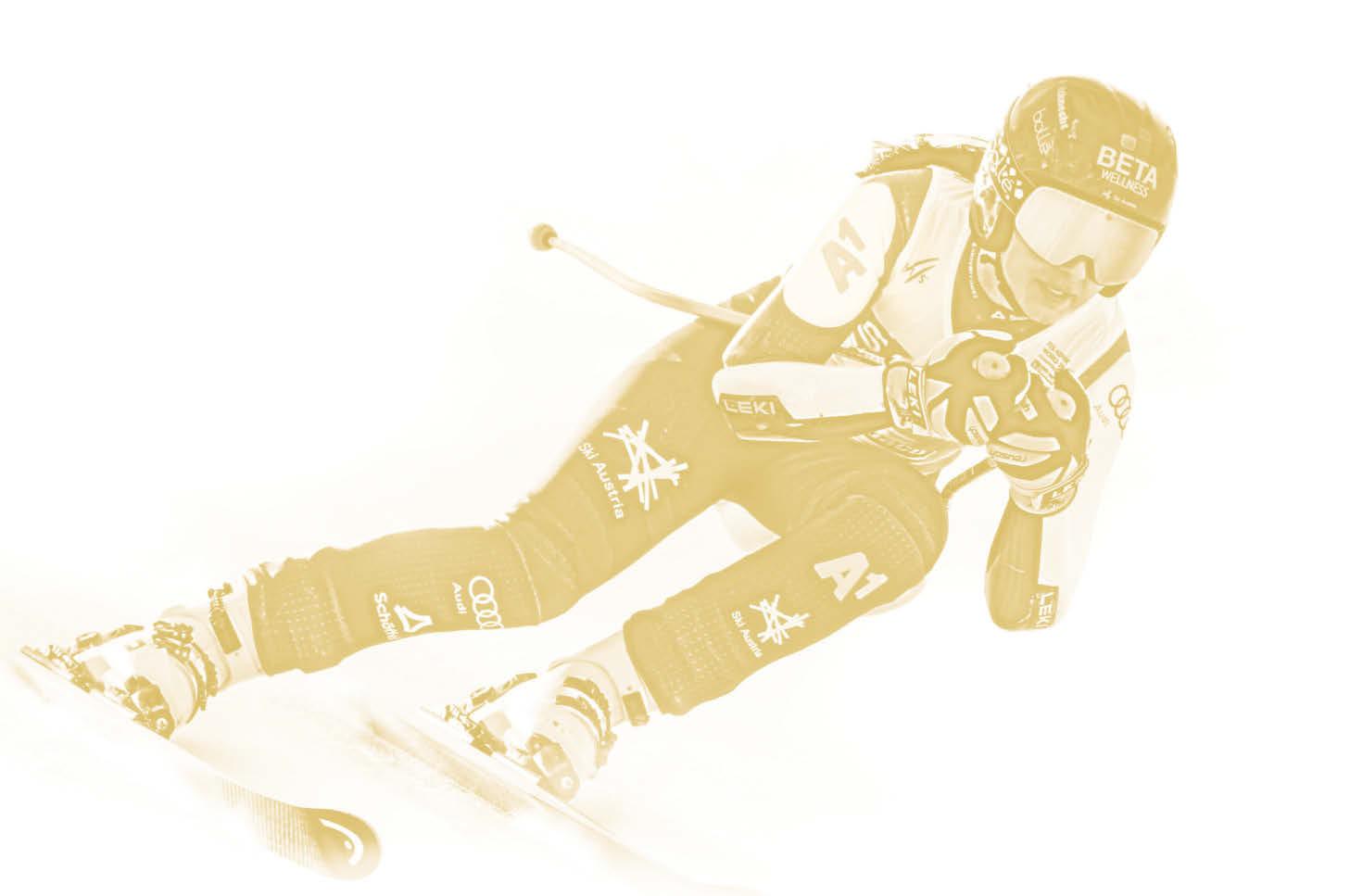

THE STORIES THAT REMAIN
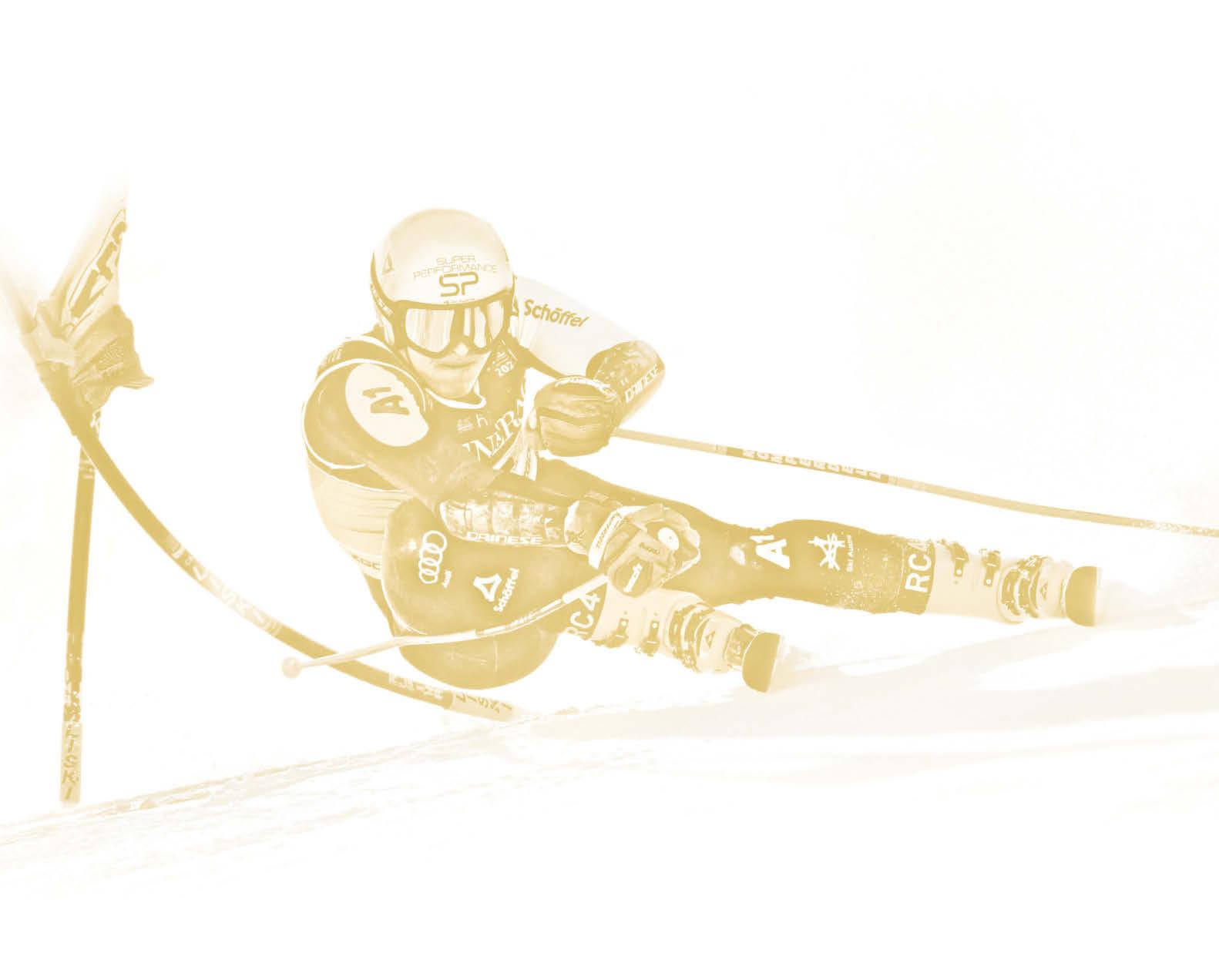
Haaser
Breezy Johnson
Franjo von Allmen
Marco Odermatt
Mikaela Shiffrin
Loïc Meillard
Camille Rast
Federica Brignone
Beloved combinations
Fans, fans, fans!
All results
The mountain
Snapshots
Unsung heroes
Out and about in Skicircus
Happy locals
Bartl Gensbichler
Motivated young talent
Finish
Roswitha Stadlober
Wolfgang Mayrhofer
Johan Eliasch Home of Snow
OUR STORY REMAINS – AND SO TOO DO THE EMOTIONS
We hosted the FIS Alpine World Ski Championships 2025 and were in the midst of all the action. Two weeks of an extraordinary situation. Two weeks of passion. The stage, heart and home of winter sport. And yes: we’re proud. Of every race, every medal and every radiant face at the finish line. It had everything you needed for the perfect skiing festival: tension on the course, goosebumps moments, surprise victories, tears of joy – and organisation that was about as seamless as you can get. Or in the words of FIS President Johan Eliasch: “perfect in every way.”
Our pistes were a dream. Our volunteers were heroes behind the scenes. And even the weather played ball, as though it knew our schedule. We celebrated, rooted for the athletes, felt their suffering – and experienced races becoming unforgettable events. The way in which stories for all eternity were written in seconds; the way athletes became legends. One thing that is clear is that World Championships like these are about more than applause and medals. They’re also a promise – to nature, to our guests and to the future.
The furore has subsided but the stories remain: fans cheer, flags wave and whoops of joy still resound from the Zwölferkogel. The feeling of being part of something bigger has also remained. And that’s why we’re using this magazine to take stock.
We’d like to thank everyone who was there. Thank you for your collaboration and organisation, for cheering and celebrating! This story isn’t yet over; further chapters are still to come – written by all those who experienced it firsthand.
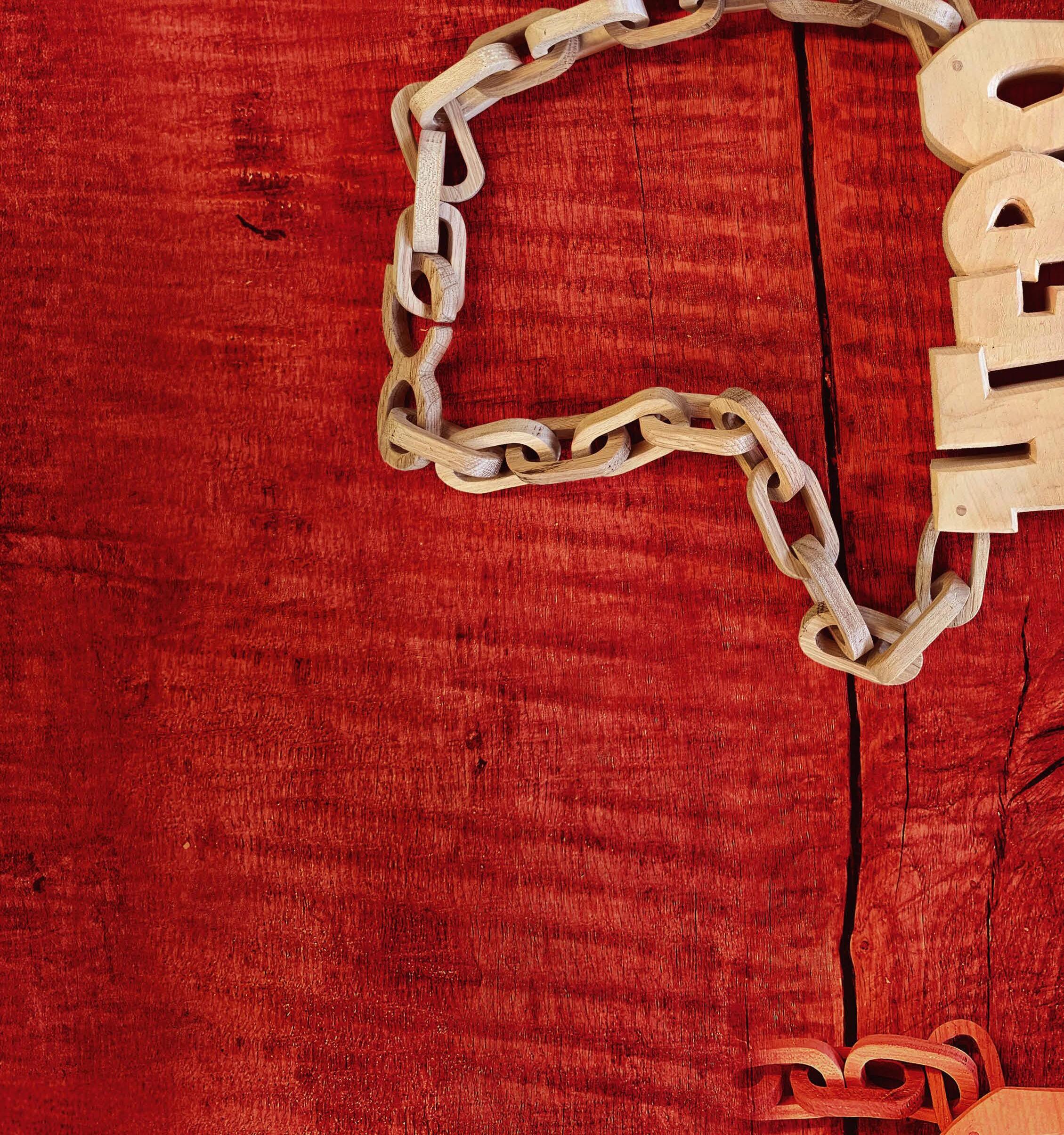
UNIQUE:
A WOODEN CHAIN FOR OUR HEROES
You’ll always find medals at World Championships, but the winners in Saalbach had the joy of receiving another original memento too: during the evening celebrations in the ‘Home of Snow’ (see page 130), they received personalised wooden chains and thus the title ‘Hero of Snow’. Weighing around 400 grams each, the chains were designed and produced by the Hinterglemmbased art collective Glemmart. The main body was cut from local pine wood and the 23 links from a mixture of oak and ash. Herbert Aschaber, known as ‘Schnitza’ (meaning ‘carver’), engraved the relevant World Champion’s name into the back of a chain straight after each race – using a torch with a wire tip that glowed redhot at a temperature of around 700 degrees: “Each chain is unique”, says Schnitza. glemmart.com
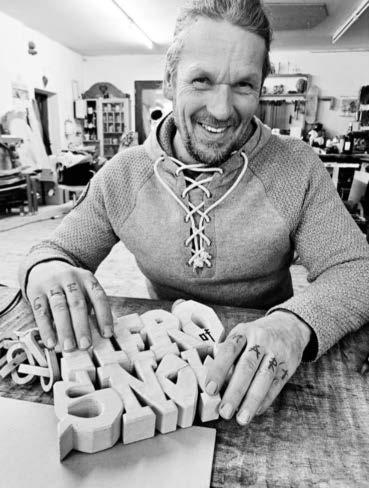
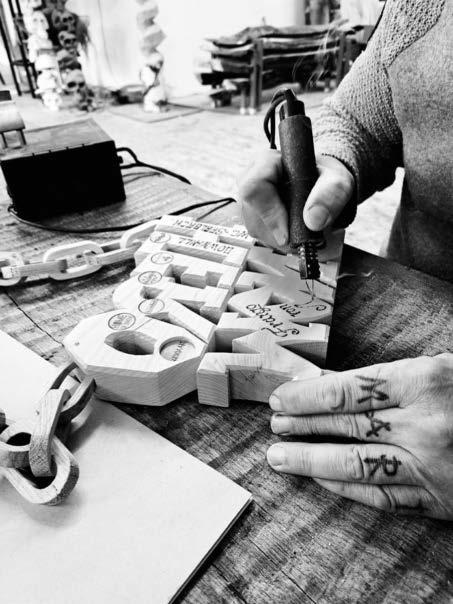
Franjo von Allmen, downhill World Champion, has his name engraved in the wood.
HERO OF SNOW
Herbert ‘Schnitza’ Aschaber presents the chain in the Glemmart workshop.
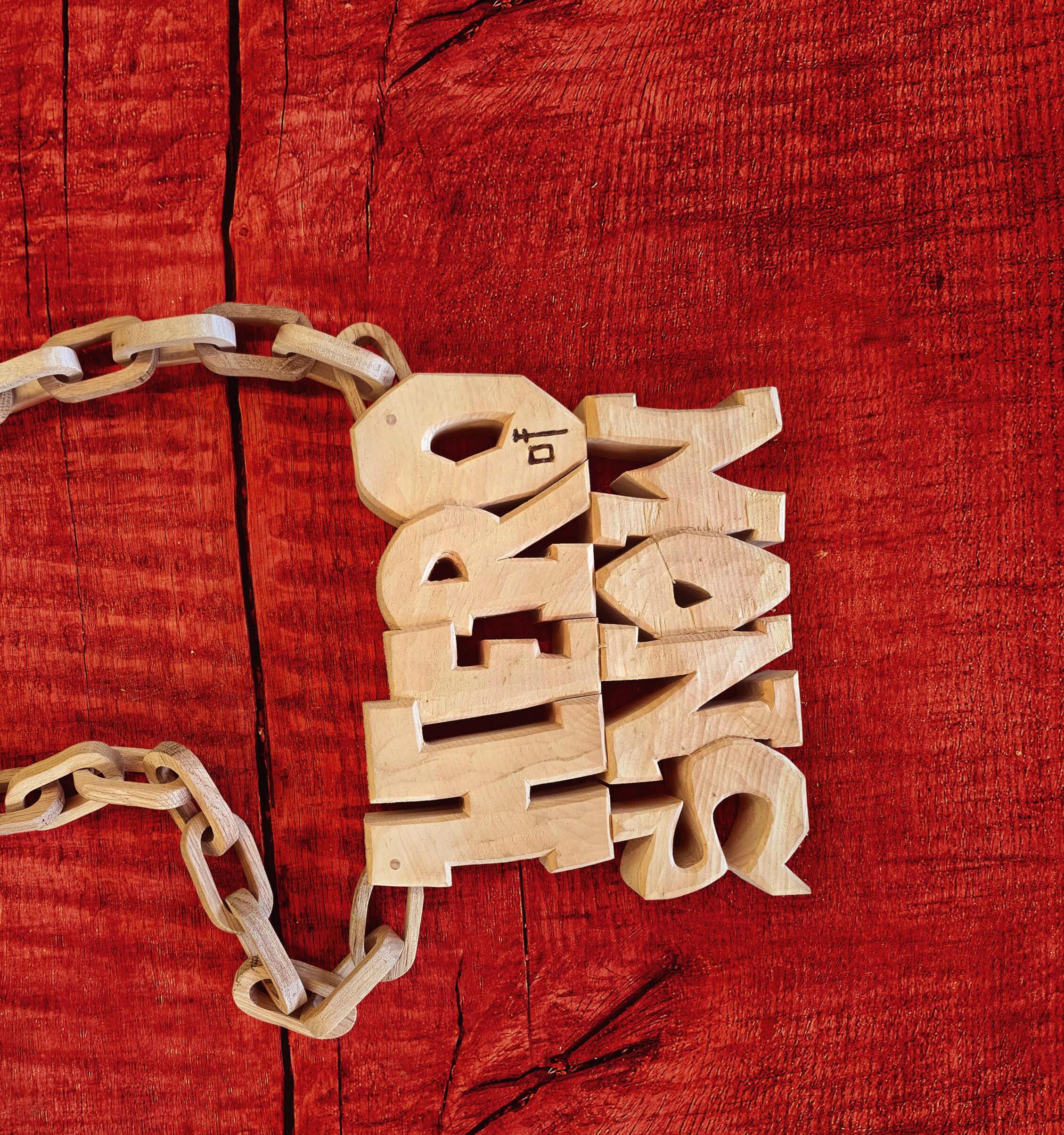
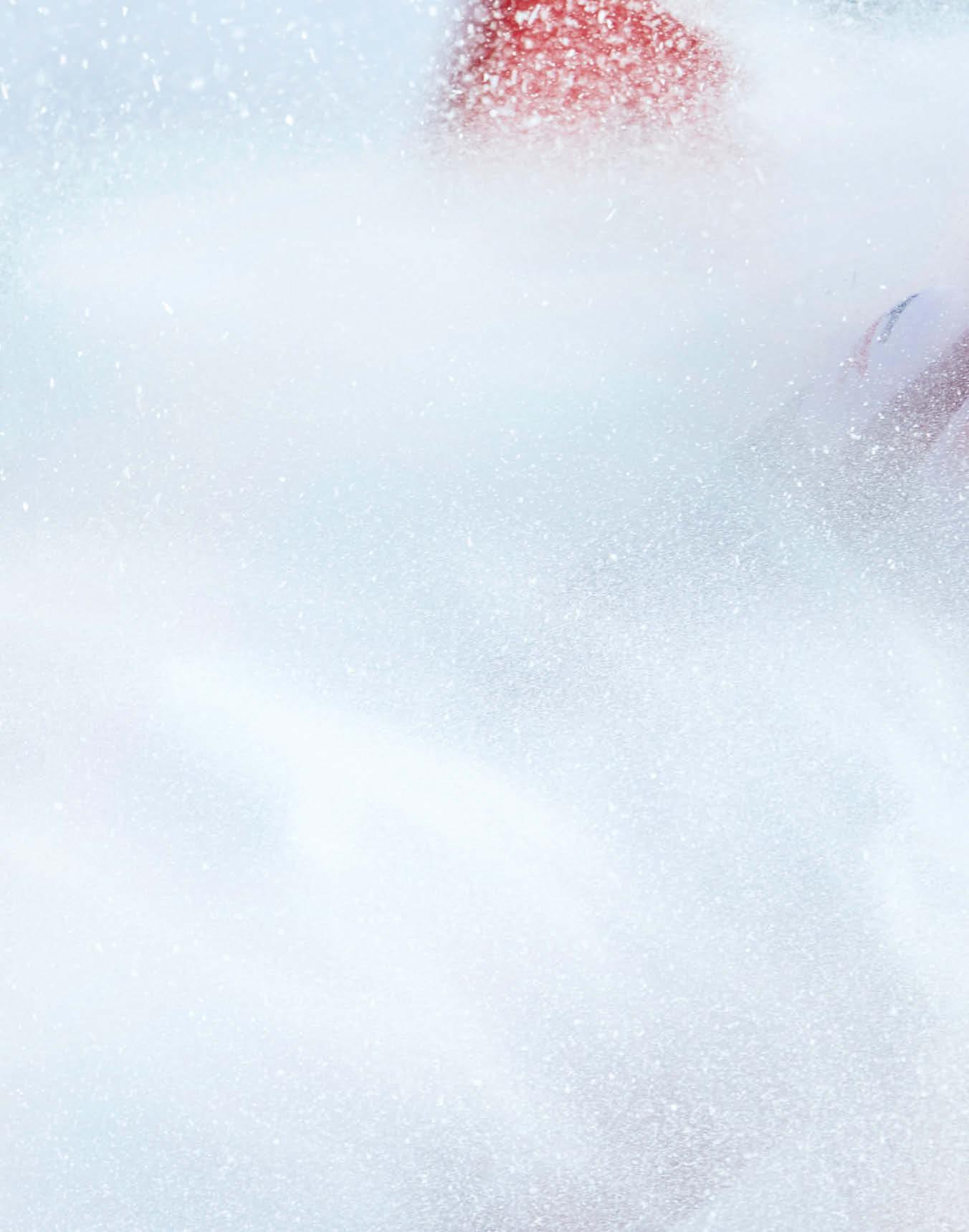
CLOSE-UP
BREEZING THROUGH A CLOUD
As Stefan Babinsky sweeps down into the Saalbach Hinterglemm arena, the 29-year-old Styrian practically disappears into the dense cloud of snow. Still visible are his face – and the joy that emanates from his broad grin. Yes, it’s amazing here! Stefan Babinsky comes sixth in super-G and ninth in downhill. And is happy in his cloud.
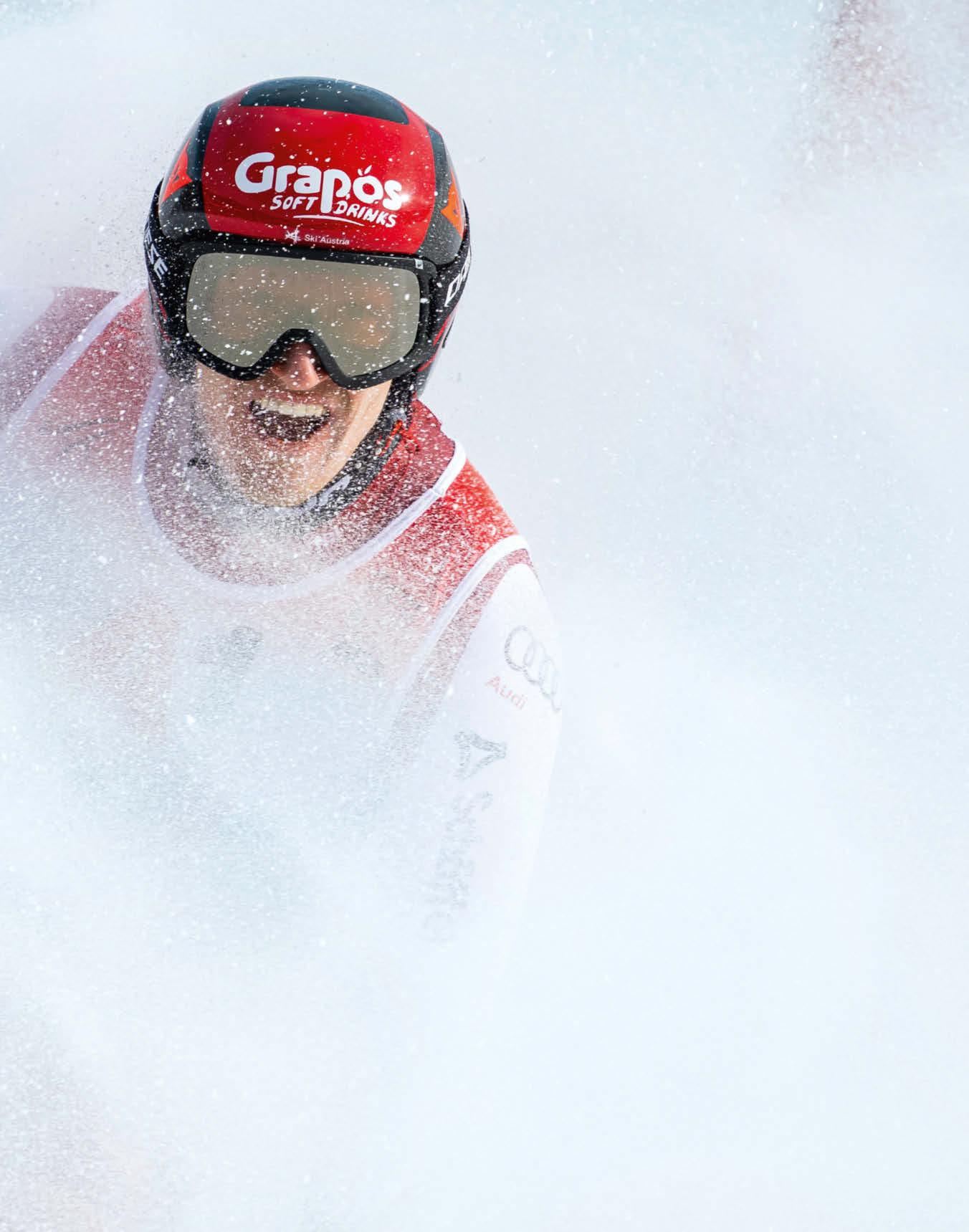
IN THE HEART OF HINTERGLEMM
GLITTERING IN GOLD
In the sparkling resort town of Hinterglemm, there is one place that outshines all others: the medal plaza in the heart of the town, the home of gold. Thousands of people gathered here to celebrate the winners of the eleven competitions. Those lucky enough to be present are sure to have fond memories –of goosebump moments in which history was written.
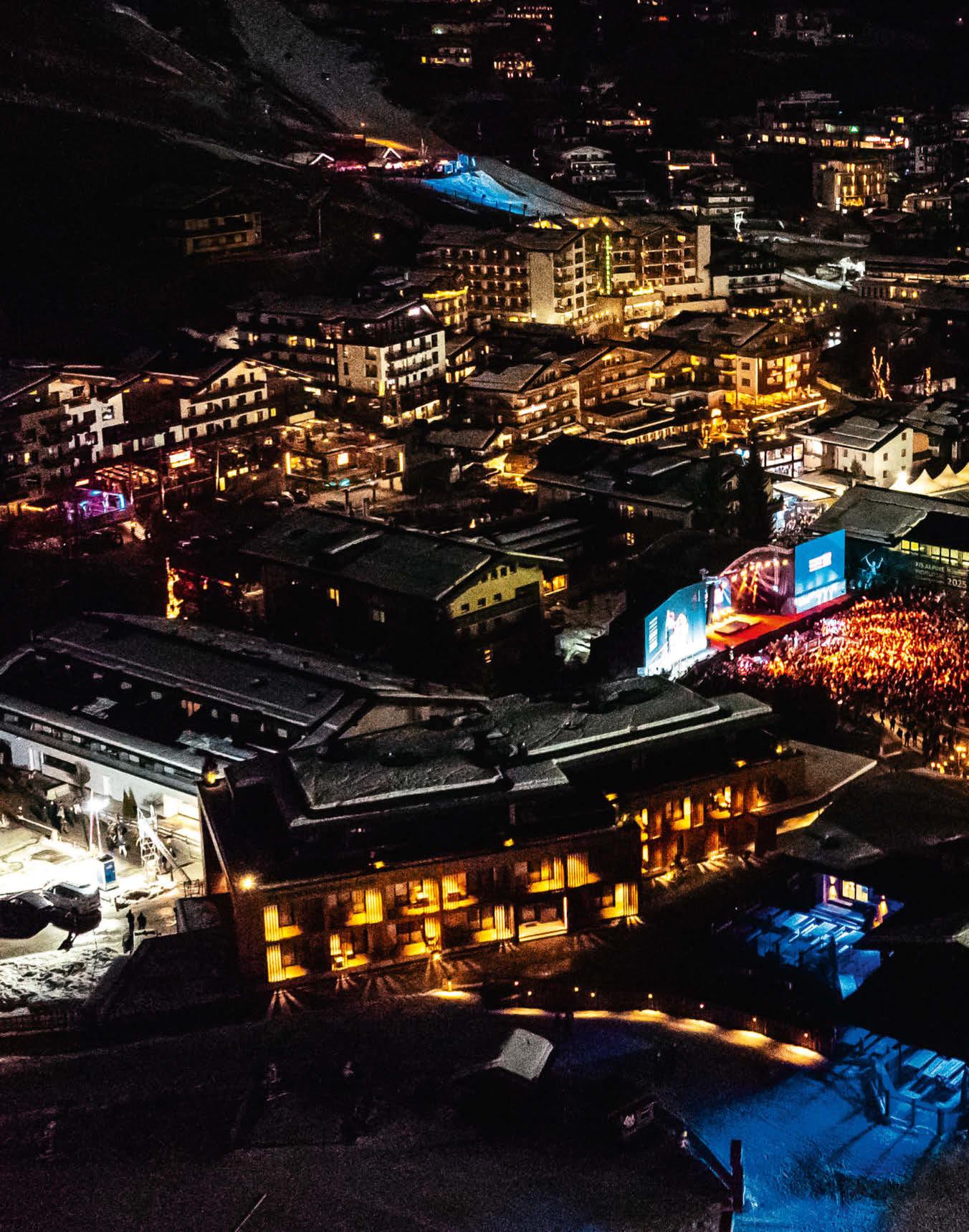
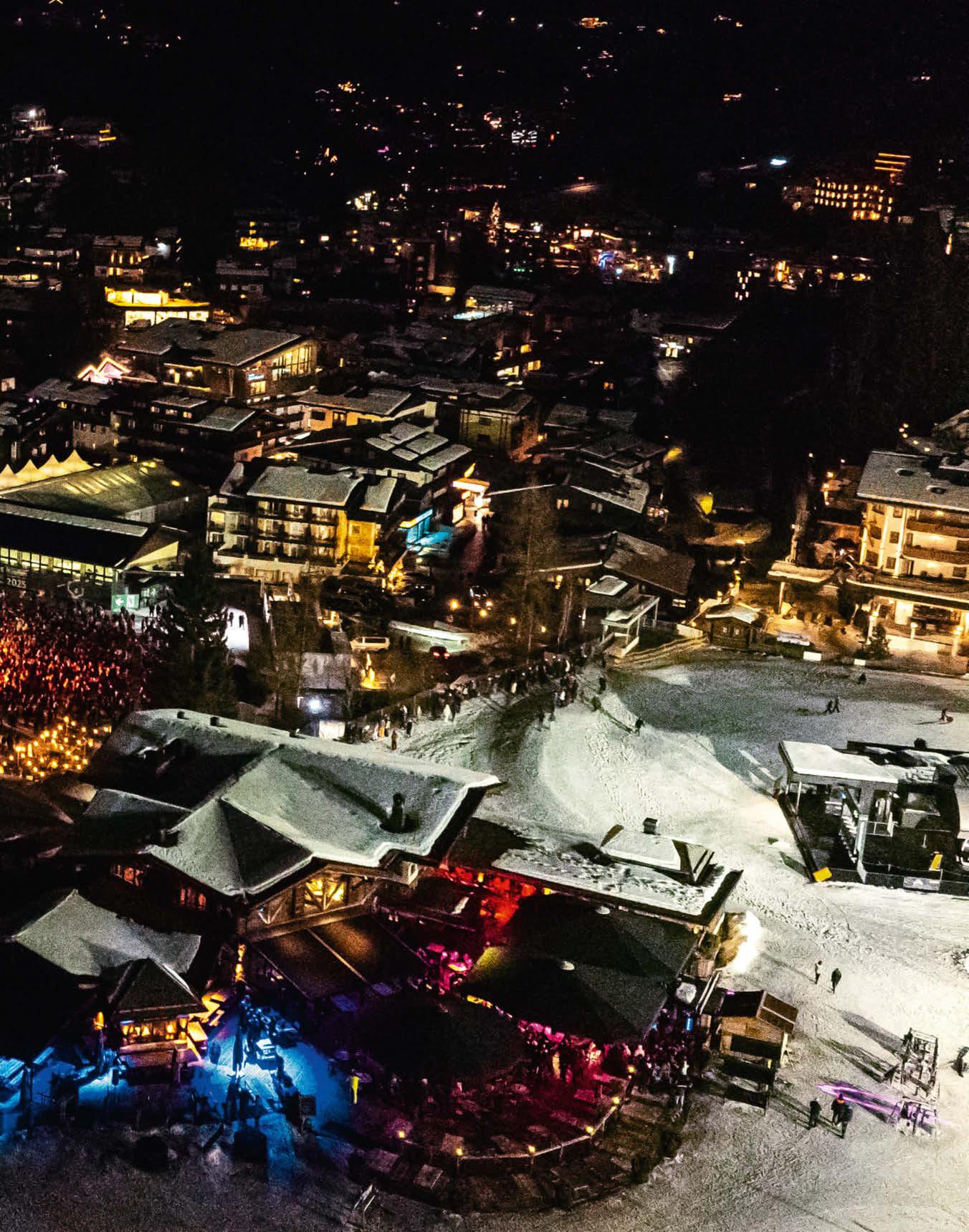
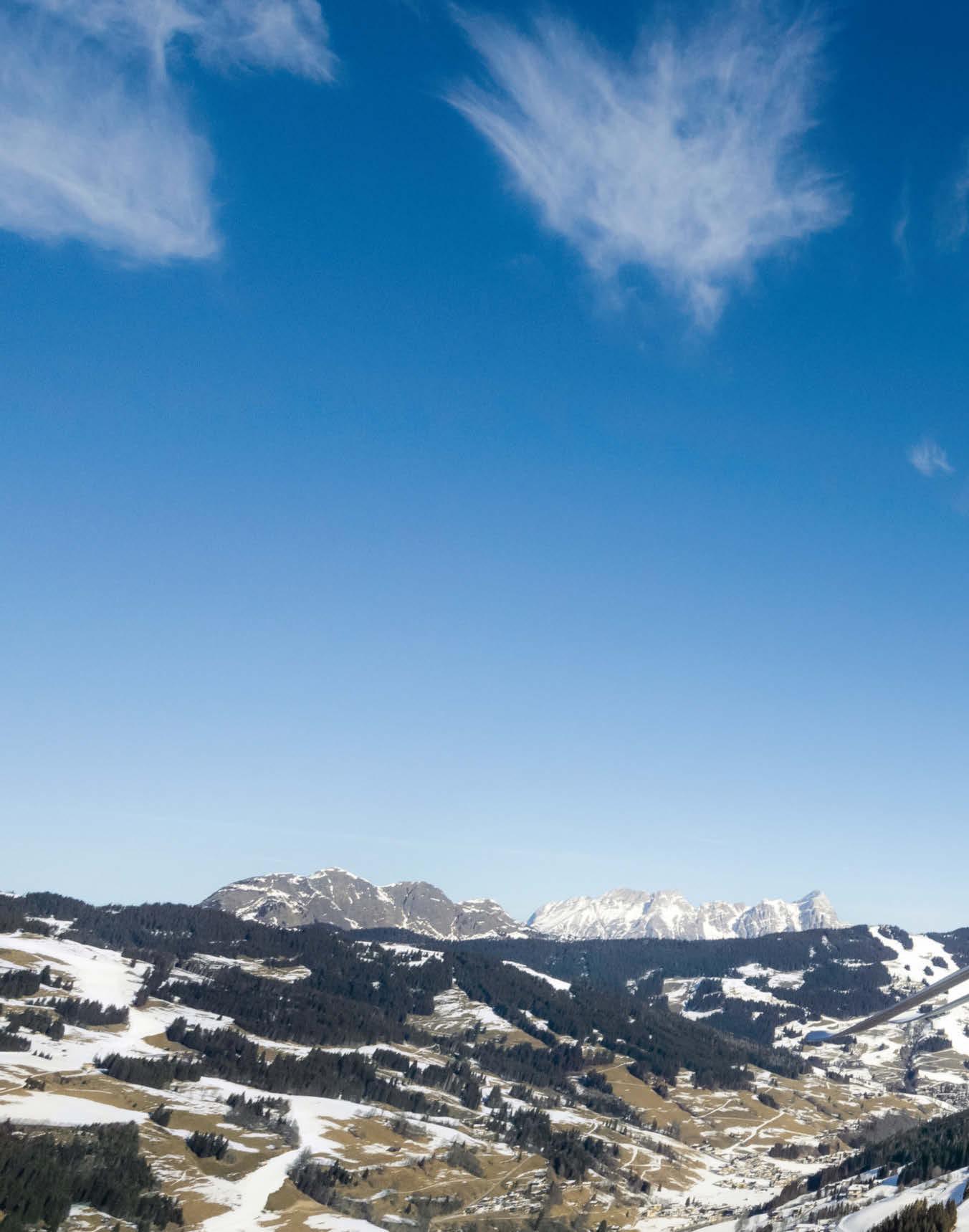
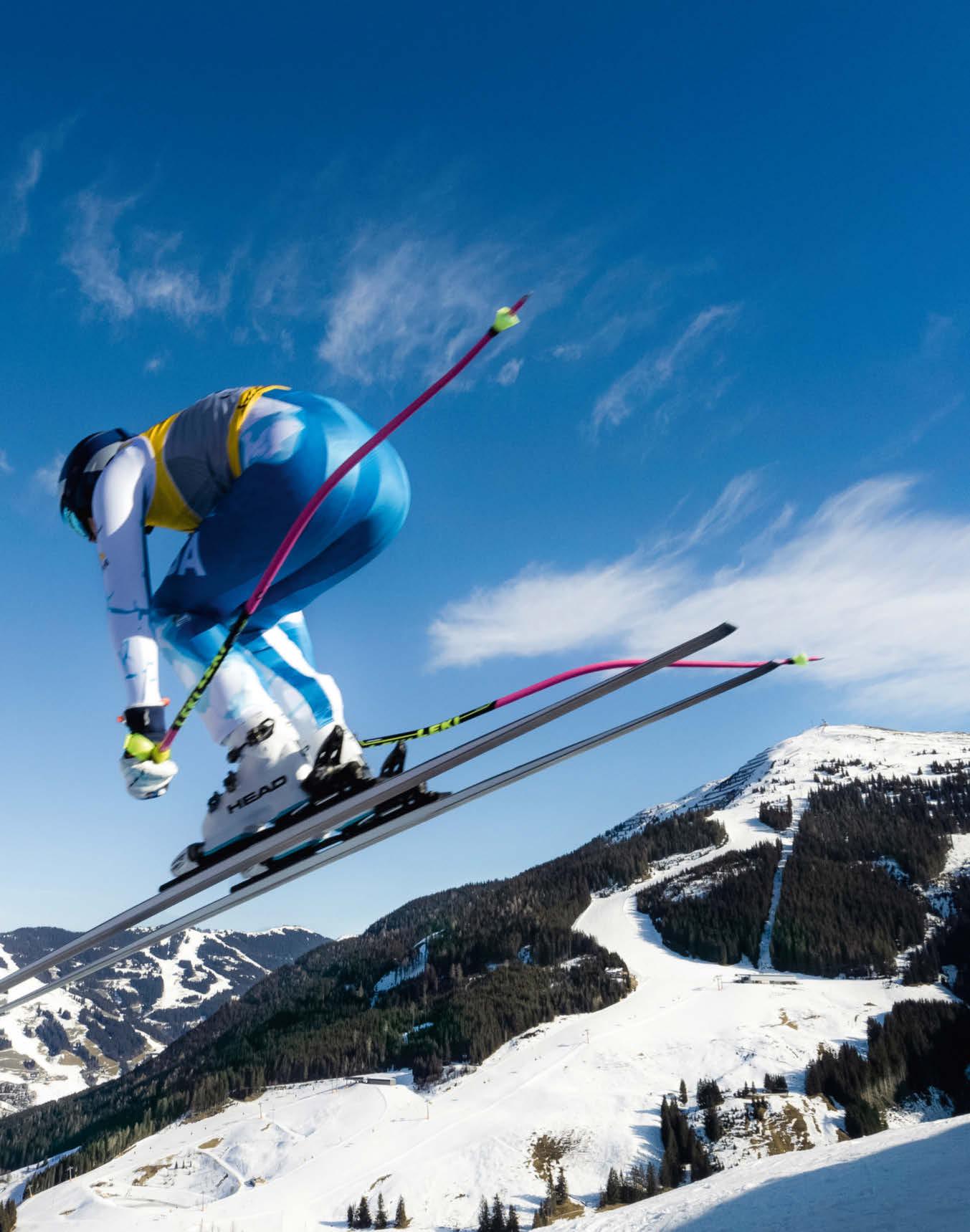
LINDSEY VONN BRINGS GOLD
No, US legend Lindsey Vonn didn’t pick up any medals at the World Ski Championships in Saalbach. But she helped Gabriele Facciotti do so. Gabriele who? A justified question.
Signor Facciotti, born in Turin, snapped this photo of Lindsey Vonn racing down into the valley. “I really hoped the photo would be the one”, stated Facciotti, beaming with delight after the award ceremony. His picture won gold for the best photo at the World Ski Championships.
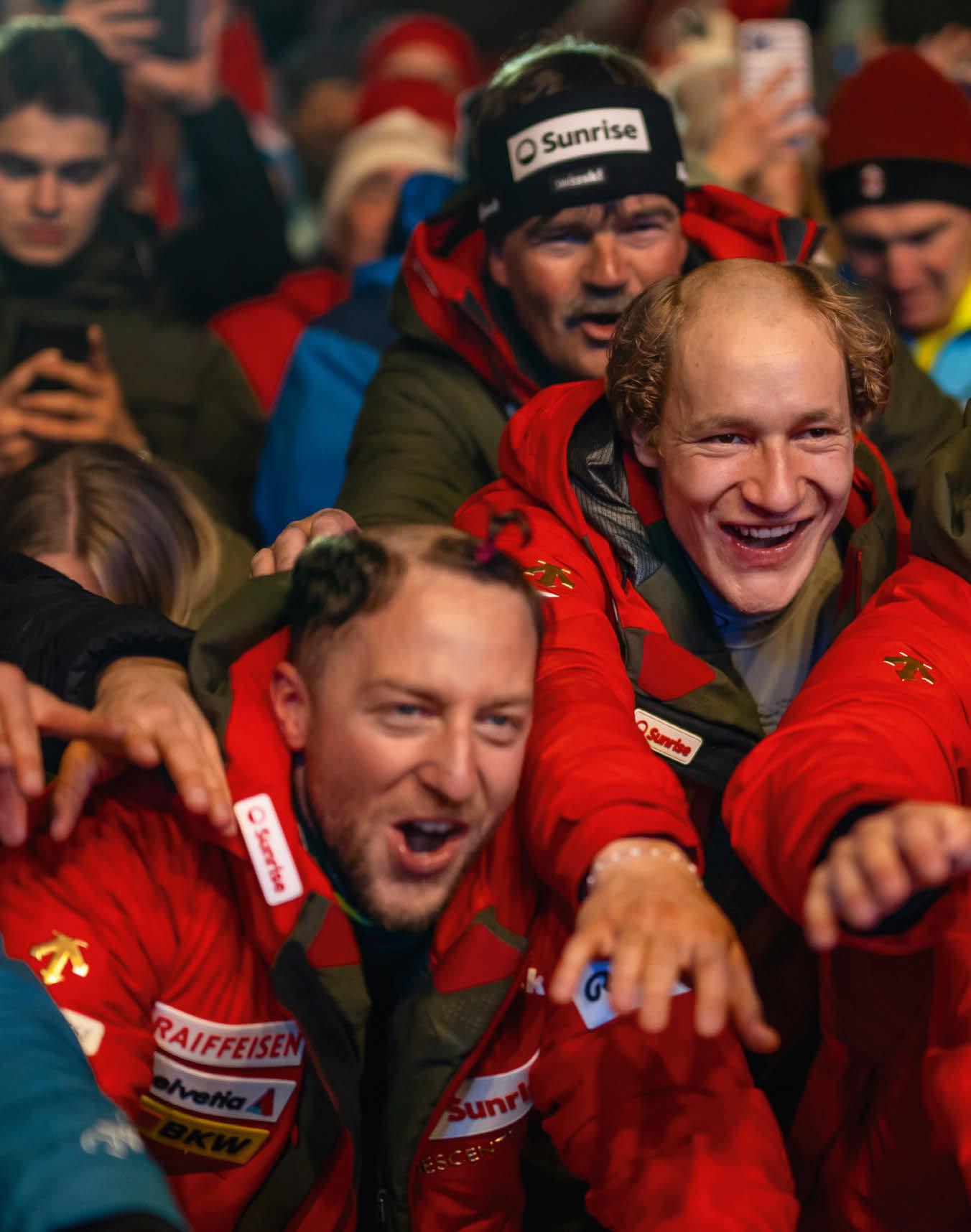

SLALOM-STYLE
MARCO GOES FOR THE BALD LOOK
After their triumph in the downhill, the jubilant Swiss let loose with their razors slalom-style. The results were visible for all to see at the award ceremony on the medal plaza. Marco Odermatt’s partially shaven head caused quite a sensation in particular. The super-G World Champion appeared on ServusTV semi-bald: “I still notice a bit of a draft around my ears.”
THE WORLD SKI CHAMPIONSHIPS 2025 IN FIGURES
At the 48th FIS Alpine World Ski Championships, 174,900 fans watched the 11 races, which all took place on 1 mountain. Together with the around 11,000 VIP guests, they cheered on athletes from 77 countries, who were supported by over 2,000 coaches and service personnel. These were in turn able to work undisturbed in 116 containers in the ski service area. A total of 6,878 people were accredited for the World Championships and nourished with around 54,500 meals. For the races to be held, 56 kilometres of safety netting were installed. The course setters also made use of 1,600 directional gates (each of which could only be used in 1 place). Around 1,200 media representatives from all over the world reported on the World Championships and 27 commentary boxes with a height of 22 metres were built for the TV stations – on the stands, for which 950 tonnes of material were installed. ORF used 56 cameras to broadcast 70 hours of live action from Saalbach Hinterglemm to 4.7 million skiing fans – and thus
67 percent of the Austrian population over the age of 12. Around the world, the World Championships were followed by over 600 million people in more than 120 countries. The smooth running of the event came down to the hard work of not only 220 collaborators from FIS and the rights holder Infront but also 185 security staff and a further 1,200 service providers commissioned by the Austrian Ski Association (ÖSV) as well as 1,100 volunteers from 19 countries aged between 18 and 81 – and, of course, the emergency services! The latter clocked up 3,700 hours of work, with 300 police offcers, 450 Red Cross representatives and around 500 frefghters in attendance. Travel to the races themselves went smoothly: 70,000 fans made use of public transport, including 24 special trains from Vienna to Maishofen-Saalbach and back (with which ÖBB offered an additional 8,400 seats). From Maishofen itself, where 4,000 parking spaces were provided for the park & ride service, buses travelled to the World Championships in Hinterglemm every 10 minutes.
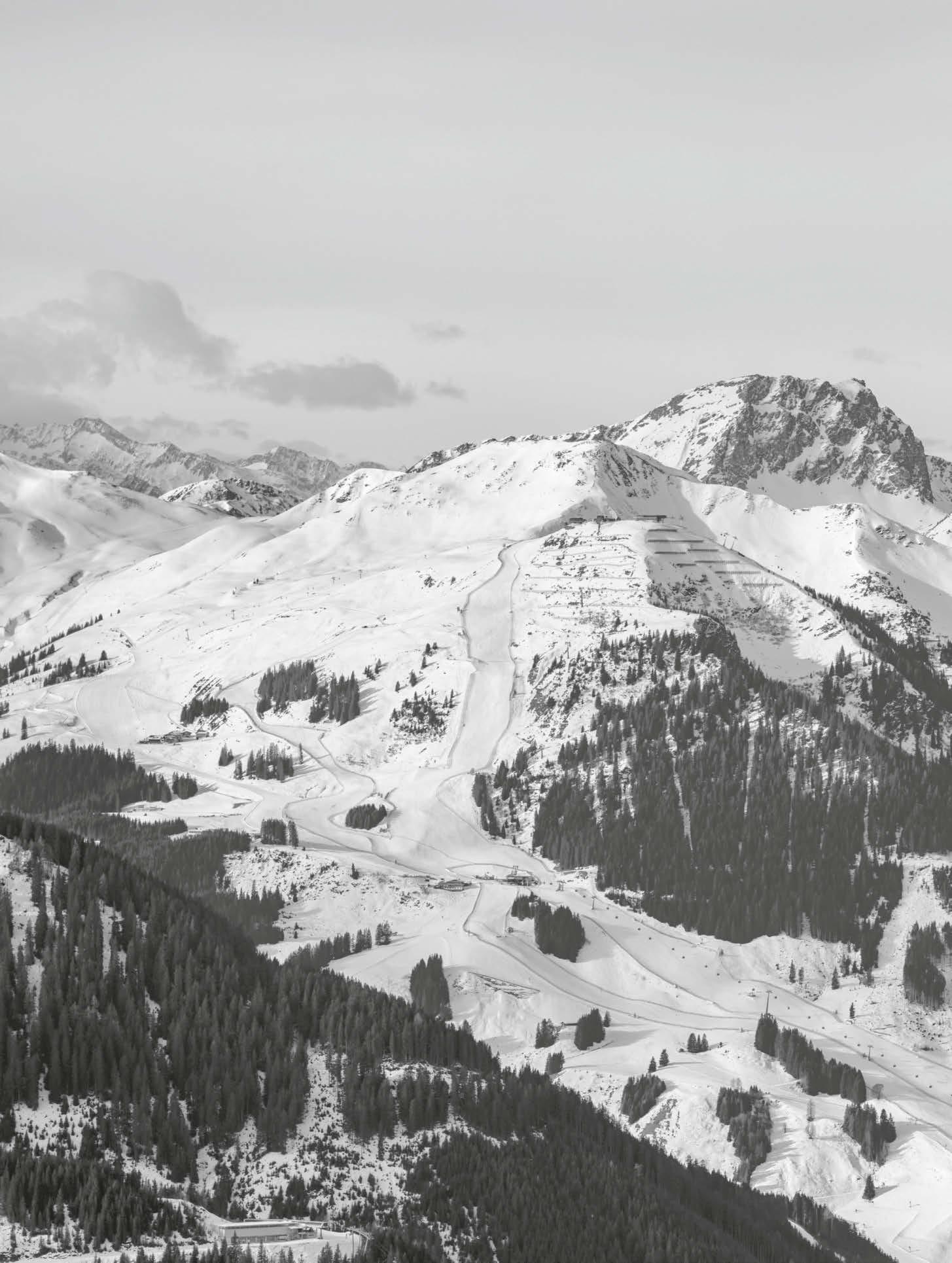
WELCOMING THE WORLD TO SAALBACH
Skiing is more than just a high-alpine activity. Athletes from 77 countries made the World Championships in Saalbach a global party.
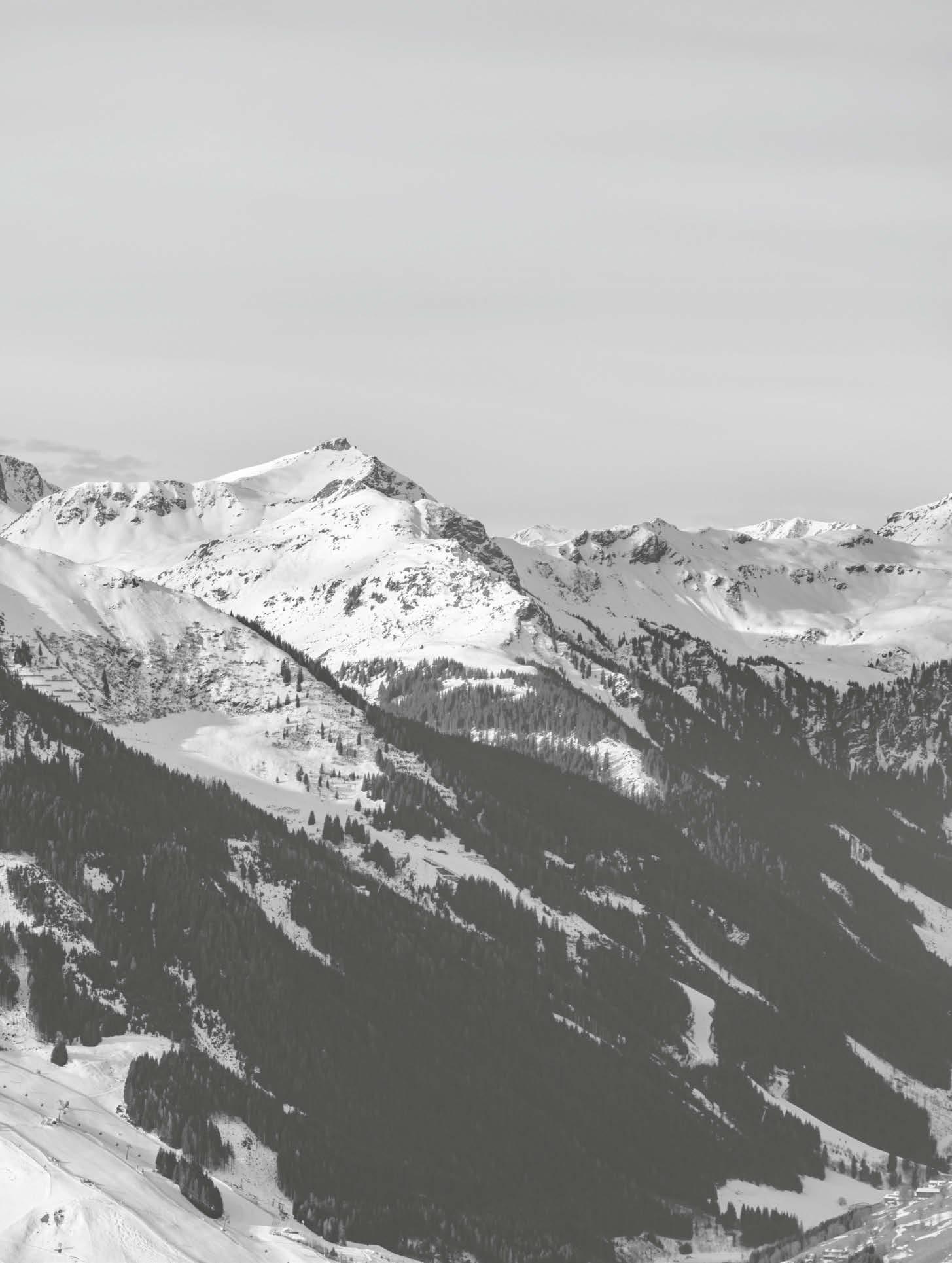
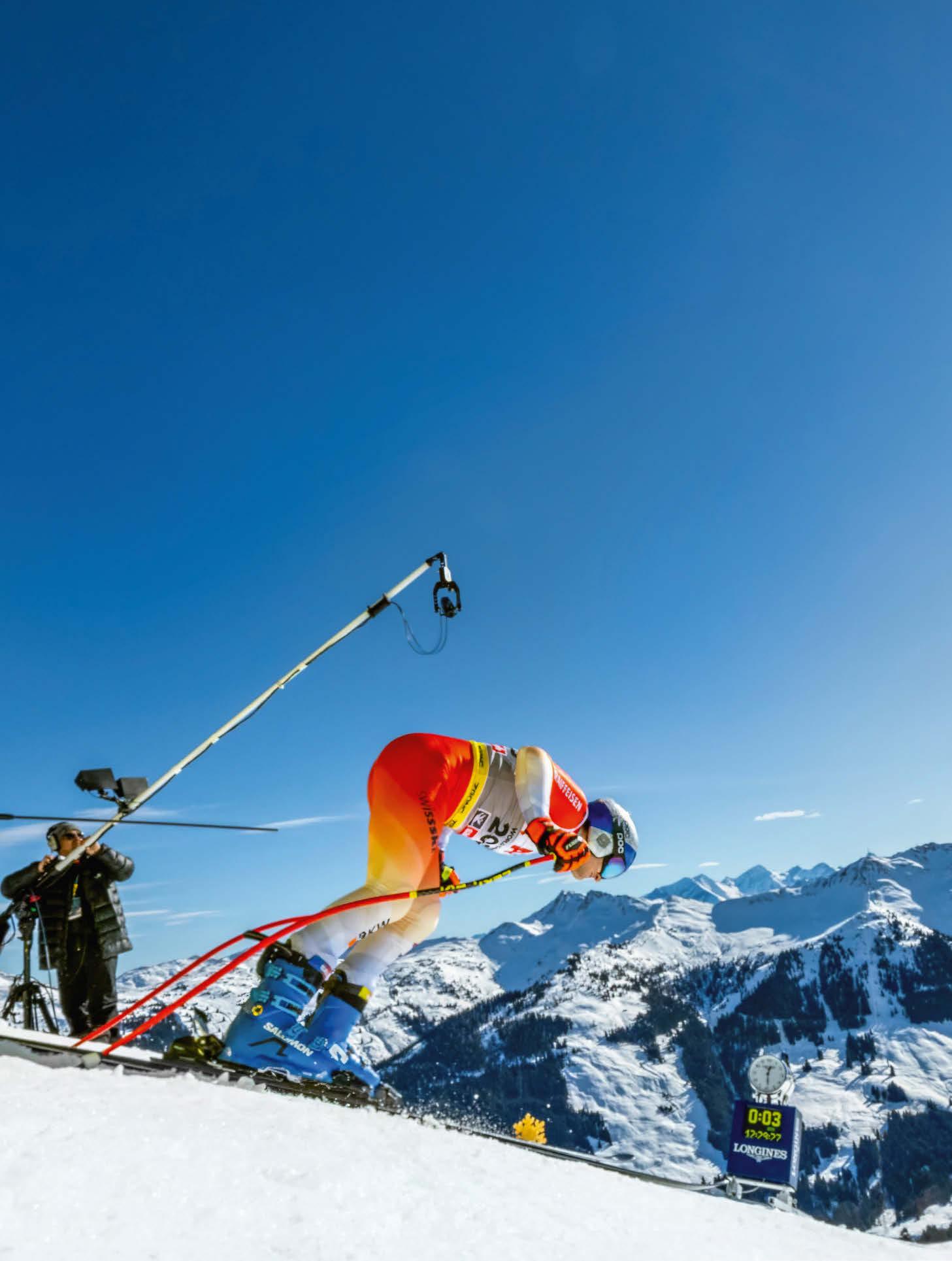
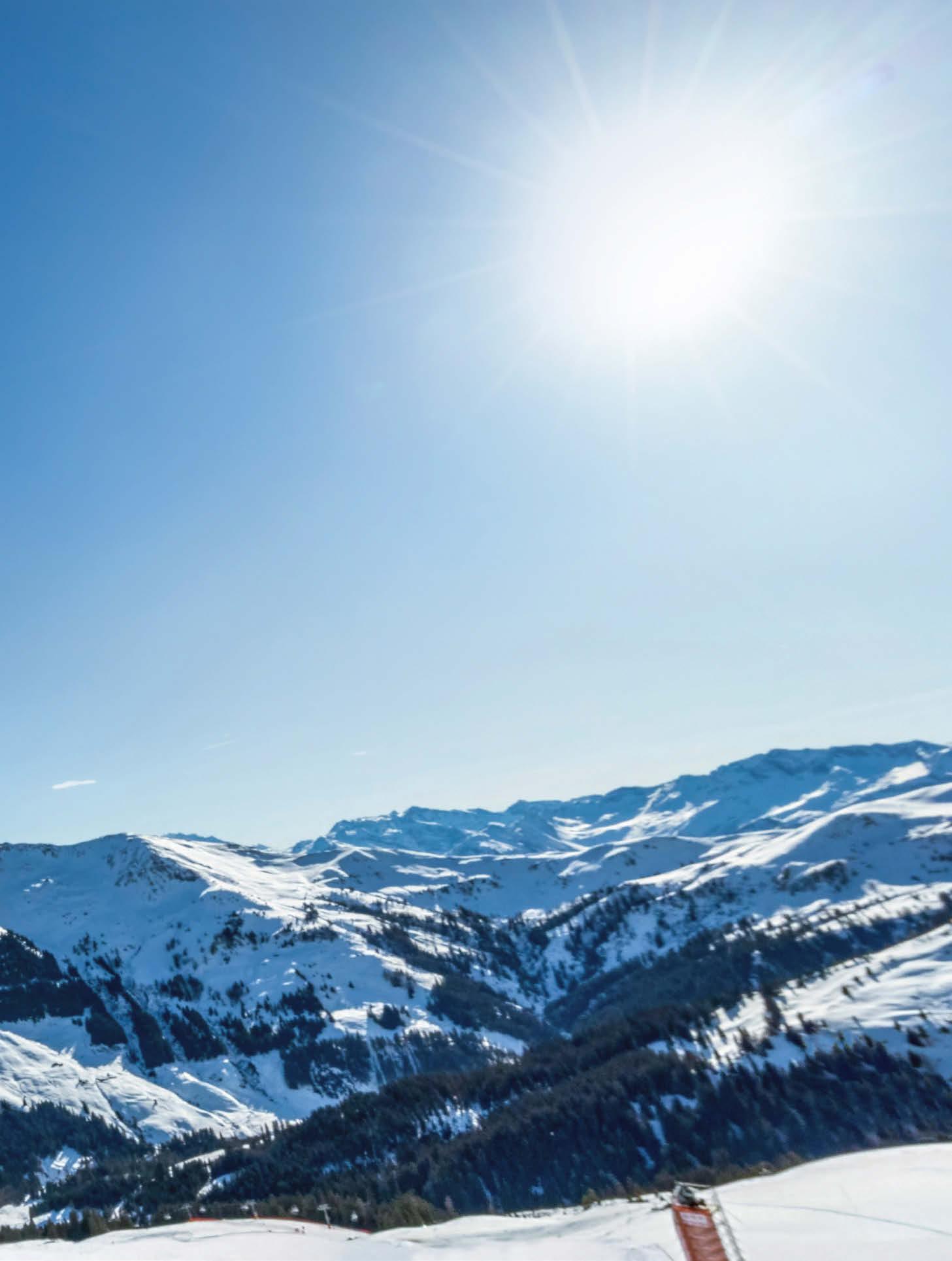
And he’s off: Swiss skier Marco Odermatt powers down the Zwölferkogel during his downhill training, looking like he’s bowing to the World Championship mountain.
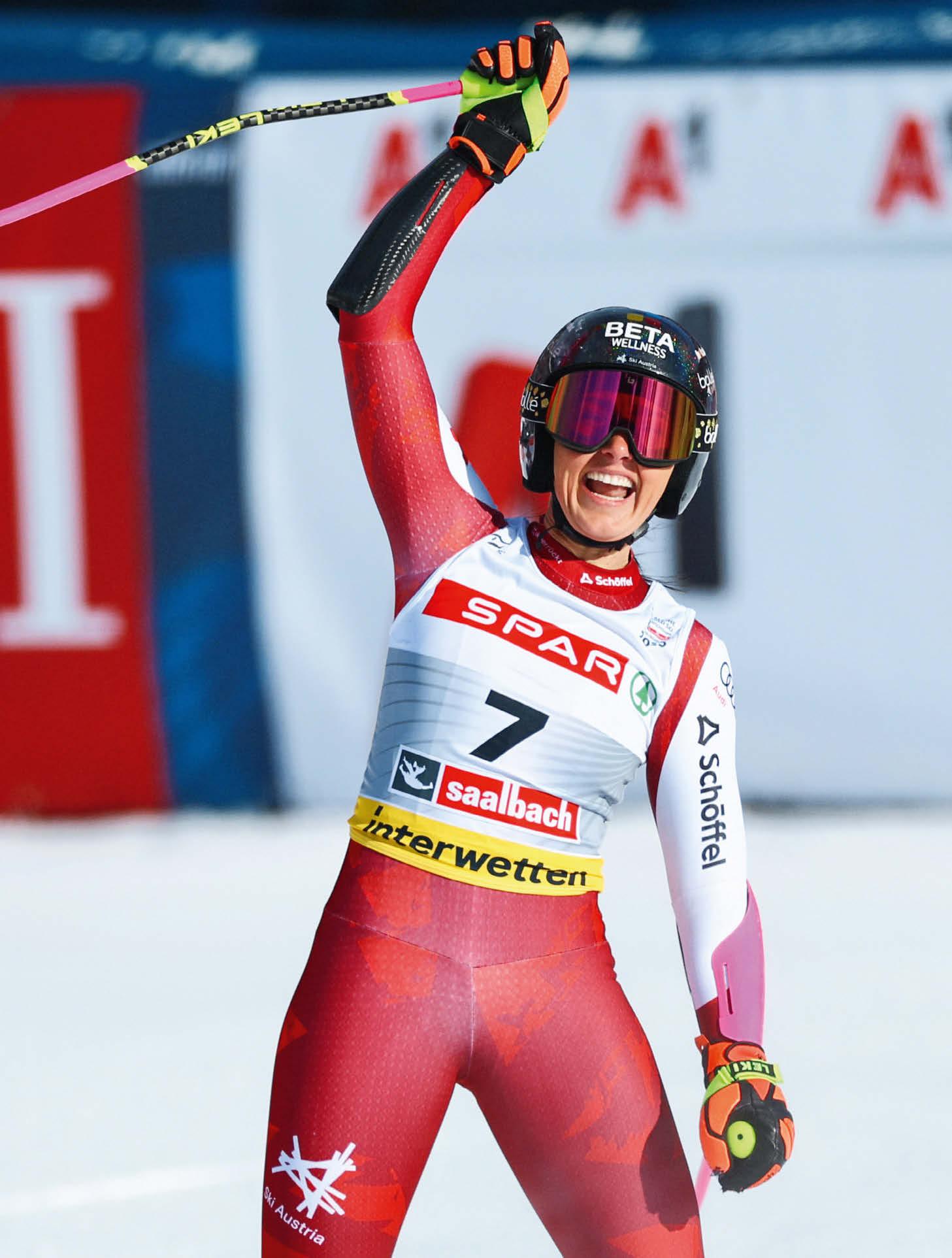
Arm punching the air and a broad smile on her face. The moment she reached the finish, Stephanie Venier knew she’d put in a dream performance.
Following her super-G victory, Stephanie Venier talks about pressure, moments of happiness and life after her active career.
“I COULD TELL IT WAS THE PERFECT RUN”
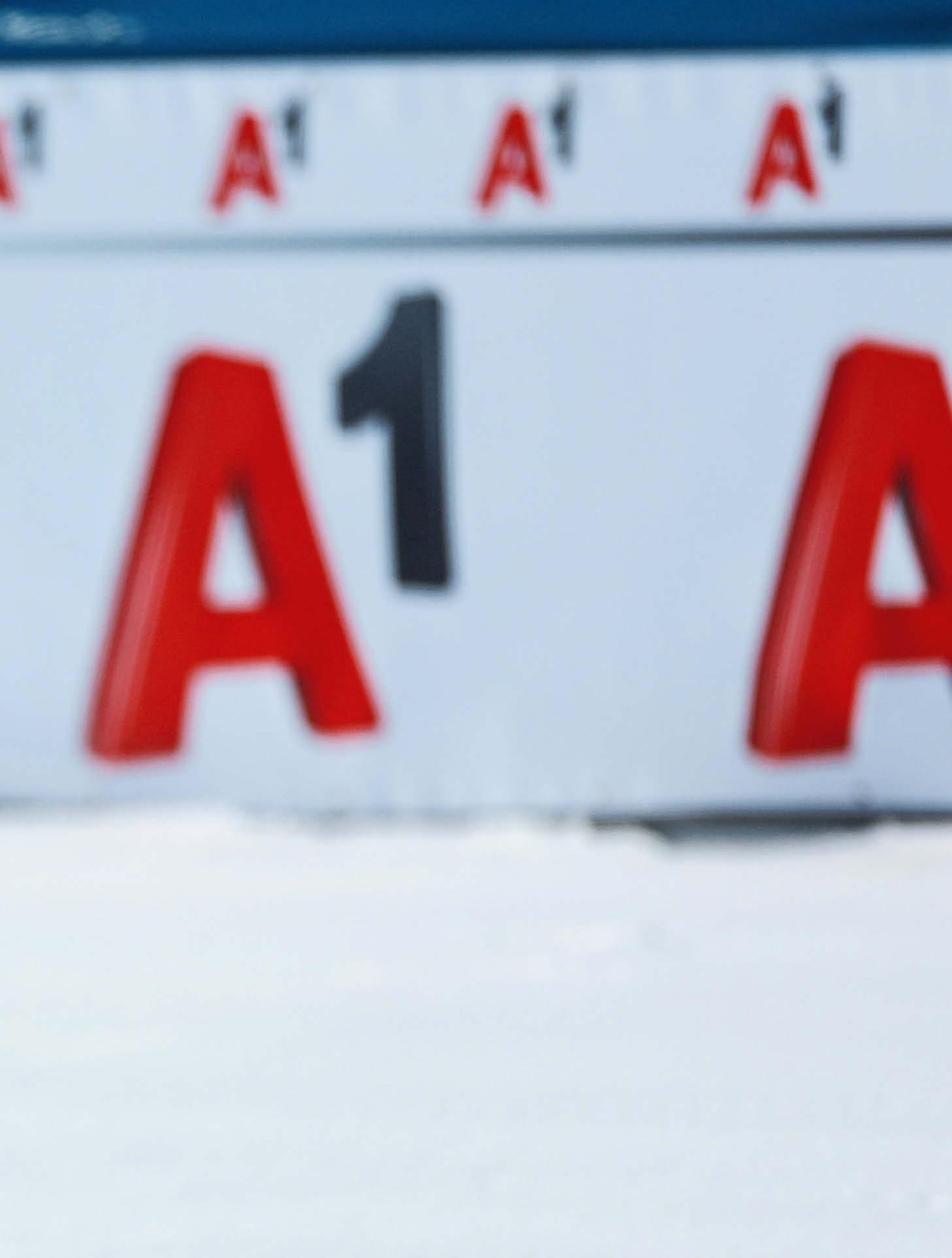
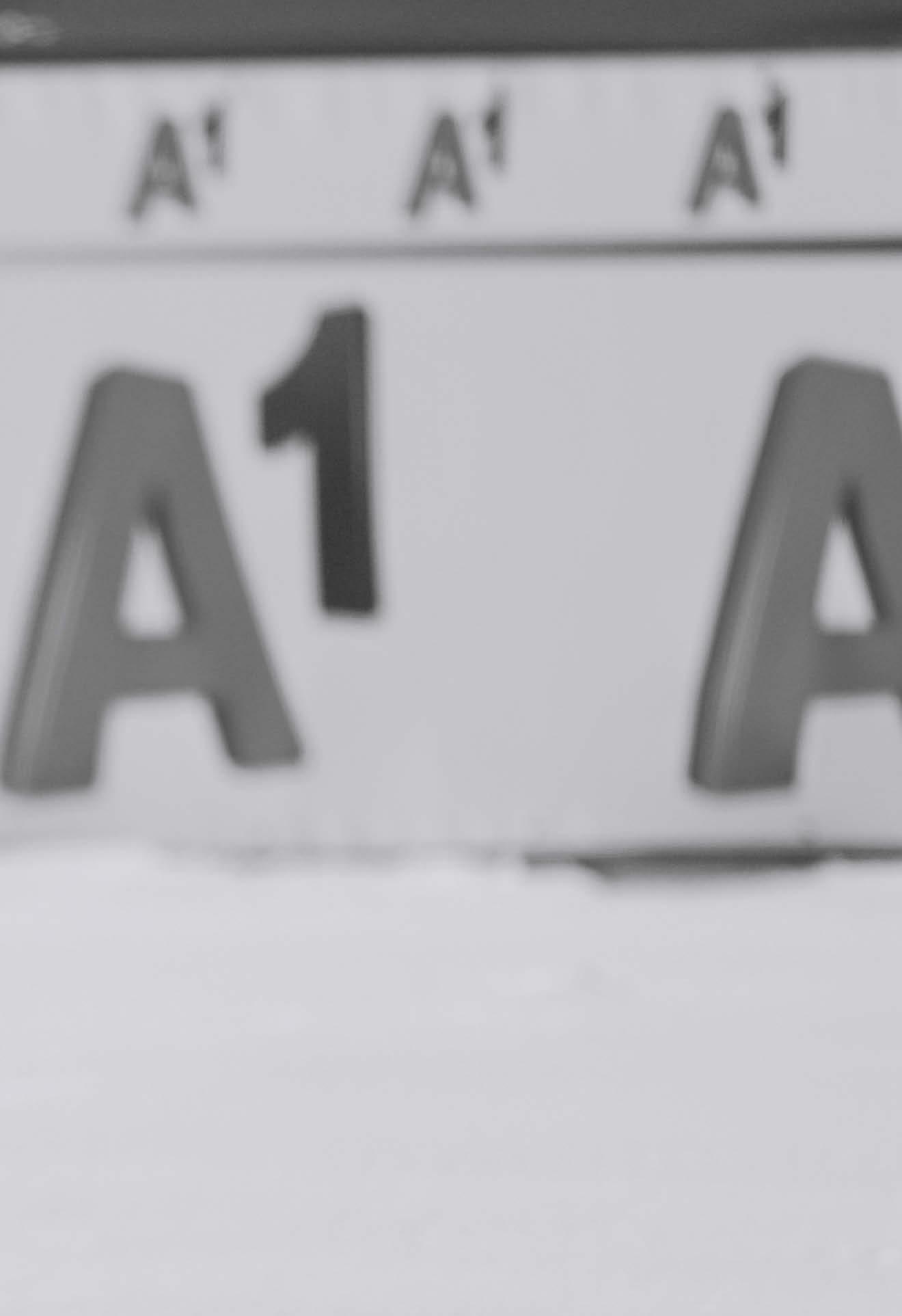
Sunday morning, the day of the men’s downhill race, just after nine in the morning. Stephanie Venier enters our studio in the ‘Home of Snow’, tired but happy, her gold medal dangling around her neck.
Stef, do you always carry your medal around with you? Are you looking after it?
Yes, I had my medal with me when celebrating yesterday. I had to be careful – but I was surrounded by people who always kept an eye on it.
Am I right that you couldn’t celebrate straight away after your triumph? Because you still had the downhill to come?
Exactly, I had to try and block it all out and retain a little mental distance from the gold medal because I wanted to fully concentrate on the downhill. It worked well – I was focused. Once the downhill race was over, the pressure largely eased and we were able to celebrate properly.
Where did you go? What did you do?
We went to the ‘Home of Snow’. My family and my service man were there. We ate, drank, celebrated and raised toasts.
Looking back: could you ever have imagined having a diferent career? Or doing another sport?
No. I simply slipped into this. I grew up in a ski resort, right next to the lift, so I could practically ski to my front door. I’ve always loved it. When it came time to choose between a ski academy and a normal school, I opted for Stams. And the rest is history.
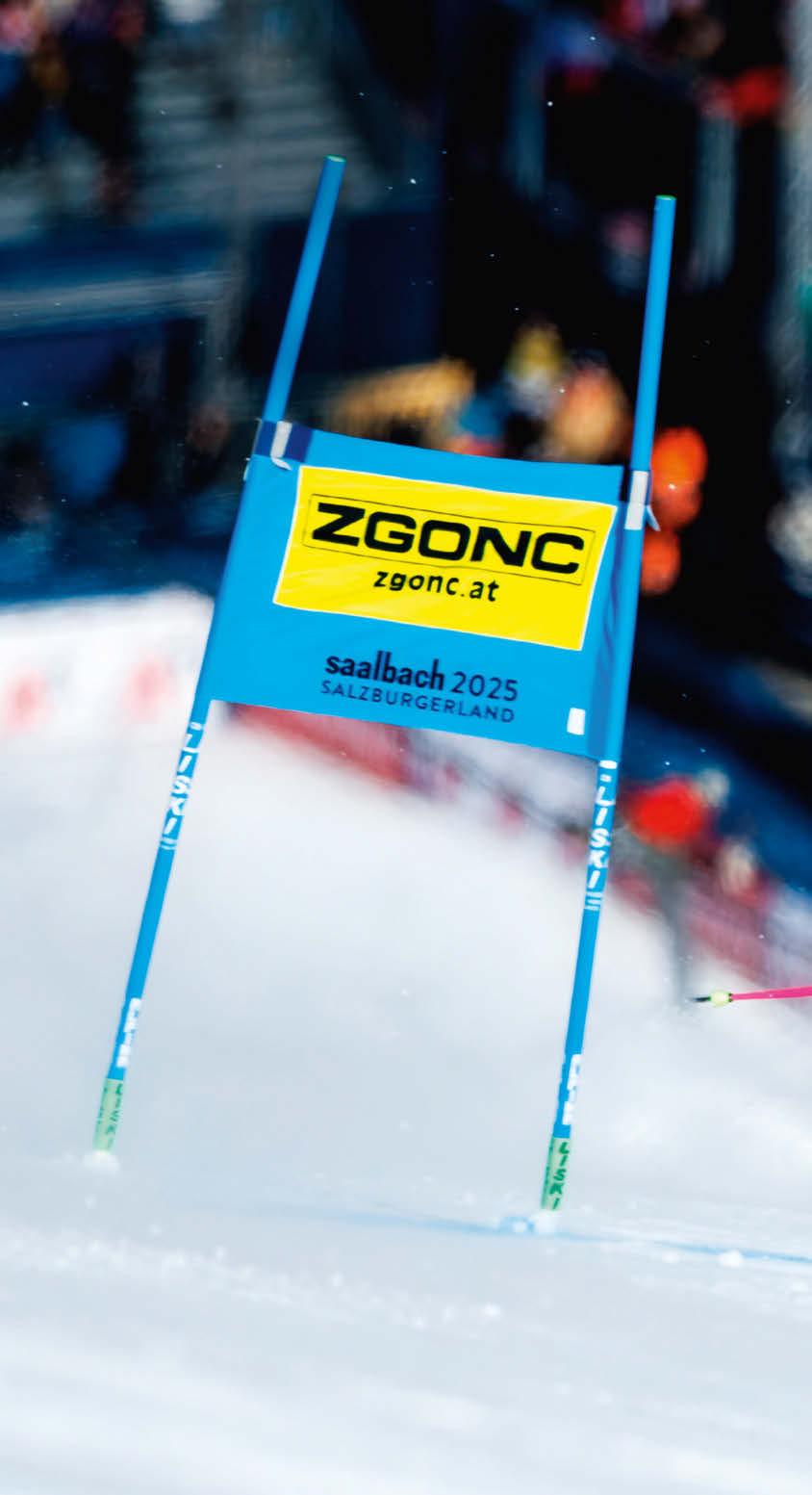
“YOU KNOW YOUR BODY AND WHAT IT CAN DO – BUT YOU NEED COURAGE, TRUST AND THE RIGHT ENVIRONMENT.”
On route to the best time, with just a few turns left and thousands of fans cheering from the finish area.
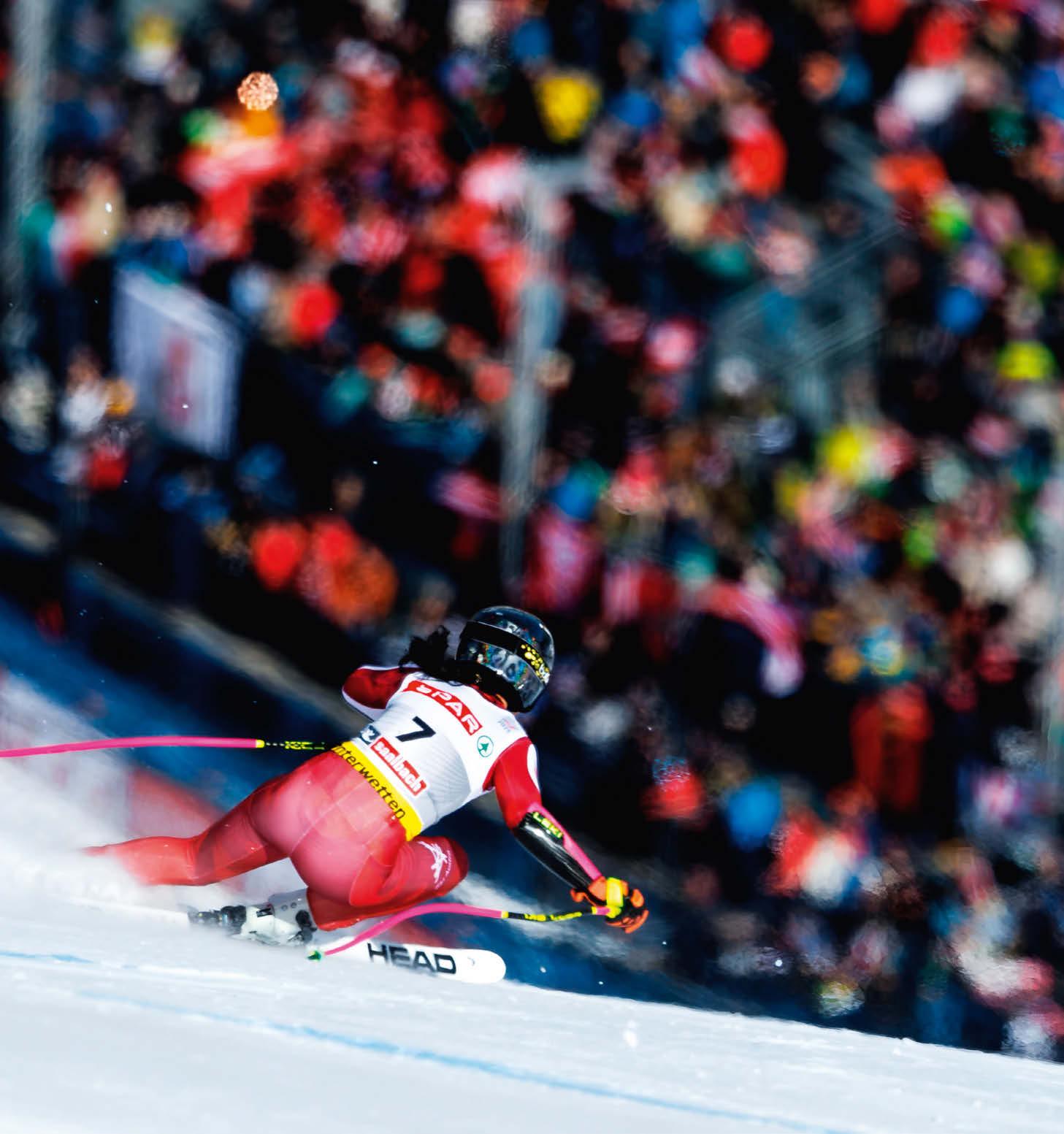
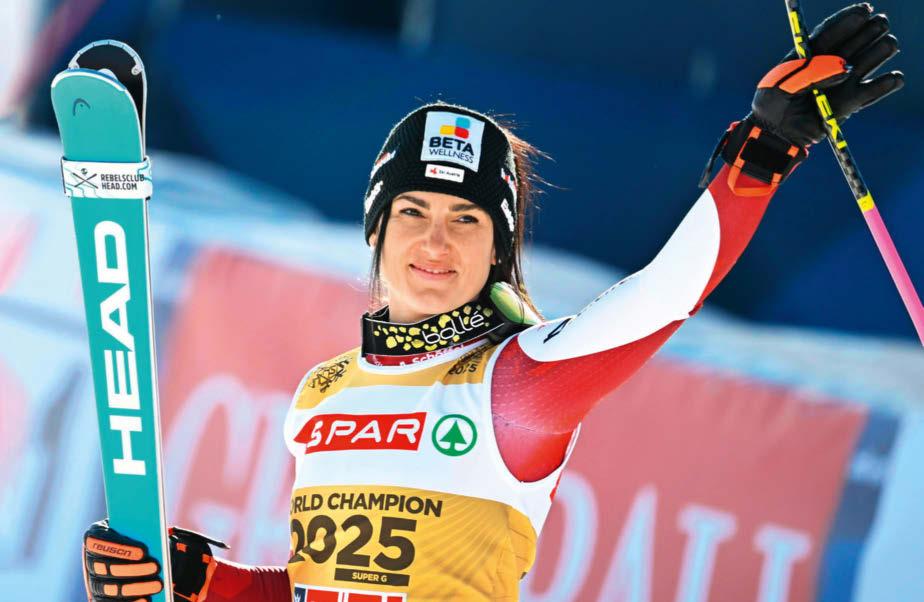
“THIS IS THE HIGHLIGHT OF MY CAREER. IT’S WHAT YOU DREAM OF AS A CHILD.”
Is being World Champion the crowning glory for you?
Defnitely. It’s the highlight of my career. It’s what you dream of as a child. And to think it actually happened it still gives me goosebumps.
I can still remember your silver medal in St. Moritz in 2017. But winning gold is diferent, right? Absolutely. Especially as I can celebrate on my home turf in Austria. That makes it particularly special – I wander through Saalbach, minding my own business, and am recognised. People call after me; children know my name and want autographs and photos. That’s sometimes tough before a race as I’ve got to remain focused – but I like doing it.
Does being a role model put pressure on you?
I think it’s lovely. It makes me really proud to see children or young people looking up to me.
How do you constantly push your boundaries and achieve ever greater things?
It’s often a mental thing. You know your body and what it can do – but you need courage, trust and the right environment. Plus sometimes, you simply need the perfect day.
What’s your next goal? The Olympic Games in Cortina, right?
That would be the obvious choice, but I don’t yet know. I’ve got the gold medal. And it’s beautiful. But I’m the oldest super-G World Champion, which I hadn’t realised previously. I’m not 100 percent sure if you’ll see me at the Olympics next year. I always say that skiing is everything, but not everything is about skiing.
You once said that you didn’t know how much longer you want to keep going. Does family play a role for you? I’m 31 years old and many of those around me are having children and getting married. I guess that’s just life. But at the moment, my life is all about skiing. Whatever comes after this will be nice – and I’m looking forward to that as well.
Can you enjoy the moment or do you feel stressed looking at what’s to come?
Not at all. I try to enjoy every minute. Everything happened so quickly – I still need a bit of time to let it all sink in. The fact that I won, and on my home turf! I couldn’t have chosen a better place. But as I said, I’m trying to truly enjoy it. We’ll talk about everything else in a few weeks’ time.
When did you realise that your run would win you gold?
I was in the start house, Federica (n. b. Brignone) went before me, and I heard one of the attendants say: “That was the gold run.” And all I could think was: “Come on ... I don’t need to hear that right now.” But during my run, I knew it was all coming together. No braking, no speed checks – everything went well. I was in the fow. And as I reached the fnish line and saw the number one, I knew it had been a brilliant run. I also knew that the competitors who were still at the top were going to struggle to beat me. And I was right. But I still felt more and more tense every
Stephanie Venier during the Flower Ceremony. She waves at the cheering crowd in her gold shirt.
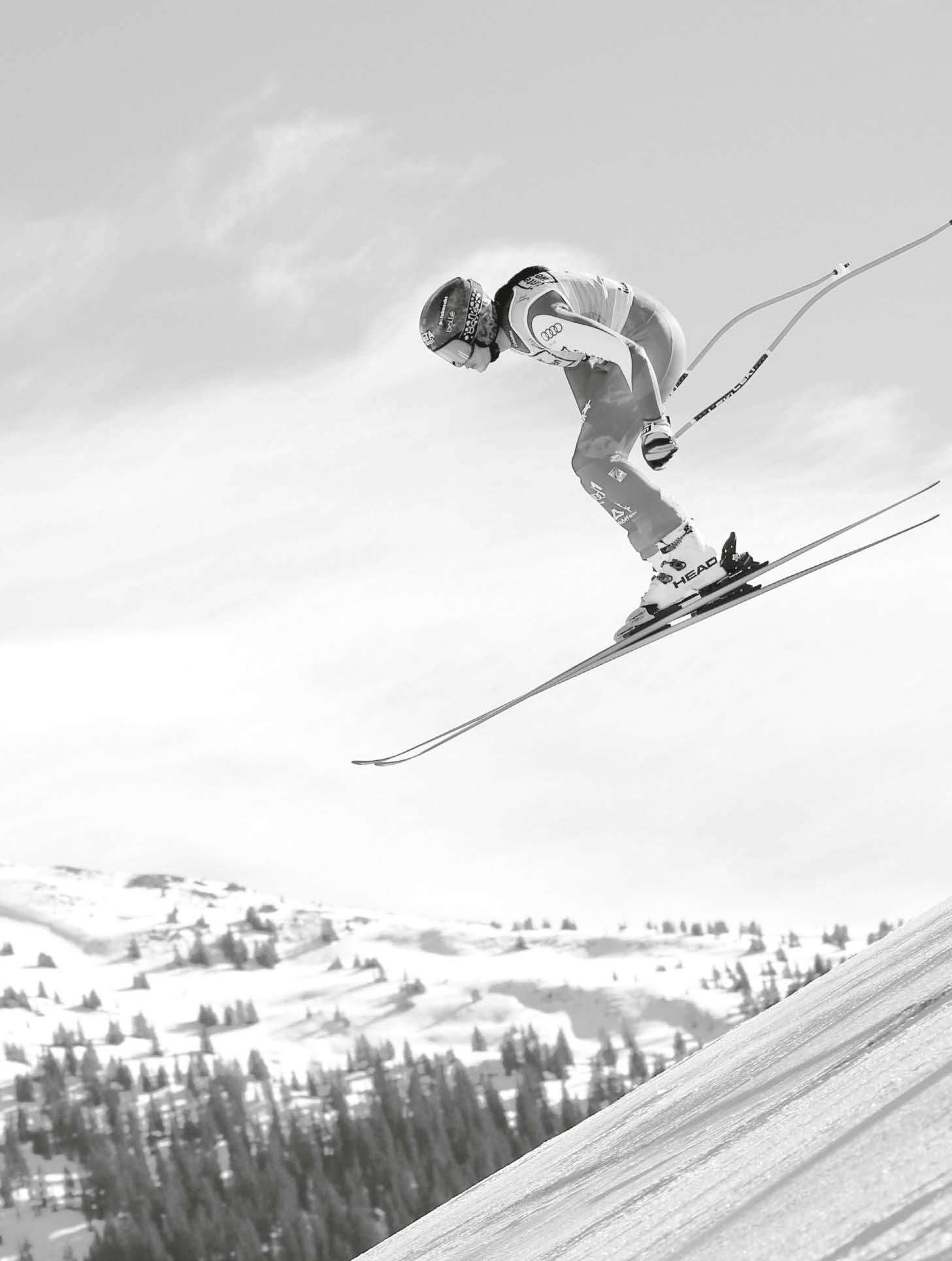
“I’M FINALLY UP TOMORROW”
What’s up, Steffi? Via WhatsApp, Stephanie Venier kept us up to date with her preparations for an entire year, from the World Cup final in Saalbach in 2024 to the World Championships in 2025. Read – and see! – the best bits from an extraordinary longterm interview.

Thanks, all good so far, still enjoying the summer to the full but won’t be long till winter. Loving my time at home with friends and pizza evenings. 22:47

Hi Hannes holiday in the Maldives was amazing, really enjoyed it. Saw everything you could want to (sharks, dolphins, rays, turtles & squid). nicely refreshed now 08:57

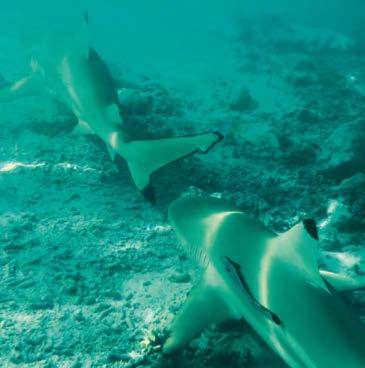
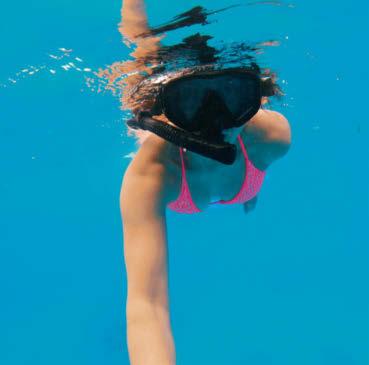
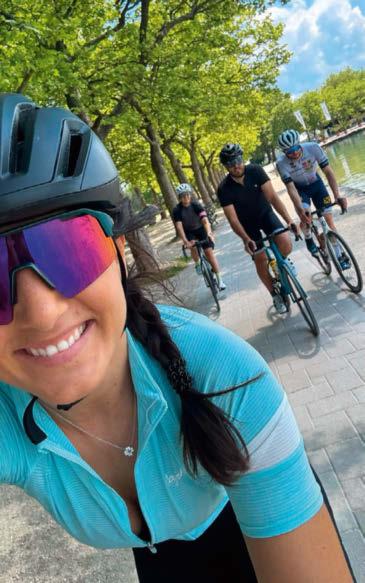
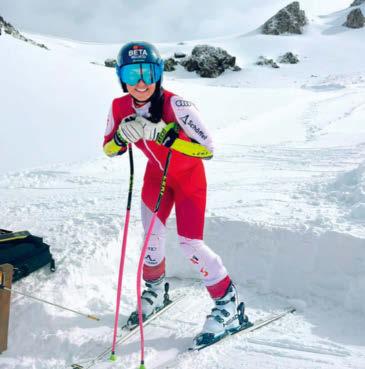

Already caught world champ fever the parallel race was perfect for getting in the mood & I’m finally up tomorrow 13:07

World champs were mega. Mega organisation, mega mood & mega cool people! Had a bit of time to relax but now it’s all ramping up again 15:38

The first snow in La Parva, Chile: “Cool pistes, perfect weather.”
WhatsApp chat Hannes Kropik
In the summer, Steffi trains hard on her road bike.
After the end of season, Steffi sneaks off snorkeling and sees sharks in the Maldives.
Steffi looks forward to her pizza on her boyfriend Christian’s terrace.
Stephanie Venier with gold and her loved one, her boyfriend Christian Walder.
The gold medallist was awarded the certificate of honour by her home municipality.
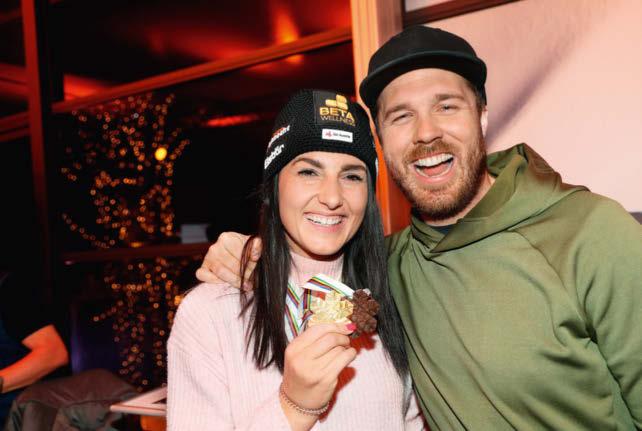
time another skier took to the course. And then I’d won. My family was there. Christian was there. They were my support network during the hard times when things weren’t going well, so it was extremely important to me that we were all able to celebrate this moment together.
I felt your sufering when you were asked for the 10th time: “So, have you done enough?” I didn’t want to celebrate prematurely. Things often happen at the World Championships or Olympics that don’t occur at the World Cup. I tried to remain calm –I could only really celebrate once the last person had crossed the fnish.
You said it was the perfect run. Is there such a thing? For me, yes. I didn’t make a single mistake and was constantly in the fow. So I really felt like it was the perfect run. It was the best run I’ve ever made in my career.
Today, more than ever, everything’s getting faster and more dangerous. How do you deal with the risk? Everything’s getting more extreme – the gear, the requirements. Often, the conditions difer between the top and the bottom. Everyone gives their very all. This makes it challenging – but also fascinating.
How do you recharge your batteries?
Sleep is extremely important to me. I barely slept before the super-G as I was so nervous, like a small child. But afterwards, I slept like a log again.
Do setbacks make you stronger?
Absolutely. I had two terrible years and thought about throwing in the towel. But I fought my way back. And doing so made me stronger. In sport, as in life, you have to stick with things.
The home World Championships were a big thing and there was a lot of pressure – especially after your poor start to the season. Did you feel it? Yes, I put a great deal of pressure on myself. I wanted to deliver at the home World Championships. I knew that great things could happen if everything went right. And the pressure – especially in Austria – was tangible. But that’s also part of the thrill.
Do you have a lucky charm? My cushion. I take it everywhere.
STEPHANIE VENIER
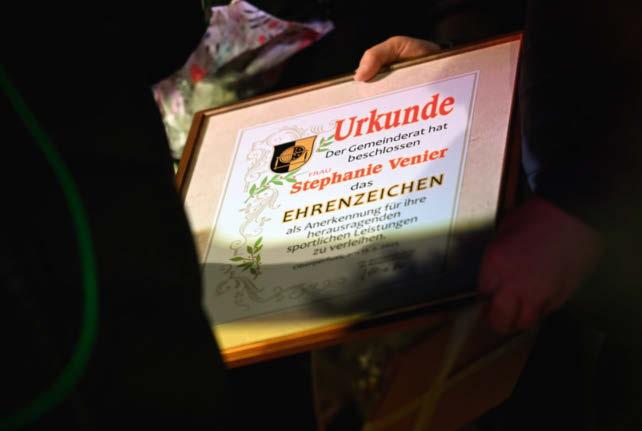
“I
BARELY SLEPT BEFORE THE SUPER-G AS I WAS SO NERVOUS, LIKE A SMALL CHILD.”
How would you summarise the week? It couldn’t have gone better. Let’s hope it continues this way.
It’s the men’s downhill today. Where will you watch it? From my bed, snuggled under the covers, with a cofee.
You said that you’re the oldest super-G World Champion – at 31. That’s not very old, is it?
I don’t think so. If you enjoy what you’re doing and are both physically and mentally ft, you can keep going for years.
Where do you see yourself in ten years’ time? At home, married, with children. Living a quiet life, with a house, cofee and cake. And still involved in the world of skiing.


IN AN INTERVIEW WITH
BIKE ARTIST FABIO WIBMER
Stephanie Venier met the social media star during the World Championships – to talk about winning gold, success and plans for the future.
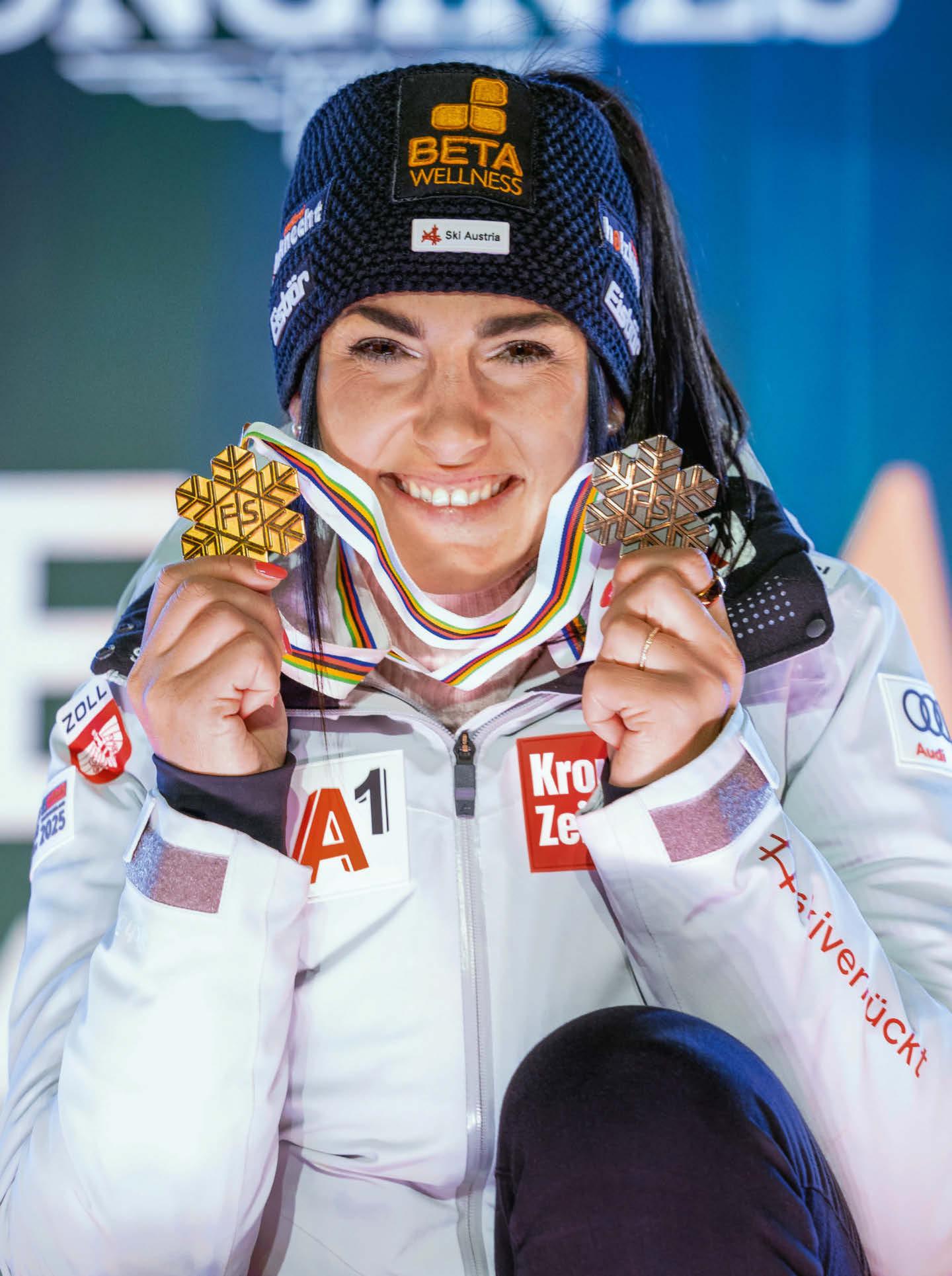
Double medallist: Stephanie Venier during the celebrations at the medal plaza
RAPHAEL HAASER
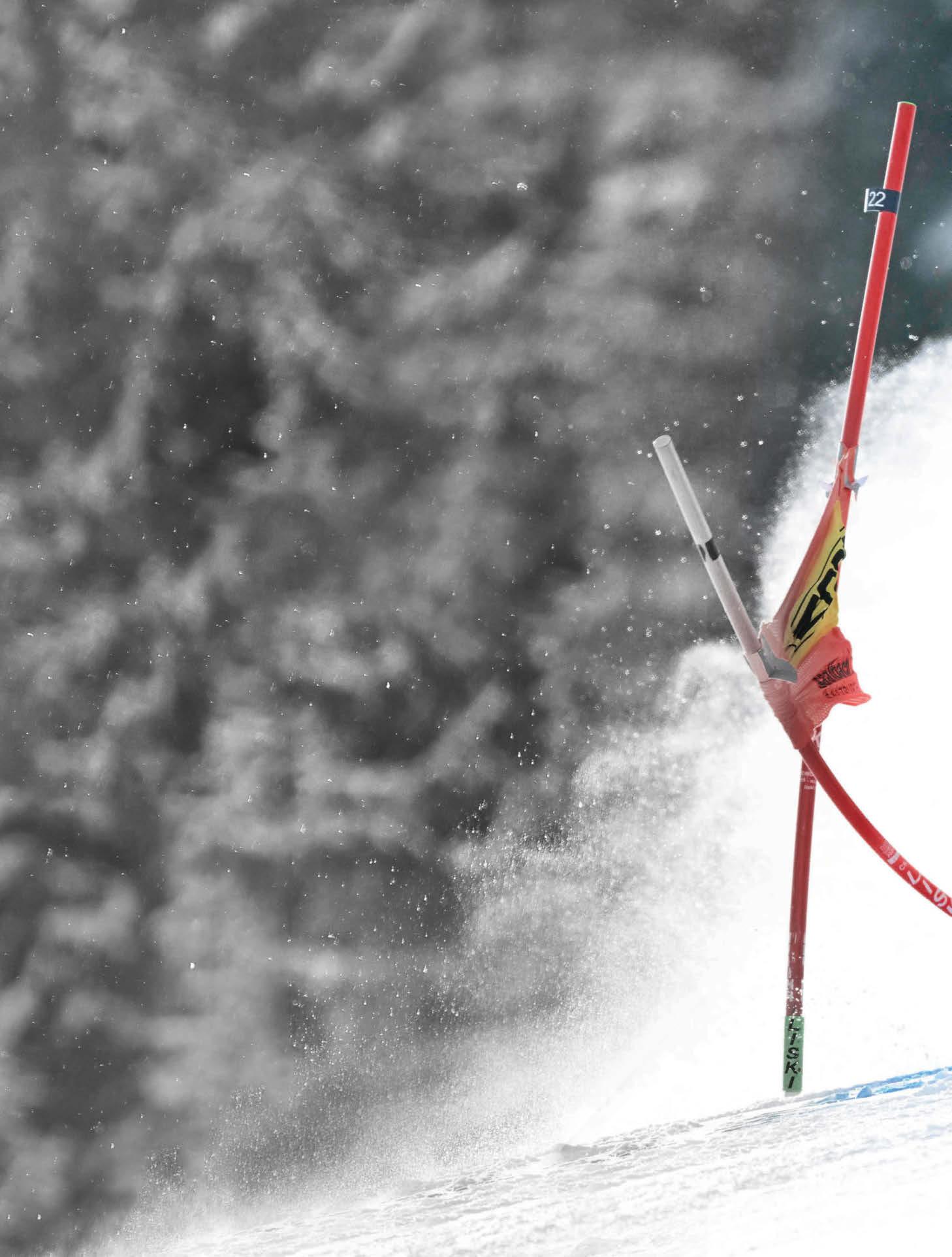
“THE OTHERS ARE NERVOUS ENOUGH”
Raphael Haaser defied injury, doubt and pressure – to become the Austrian Ski Association’s most successful athlete in Saalbach with gold in the giant slalom and silver in the super-G.
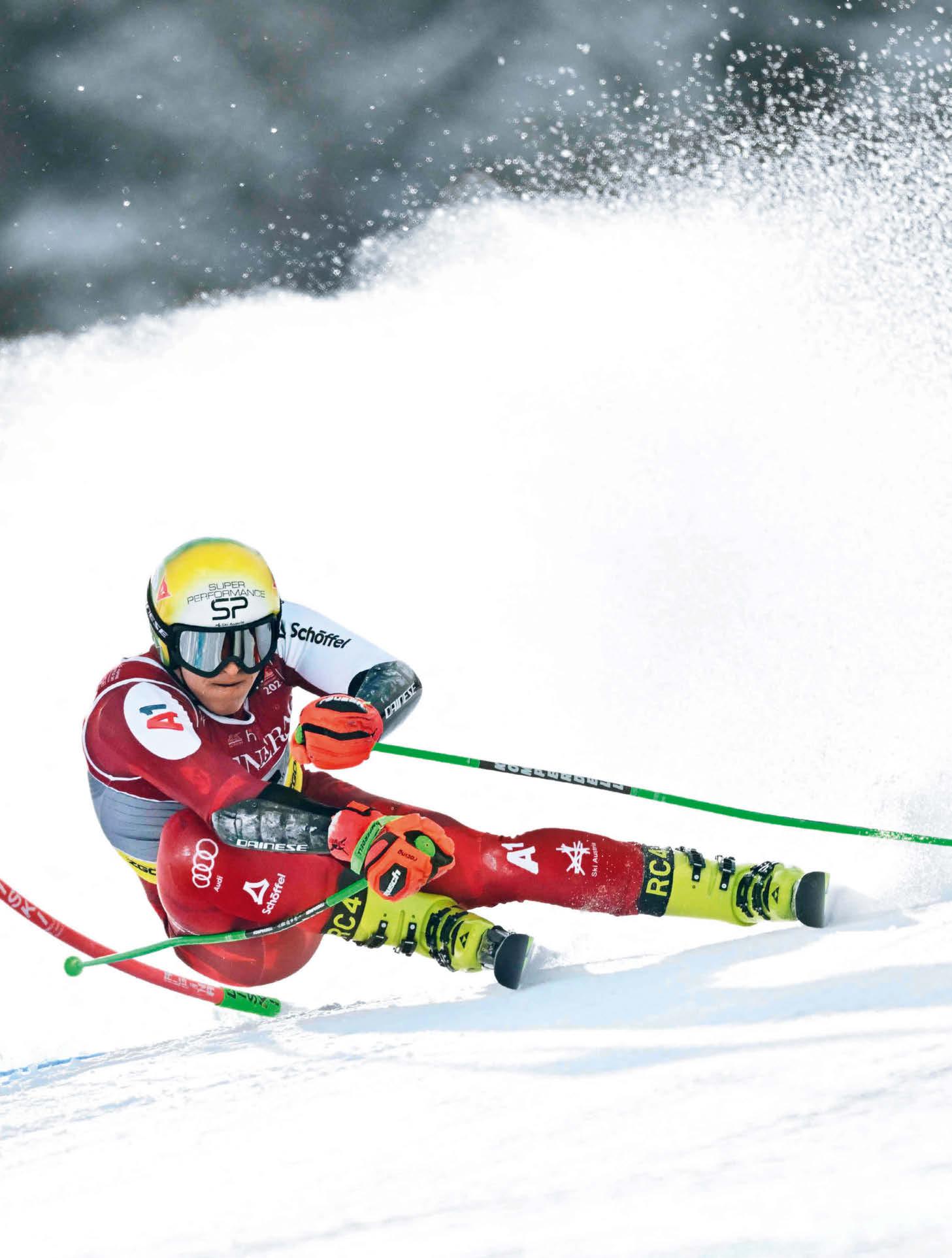
Going for gold: Raphael Haaser on his second giant slalom run in Saalbach.
Raphael Haaser can’t believe it (top), then proudly flies the Austrian flag (bottom).
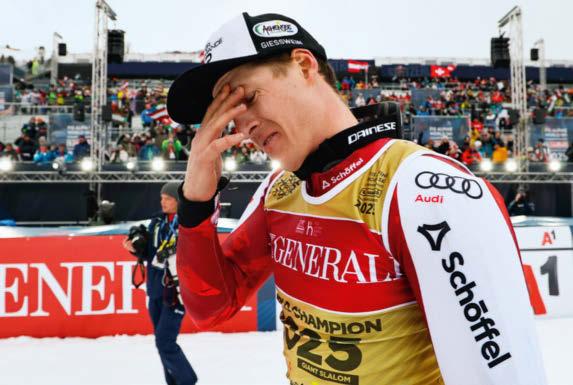
The day Raphael Haaser was to write ski history started less than promisingly. “I’d barely slept and was tired. My recent injury and poor results during the season meant that I had zero expectations coming into the giant slalom.” But sometimes, men like Haaser can accelerate from 0 to 100 in record time. And 14 February 2025 was such a day.
The fact that Haaser made it to Saalbach at all was a small miracle. Just two months previously, he had fallen at the World Cup in Val-d’Isère. The diagnosis: a strained cruciate ligament and a six-week break. As a minimum.
“What terrible timing, so close to the World Championships”, was Haaser’s frst thought. But because sport sometimes overrides the rules of logic, the mishap actually turned out to be a blessing in disguise.
This is because Haaser was able to do what skiers can never do at this point in the season. He whipped himself into shape. He also enjoyed some distance from the skiing world bubble and realigned his mindset. “When I got back to it at the end of January, I felt fresh and ultra-ft,” he said. His competition, on the other hand, seemed drained by their races and all the travelling around the continent.
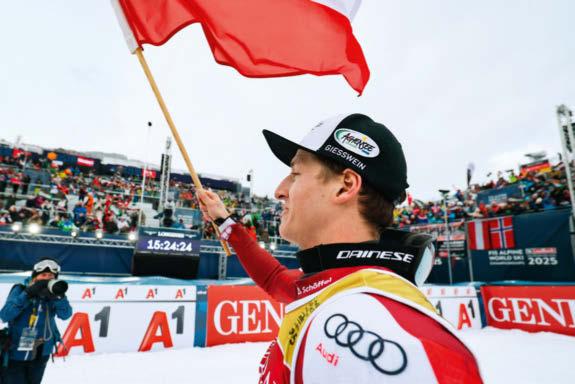
“WHEN I GOT BACK TO IT AT THE END OF JANUARY, I FELT FRESH AND ULTRA-FIT.”
His frst post-injury race was the Classic in Kitzbühel. The Tyrolean threw down a brilliant super-G run in the ‘Lärchenschuss’ and ‘Hausberg’ sections and fnished second. From a sporting perspective, this guaranteed him a ticket to the World Championships, something that is always hard-fought for in a skiing nation like Austria. “One of my biggest worries was that me getting to Saalbach was dependent on the good nature of the coaches.” From this moment, this worry was eased slightly.
RAPHAEL HAASER
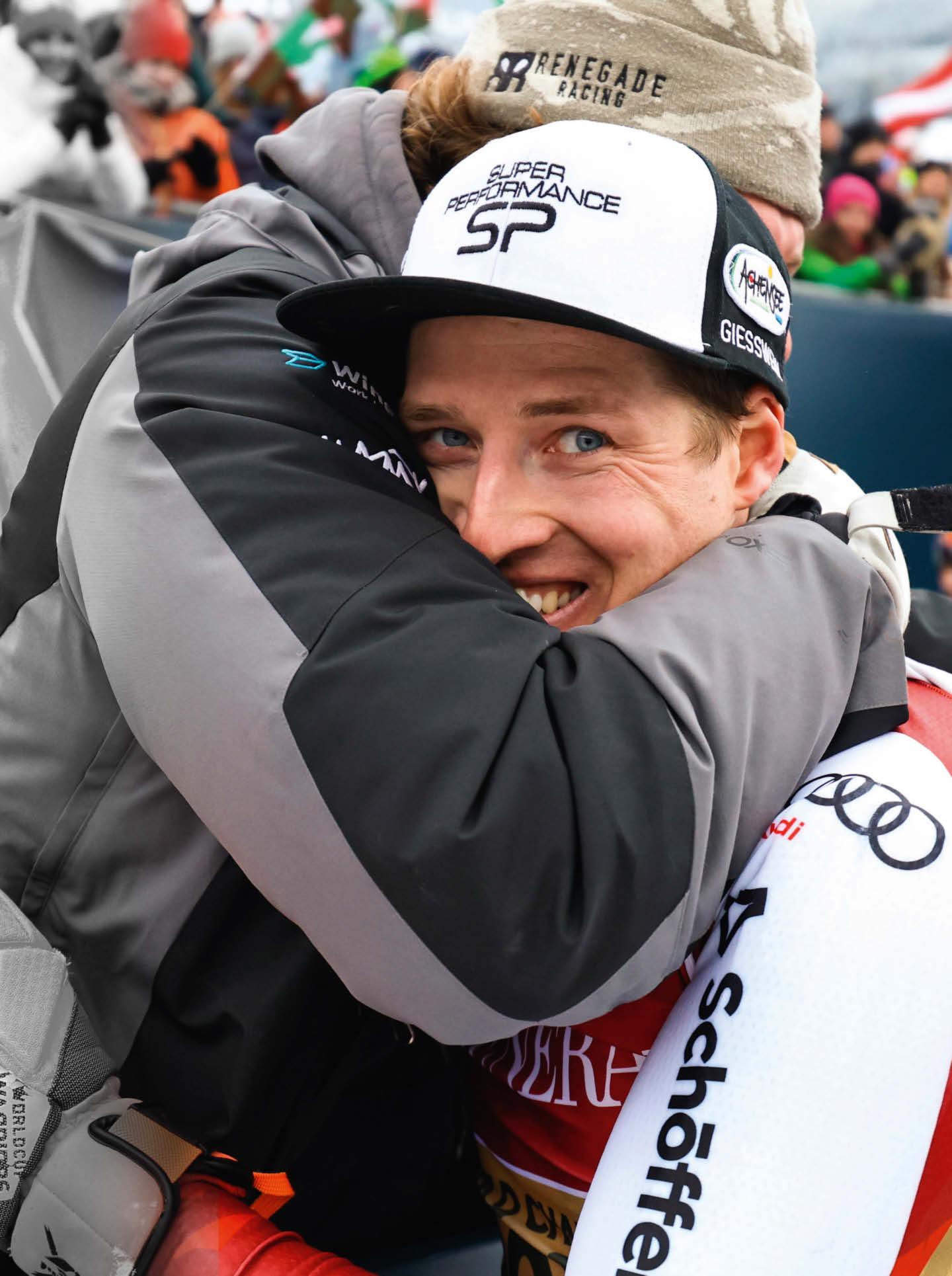
A smile that says it all: Raphael Haaser grins broadly after his giant slalom win.
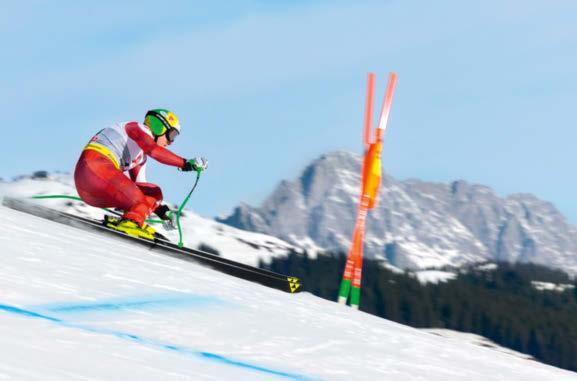
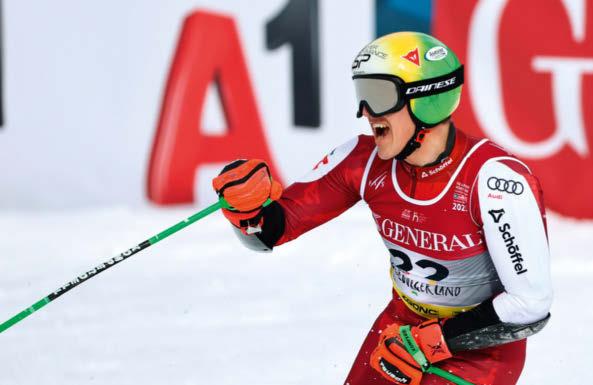
“OF ALL THE AUSTRIAN SKI ASSOCIATION SKIERS, I WAS THE ONE WITH THE LEAST TO LOSE.”
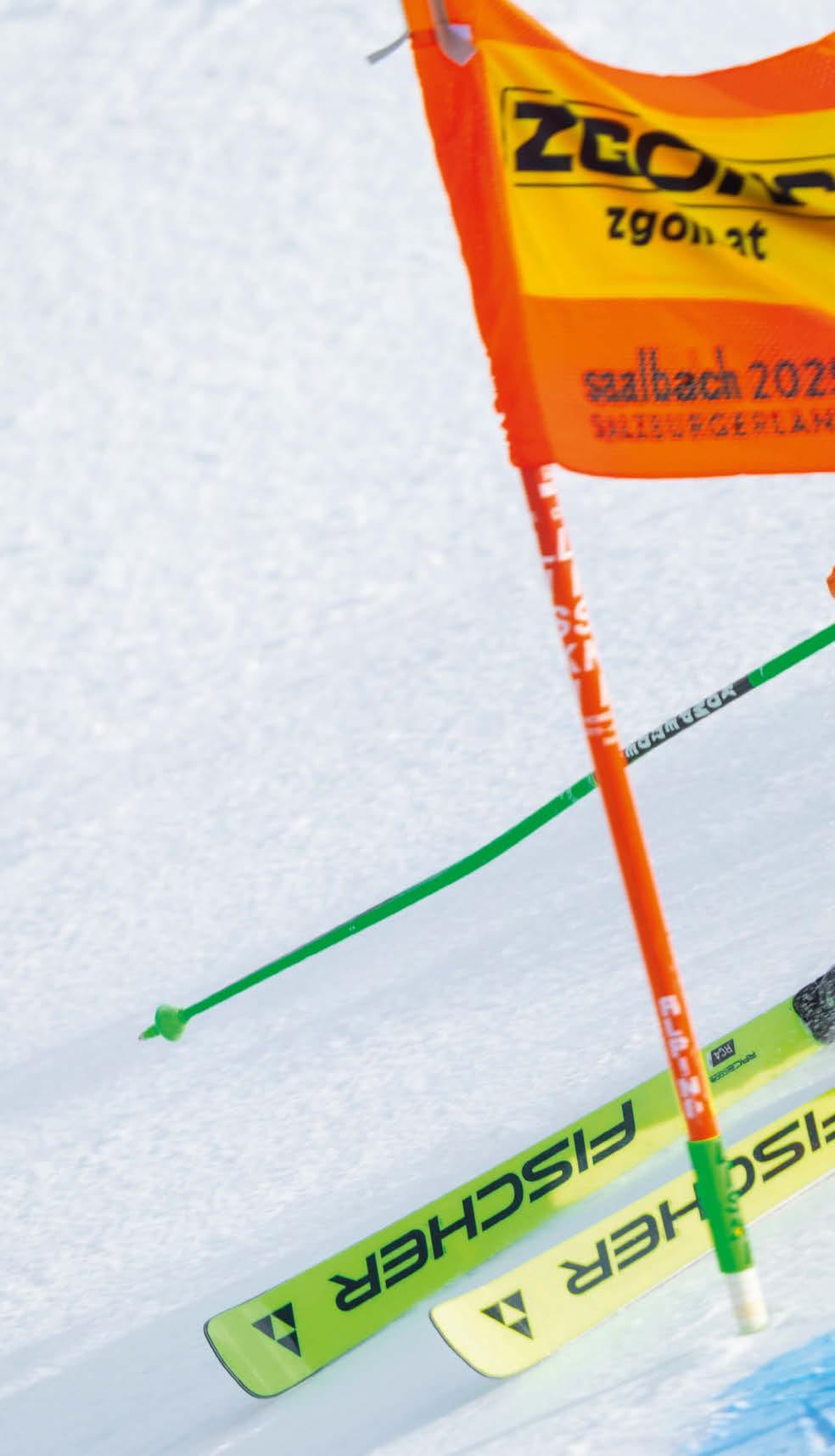
RAPHAEL HAASER
Raphael Haaser on a training run at the World Ski Championships in Saalbach.
Joy in the finish area: Raphael Haaser at the giant slalom.
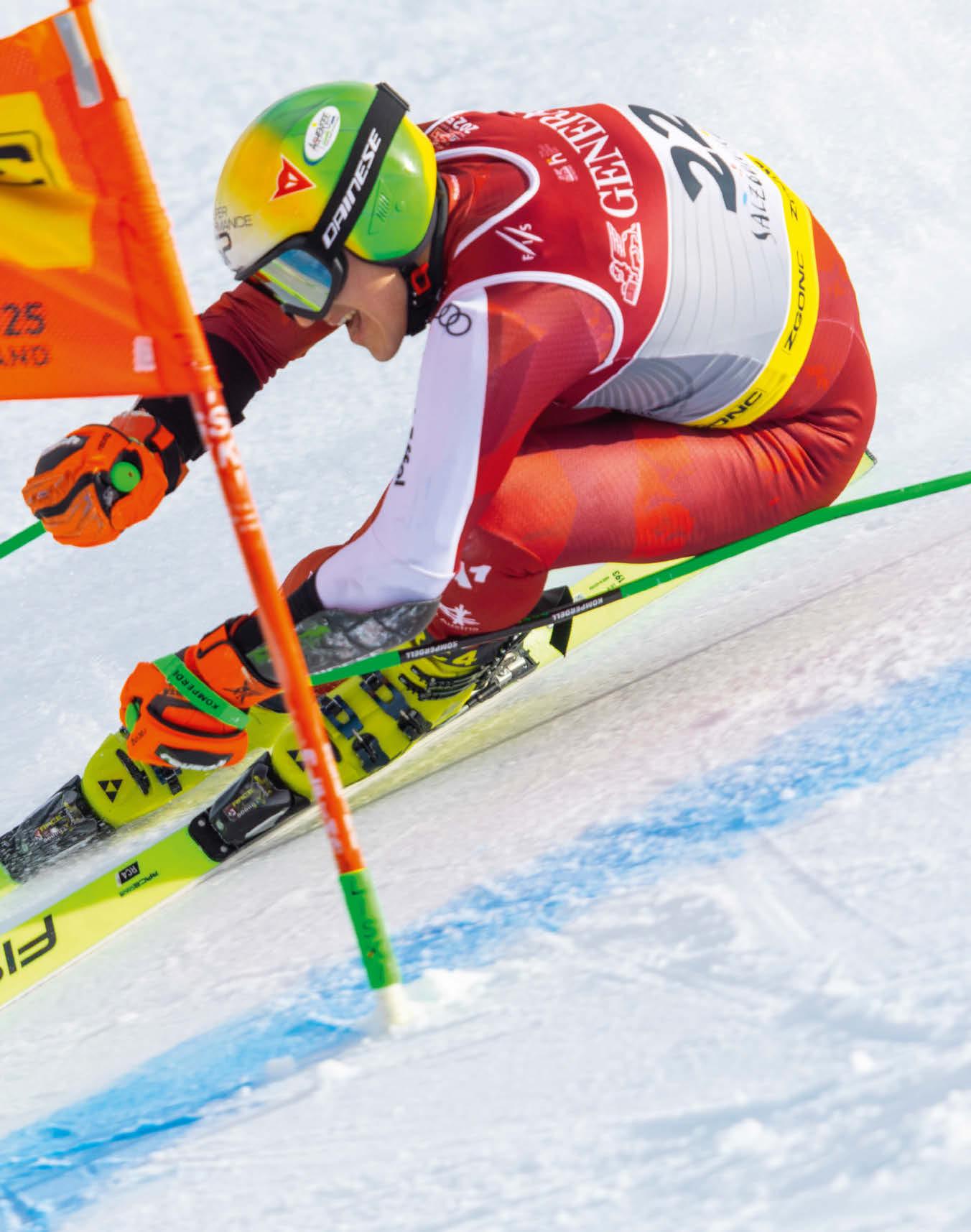
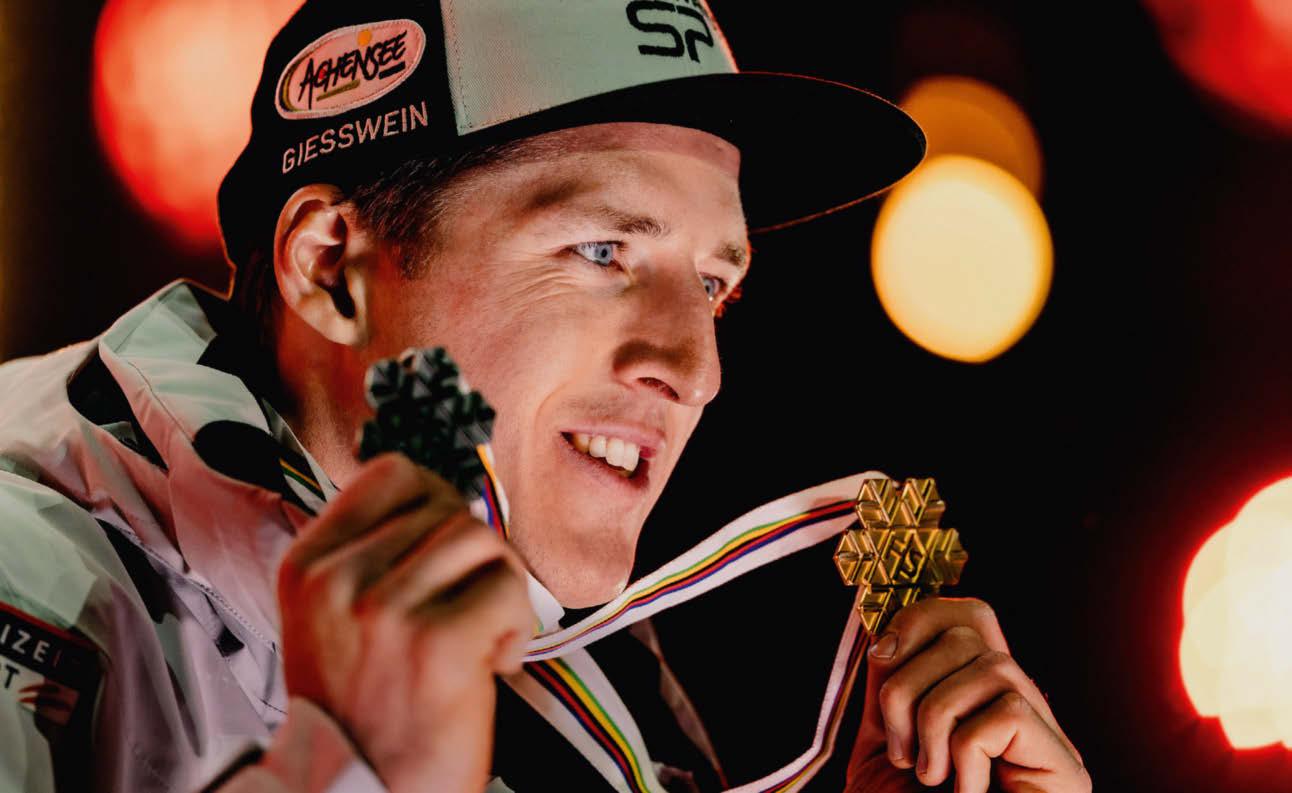
“MY AIM WAS TO HAVE A GOOD RACE FOR ME AND TO SHOW WHAT I’D GOT.”
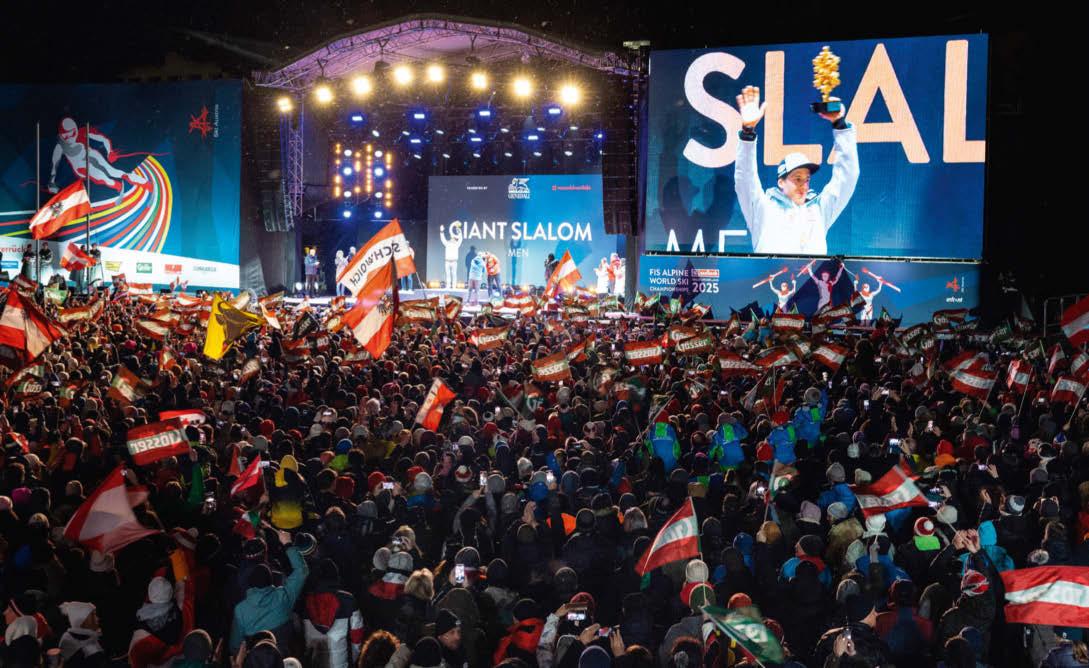
Thousands of people cheered Raphael Haaser at the award ceremony on the medal plaza in the heart of Saalbach.
Double success: Raphael Haaser with his gold and silver medals
Raphael Haaser with the Austrian flag during the celebrations in the arena
But because worries are pack animals, another worry arose at the start of the World Championships. His sister Ricarda fell during her super-G race, sufering a torn cruciate ligament, putting her out of the World Championships and ending her season. The kind of accident that touches everyone, especially a brother. “At the time, what struck me the most was that she’d already had to overcome so many injuries and had now incurred yet another setback”, says Haaser. When he tried to call Ricarda in the evening, she was lying on an operating table in Innsbruck. When he called again the next day, he already had his frst World Championship medal around his neck. He had come second in his own super-G race, beaten only by Swiss superstar Marco Odermatt.
Despite or because of his sister’s fall? “It’s hard to say”, comments Haaser. “Once I knew she was in good hands, I tried to push her fall out of my mind. Afterwards, I felt it was important to share my success with her though.”
If the story had stopped there, it would already have had a conciliatory ending. But 14 February was still to come, the day of the giant slalom, when a badly rested 27 year old headed to the start under pretty poor conditions and without any great expectation. “Of all the Austrian Ski Association skiers, I was the one with the least to lose”, says Haaser, who all experts also regarded as miles from being the favourite. “My aim was to have a good race for me and to show what I’d got.”
“IT FELT EASY; THERE WERE NO PINCH POINTS OR TIGHT AREAS.”
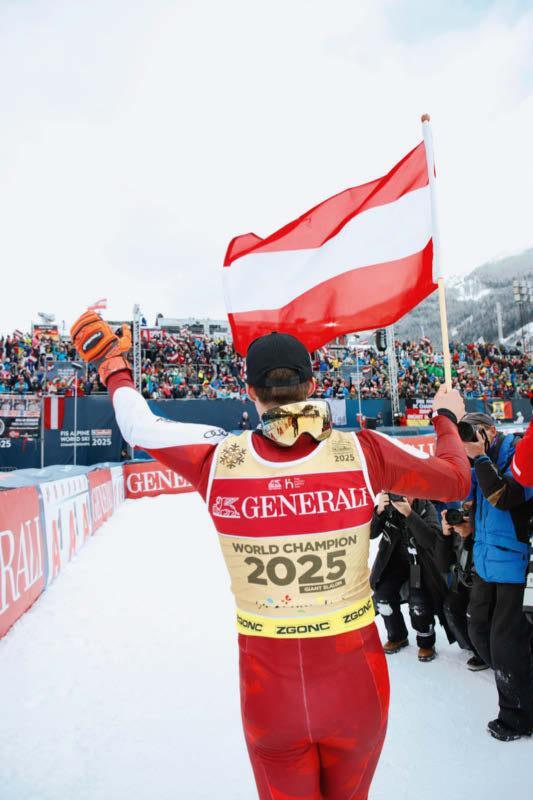
In fact, he had the most sensational run of the World Championships. After ending the frst round in ffth, Haaser pulled of a dream run that exceeded anything he’d ever done before. “It was the best giant slalom run I’ve ever done in terms of both my body position and my attack.” From half way down the course he hit every turn perfectly, gliding to the fnish as though on rails. An almost trance-like run. “It felt easy; there were no pinch points or tight areas.” On crossing the line, he had a lead of 23 hundredths of a second over the competitor in second place, Thomas Tumler from Switzerland. And so, the ‘Iceman’ had struck again. This is how Haaser is often nicknamed in Skicircus. Because he performs when it matters. Because he’s known for short answers rather than lengthy outbursts of emotion. And because he never seems to get nervous. “A very successful skier once told me: ‘There’s no reason to be nervous. The others are nervous enough.’ I had this advice in the back of my mind.”
Raphael Haaser prefers not to reveal the source of the quote. “If he reads this article, he’ll know that I’m talking about him”, he says with a wide grin. This borrowed attitude helped him become a double medal winner in Saalbach and the most successful Austrian athlete of these World Championships. All despite some big hurdles in the run-up. But not big enough to stop Haaser from writing skiing history.
“WE’RE ONE BIG FAMILY”
Every run at the World Ski Championships in Saalbach is celebrated – regardless of nation or position. We rejoice the concept of resounding fairness and chat to skiing legends as we analyse why our spectators behaved so amazingly.
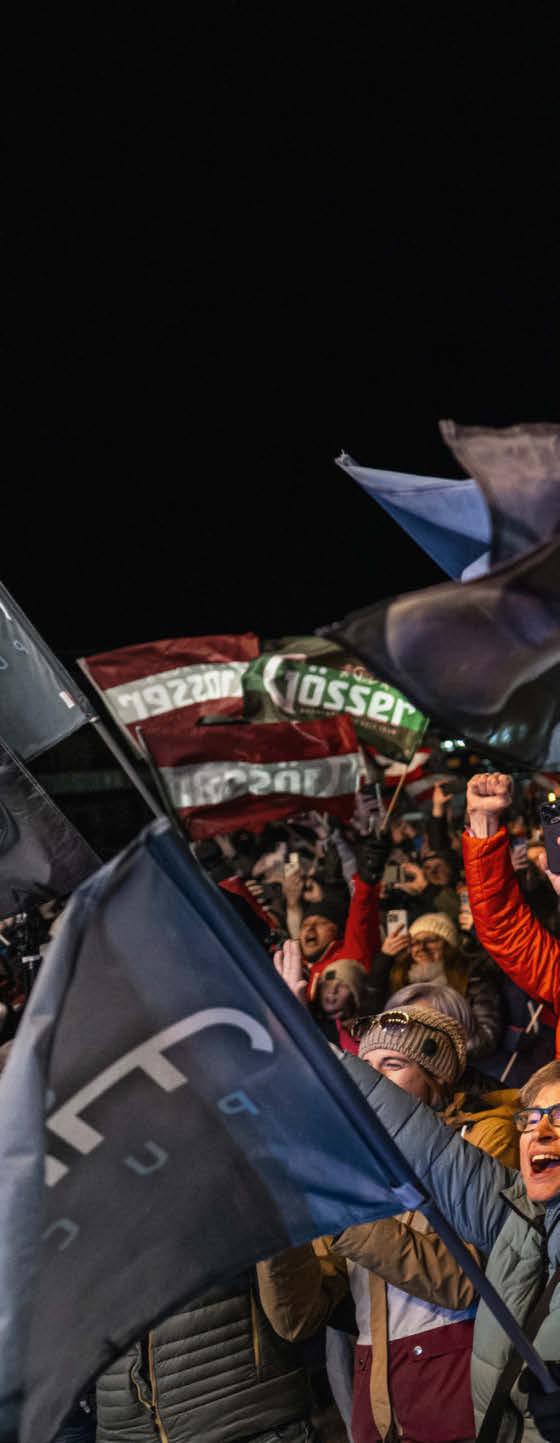
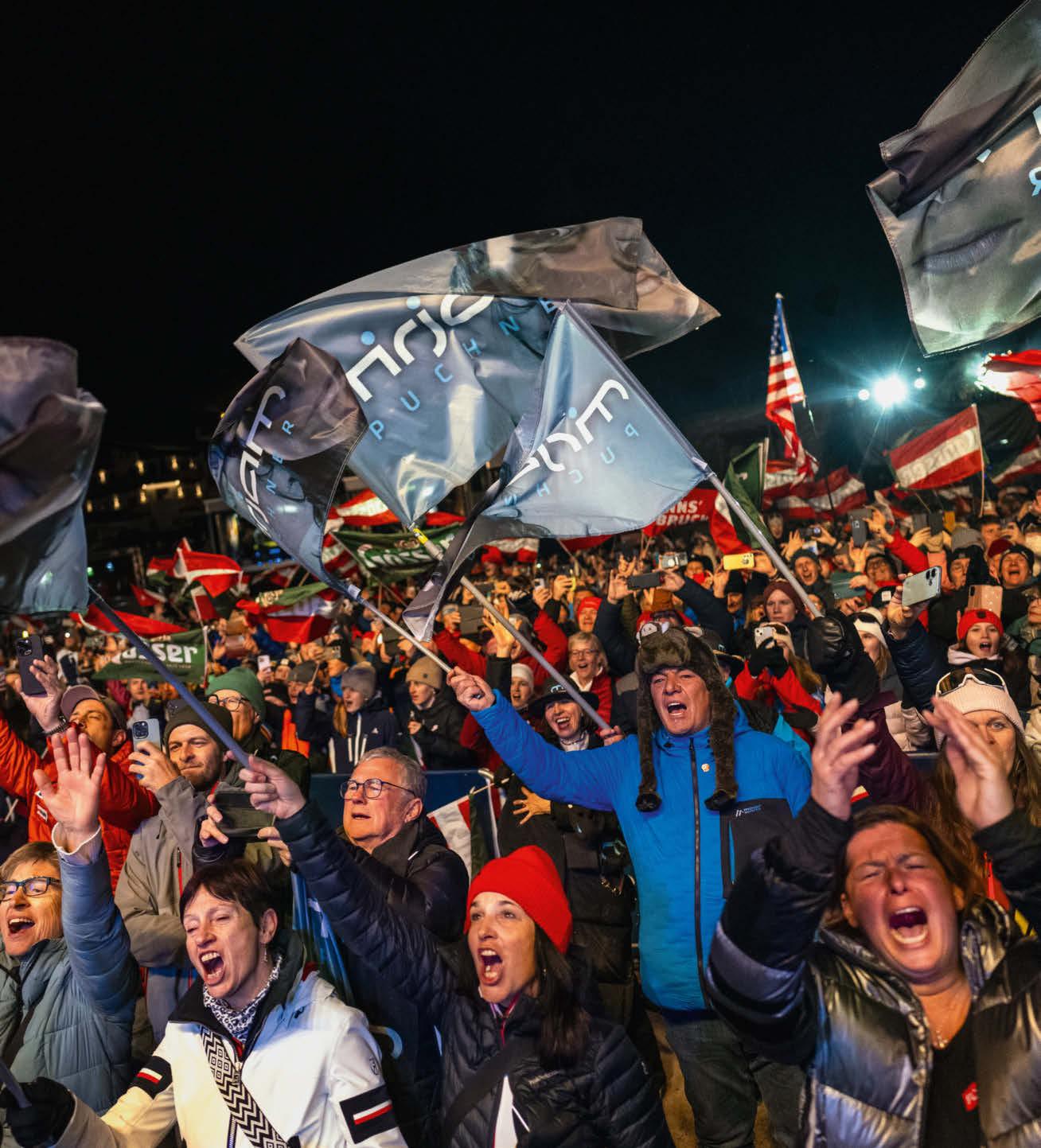
Cheers fll the air as Barnabás Szőllős glides across the fnish in bib number 48. He’s 3.48 seconds behind the leader, Swiss skier Franjo von Allmen, and will ultimately fnish 37th in the men’s downhill.
But at this moment, none of that matters. In the ‘Hexenkessel’ fnish area in Saalbach, Szőllős is celebrated as enthusiastically as all those before and after him – whether favourites or underdogs.
Born in Budapest in 1998, Barnabás Szőllős, who makes up the three-person Israeli ski team together with his sister Noa and his brother Benjamin, looks truly relaxed as he has his photo taken with fans outside the arena later on and chats to his friends about where they could go to fortify themselves after the race.
The broad grin on his face speaks volumes. “The piste is really cool”, he says. “Everyone is applauded, regardless of which country they’re from. The spectators are impressively fair.”
Fairness is a term that’s on everyone’s lips, but nowhere does it seem to be such a prevalent part of things as in the world of skiing – and this is particularly noticeable at the World Ski Championships.
But what does it mean to be fair? We journey back in history to fnd out.
It’s widely agreed that fairness is about more than just following the rules. It’s a moral attitude based on balance, equality and mutual respect.
Historically, the idea of fairness fnds its roots in the English sporting spirit of the 19th century. In the Empire’s public schools, sport was regarded as a training feld for the morals: winning was good but it was better to play fairly. This was refected in the idealisation of the ‘gentleman athlete’, who honoured his opponents rather than insulting them.
In his work ‘A Theory of Justice’, the philosopher John Rawls proposes defning justice on the basis of a thought experiment. As humans, we should design the rules of our coexistence as though unaware of our future social and economic status. Those who take decisions under this ‘veil of ignorance’ will establish fair, i.e. just, principles.
In sport, fairness accordingly means creating conditions that give everyone the same chance of success – and recognise all achievements.
For the sociologist and sport philosopher Gunter Gebauer, fairness is a form of recognition: “Fairness is an attitude. It is based on the knowledge of the vulnerability of others.”
At the World Ski Championships, this is refected in the behaviour of the spectators, who enthusiastically applaud all athletes, even those like Szőllős who have no chance of a podium position.
Two-time World Champion Alexandra Meissnitzer explains this phenomenon through the deep appreciation that ski fans have for the sport and its heroes: “Regardless of who has won, I believe that ski fans know what we all put into this. And it makes us proud to regularly hear athletes saying how indescribable it feels to have thousands of people cheering for you as you cross the fnish line.”
Is that something specifcally Austrian? “I’ve never before seen it to the extent that I’ve experienced here. But I also think that’s partly to do with the layout of the stands. People are sitting and standing close together. That’s good for the overall atmosphere. The mood is contagious.”
This emotional proximity to the sport leads to a special kind of community in the stands. Meissnitzer even refers to a kind of “freedom” that’s created when you honestly cheer for everyone.
Marlies Raich, the second most successful female slalom skier in history with 35 World Cup victories, also sees spectators as a central force. She believes that skiing is fundamentally diferent to other sports like football: “You’d never cheer for the opposing team in a football stadium. But when it comes to skiing, especially in Austria, people simply love skiing.”

“You get excited about every great achievement.”
RAICH
Born on 31 May 1981 with the maiden name Schild, Marlies has won four Olympic medals and the most slalom World Cup victories after Mikaela Shiffrin: 35. She is married to the former (also highly successful) ski racer Benjamin Raich and mother to three children.
“Everyone is applauded, regardless of which country they’re from. The spectators are impressively fair.”
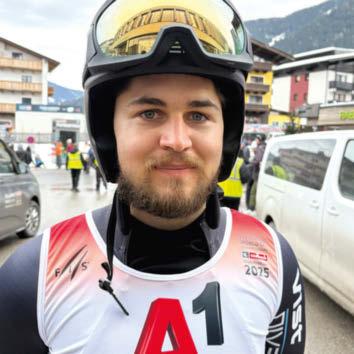
BARNABÁS SZŐLLŐS
Born on 13 December 1998 in Budapest, Barnabás is a Hungarian-Israeli ski racer. He finished in sixth place in the alpine combined at the 2022 Olympic Games, the best result an Israeli skier has ever achieved at the Olympics.
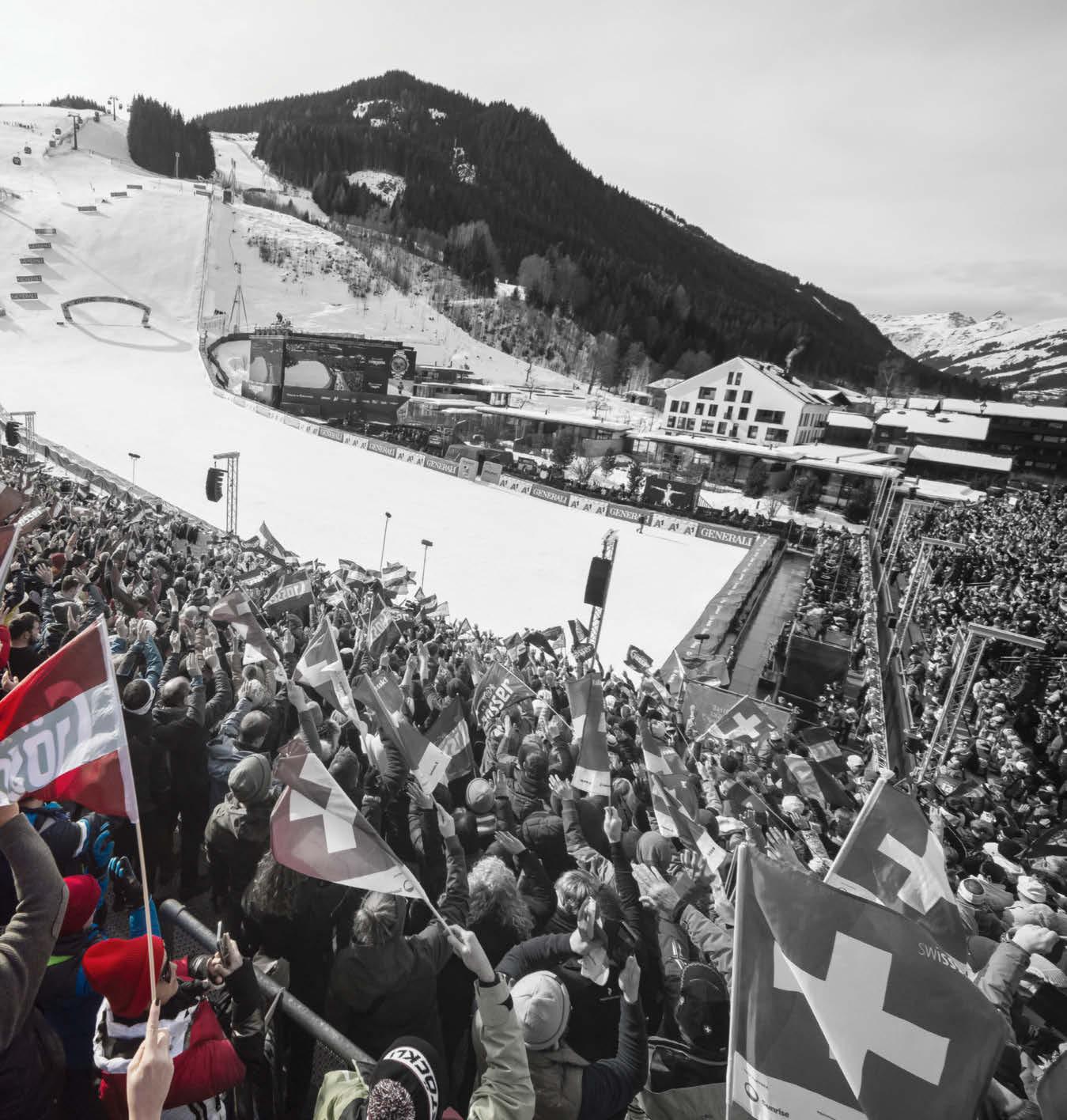
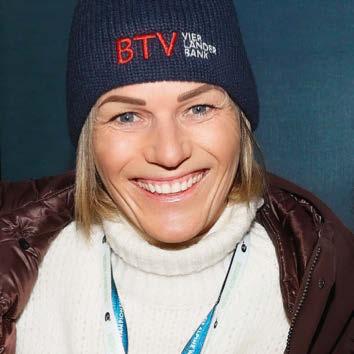
Born on 18 June 1973, Alexandra won the overall World Cup in 1999 and is the holder of two World Champion titles. Following her retirement from her active career, she now works as a TV expert and commentator.
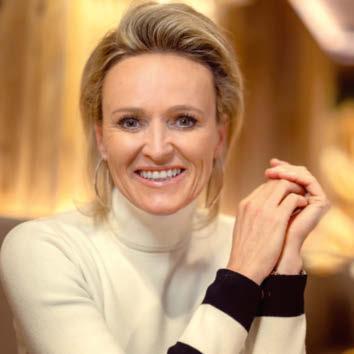
“Regardless of who has won, I believe that ski fans know what we all put into this.”
MARLIES
ALEXANDRA MEISSNITZER
“Imagine only cheering for one competitor –it would be pretty boring.”
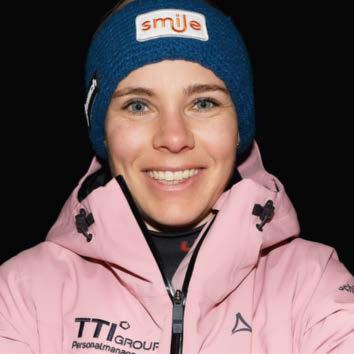
Born on 15 March 1989, Nicole was named super-G world champion in 2017 and won the downhill discipline title in 2019. She retired from skiing in 2023. Today, her work includes hosting a successful podcast with Conny Hütter.
“Thankfully, there’s no envy and no fanaticism in our sport –instead, there’s just an abundance of positive support.”
Born on 5 November 1970, Mario won Olympic gold in the combined event in Nagano in 1998 and retired from active sport at the end of the 2000/2001 season.
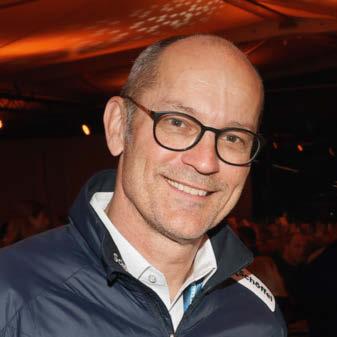
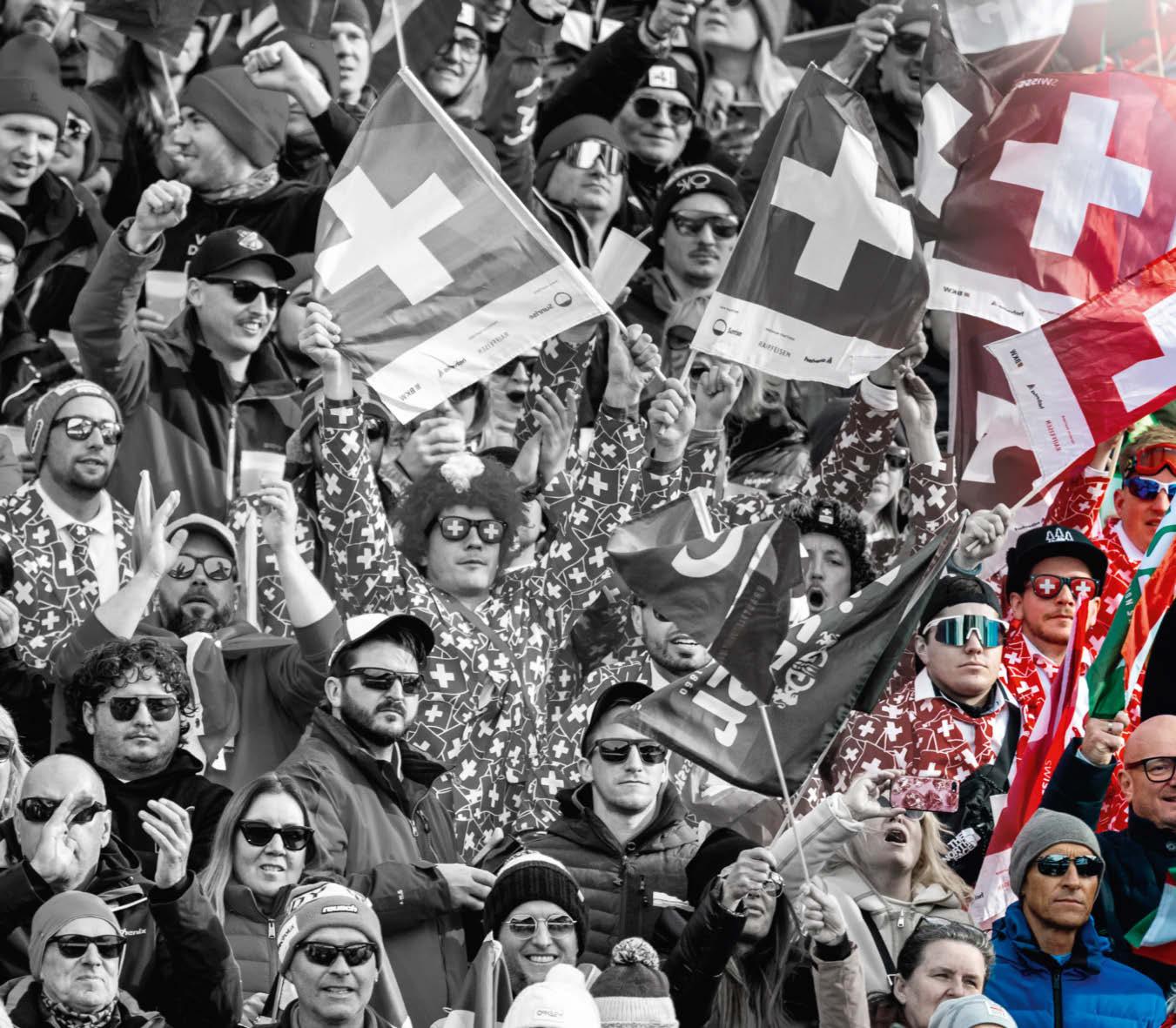
FRITZ STROBL
Born on 24 August 1972, Fritz won Olympic gold in the downhill in 2002 and the team World Championship title in 2007. He retired from skiing that same year after a total of nine World Cup victories.
“Skiers are one big winter sports family.”
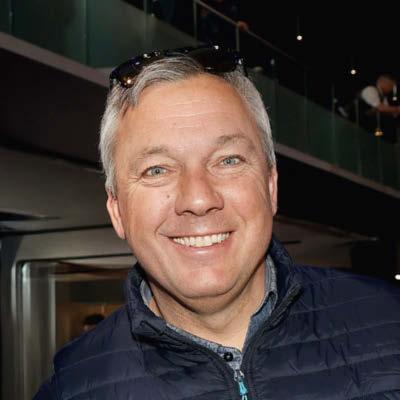
NICOLE ‘NICI’ SCHMIDHOFER
MARIO REITER
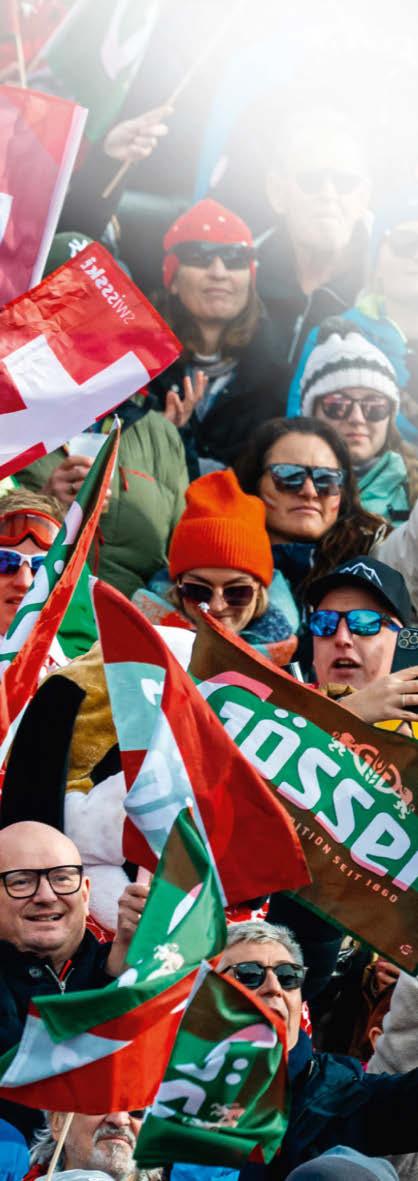
Raich describes an atmosphere where people from diferent backgrounds share the enjoyment of sporting achievements. She believes that spectators don’t just come for ‘their’ athletes – they come for the experience itself, for the amazement, the excitement and the beauty of the moment.
This attitude connects generations, as Raich observes: “You get excited about every great achievement.” This also points to a culture of openness, which is impressively demonstrated in Saalbach. A stadium full of fags – not as a symbol of delimitation, but as an expression of mutual recognition.
For Olympic champion Mario Reiter (who won gold in the men’s combined in 1998 in Nagano, Japan), this attitude also has to do with the symbolism of the mountains: “The further we are from sea level, the more obvious it becomes that there are no diferences. Up there, everyone is the same.”
Reiter describes the atmosphere in skiing as fundamentally appreciative, almost friendly. Fan clubs from diferent countries treat each other with respect – spontaneous meet-ups, shared meals and little rituals of togetherness are far from uncommon. He recalls: “They then cut up the bacon together.”
The fairness practised by the fans is something that makes alpine skiing truly unique for skiers. “Thankfully, there’s no envy and no fanaticism in our sport – instead, there’s just an abundance of positive support.”
This observation is confrmed by the statements of numerous athletes who feel that they’re treated equally thanks to the applause in the fnish area –whether they come in 1st or 41st place.
Nicole Schmidhofer, super-G World Champion (gold medallist in St. Moritz in 2017), also believes that the world of skiing ofers the freedom for individual recognition beyond nationalist attributions. She regards fairness as a pragmatic principle: “Imagine only cheering for one of the many competitors – it would be pretty boring.”
Schmidhofer emphasises that there is greater focus on individual achievements in skiing than in team sports. That’s why the recognition given by spectators is so honest and immediate. The enthusiasm for Marco Odermatt is as clearly felt as that for Vincent Kriechmayr – despite one of them coming from Switzerland and the other from Austria.
“I think that everyone understands that a World Champion’s success is well-deserved, even if they wanted someone else to win.” What counts is the achievement – not nationality.
For downhill Olympic champion Fritz Strobl, fairness is also a matter of culture: “Skiers are one big winter sports family.” He doesn’t see spectators as a fan camp, but as the co-creators of a sporting festival.
According to Strobl, Swiss, Norwegians and Austrians often stand shoulder to shoulder in the world of skiing. Clashes? Not at all! “Unless too much alcohol has been drunk”, he says with a smile. But even then: respect dominates. The fans are aware of the hard work, the risks and the efort – and therefore treat one another with high regard.
Strobl remembers his home World Championships in St. Anton (2001): “It was so loud that it almost put me of.” (He ultimately came sixth in the downhill.) This jubilation isn’t just reserved for the winners, but for everyone who has run their race courageously and fairly.
Fairness in skiing is more than just an ideal – it’s actively practised. And perhaps also a model for other areas of society. In his work ‘Justice’ (2009), philosopher Michael J. Sandel indicates that justice can’t be based on objective criteria alone – it’s also always linked to dignity, recognition and social participation. These are the aspects that make the applause for Barnabás Szőllős so signifcant. It’s not just a gesture – it’s an attitude.
What was seen at Saalbach in 2025 was an impressive form of practised fairness based on experience, proximity to the sport and mutual respect. It was manifested through applause, cheering and genuine smiles – even for those in 37th place.
This attitude makes skiing special as it reminds us that all achievements deserve recognition –irrespective of a person’s fag, nation or medals. And while Barnabás Szőllős takes one last selfe in front of the arena with his friends, he says quietly, almost to himself: “I was just happy to have been here.”
BREEZY JOHNSON
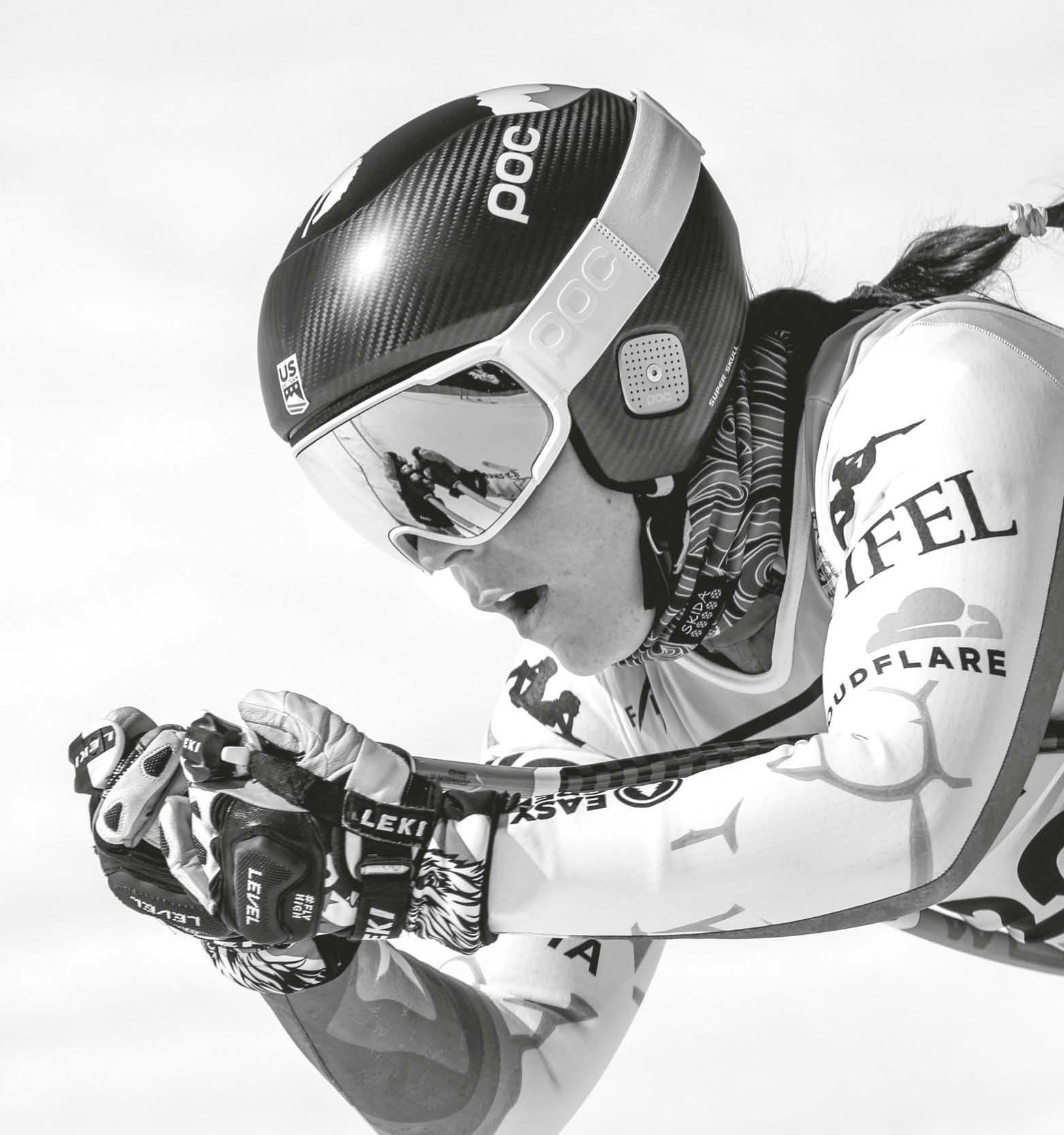
AS FAST AS THE WIND
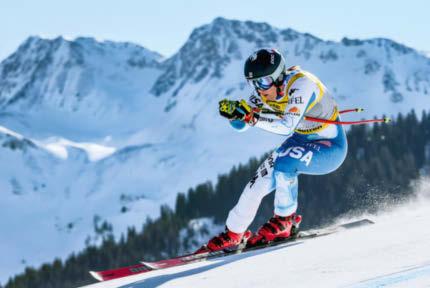
PERFECTLY IN THE FLOW
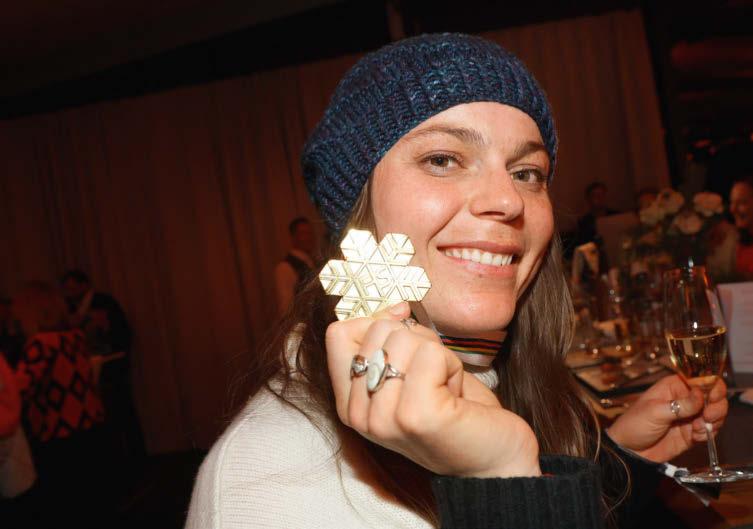
With her arms firmly directed forwards, Breezy Johnson flies towards the finish, crossing it in first place. In the evening, she proudly shows off the reward for her efforts: gold in the women’s downhill.

American Breezy Johnson took her first major title in the downhill wearing bib number 1 – and used the tailwind of her success to win a second World Championship title in the team combined event.
Wearing bib number 1 can be an advantage: a fawless run puts pressure on all the competitors who follow. However, it can also be a disadvantage if the visibility or piste conditions improve. The skiers who follow can also gain new insights on the start and adapt their choice of line. But one thing is certain: the frst to reach the fnish will automatically bathe in the cheers of the fans as the leader. And this is exactly what American Breezy Johnson did, without realising that she was about to win her frst race –at the World Championships in Saalbach of all places!
Breezy whirls through life
Breezy Johnson was born in 1996 in the ski paradise of Jackson Hole in the American state of Wyoming. She learned to ski at three years of age on the driveway to her parents’ house. At age fve, she competed in her frst race (with her beloved cuddly fox stufed under her bib number). From a young age, Breezy has looked for the thrill and the exhilaration of speed, especially on the pistes – in pursuit of her 20 months older brother Finn.
Her energetic way of sweeping through life like a whirlwind gave her mother Heather and her father Greg an idea: they realised that her ofcial name – Breanna –was less suited to their daughter than her nickname, and had her baptised Breezy.
And Breezy Johnson certainly lives up to the speedy connotations of her name. She attended the prestigious Rowmark Ski Academy in Salt Lake City, which has trained, among others, Picabo Street to become a worldclass athlete (downhill World Champion in 1996 and super-G Olympic champion in 1998). Breezy competed in her frst FIS race at age ffteen and her frst Junior World Championships at age sixteen.
She stormed her way unstoppably into the World Cup, where she repeatedly fnished in the top 10. Her consistently good results qualifed Breezy Johnson for the World Championships in 2017 and the Olympic Games in 2018. But her rise to victory as a skier suddenly ground to a halt: she missed the 2018/19 season due to tearing the cruciate ligament in her right knee, then tore both the cruciate and collateral ligaments in her left knee during her comeback the following year.
Copying Saalbach for perfect training conditions
Breezy Johnson has become a philanthropist. She supports the climate protection initiative Protect Our Winters and works closely with Coombs Outdoors, a local organisation in her birth town of Jackson Hole that provides underprivileged children with access to skiing and other outdoor sports.
This is because Breezy Johnson had more time than she’d have liked on her way to Saalbach: in October 2023, she received a 14-month suspension for failing to notify the US anti-doping authority of her correct place of residence – including at a training camp in Chile – three times within a twelve-month period.
The suspension prevented her from joining her colleagues at the World Cup fnal in Saalbach in 2024. But that didn’t mean that Breezy Johnson couldn’t intensively prepare for the races on the Zwölferkogel. With her suspension preventing her from accessing her usual support team and service personnel, she dug deep into her own pockets and enlisted a private trainer, Stefan Abplanalp.
The Swiss coach had previously guided the Slovenian Ilka Štuhec to the World Champion title in the downhill in 2017 and 2019. He developed a plan for Breezy Johnson that was worth pure gold: he organised glacier training for her in Saas-Fee in Switzerland and recruited the local piste manager Dominik Kalbermatten as an assistant.
With Kalbermatten’s help, he essentially imported Saalbach into Switzerland: “We knew that the World Championship course would generally be pretty fat, but peppered with waves”, says the shrewd coach in an interview with the Swiss magazine ‘Blick’. “We therefore used a snow groomer to create our own artifcial terrain transitions so that Breezy could get used to conditions like those in Saalbach.”
Even during the training runs, Breezy Johnson showed that she had perfectly mastered her lessons by fnishing in second, second and sixth. Despite this, she still had a long and worrisome wait after her dream run in the number 1 bib until the fnal competitor reached the fnish line. But you can also learn patience: the trepidation was back three days later, until her colleague Mikaela Shifrin swooped down the slalom for the team combined and the beautiful number 1 lit up once again. After 104 nonvictorious races in a row, Breezy Johnson was crowned double World Champion in Saalbach.
BIOGRAPHY
Born: 19 January 1996 in Jackson Hole, Wyoming, USA / Height: 173 centimetres / Weight: 66 kilos / Skis: Atomic / Biggest successes: World Champion in downhill, World Champion in team combined (with Mikaela Shiffrin) 2025
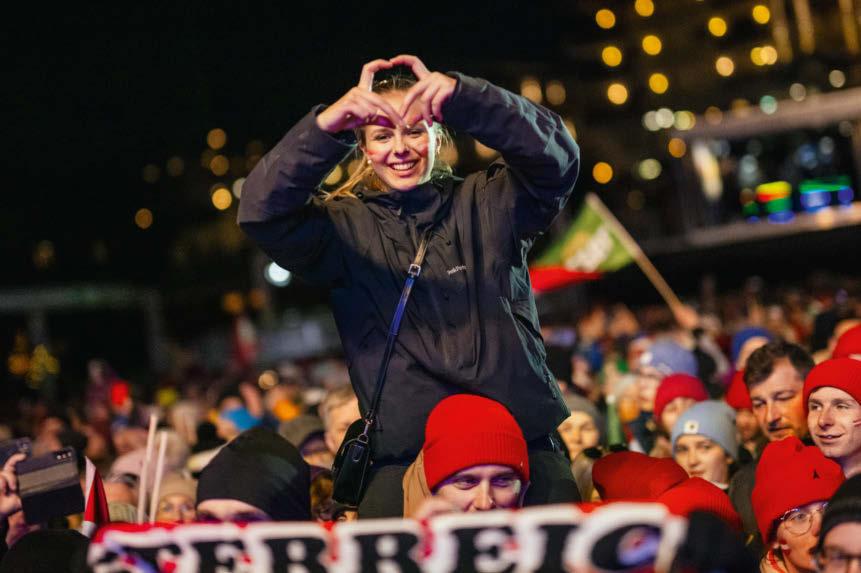
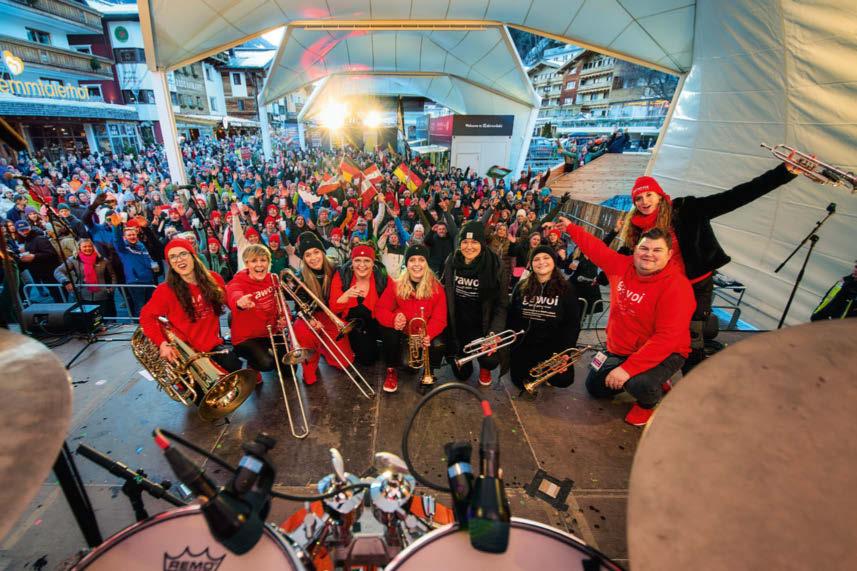
THUMBS UP!
Manuel Feller at an autograph session, surrounded by young fans who all clearly love Austria. Visible in the background: Brazil’s star Lucas Pinheiro Braathen.
TIME FOR SOME FUN!
Live concerts create a party atmosphere on the fan mile. The Desperate Brasswives sport jumpers with the slogan ‘Gawoi’, derived from the rallying cry ‘Gaudi, Jawoi!’ (‘Fun, hell yeah!’).
COLD YET WARM Cheeks painted redwhite-red, hands forming a heart. This young woman is happy to be at the award ceremony on the medal plaza –like thousands of other fans too. Everything’s
so laid back you can even get close to the stars!
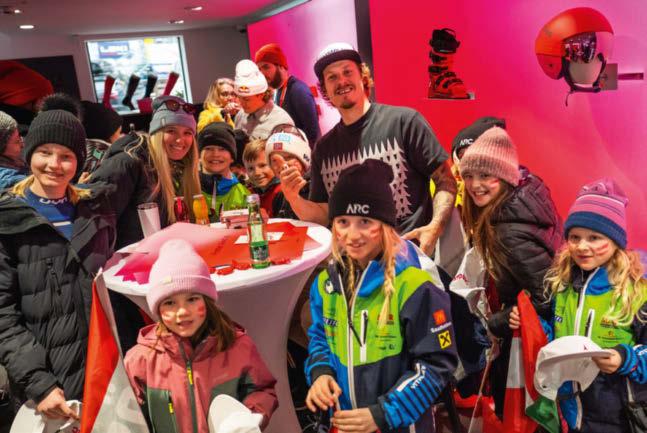
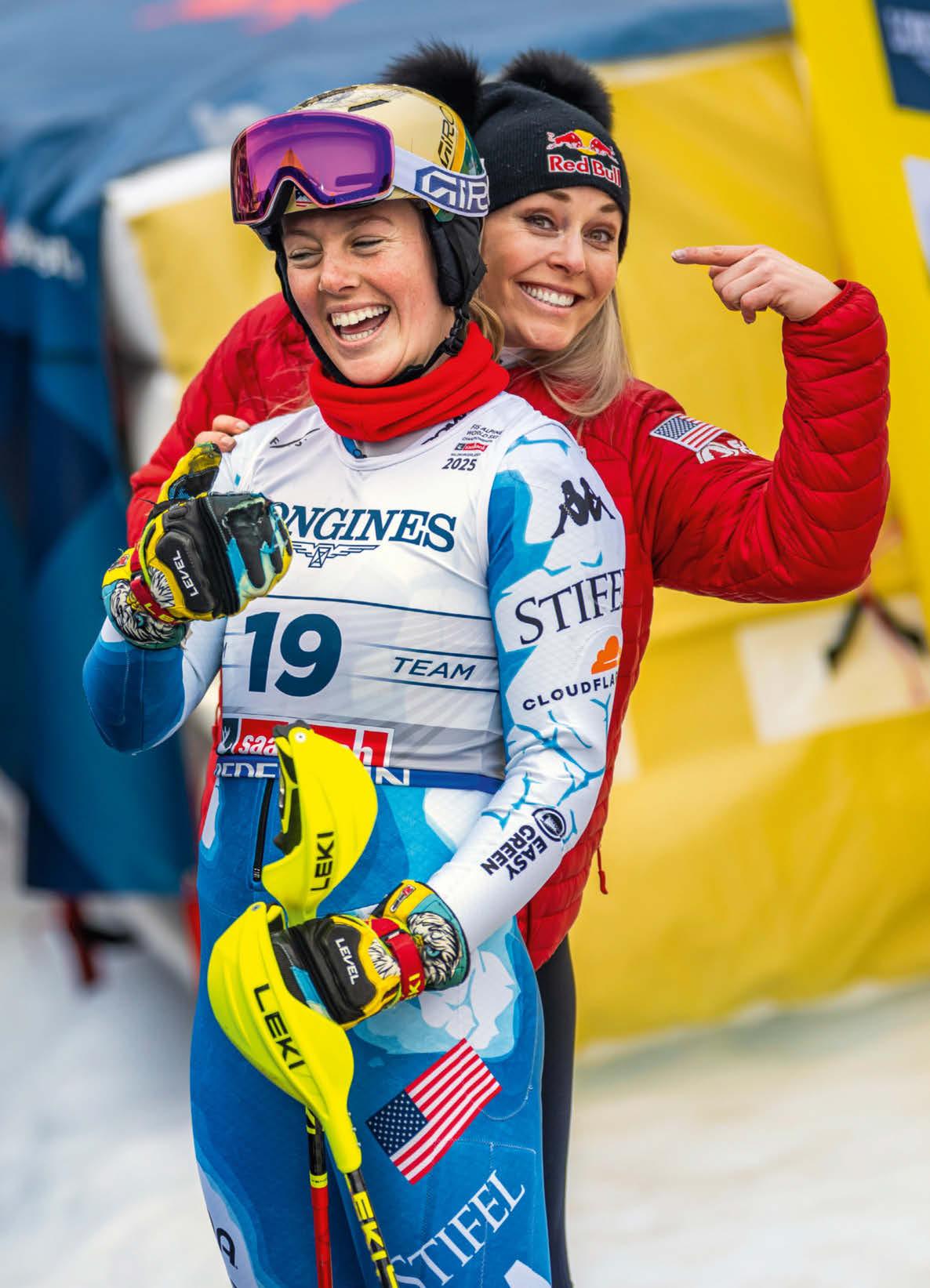
LIVELY LADIES
Lindsey Vonn, who astounded everyone with her comeback, points happily at Amelia Josephine Hurt, known as AJ. The pair finished 16th in the team combined.
DRESSED HEAD TO TOE FOR SUCCESS
Ah, the Swiss!
The Zwölferkogel became a golden mountain for the Swiss, whose fans celebrated with every fibre of their outfits. Thanks for the support!
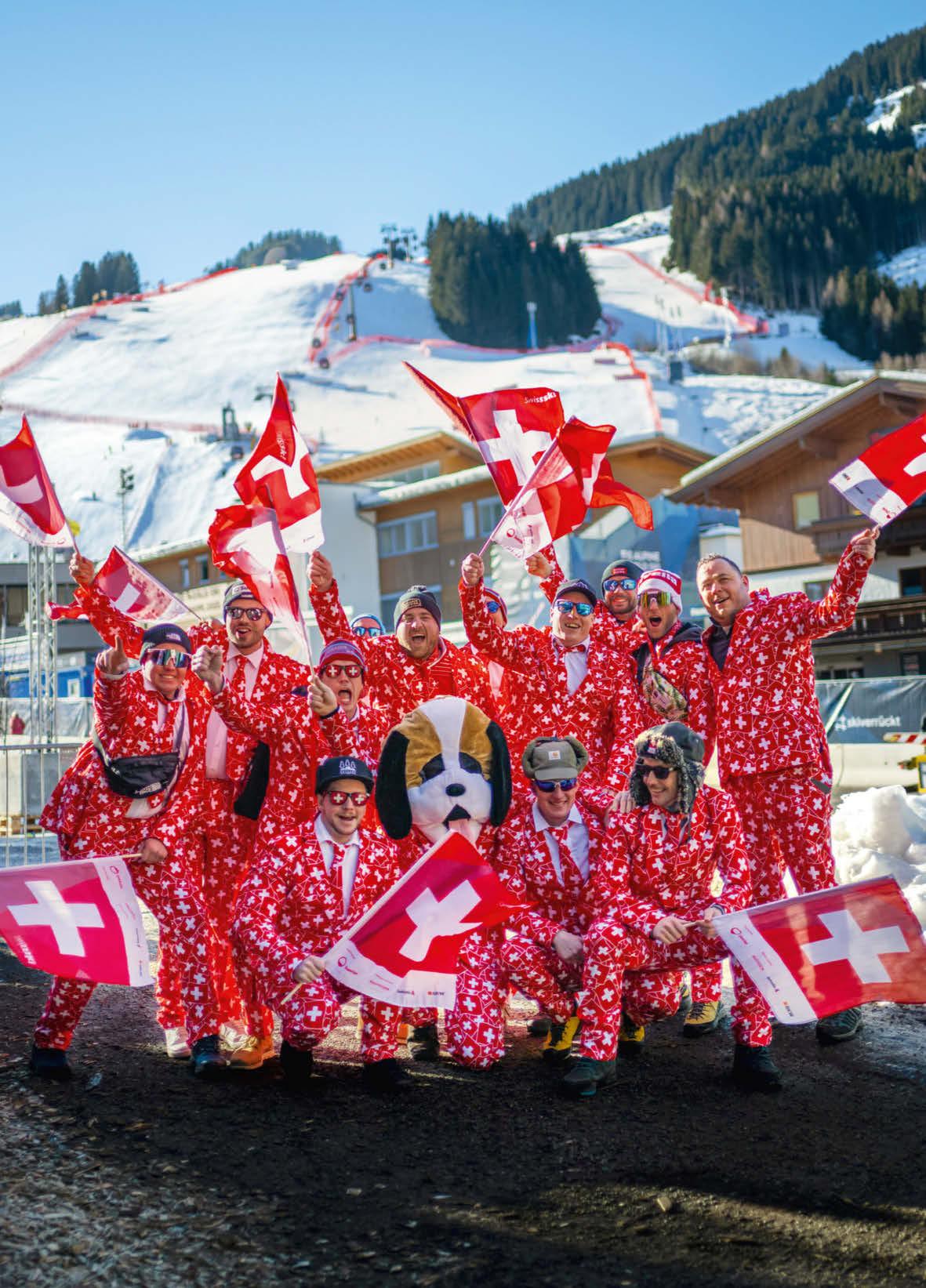
The fans brighten up the World Championships in Saalbach Hinterglemm with their outfits and their mood.
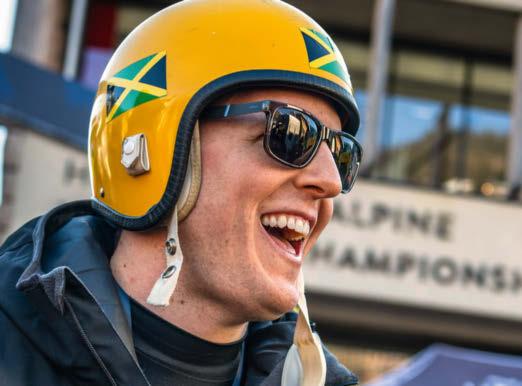
This young man from Graubünden enjoys hoaxing journalists: he calls himself Sandy Walker and claims to be competing for Jamaica in the giant slalom – even wearing a home-made accreditation around his neck. We’d have almost believed his story
A BLINDINGLY BRILLIANT MOOD
A pair of sunglasses was one of the most important accessories for the stands at the World Championships. Plus a flag or a national scarf – like that held by this woman, visibly supporting the German athletes.
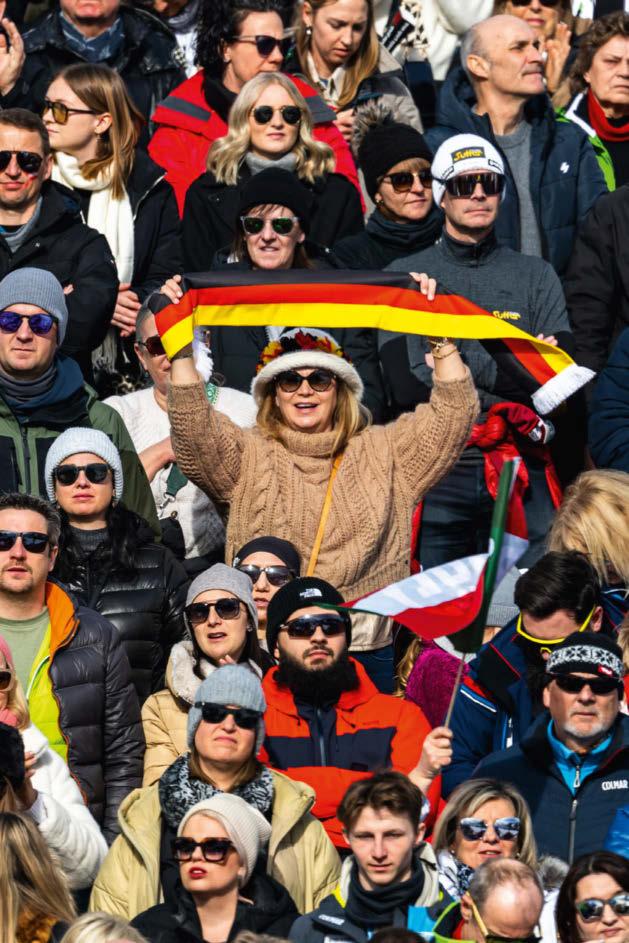
After World Champion Stephanie
Venier, avid young skiers took to the stage for their big performance.
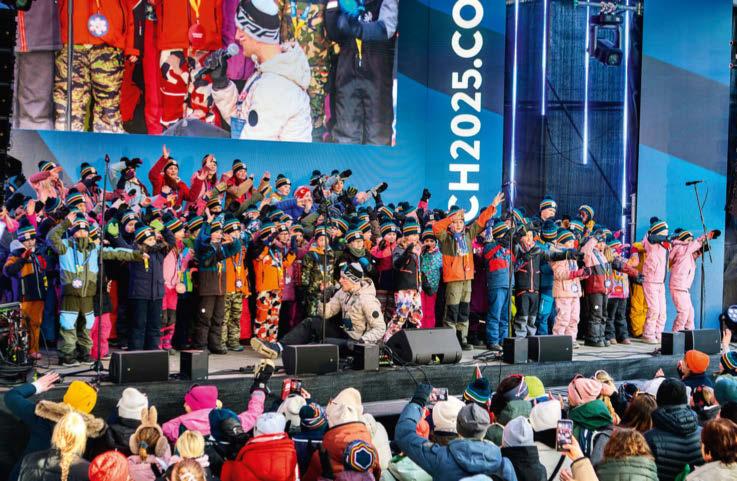
PASSIONATE YOUNG SKIERS
Following Stephanie Venier’s triumph in the super-G, it was time for some little ones to perform: pupils from the Saalbach Hinterglemm primary school sang songs from the musical ‘Skiverliebt’ on the fan mile.
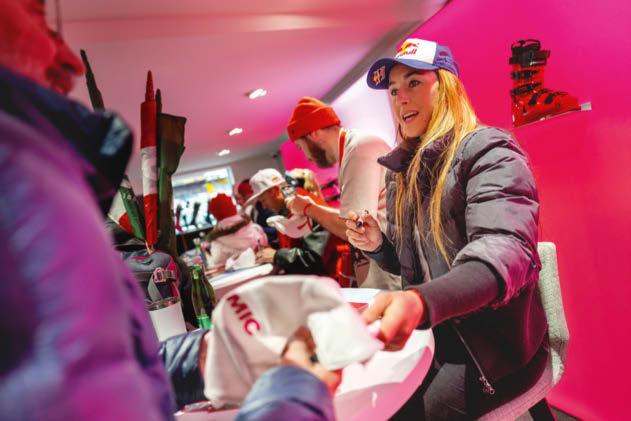
GRAZIE, SOFIA!
Autograph session at Atomic. Sofia Goggia from Italy hands a signed cap to a fan. US legend Daron Rahlves (3rd from right) sits at the next table.
PRIDE AND JOY
Fans and family members show where their hearts lie at the medal plaza. For example, with Mirjam Puchner from Salzburg, who took the Vice World Champion title in the downhill. What makes this gesture particularly special: she’d already autographed the sign.
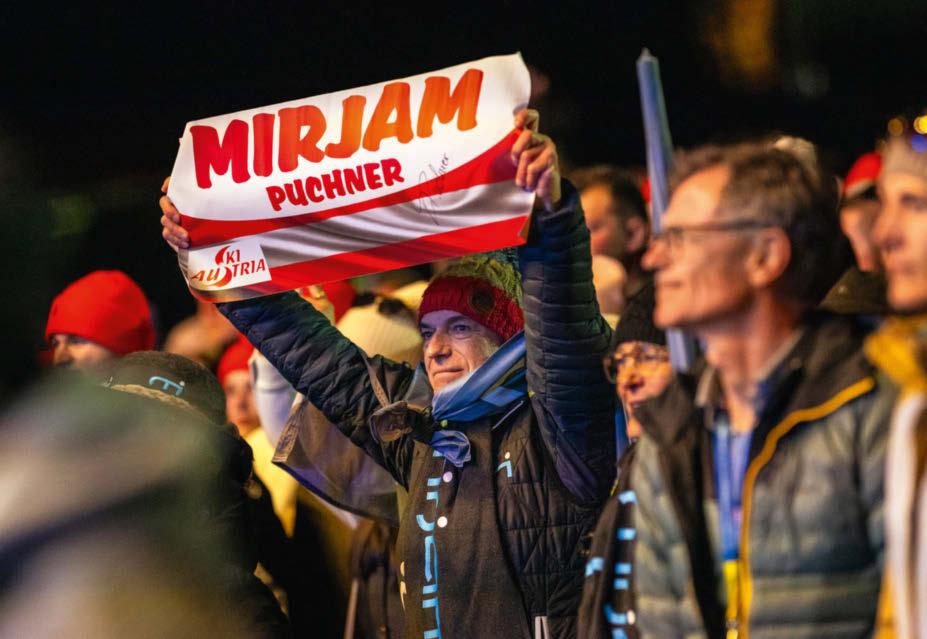
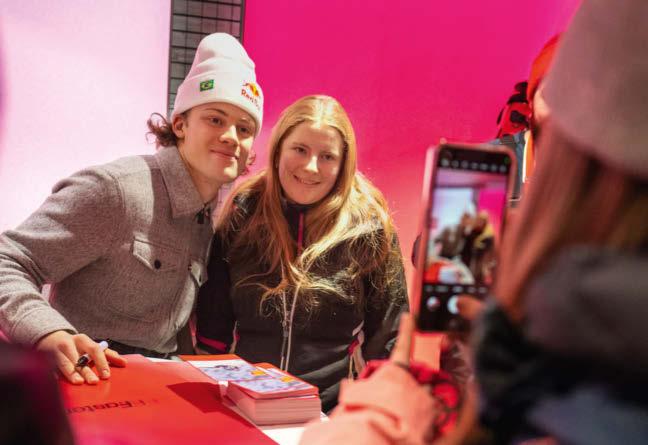
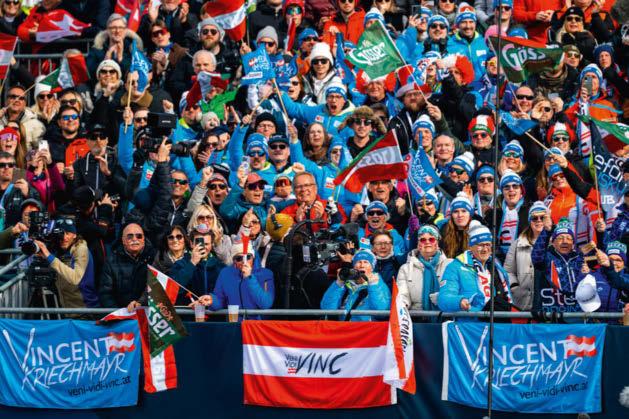
FANS ADD A SPLASH OF COLOUR
The fan clubs in the finish area don’t just make themselves heard. Vincent Kriechmayr’s fans also create quite the visual picture – and celebrate their hero’s silver medal as a sea of blue.
ETERNAL MEMORIES
This female fan looks as intensely at the camera on her phone as the Brazilian Lucas Pinheiro Braathen. She won’t easily forget this moment at an autograph session in Hinterglemm. NOT EVERYTHING’S A RACE On route to the finish, no-one was quicker than Franjo von Allmen. But before the start, the future Swiss downhill World Champion took his time and willingly signed a fan’s helmet at the mountain station of the 12er KOGEL gondola lift.
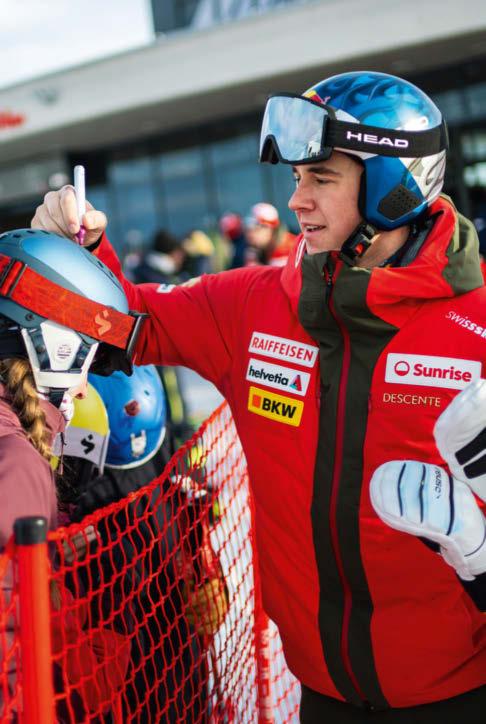
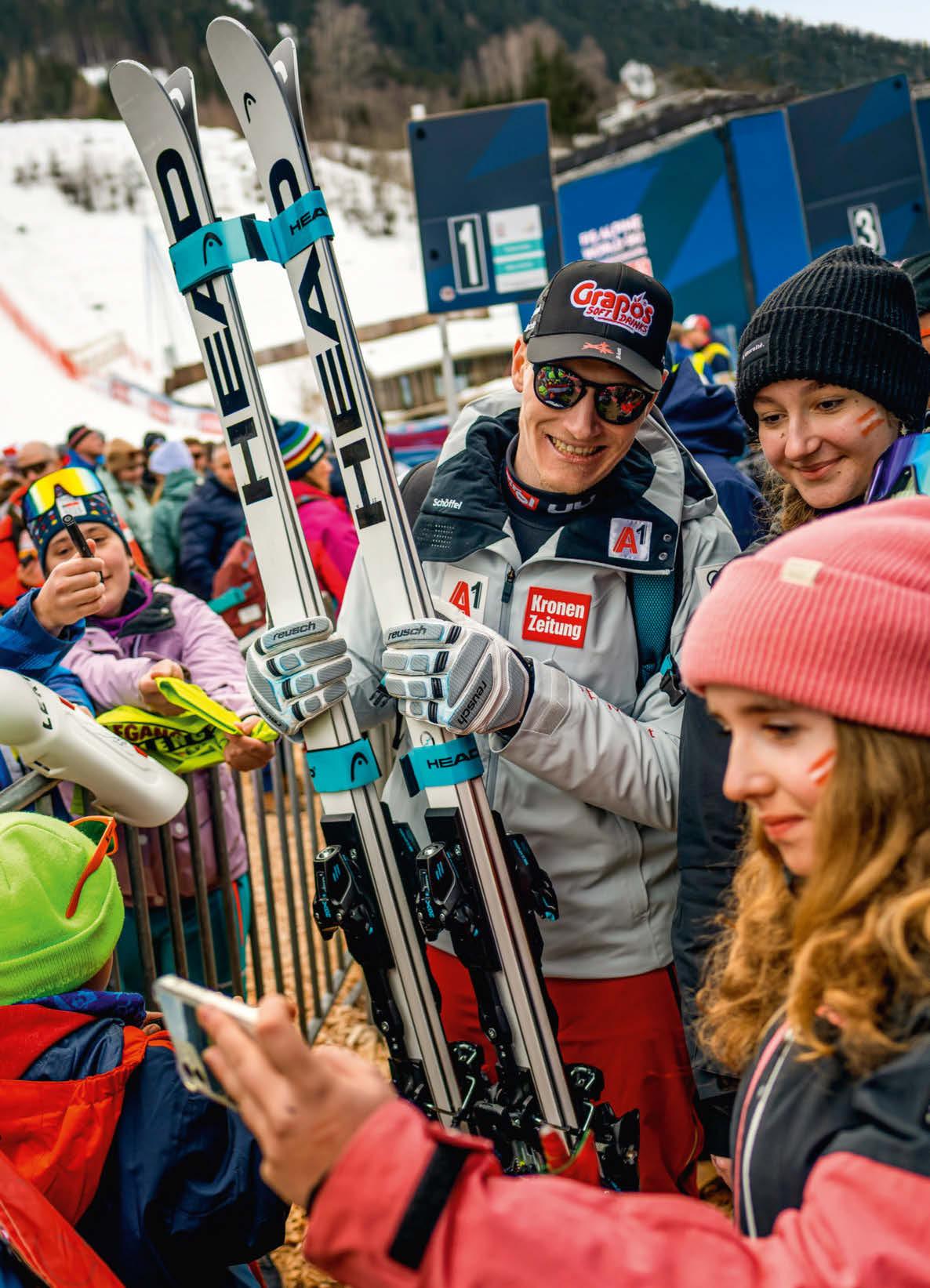
The stars of the World Championships are always happy to take time for their fans.
HANDS FULL Stefan Babinsky leaves the finish area carrying a heavy backpack and two pairs of skis. And yet, the Styrian speed specialist, who finished in the top 10 in both the downhill and the super-G, is still happy to take time for his fans.
START
A rapid start: a steep gradient of 73% followed by a sharp left turn for the finest highspeed action.
start

PANORAMIC JUMP
A key point on the women’s course that demands outstanding technical ability and great courage.
SCHNEEKRISTALL JUMP
The men jump 55 metres at speeds of 140 km/ hour. And it’s no wonder with a 73% gradient. KEY
ALL RACES ON ONE MOUNTAIN
The
Zwölferkogel
was the centre of the World Ski Championships 2025.
Even in its application to host the 48th FIS Alpine World Ski Championships, Saalbach impressed with the clear message: “1 mountain – 11 races – 1 fnish”. For the frst time ever, all World Championship races were held on one single mountain. And the 1,984-metre-high Zwölferkogel proved to be the perfect setting for an incomparable skiing spectacle. Whether the Quellen curve, Kanonenrohr and panoramic jump on the Ulli Maier course or the Schneekristall jump, Ochsenritt and Daytona on the Schneekristall course: the perfectly groomed pistes encouraged top performances from the athletes.
OCHSENRITT
A compression followed by a jump – the combination of pressure and demanding elements is particularly challenging.
DH Downhill SG Super-G
GS Giant Slalom SL Slalom
TP Team Parallel
ULLI MAIER RACE COURSE
Five races took place on the Ulli Maier course: the women’s downhill (start at 1,833 metres above sea level), the women’s Super-G (1,656 metres), the men’s slalom (1,279 metres), the women’s slalom (1,279 metres) and the women’s team combined
SCHNEEKRISTALL RACE COURSE
Six events took place here: the men’s downhill (start at 1,984 metres above sea level), the men’s Super-G (1,791 metres), the men’s giant slalom (1,511 metres), the women’s giant slalom (1,459 metres) and the men’s team combined. The team parallel race, which opened the World Championships on 4 February, started at 1,166 metres, i.e. an impressive 105 altitude metres above the finish line.
RESULTS
4 FEBRUARY 2025
MIXED TEAM PARALLEL
13,500 spectators. Schneekristall course. 71 participants. 19 directional gates. Course setter: Markus Mayr (FIS). Start time: 15:15. Weather: sunny/floodlit. Temperature at the start: –3 °C. Temperature at the finish: –3 °C.
1 Italy Giorgia COLLOMB, Lara DELLA MEA, Filippo DELLA VITE, Alex VINATZER
2 Switzerland Delphine DARBELLAY, Wendy HOLDENER, Luca AERNI, Thomas TUMLER
3 Sweden Estelle ALPHAND, Sara HECTOR, Fabian AX SWARTZ, Kristoffer JAKOBSEN
4 USA Paula MOLTZAN, Nina O’BRIEN, Isaiah NELSON, River RADAMUS
5 Germany Fabiana DORIGO, Lena DÜRR, Fabian GRATZ, Linus STRASSER
6 Austria Stephanie BRUNNER, Julia SCHEIB, Stefan BRENNSTEINER, Dominik RASCHNER
7 Norway Thea Louise STJERNESUND, Madeleine SYLVESTER-DAVIK, Timon HAUGAN, Atle Lie McGRATH
8 France Clara DIREZ, Marie LAMURE, Léo ANGUENOT, Thibaut FAVROT
9 Argentina Francesca BARUZZI FARRIOL, Nicole BÉGUE, Sebastiano GASTALDI, Tiziano GRAVIER 10 Poland Maryna GĄSIENICA-DANIEL, Magdalena ŁUCZAK, Piotr HABDAS, Stanisław SĄCZYSKI
11 Czech Republic Barbora NOVÁKOVÁ, Tereza KOUTNÁ, Marek MÜLLER, Aldo TOMÁŠEK
12 Slovenia Taja PREŠERN, Nika TOMŠIČ, Martin CATER, Anže GARTNER
13 Ukraine Anastasiia SHEPILENKO, Kateryna SHEPILENKO, Maksym MARIICHYN, Roman TSYBELENKO
14 United Kingdom Giselle GORRINGE, Lois JACKSON, Calum LANGMUIR, Owen VINTER
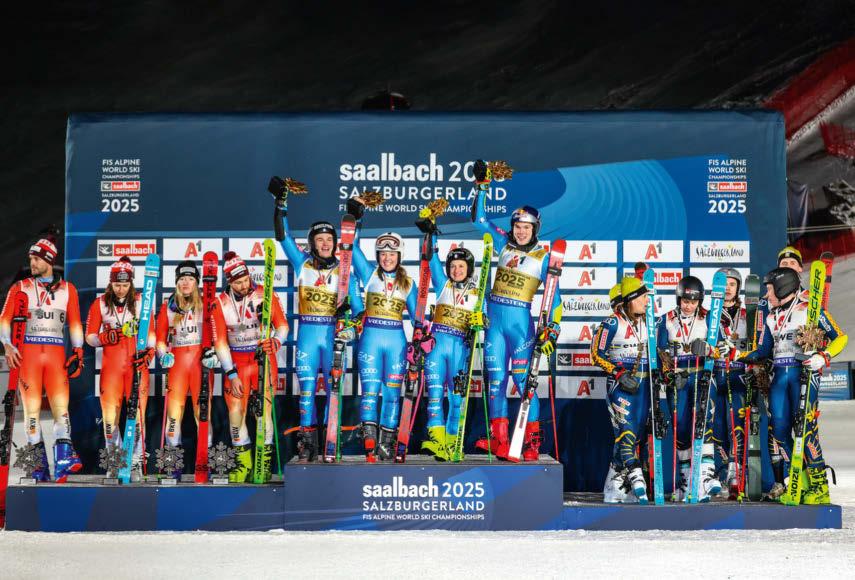
LA DOLCE VITA
At the 48th FIS Alpine World Ski Championships, Austria presented itself as a courteous host – and left the team competition in the quarterfinals. At the first award ceremony in Saalbach, Italy’s team took centre stage, framed by the Swiss in second place (left) and the Swedes in third. The biggest consolation from the host’s perspective: the false start was followed by medals for the Austrian Ski Association in five races in a row!
Stephanie Venier (2nd from the left) treated herself to a brief nap before the start. The well-rested Tyrolean clinched gold with “the best run of my career”, beating Italy’s Federica Brignone (left) by one tenth of a second to win the super-G. America’s Lauren Macuga (2nd from the right) and Norway’s Kajsa Vickhoff Lie (right) finished joint third and celebrated the tightest decision of the World Championships at the party in the evening on the medal plaza.
6 FEBRUARY 2025
WOMEN’S SUPER-G
14,500 spectators. Ulli Maier course. 40 participants. 41 directional gates. Course length: 2,100 metres. Course setter: Alex Hödlmoser (USA). Start time: 11:30. Weather: sunny. Temperature at the start: –2 °C. Temperature at the finish: –2 °C.
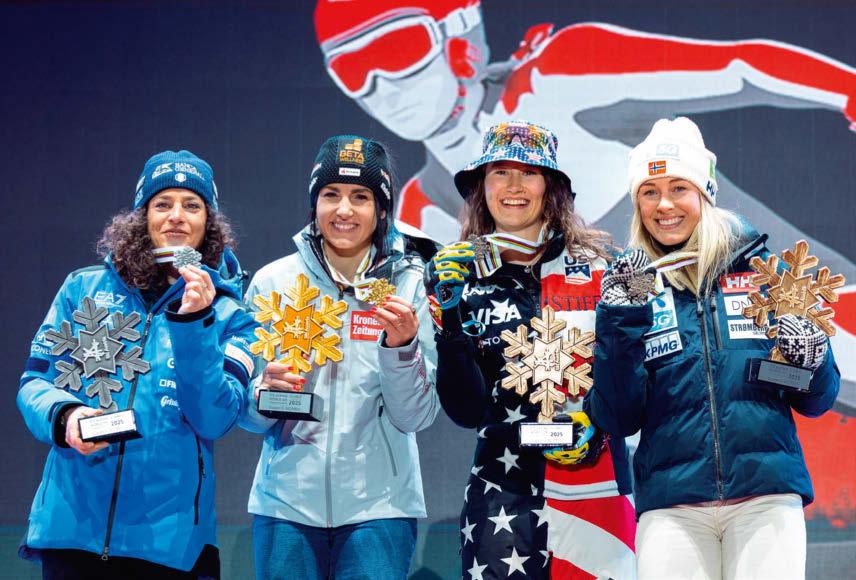
7
FEBRUARY
2025 MEN’S SUPER-G
15,700 spectators. Schneekristall course. 62 participants. 46 directional gates. Course length: 2,341 metres. Course setter: Sepp Brunner (AUT). Start time: 11:30. Weather: sunny. Temperature at the start: 1 °C. Temperature at the finish: 1 °C.
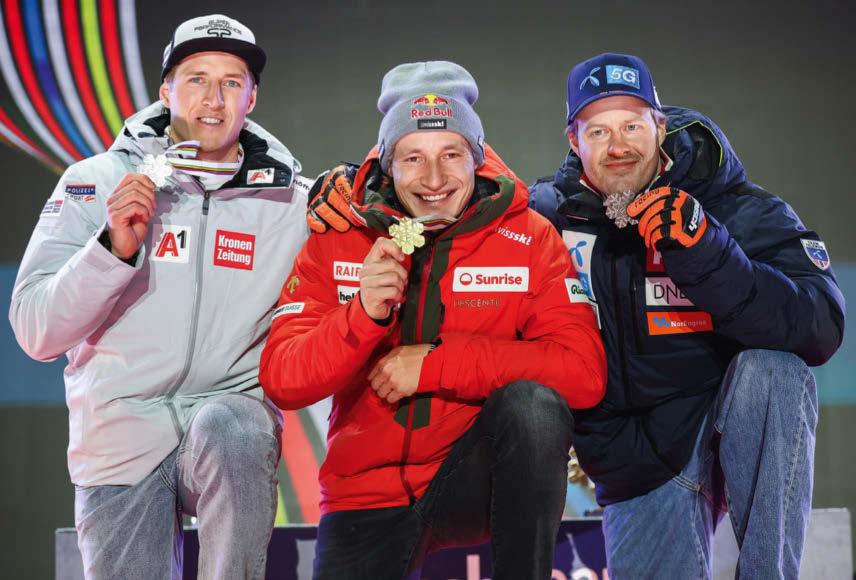
KNEELING IN RESPECT Marco Odermatt (middle) beats Austria’s Raphael Haaser (left) by one second. They are joined in the winners’ photo by Norway’s Adrian Smiseth Sejersted (right). It’s the biggest lead at a World Championship super-G since Stephan Eberharter’s triumph in Saalbach in 1991. The Swiss superstar finds it more than just “amazing” that following on from his gold medals in the downhill and giant slalom in 2023, he has now been named World Champion in a third discipline: “It’s nuts!”
THE NEW NUMBER 1
It’s a new feeling for Breezy Johnson to stand in the middle, her face shining with pride –as here between Austria’s Mirjam Puchner (left) and the Czech Republic’s Ester Ledecká (right). What makes it all the more intense is that of all the races in which the American could have won her first victory, she did so in the downhill at the World Championships – wearing bib number 1 and with a top speed of 138.5 kilometres per hour. Afterwards, she commented: “That was fun.” So much so that she took a second World Champion title three days later.
8
FEBRUARY 2025
WOMEN’S DOWNHILL
15,800 spectators. Ulli Maier course. 33 participants. 36 directional gates. Course length: 2,940 metres. Course setter: Alberto Senigagliesi (FIS). Start time: 11:30. Weather: sunny. Temperature at the start: 0 °C. Temperature at the finish: 0° C.
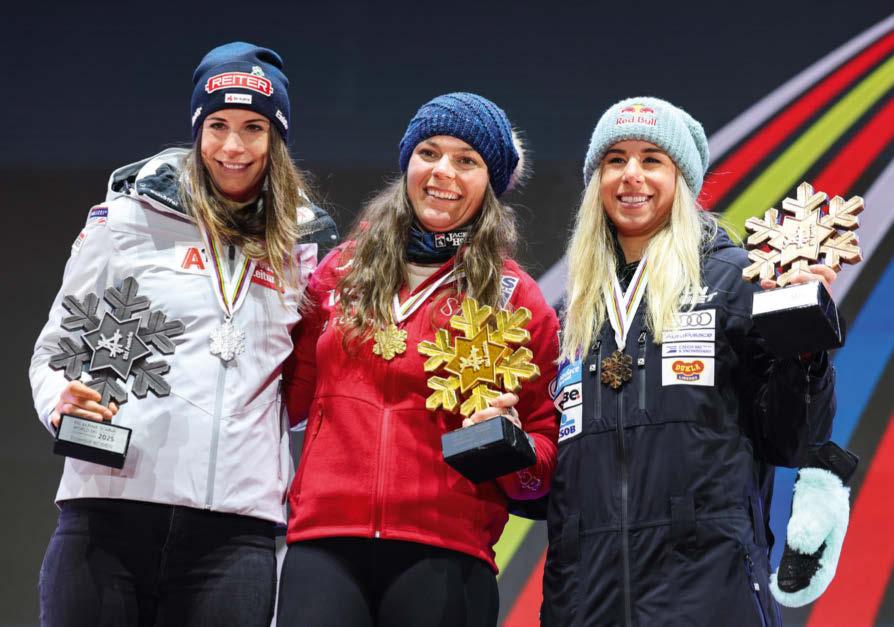
9 FEBRUARY 2025 MEN’S DOWNHILL
22,500 spectators. Schneekristall course. 57 participants. 35 directional gates. Course length: 2,918 metres. Course setter: Hannes Trinkl (FIS). Start time: 11:30. Weather: partly cloudy. Temperature at the start: 4 °C. Temperature at the finish: 3 ° C.
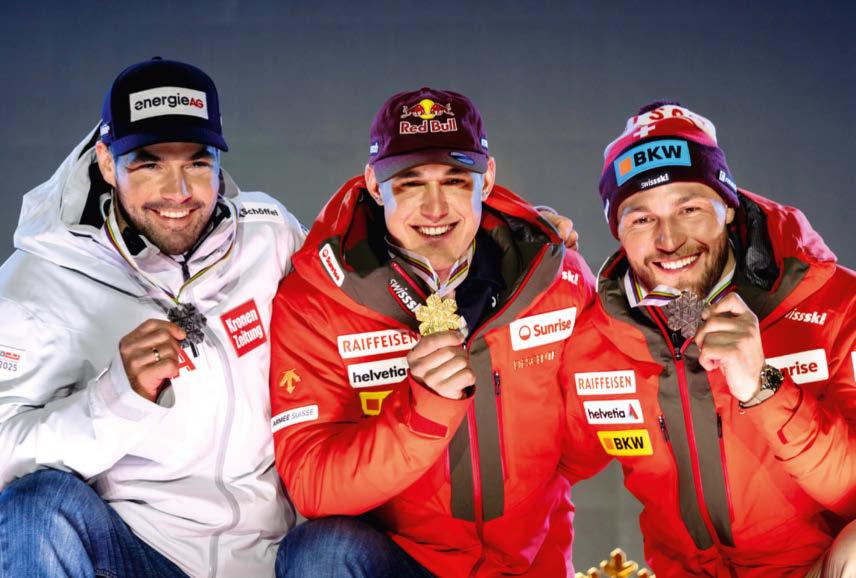
A HUGE JUMP
Franjo von Allmen sailed 48 metres over the Schneekristall jump and landed the greatest success of his career: aged 23 years and 200 days, the Swiss athlete became the youngest downhill World Champion of the 21st century. At the award ceremony, he was flanked by his third-place compatriot Alexis Monney (right) and Austria’s Vincent Kriechmayr (left), who was visibly delighted about his silver medal: “It’s one of the best moments of my career.”
11 FEBRUARY 2025 WOMEN’S TEAM COMBINED
9,800 spectators. Ulli Maier course. 52 participants. Downhill: 36 directional gates. Course length: 2,940 metres. Course setter: Alberto Senigagliesi (FIS). Start time: 10:00. Weather: largely cloudy. Temperature at the start: 0 °C. Temperature at the finish: 0 °C. Slalom: 74 directional gates. Course setter: Roberto Lorenzi (ITA). Start time: 13:15. Weather: largely cloudy. Temperature at the start: 6 °C. Temperature at the finish: 6 °C.
GOLDEN GIRLS
It’s easy to bet on Mikaela Shiffrin. Since her début in 2013, the American has won
least one race at every World Championships. In Saalbach, she continued her run of gold medals and celebrated her eighth World Champion title in the new combined event –together with her team mate Breezy Johnson (3rd from the right).
Swiss silver medallists Lara Gut-Behrami and Wendy Holdener (left) and Austrian bronze medallists Katharina Truppe and Stephanie Venier (right) joined in the celebrations respectfully.
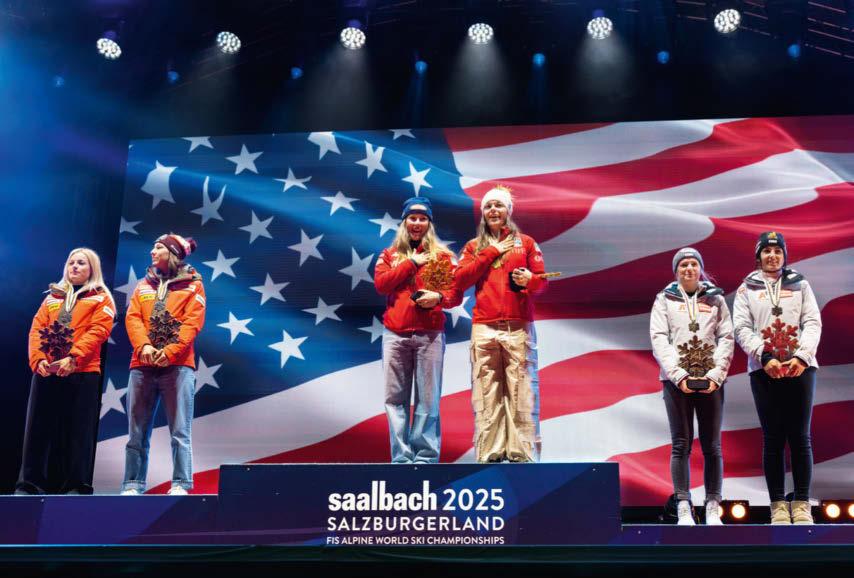
12 FEBRUARY 2025 MEN’S TEAM COMBINED
12,900 spectators. Schneekristall course. 74 participants.
Downhill: 35 directional gates. Course length: 2,918 metres. Course setter: Hannes Trinkl (FIS). Start time: 10:00. Weather: largely cloudy. Temperature at the start: 2 °C. Temperature at the finish: 2 °C. Slalom: 72 directional gates. Course setter: Niclas Kjelsli (NOR). Start time: 13:15. Weather: largely cloudy. Temperature at the start: 3 °C. Temperature at the
3 °C.
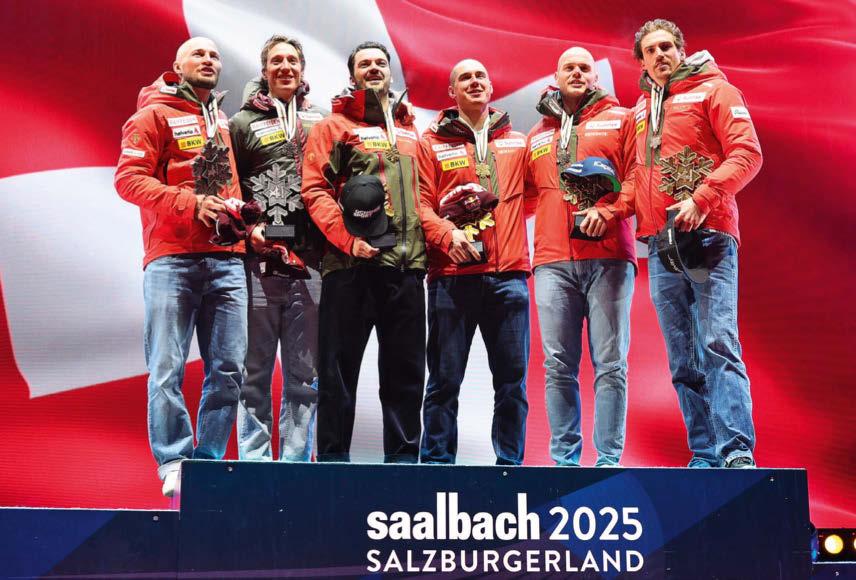
13
2025 WOMEN’S GIANT SLALOM
11,000 spectators. Schneekristall course. 110 participants. 1st run: 53 directional gates. Course setter: Pauli Gut (SUI). Start time: 09:45. Weather: sunny. Temperature at the start: 0 °C. Temperature at the finish: 1 °C. 2nd run: 54 directional gates. Course setter: Zan Spilar (USA). Start time: 13:15. Weather: overcast. Temperature at the start: 2 °C. Temperature at the finish: 2 °C.
FEDERICA DOMINATES
Federica Brignone has twice had to accept the title of Vice World Champion in the giant slalom (in 2011 and, more recently, 2023). In Saalbach, ‘Fede’ allayed all doubts as she carved her way to victory with the best time on both runs – and entered the history books, which she deservedly celebrated with New Zealand’s Alice Robinson (left) and America’s Paula Moltzan (right). At age 34, she is the oldest ski World Champion ever.
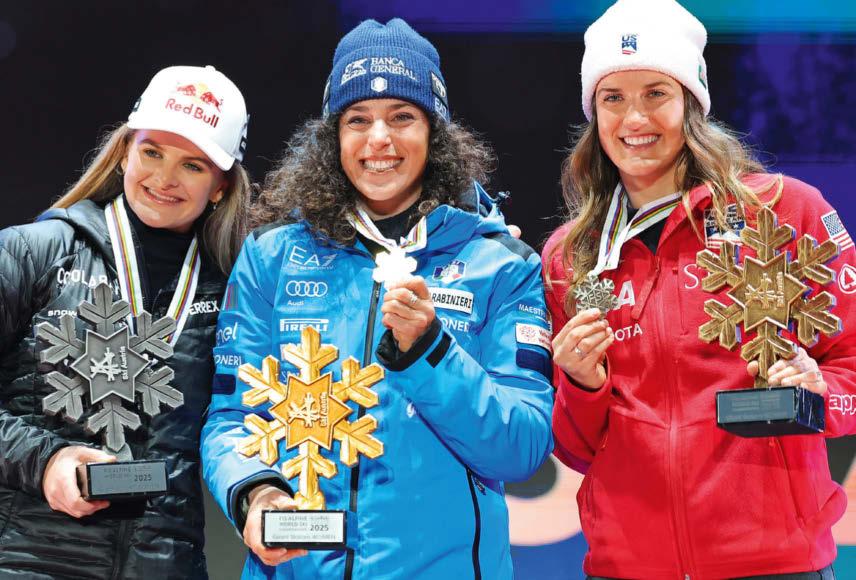
14
FEBRUARY
19,500 spectators. Schneekristall course. 100 participants.
1st run: 59 directional gates. Course setter: Martin Kroisleitner (AUT). Start time: 09:45. Weather: snowfall. Temperature at the start: –2 °C. Temperature at the finish: –2 °C.
2nd run: 60 directional gates. Course setter: Helmut Krug (SUI). Start time: 13:15.
Weather: overcast. Temperature at the start: –2 °C. Temperature at the
–2 °C.
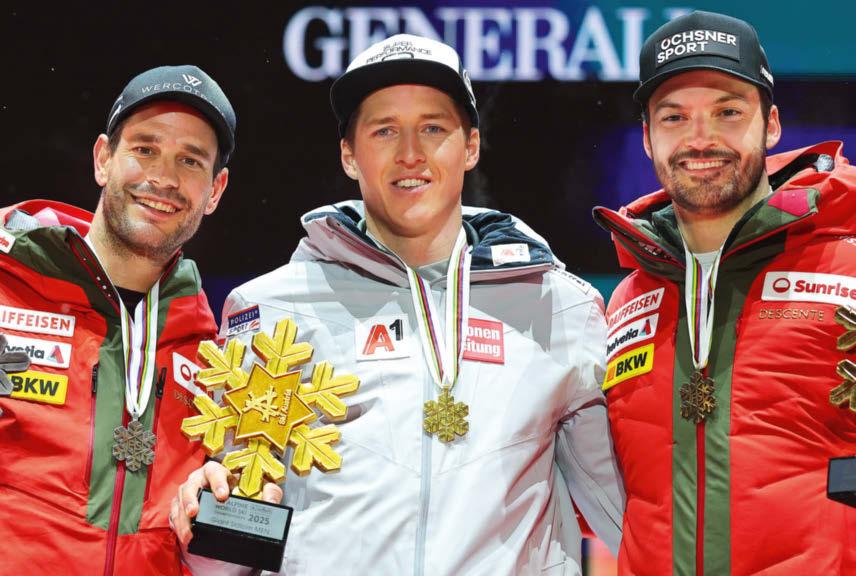
GIANT SUCCESS
“Success breeds success”, stated Rudi Nierlich, giant slalom World Champion in Saalbach 1991. Raphael Haaser confirmed this motto: the Tyrolean, who had never before won a World Cup race or stood on the podium in the giant slalom, raced to his first victory following his super-G silver. In doing so, he prevented a further Swiss triumph; Thomas Tumler (left) and Loïc Meillard (right) celebrated their second medal in Saalbach.
15 FEBRUARY 2025 WOMEN’S SLALOM
16,700 spectators. Ulli Maier course. 116 participants.
1st run: 75 directional gates. Course setter: Klaus Mayrhofer (AUT). Start time: 09:45.
Weather: sunny. Temperature at the start: –8 °C. Temperature at the finish: –6 °C. 2nd run: 73 directional gates. Course setter: Sascha Sorio (SWE). Start time: 13:15.
Weather: sunny. Temperature at the start: –5 °C. Temperature at the finish: –3 °C.
HISTORIC TRIUMPH
Prior to these World Championships, the last Swiss slalom World Champion was Vreni Schneider in 1991. 34 years later, Camille Rast also celebrated gold in the slalom in Saalbach. The first to congratulate her in the finish area was her compatriot Wendy Holdener, who also had reason to celebrate after logging the best time in her second run: at the award ceremony, she accepted her third silver medal of the World Championships (on the left in the photo); Austria’s Katharina Liensberger (right) was delighted to take bronze.
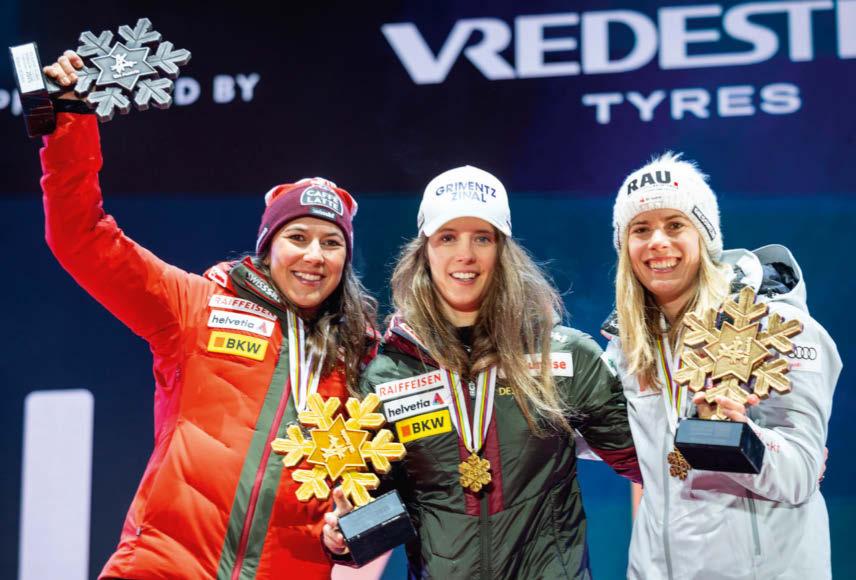
16 FEBRUARY 2025 MEN’S SLALOM
23,000 spectators. Ulli Maier course. 100 participants.
1st run: 68 directional gates. Course setter: Ola Masdal (NOR). Start time: 09:45.
Weather: partly cloudy. Temperature at the start: –6 °C. Temperature at the finish: – 6°C.
2nd run: 68 directional gates. Course setter: Kevin Page (FRA). Start time: 13:15.
Weather: partly cloudy. Temperature at the start: –3 °C. Temperature at the finish: –2 °C.
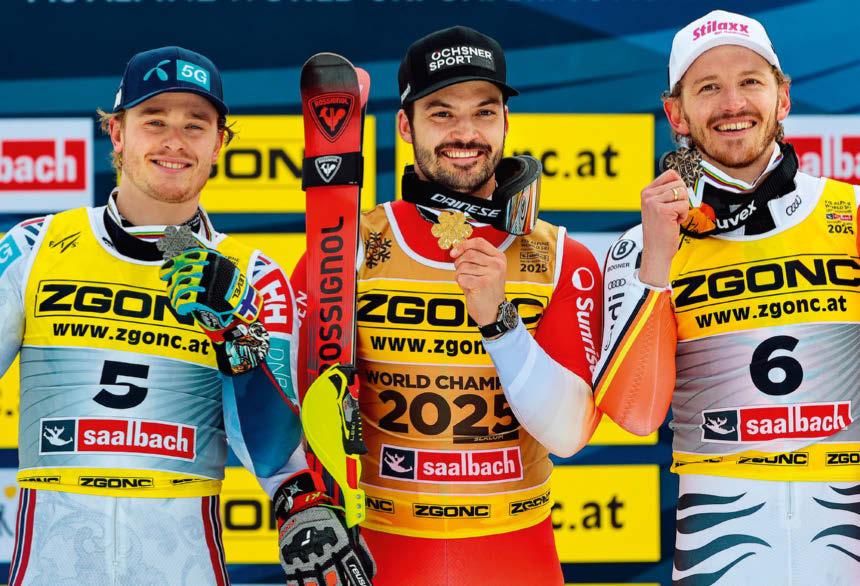
THE SWISS DO IT AGAIN 23,000 fans made the men’s slalom the best-attended event in Saalbach 2025. And a gripping finish awaited them: local hero Manuel Feller had to settle for fourth place following an impassioned race to catch-up on the second run. As a result, the Swiss anthem ultimately played out once again: Loïc Meillard celebrated his fourth victory in his fifth men’s race and his second World Champion title. Sharing the podium with him: Atle Lie McGrath
and
(NOR, left)
Linus Straßer (GER, right).
HOW THE ZWÖLFERKOGEL BECAME A
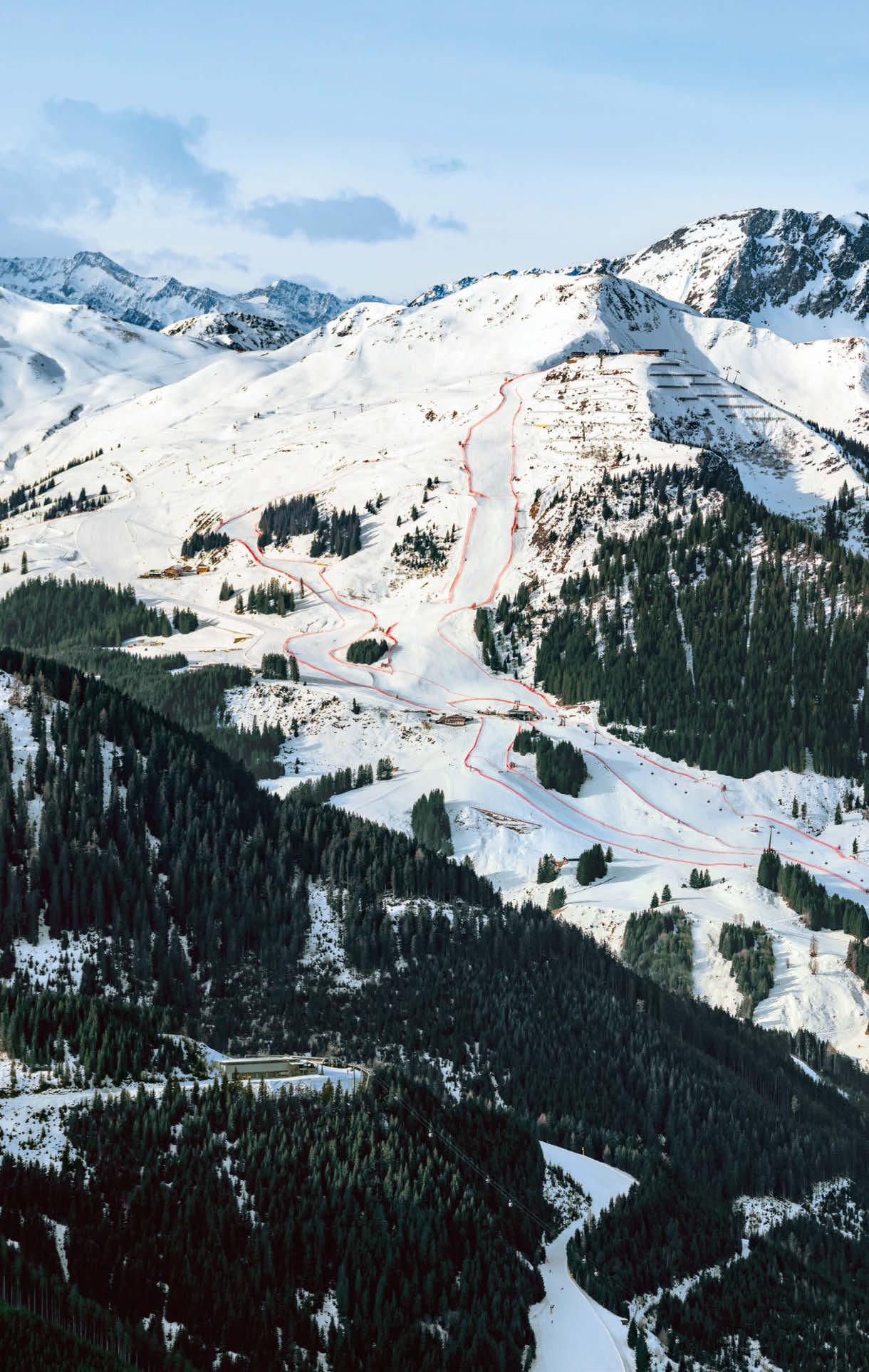
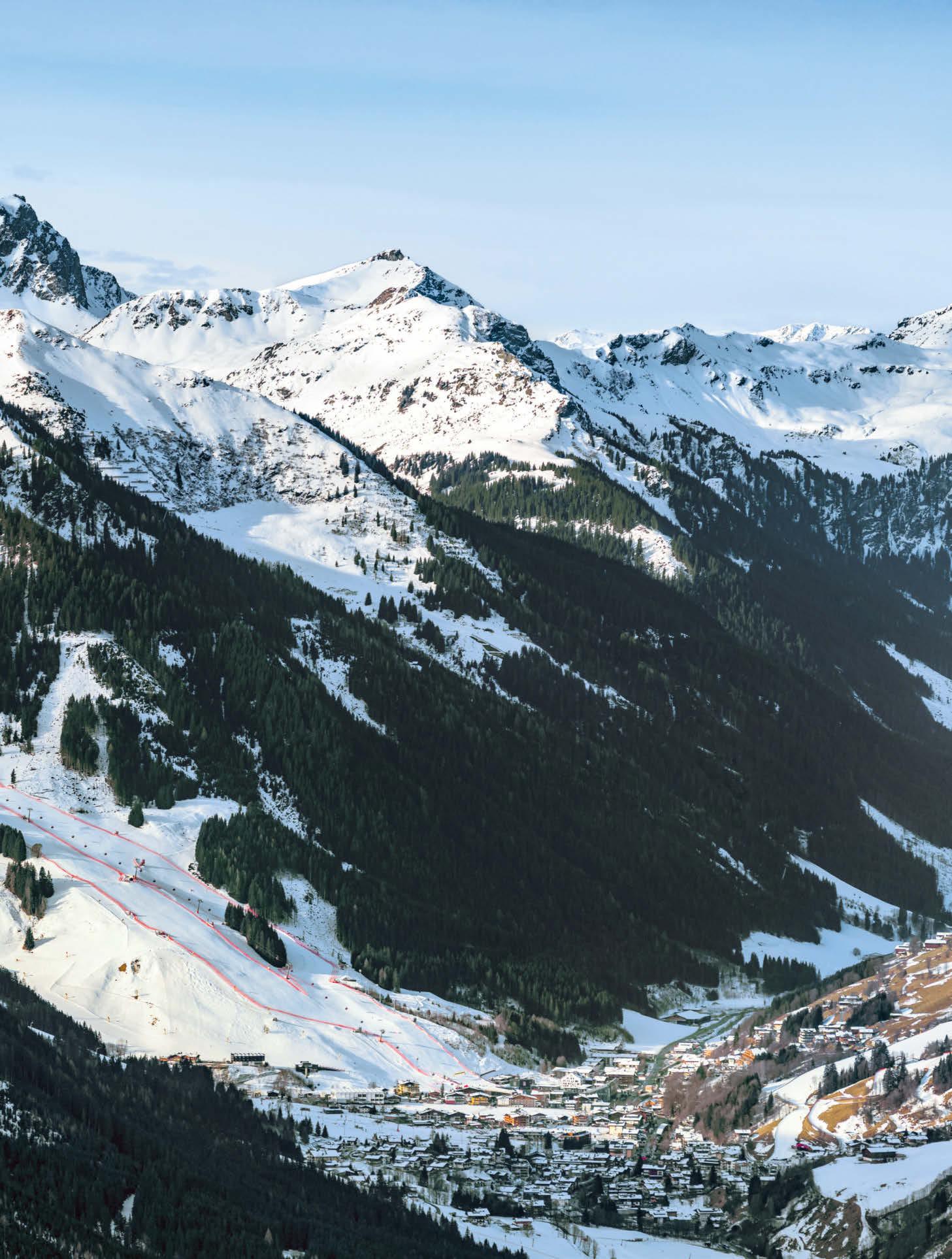
The Zwölferkogel was the stage of a perfect World Ski Championships. We shine the spotlight on a few people who achieved great things behind the scenes.
To the south of the Glemm Valley, the race slopes on the 1,984-metre-high Zwölferkogel are bathed in radiant sunshine.
LORD OF THE MOUNTAIN
Based in the head office of the 12er KOGEL gondola lift, Markus Schlosser was responsible for snowmaking and the snow groomers.
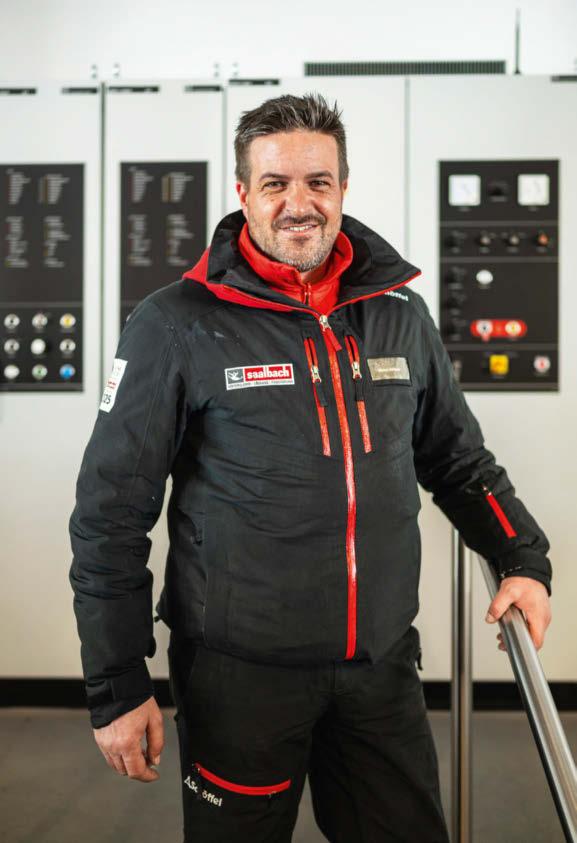
MEASURING THE SNOW
Markus Schlosser, operations manager for the 12er KOGEL gondola lift, explains how the World Championship mountain is covered in artificial snow in an efficient and environmentally conscious manner through the use of modern satellite technology.
The snow groomer drivers steer their multi-tonne machines with impressive control – as well as with astonishing sensitivity and a ‘bum-ometer’, as seasoned driver Richard Mayer jokingly terms his wealth of experience. However the ability to literally move the mounds of snow on the Zwölferkogel to the desired location with centimetre precision is down to modern satellite technology.
This is because the mountain on which all of the races of the 2025 FIS Alpine World Ski Championships were held was precisely measured by GPS, as Markus Schlosser, operations manager of the 12er KOGEL gondola lift in Hinterglemm explains: “A few years ago, we started repeatedly measuring the entire Glemmtal Valley by satellite each summer. This has given us precise data on every rock and every hill, even including the molehills.”
In winter, this data from the summer is compared with that obtained by the snow groomers. “All of our snow groomers, regardless of their manufacturer, are equipped with a GPS antenna. There are also sensors at the front on the blade and on the underside of the vehicle.” These provide real-time information on how much higher the snow groomer is compared to being on the snow-free
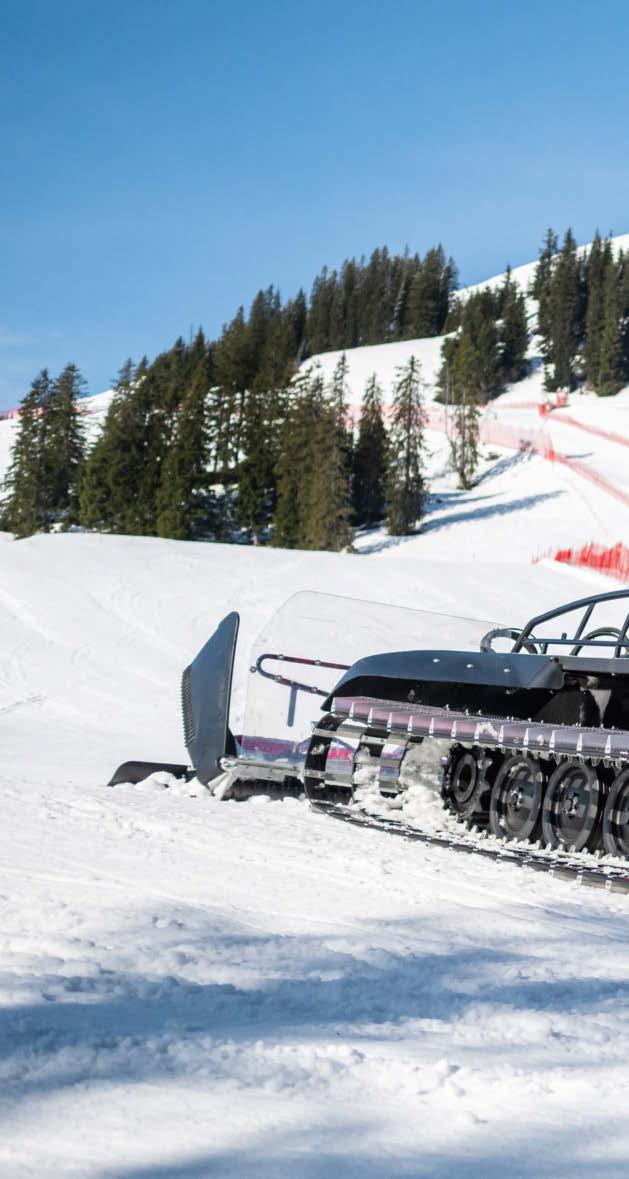
terrain in summer. The data is transferred to an environment map on a monitor in the driver’s cab, where a clear colour scheme shows the current snow depth. Markus Schlosser, who also has constant access to the data on his phone, comments: “Dark blue indicates a snow level of up to 1.30 metres. Yellow means between 1.45 and 1.60 metres.”
In practise, this knowledge enables efcient, energysaving and therefore sustainable working methods. After all, to produce snow – which for the World Championship pistes meant around 250,000 cubic metres of snow from 100 cannons – there are two things that you need above all else: water and energy. “And there are clear guidelines on these from the Salzburg state government”, says Markus Schlosser. “There’s what’s known as a water consensus on how much water we – and other winter sports areas – can use.”
The key beneft of the GPS solution is therefore obvious: “We don’t produce snow at random. We know exactly
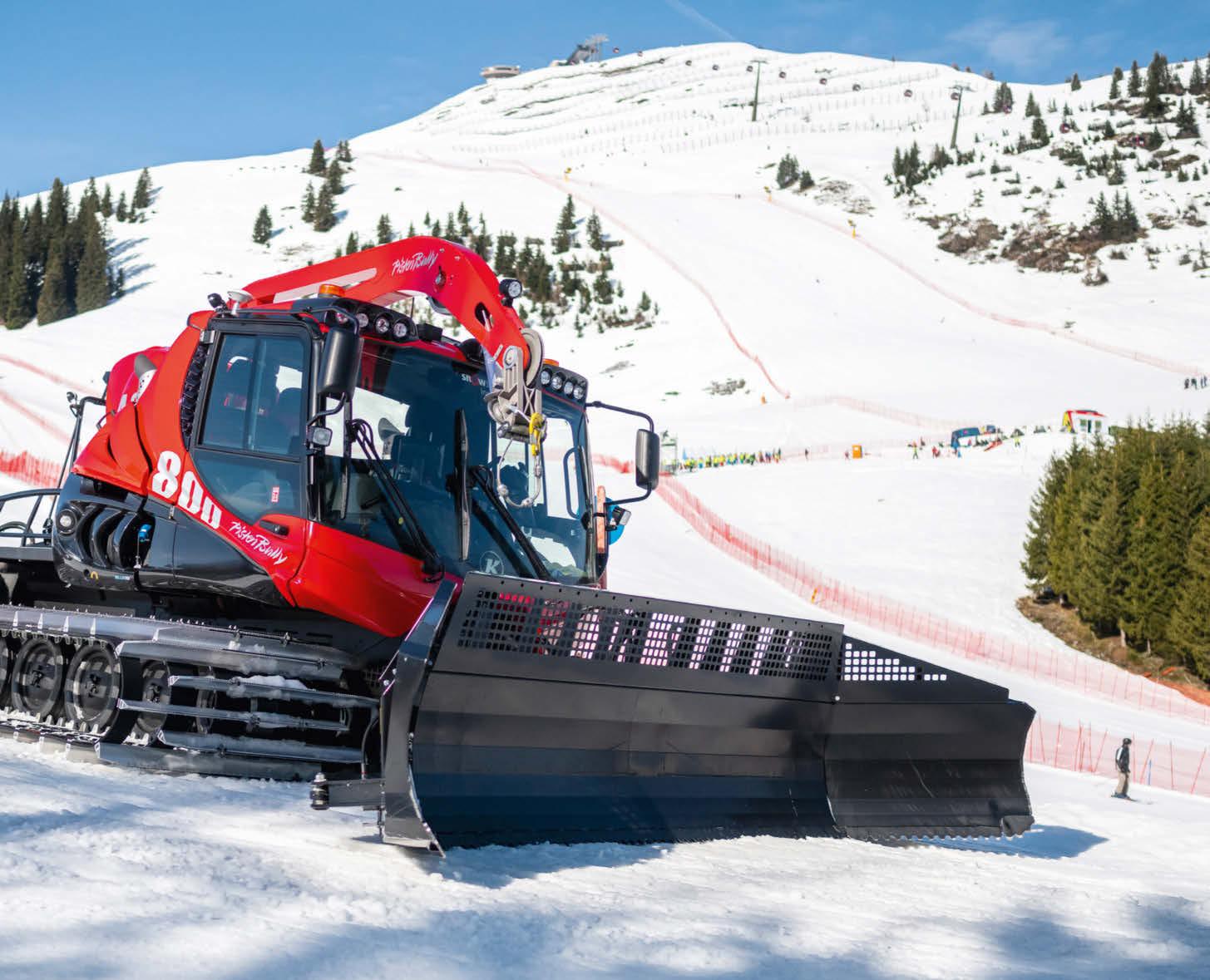
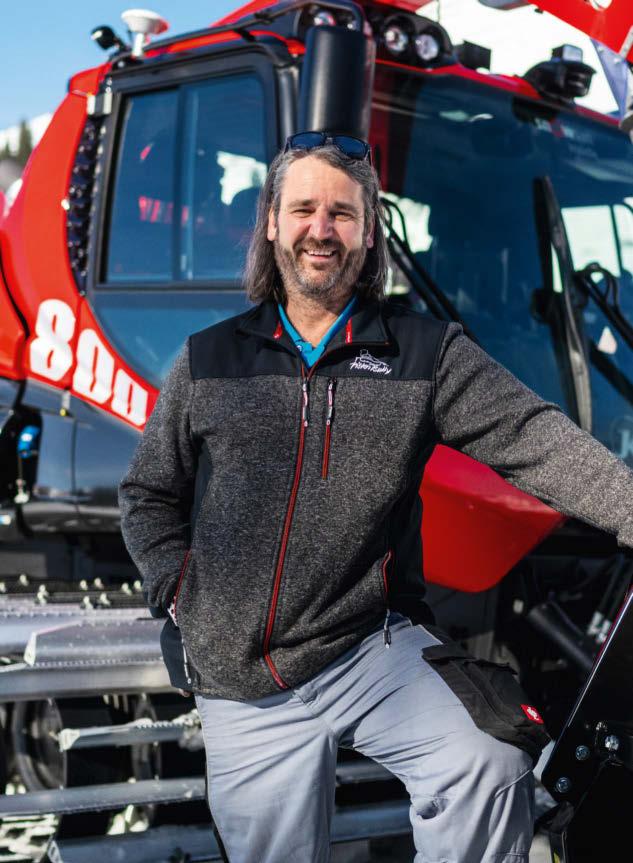
Richard Mayr in front of his snow groomer. Together, they can move mounds of snow with centimetre precision.
how thick the cover is on every part of the mountain, which in turn tells us precisely how much snow we have to apply where. This enables us to not only work quicker, but, above all, more energy efciently, while also protecting the environment by conserving resources.”
The satellite technology also ofers benefts for the athletes and trainers: “We have mobile GPS antennas that enable us to manually defne certain points. If the course setters wish, we can record the precise location of directional gates. This not only enables us to model a piste based on the same specifcations at any time, but even to precisely re-create courses. If we wanted, we could replicate the pistes from the World Championships 2025 in 20 years’ time to the centimetre.”
THE SNOW MAN
A SUCCESSFUL START
Even during the mixed team parallel race, held as a world première on the opening day, the Zwölferkogel proved to be in top form.
AN EXPERIENCED ELDER
Fritz Steger senior with his drill on the World Championship slope. His son Fritz says that everyone has benefited enormously from his routine.
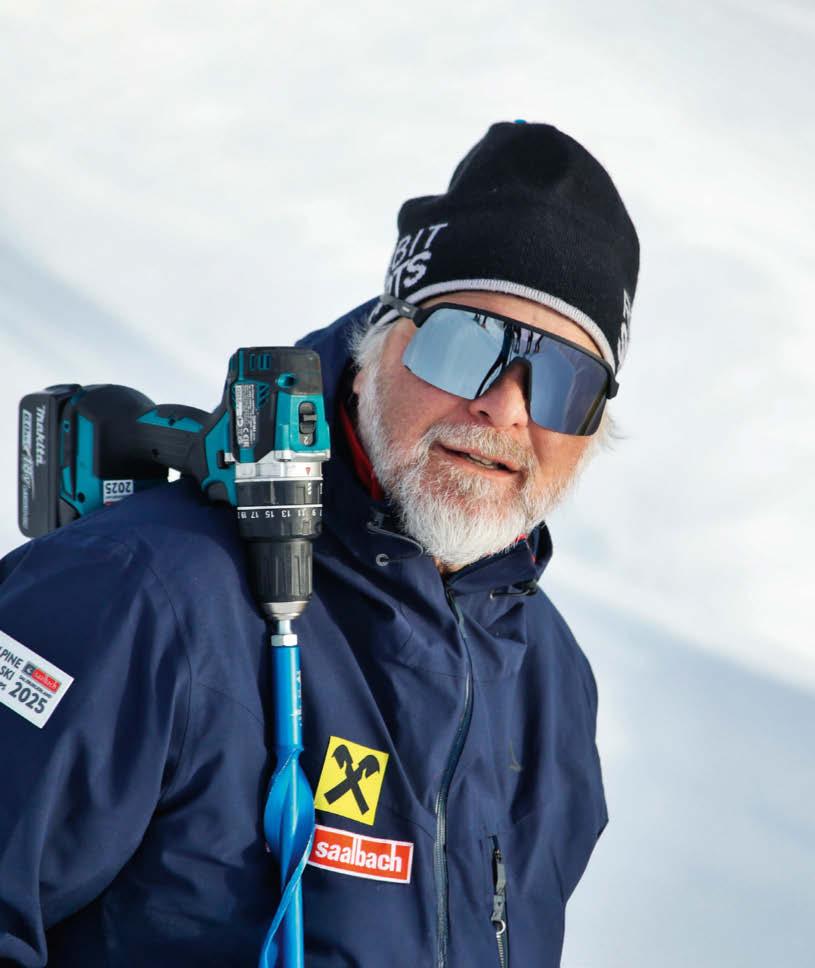
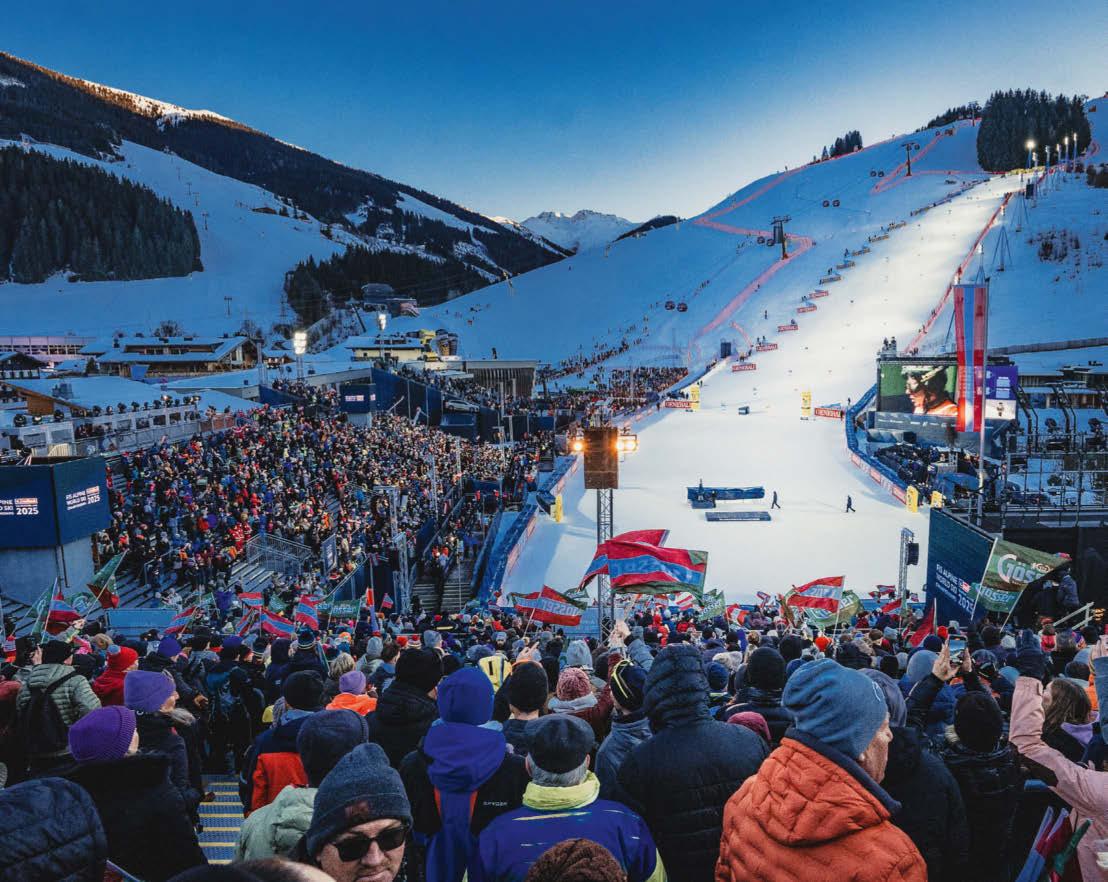
“THE WORLDS WERE A DREAM FOR US”
As piste manager, Fritz Steger junior, in collaboration with his father, was responsible for perfectly groomed race courses. And shared the praise with his team.
The words of Urs Lehmann, President of the Swiss Ski Association, went down as well as a much-deserved beer after a hard day’s work: “The infrastructure was excellent, as was the hospitality. I’d also like to highlight the pistes: for me, the speed courses were a shining example”, said the former world-class downhill ski racer, who crowned his active career with gold at the World Championships in 1993. “They were neither high-speed courses nor particularly dangerous. And the grooming – simply perfect: the same snow conditions prevailed from the frst to the last gate. That was quite something.”

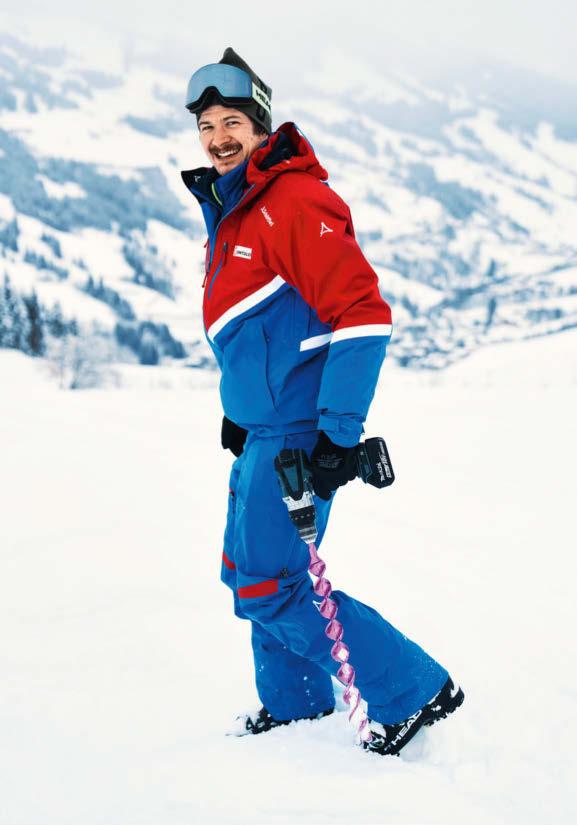
FOLLOWING IN HIS FATHER’S FOOTSTEPS
Fritz Steger junior was also rarely found on the mountain without his drill. After all, there was always something to do.
As (voluntary) piste manager for the women’s races, Fritz Steger junior deserved this praise from a highpowered expert just as much as his father Fritz Steger senior as piste manager for the men. “Our collaboration was fawless. Every evening, we talked about which sections we’d work on next – whether on the women’s or the men’s course.”
During their work, the two Stegers, whose grandfather/father Herbert was course manager of the 1991 World Championships, enjoyed the backing of a wellrehearsed team: “A further father-son duo, Harry and Manuel Gensbichler, was responsible for the snowmaking. Richard Mayr and Max Kloimstein drove the snow groomers and ultimately shaped the courses. We used snow alone to model all of the waves, jumps and spectacular curves that made the races so exciting.”
Construction of the race courses began in early November 2024: “As soon as it was cold enough, Harry and Manu created the necessary foundations by producing the frst artifcial snow”, says Fritz Steger junior. “We then got really lucky with the weather all winter. It was always cold, but it rained little. That meant we could regularly spray on artifcial snow, water it and allow the piste to rest. If we’d had more fresh snow or rain, we wouldn’t have been able to get this perfect cover.”
HIGH TECH MEETS NATURAL FEEL
Fritz Steger junior chats to Richard Mayr, who can precisely control his multi-tonne snow groomer with the aid of state-ofthe-art technology and extensive experience.
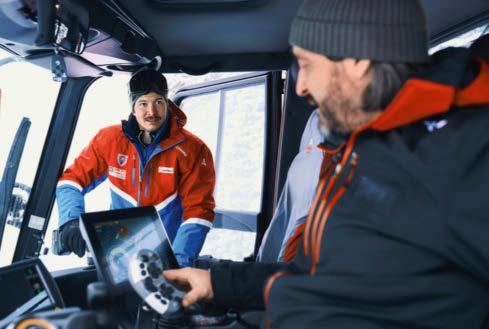
This “cover” that Fritz Steger junior refers to is the continuous blanket of snow that ofered the ski racers the perfect conditions: “This cover builds up over several months, and often comprises various layers of difering solidity one on top of another. This can result in the piste collapsing under strain and holes appearing. When we drilled into the snow this time, we could see that it really was a continuous mass.”
During the World Championship races themselves, Fritz Steger junior, who became father to twins at the start of January, was always somewhere to be found on the piste: “I went up onto the mountain at half past fve, quarter to six every day and drove straight down the piste to check if everything was okay. I was also in permanent radio contact with the race manager. There was always something we had to adjust quickly. For example, the soft snow created just before the jumps had to be regularly removed.”
Fritz Steger junior can’t say how many tonnes of snow the grooming machine drivers pushed into position with centimetre precision. Or how many working hours they all invested in the pistes night and day: “But what I can say is that the World Championships were a dream for us. We can be truly satisfed.”
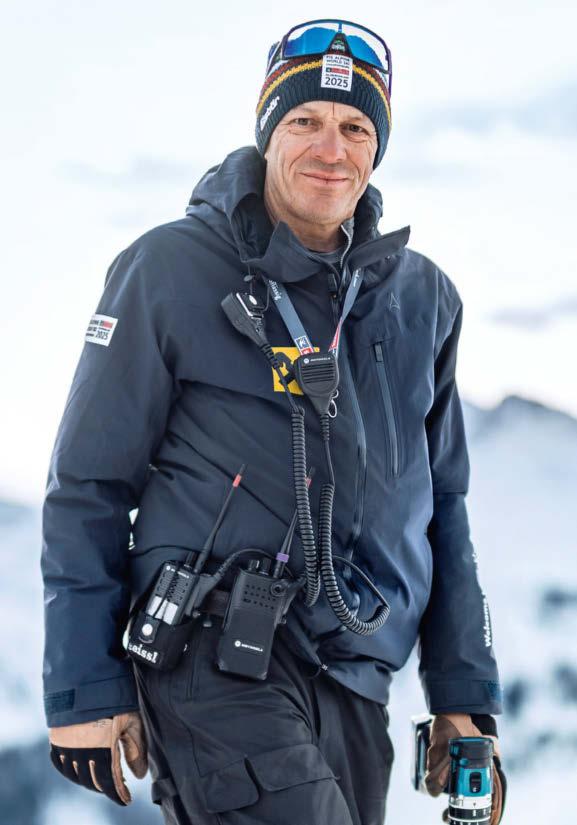
ALWAYS AVAILABLE
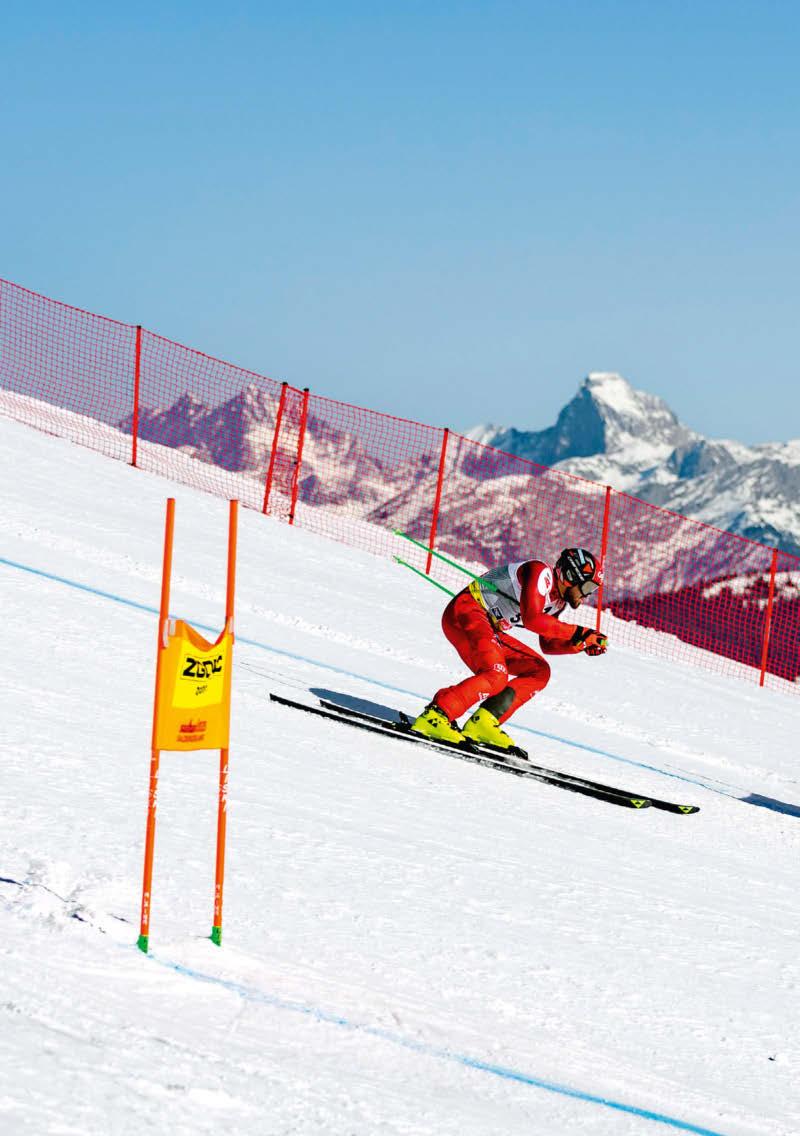
“WE DID IT!”
As Chief of Race, Rudi Zeller was responsible for all of the men’s events. And he knows which unsung heroes he has to thank for the successful World Championships.
The best was saved for last. “The greatest and most emotional moment for me was on the Sunday after the fnal slalom race”, says Rudi Zeller, Chief of Race for all of the men’s events. “During the closing ceremony, the fag was passed to the Swiss, who will host the next World Championships in two years’ time. A couple of colleagues and I fell into each other’s arms at the fnish line. Tears ran down my face. All the pressure lifted. It was incredibly liberating. I had one clear thought: we did it!”
For the man from Maishofen, Austria, the World Cup fnals in Andorra in 2023 marked the start of the big adventure: “We were in Soldeu with a delegation from the municipality, the tourism association, the lift operators and the ski club. Following the on-site inspection, we created the individual teams that were to ensure that everything ran smoothly at the World Ski Championships in Saalbach Hinterglemm.”
As Chief of Race, Rudi Zeller – like Bascht Gensbichler, his counterpart for the women’s events – had to coordinate “around 200 to 220 people on the piste, from the starter to the fnish line judge. There were those responsible for barriers, safety netting and directional gates as well as the slip crew, who ‘slipped’ down the course after every two or three racers to remove the newly created soft snow. They were my heroes! In addition, there were all the helpers from the Austrian Armed Forces, who supported us with various tasks. Without this teamwork, these World Championships wouldn’t have gone so smoothly.”
In his day job, Rudi Zeller works as a heating engineer. Like so many of the people who helped behind the scenes,
Chief of Race Rudi Zeller on the piste with his two radios and a smile on his face. During the races, he coordinated more than 200 people.
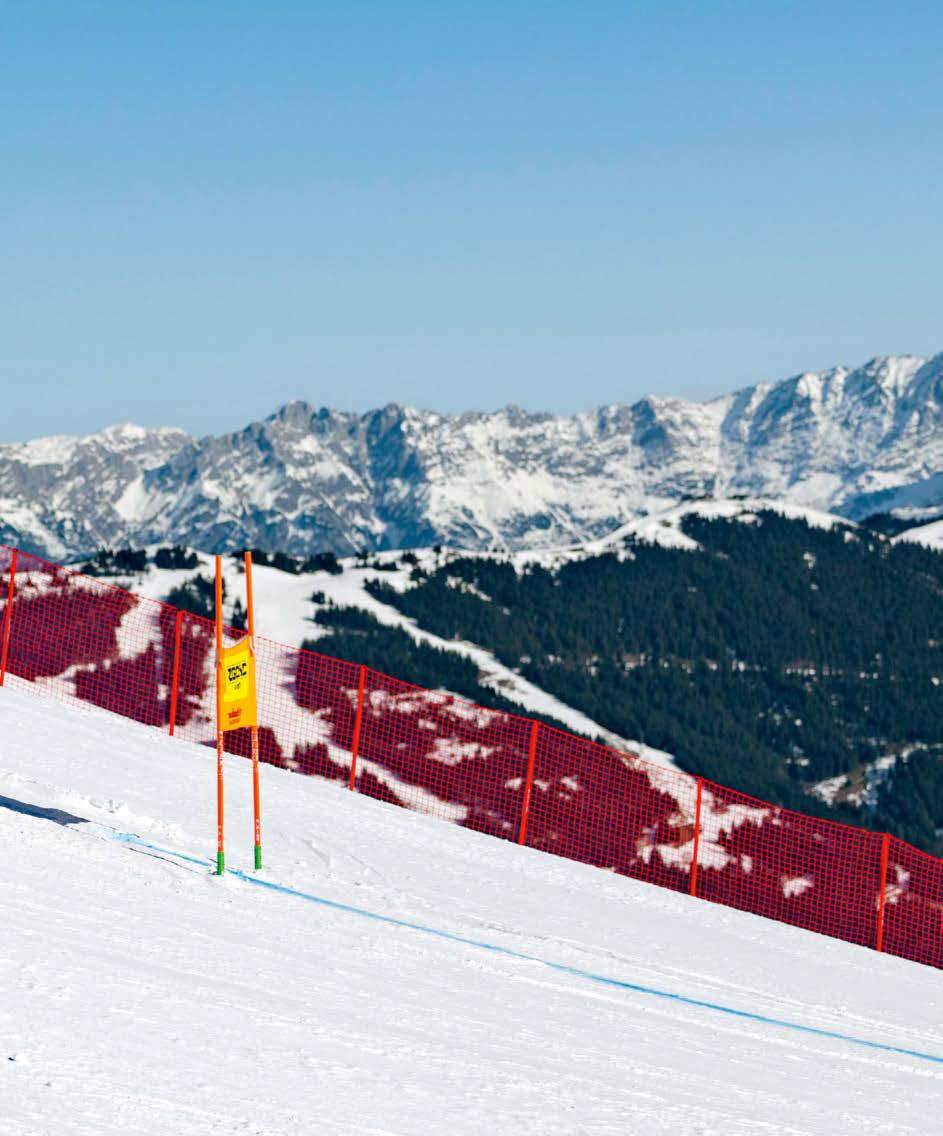
“We fell into each other’s arms in the finish area. Tears ran down my face. All the pressure lifted.”
FULLY FOCUSED
Stars like Daniel Hemetsberger, pictured here training for the downhill, were able to fully focus on their work.
A COORDINATED APPROACH
Bascht Gensbichler was responsible for the women’s events. Together with Rudi Zeller, he can look back on a perfect World Championships.
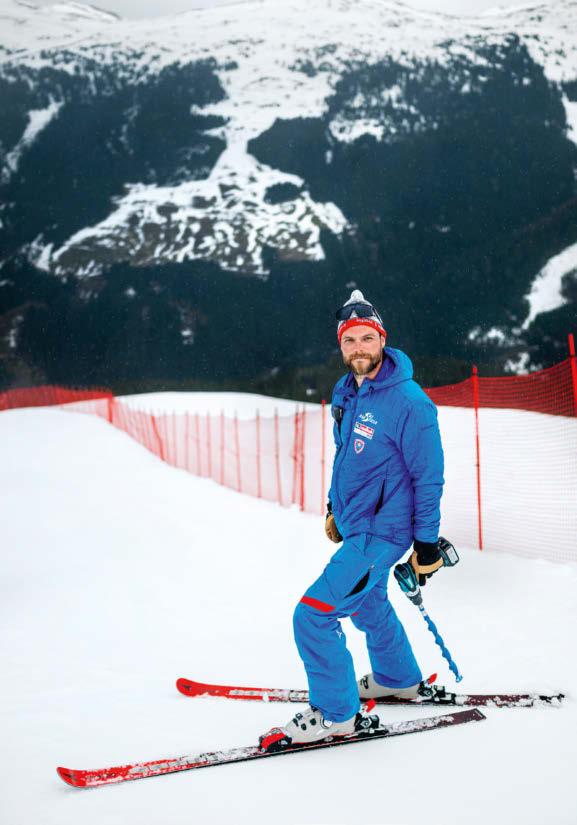
he took annual leave for the World Ski Championships. “If I hadn’t slept up on the mountain anyway, I met my people for breakfast in the new service deck by the snow groomer garage by no later than 5.45 a.m. We all really enjoyed the peace and quiet on the mountain so early in the morning.”
After that, breaks were inconceivable: “As the Chief of Race, I was a member of the panel who had to take decisions on things like stoppages following crashes, so I had to carry two radios on me at all times.” Rudi Zeller bore great responsibility on his shoulders – in his own words: “Because we were responsible for both the safety of the racers and our own safety. Ultimately, everything went as planned. I’m extremely proud of my entire crew.”
BEHIND THE SCENES WITH BÜXI
As a passionate amateur photographer, the former worldclass ski racer Marco ‘Büxi’ Büchel offers us unique insights into the World Ski Championships.
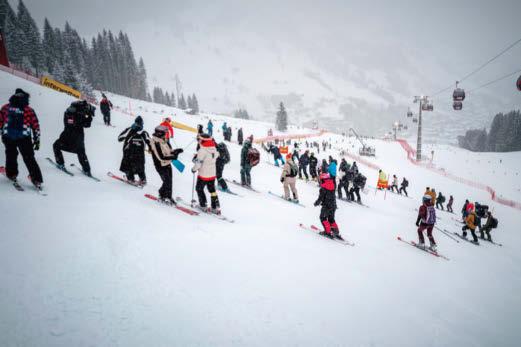
CONGESTION ON THE PISTE
“The course certainly got busy just before the men’s giant slalom, where a hundred competitors took to the start line. Piste staff, trainers, support staff, camera operators –I’ve rarely seen so many people on a slope. It was extremely hard for the racers to properly inspect the course. I stayed at the sides so as not to get in anyone’s way.”
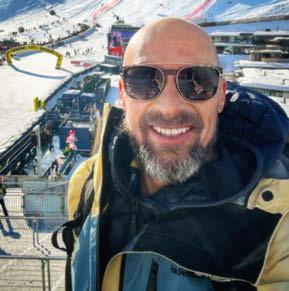
ABOUT BÜXI
Even while at school, Liechtensteiner Marco ‘Büxi’ Büchel, 53, discovered his love of – then still analogue – photography “and even learned how to independently develop films”. Since retiring from his career as a ski racer, during which he celebrated four World Cup victories, the giant slalom Vice World Champion of 1999 has become more intensely focused on his former hobby than ever. As such, Marco Büchel, who was in Saalbach Hinterglemm as a cocommentator for the German television broadcaster ZDF, naturally had his Leica Q3 to hand during the World Ski Championships. He showed us a selection of his favourite photos; next year, he wants to publish a book of his best ‘behindthescenes’ pictures from the world of skiing.
SMALL TALK
“I even competed against Dominik Paris, pictured here on the left, myself. We got on brilliantly and had a chat before the team combined. Canada’s Brodie Seger joined us and wanted to know how Domi is always so fast in the top course section. And Domi revealed his ‘secret’ to him: ‘You just have to push off harder at the start...”
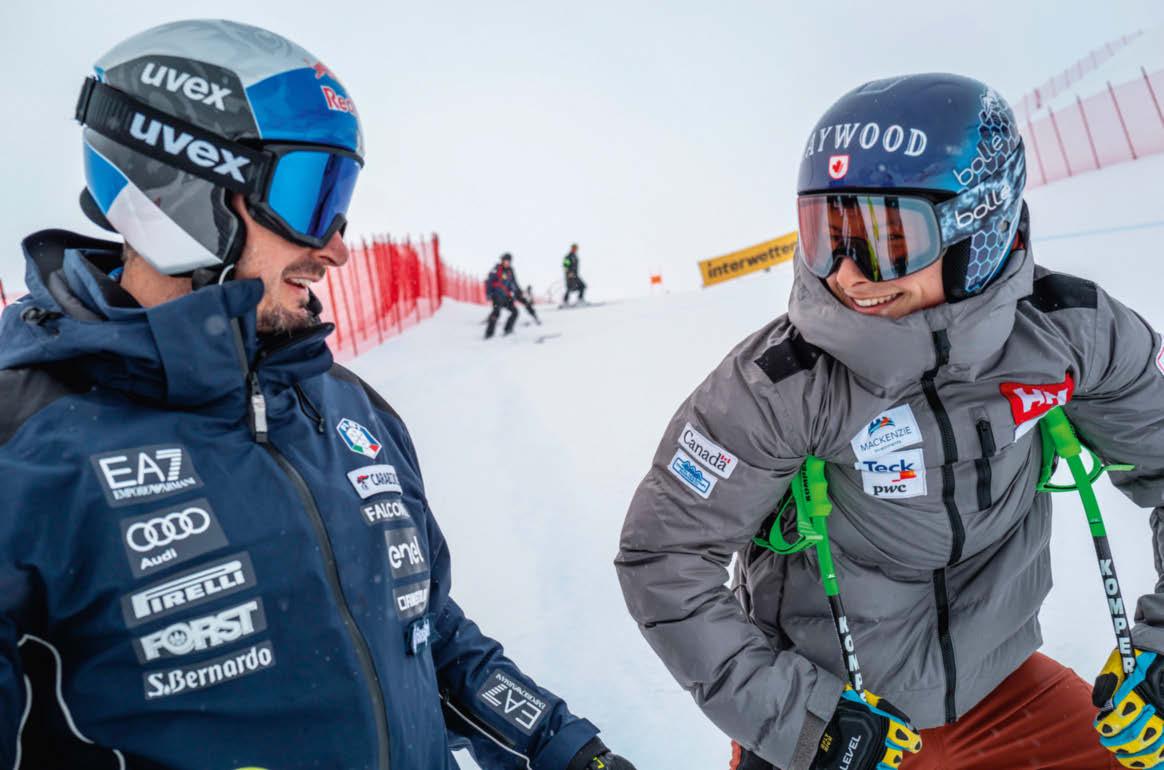
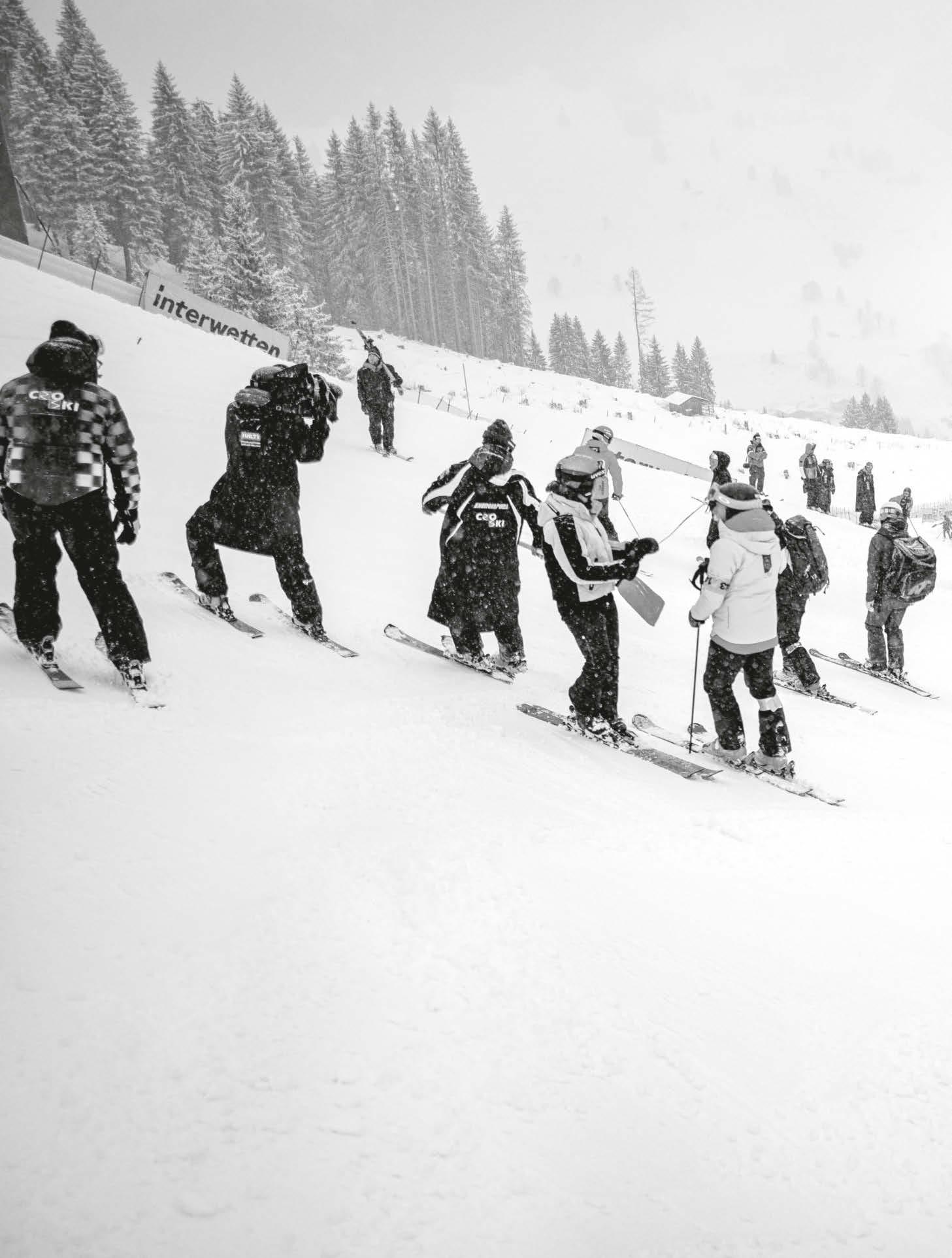
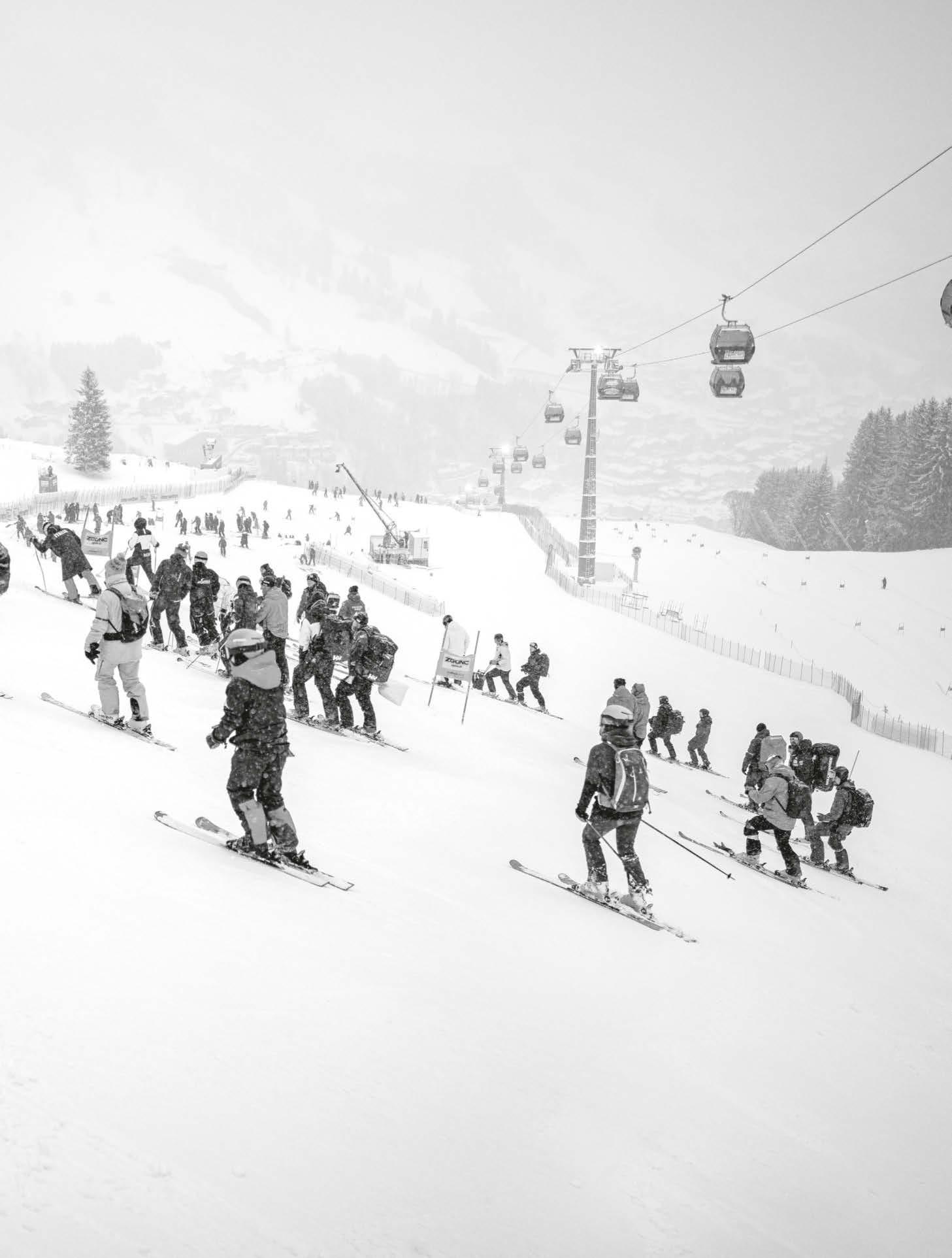
WHAT REALLY MATTERS
“Vincent Kriechmayr had just won the silver medal in the downhill. After the initial interviews, he spotted his family and fan club behind the mixed zone. He scaled a fence and jumped onto the next barrier. I love this kind of emotion! This moment showed us that Vinc knows exactly where he comes from and who he can count on. He shares his success with his loved ones. You could see that this moment meant a great deal to him.”
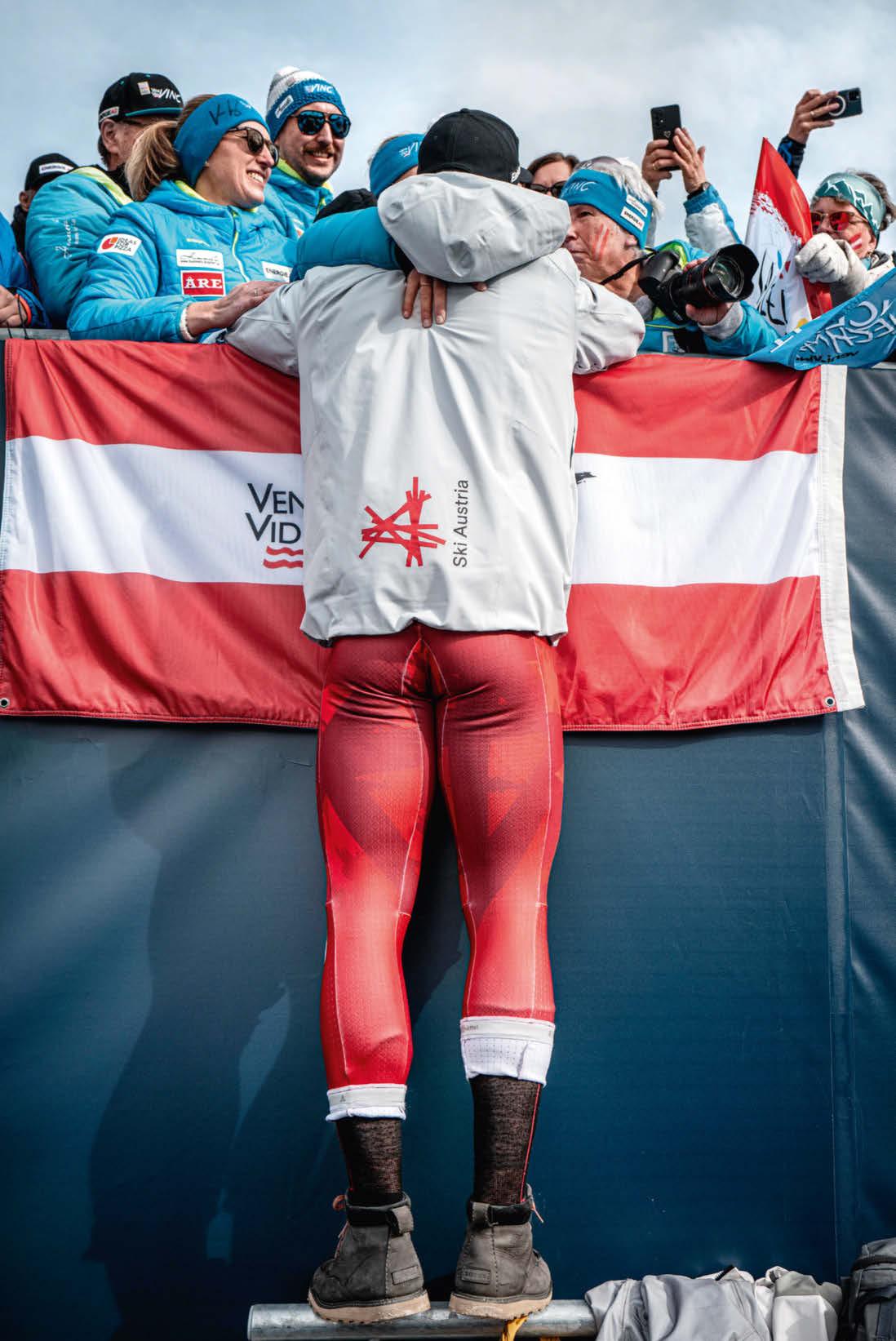

“The young woman with the space-age goggles gave me a poignant look.”
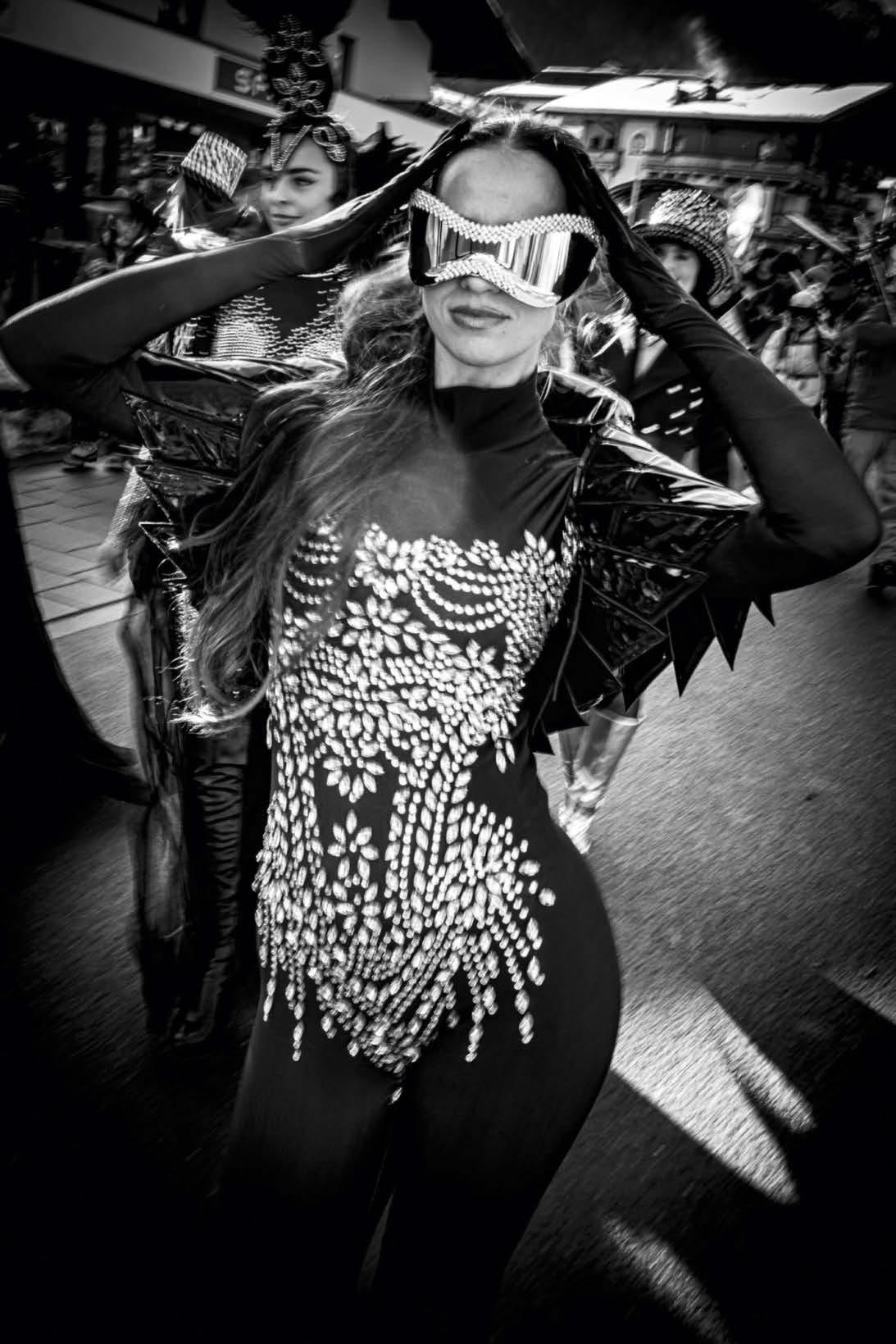
CARNIVAL IN HINTERGLEMM
“This show troupe danced its way through the fan mile to loud music, following a golf cart. I was fascinated by their glittering costumes and smooth movements.
I experimented with longer exposure times as I wanted to capture their dynamism. I had to discard most of the photos from the series, but the young woman with her space-age goggles gave me a poignant look that I was able to capture beautifully.”
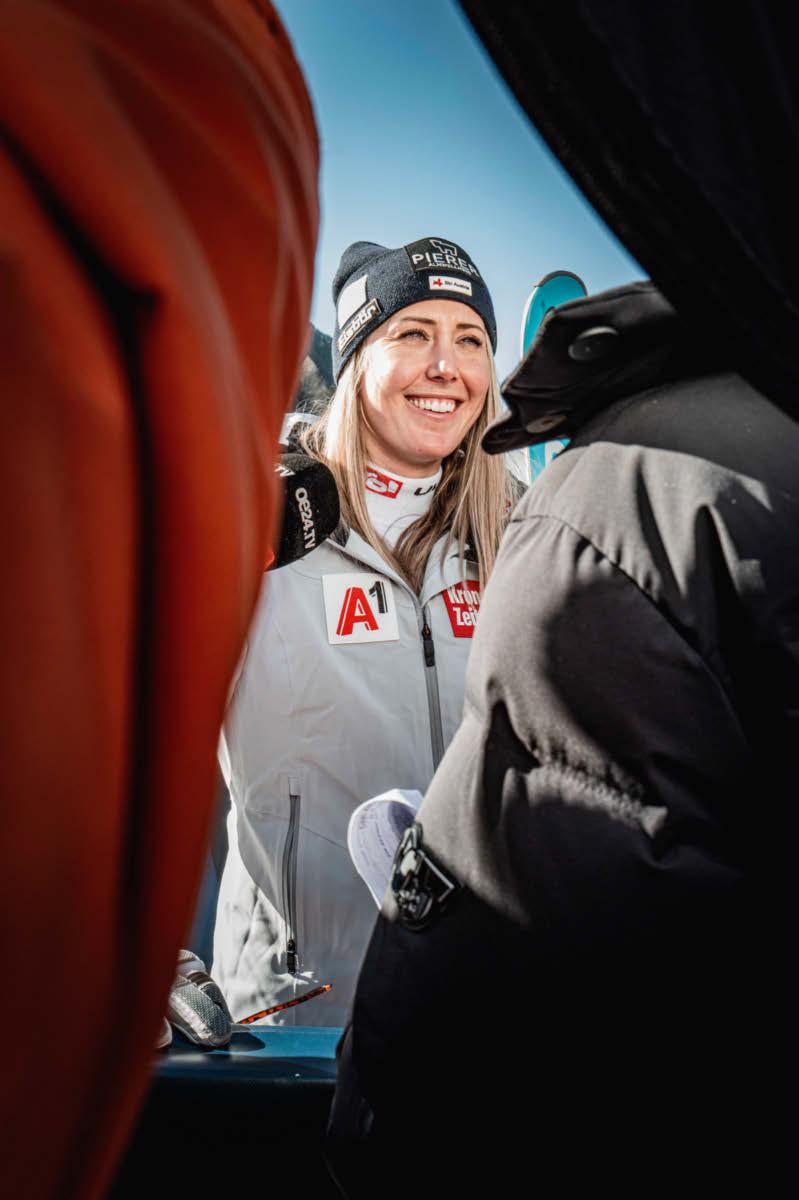
LIFE GOES ON
“One year ago, Conny Hütter won the downhill World Cup here in the final race. At the World Championships, she didn’t live up to her role as joint favourite and had to explain to reporters why things didn’t go to plan. As a former ski racer, I could understand exactly how she felt at that moment – and saw a gracious message in her smile: ‘It’s not the end of the world if I don’t win a medal.’”

YOU’VE GOT TO HAVE FUN
“The young man giving me the sceptical look is my cameraman at ZDF, Thomas Rebholz. Everyone knows him as ‘Kerbl’, and I wanted to take a quick photo of him on the piste. He was fully focused and spun round, startled, when I shouted ‘Hey, Kerbl!’. Sometimes, you’ve just got to have these little bits of fun.”
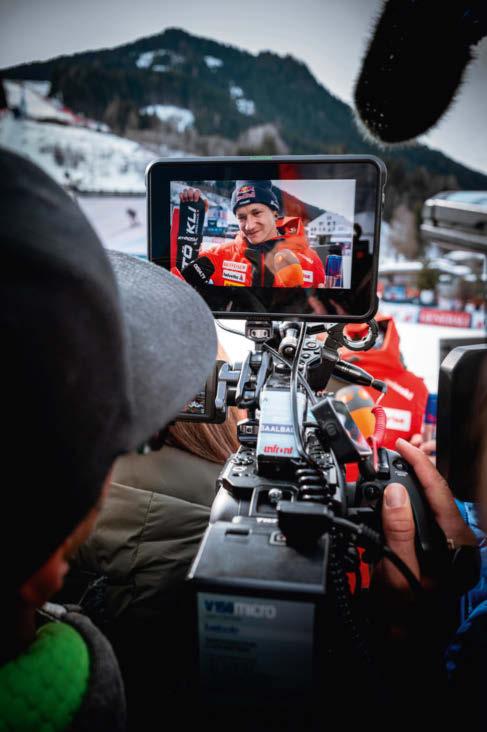
FANFARE AROUND MARCO ODERMATT
“Whether he wins or – as here in the downhill – not, Marco Odermatt is always surrounded by a throng of people. I intentionally refrained from photographing him directly and instead pictured a cameraman’s monitor as I wanted to show the high level of media interest in him. As a Liechtensteiner, I never felt this kind of pressure. But Marco can’t get away from all the fanfare. He always has to face it and explain why he won – or, in some cases, didn’t.”
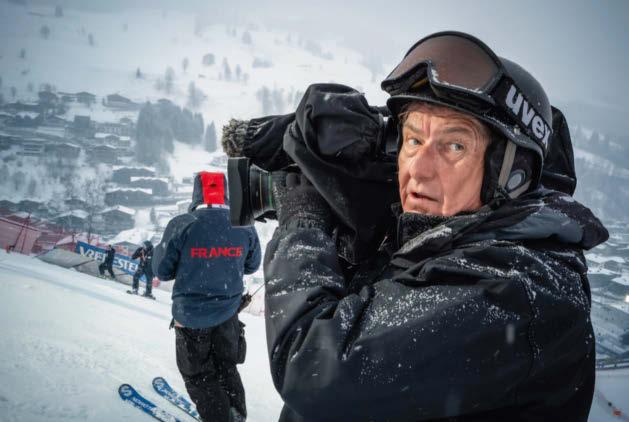
UNSUNG HEROES
They fostered a relaxed atmosphere, took emotional pictures and kept the fans safe. We ask the lesserknown stars of the World Ski Championships in Saalbach Hinterglemm to take to the stage.
“THE FANS MOTIVATE US!”
The commentators Didi Ziesel and Stefan Steinacher come together with DJ In-Style to enjoy an emotional ski party – and inspire spectators with their passion.
The sun shines brightly as over 20,000 fans laugh and dance in the stands in joyful expectation of the upcoming World Championship spectacle: the men’s downhill!
Above them, 22 metres up, Didi Ziesel from Saalfeld and Stefan Steinacher from Fieberbrunn enjoy the music that DJ In-Style blasts into the stadium through the speaker towers. ‘Walking on Sunshine’, the catchy 1983 pop classic by Katrina and the Waves, perfectly summarises the motto behind today’s ski party. The two commentators adjust their headsets and nod at one another, their eyes gleaming. It’s showtime!
Didi Ziesel and Stefan Steinacher are a well-rehearsed commentator team; they’ve been providing exciting entertainment together since the World Cup fnal 2002 in Zauchensee, Salzburg. And they’ve developed some ingenious tricks for shining the spotlight on one another while also ofering spectators a smooth-running show: “We’ve stuck numerous pieces of paper with diferent bits of info on the walls in our commentator booth”, reveals Didi Ziesel during the site visit prior to the men’s downhill. “If I ask Stef a question, such as whether he remembers the downhill in Saalbach in 2021, I point to the corresponding bit of paper frst. That allows Stef to shine and say: ‘Yes, of course, that was when our Vinc Kriechmayr won and Mottl Mayer came third …’”
Of course, the extensive preparations go far beyond statistical subtleties. Didi Ziesel and Stefan Steinacher are well-connected in Skicircus; they head out onto the pistes on their days of and chat amicably to athletes, support staf and service personnel as well as the piste workers. “We know a great deal about every racer but the art lies in not overwhelming the spectators with information. If there are race stoppages in particular, it helps for us to be able to talk about exciting things though.”
TRIPLE THE TALENT
Commentators Stefan Steinacher (left) and Didi Ziesel (right) in their booth with DJ In-Style. The 22-metre-high commentator booth offers a perfect view of the finish slope and the spectators in the stadium.
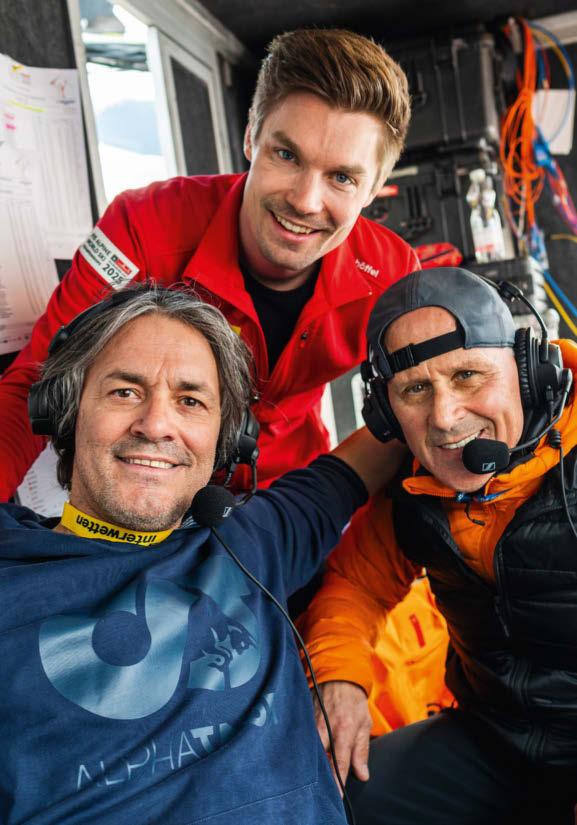
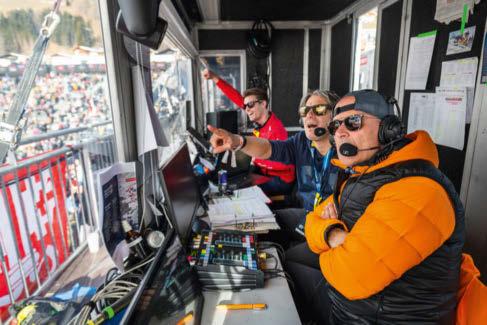

THE COOLEST WORKPLACE OF THE WORLDS DJ In-Style, Stefan Steinacher and Didi Ziesel (from left to right) don’t just look like rock stars; they get thousands of fans cheering!
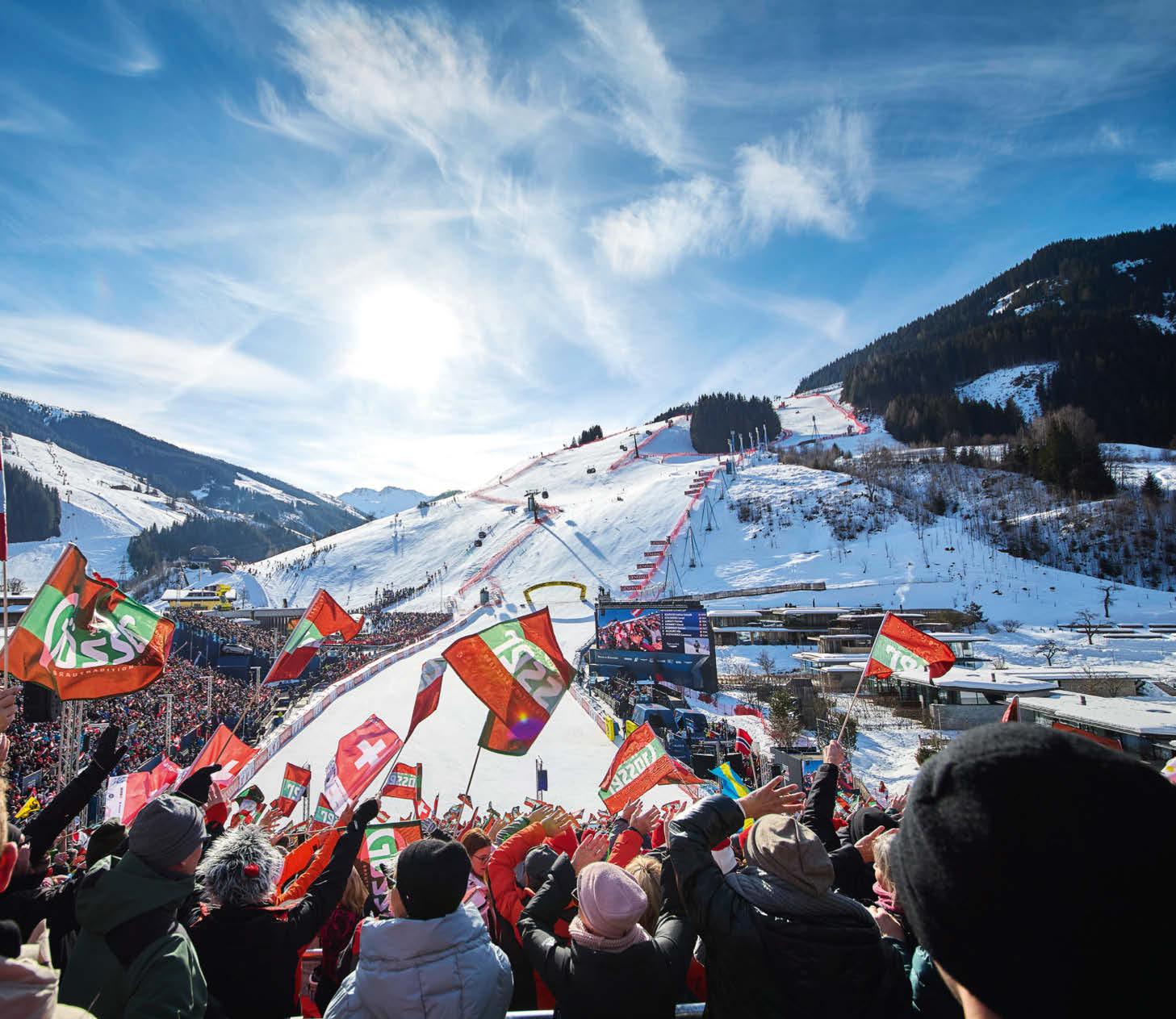
At the World Championships in Saalbach Hinterglemm, the pair were responsible for the atmosphere during the men’s races; former world-class ski racer Michaela Kirchgasser and Marco Tscharnig commentated on the women’s races, with musical support from DJ Markus Engelmayer. According to Didi Ziesel, the successes of the Austrian athletes in the previous races, especially Stef Venier’s gold in the super-G, played a huge part in creating the relaxed mood at the men’s downhill: “That naturally created an incredible dynamic!” Didi Ziesel, who also worked as a stadium announcer at the World Championships 1991 in Saalbach, admires the ungrudging joy with which the spectators cheer on athletes from other nations too: “This extreme enthusiasm by the fans is infectious and motivates us to commentate even more passionately.”
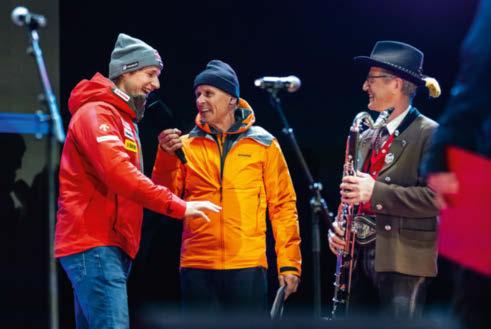
UP CLOSE TO THE STARS
In the evenings, Didi Ziesel (centre) acted as a presenter on the medal plaza during the bid number draw and joked animatedly with superstar Marco Odermatt.
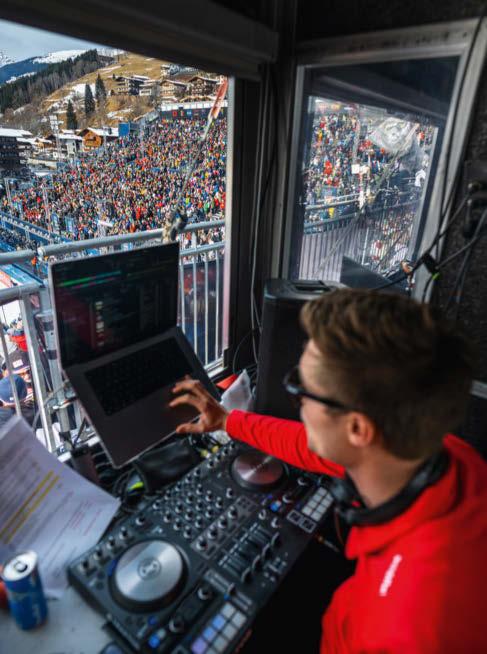
The sign on the door to the small commentary booth stating ‘Mental asylum. Enter at your own risk!’ is naturally meant jokingly. “Stef and I get on fantastically outside work too; I’m even godfather to his son.” They try to convey this closeness during their commentary: “Our passion for the sport is genuine! We hug one another, we kiss one another, we celebrate the athletes with the same intensity as the fans on the stands.”
Vincent Kriechmayr crosses the fnish as leader to thunderous cheers before Franjo von Allmen cuts the best time even further not long afterwards. Up above, in their booth, Didi Ziesel and Stefan Steinacher fing their arms around each other’s necks: “You couldn’t wish for a better World Championships!”
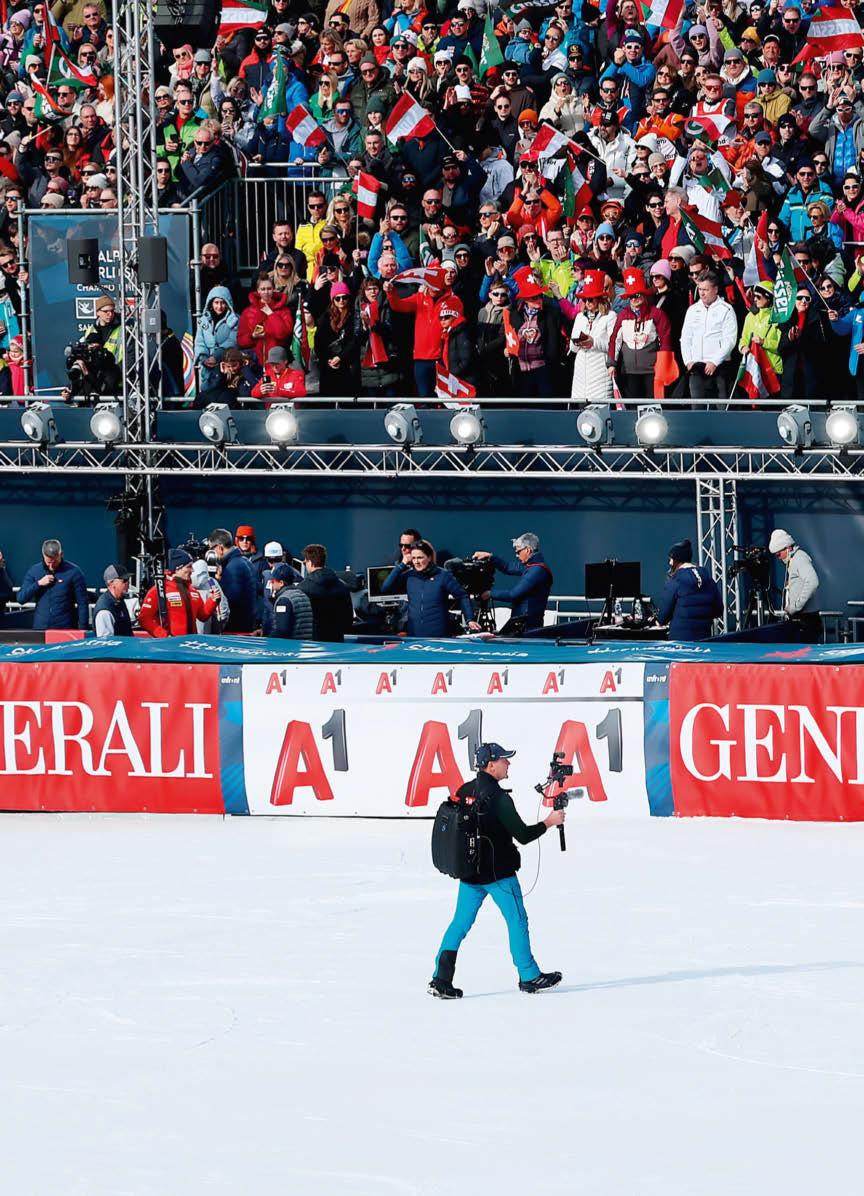
CAPTURING
RAW EMOTIONS
Few people get as close to the stars as Andreas Sacherer. Whether wild jubilation or bitter frustration: the cameraman is the first to capture emotions at the finish line.
“We hug one another, we kiss one another. We celebrate with the same intensity as the fans.”
Lauren Macuga instinctively knew that she had just completed a dream run. Her grin appeared even before she crossed the fnish. The American then looked over at the scoreboard and saw that she had indeed fnished with the best time in the downhill race for the team combined. She started to dance. And Andreas Sacherer danced with her, his camera just a few centimetres away from her face. Lauren Macuga’s initial emotions, which the cameraman captured up close, were transmitted to the video wall in the fnish stadium and to the entire world live on television. “That was perfect”, commented
A GUARANTEED HIT
DJ In-Style – with a view of the fans – finds the perfect sounds for the World Ski Championships on his laptop.
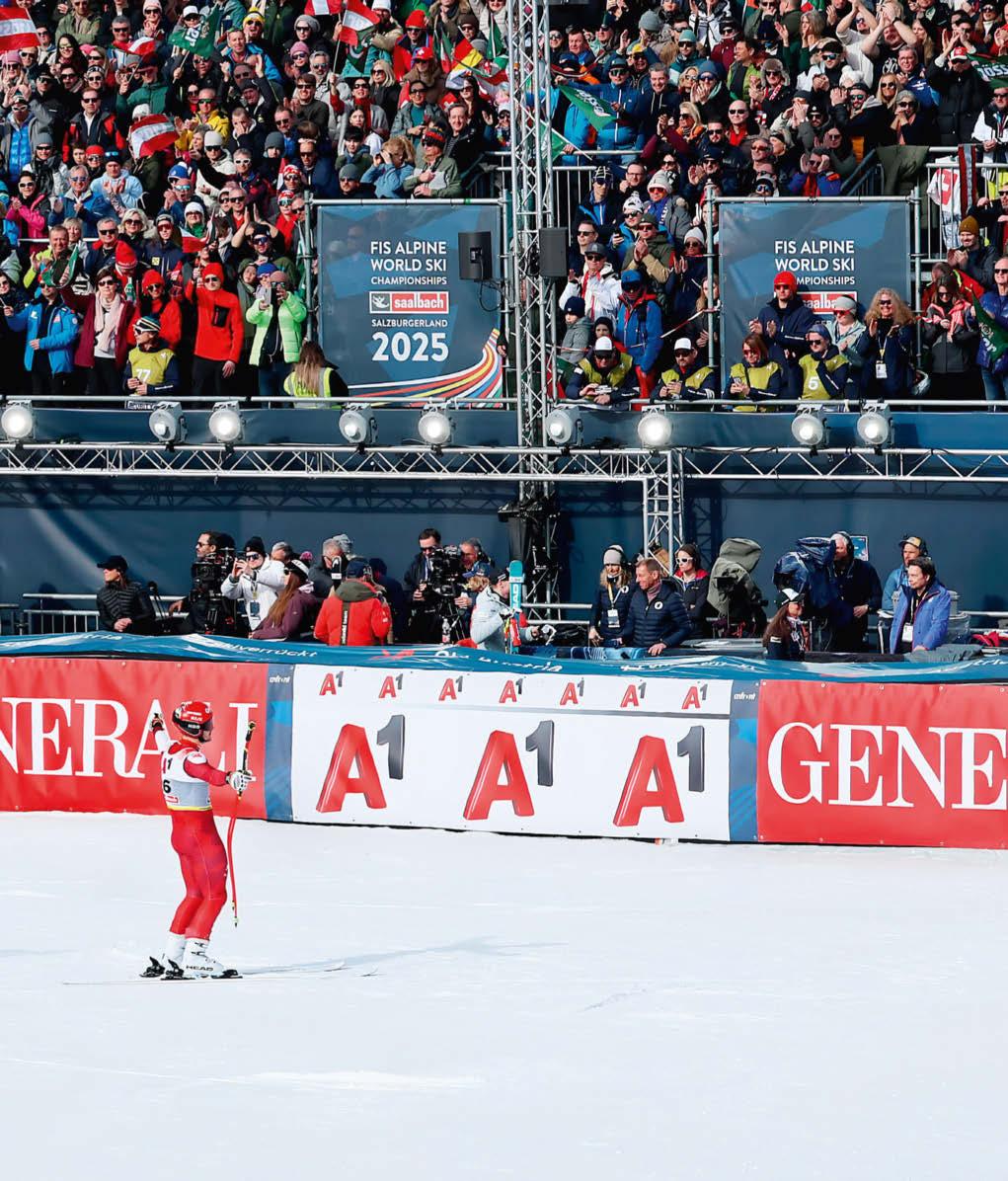
SPECTATORS INCLUDED
Stefan Eichberger thanks the fans after his downhill race; Andreas Sacherer shoots towards the stands: “The fans always have to be visible in the background!”
Andreas Sacherer afterwards. “These are the kind of unadulterated moments that we want to see.”
The cameraman from Carinthia came up with the idea of using a gimbal, a motorised support that automatically compensates any jerky movements to make footage smoother: “It’s impossible to get to the athletes as quickly with a conventional shoulder camera, so we never used to be able to capture the initial emotions.”
Andreas Sacherer frst used this technique fve years ago in Kitzbühel: “I suggested it to the director and tested it during training. Straight after the frst racer, he came over the radio: ‘Okay, all good, we’ll go with it!’” After all, it had never before been possible to document the initial reactions so directly and genuinely. Of course, it took a while for the ski racers to get used to being instantly flmed: “Some of them weren’t exactly happy about facing a camera so quickly. Over time, they’ve come to accept me though.”
THE MAN AT THE FINISH
Andreas Sacherer from Carinthia, Austria, with his working equipment. The special support enables him to capture particularly quick, smooth images.
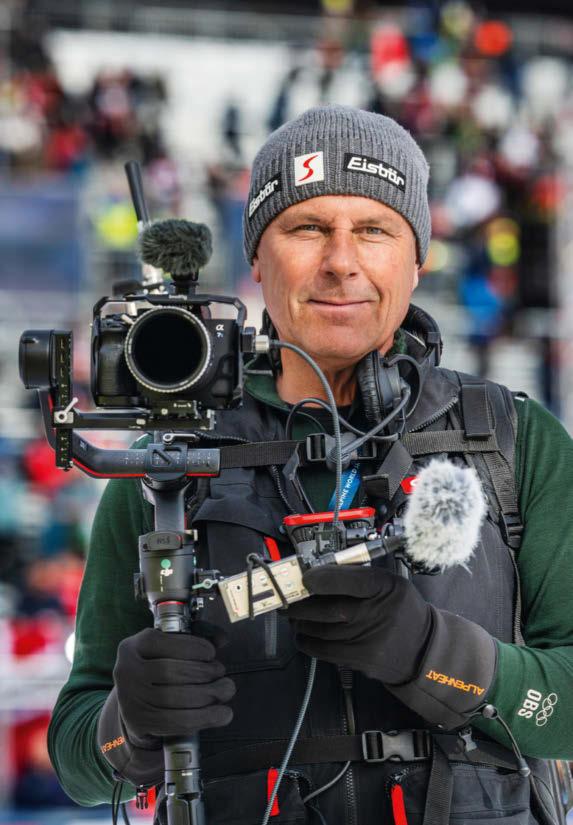
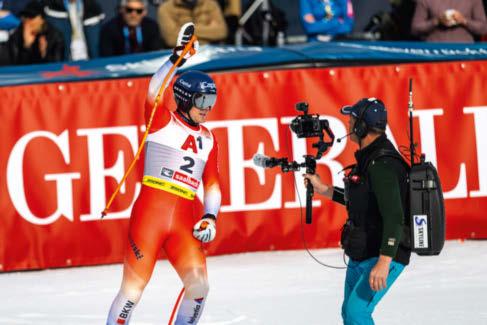
EASY GUIDANCE
Andreas Sacherer casually holds his camera in his right hand; Stefan Rogentin (SUI) waves to the spectators. His time on the downhill doesn’t even rank him in the top ten.
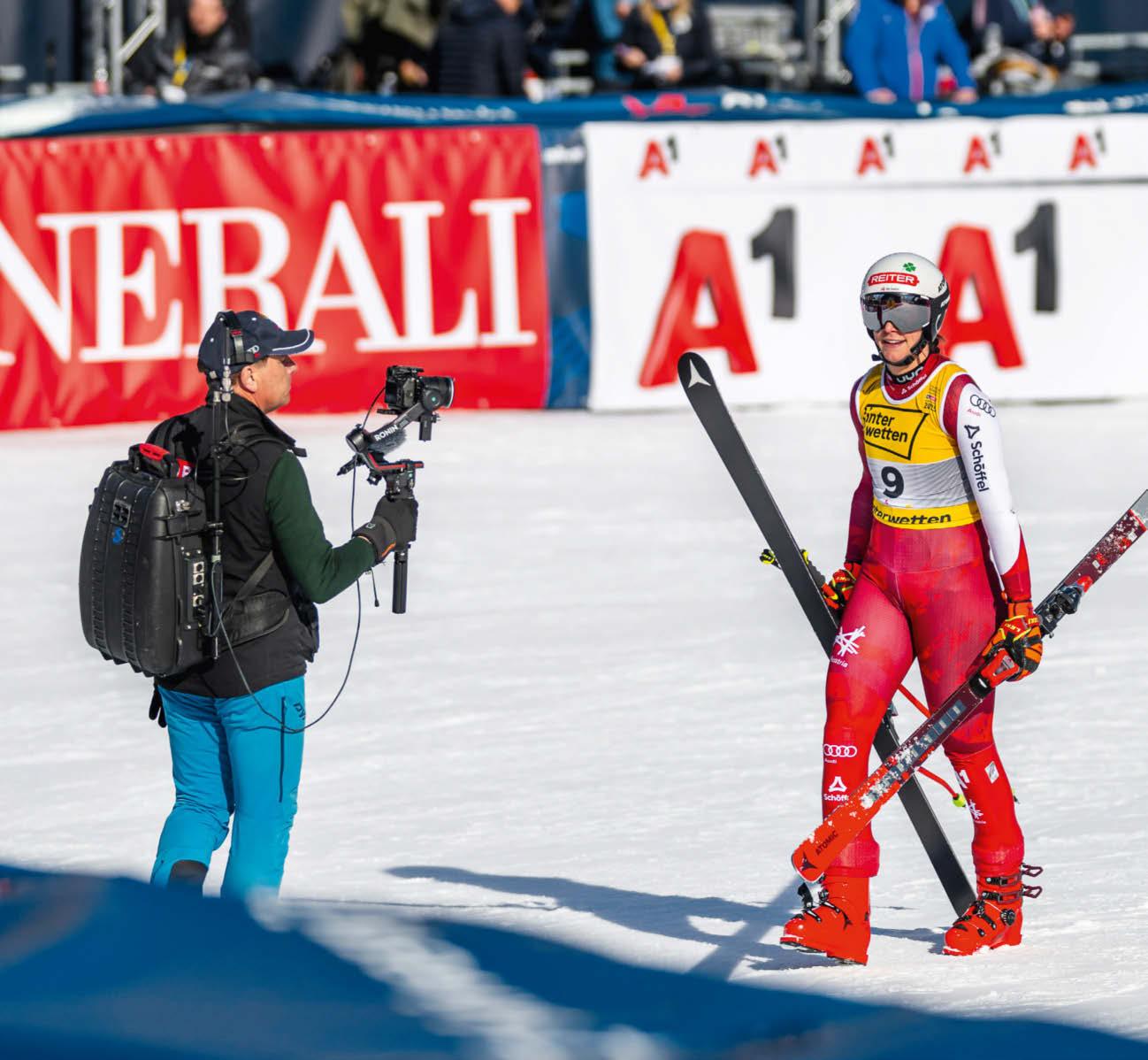
This is not least because the athletes have realised how valuable these authentic pictures can be for their image: “Many of them have cottoned on to the fact that they can play with me, with my camera. And that these recordings are ultimately good for their image and that their sponsors are happy to have the spotlight shone on them in this way too.”
This is why Andreas Sacherer regards Brazil’s Lucas Pinheiro Braathen as “a very special gift. He’s a real showman”. But athletes like Italy’s Dominik Paris, who thumped his fst on the advertising board in the fnish area after missing out on a medal in the downhill, make for good TV footage too: “Top athletes are extremely ambitious. Frustration and anger are as much a part of this as jubilation and joy. My task simply lies in capturing these emotions.”
“Many of them have cottoned on to the fact that they can play with me and my camera.”
The most important consideration during his work, however, is safety – both his own and that of the ski racers: “I watch the video wall to see exactly where they’re going to cross the fnish line. Then, I have to position myself to capture the spectators in the background of the footage with my wide-angle lens without getting knocked down if the athlete tilts and falls at the fnish.” If it’s obvious that they’re going to cross the line as planned, however, Andreas Sacherer dashes over with his camera – with the director in his ear telling him as soon as he’s live: “That’s when I fully attack. We want to see the emotions on their faces as quickly as possible.”
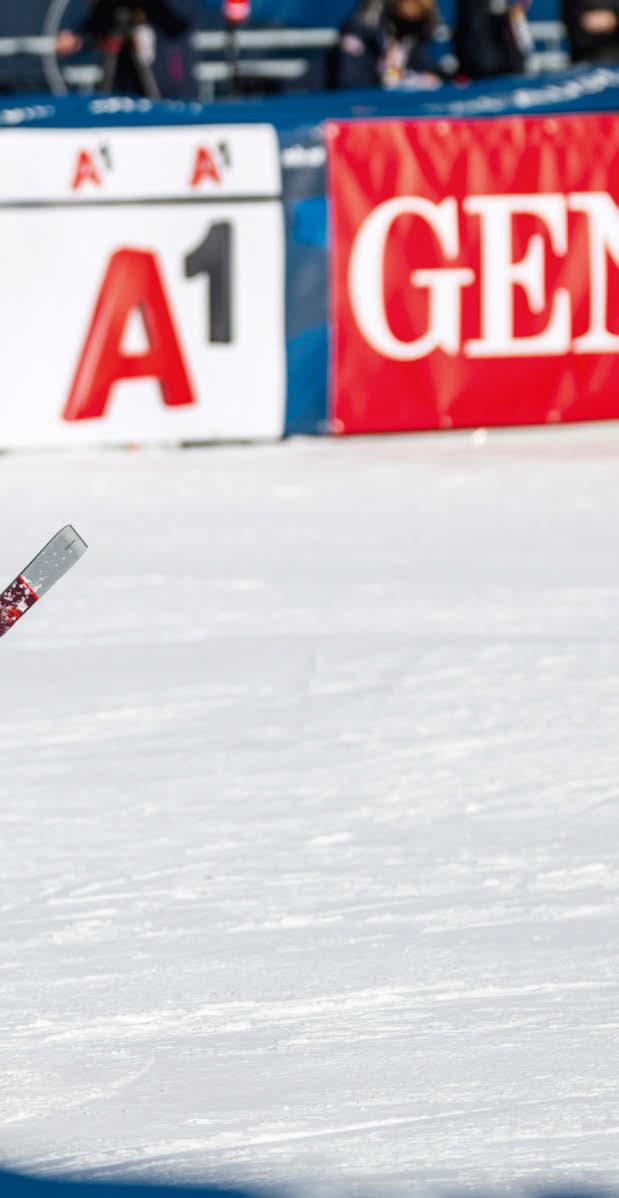
LOOKING RELAXED
Andreas Sacherer films Mirjam Puchner as she leaves the finish area. She isn’t yet aware that she’s just won silver in the downhill.
PERFECT COLLABORATION
Isabella Pernthaner-Schneider from Saalbach coordinated the Red Cross’s activities in cooperation with district emergency response commander Thomas Huber. She worked closely with the police and fire brigade – and was delighted at how quiet things were during the World Championships.
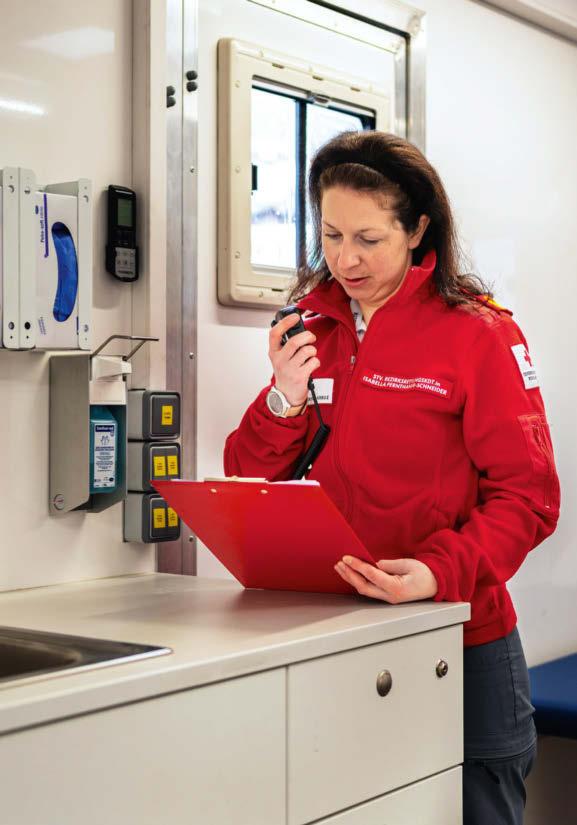
HARD AT WORK
Isabella Pernthaner-Schneider coordinated the activities of 35 Red
Isabella Pernthaner-Schneider, deputy district emergency response commander for Pinzgau, loves these kinds of surprises: despite almost 175,000 people visiting Saalbach Hinterglemm for the Ski World Championships, the Red Cross Salzburg only recorded 134 incidents. “This is particularly impressive considering we weren’t just in the stands and by the course, but also on the fan mile and at the medal plaza.”
The Saalbach local, whose father was course manager of the technical disciplines on the Kohlmais at the ‘Sunny World Championships’ in 1991, was therefore extremely pleased with how the major event went. “What we found interesting was that we couldn’t draw any direct correlation between the number of visitors and the number of incidents.”
This is because whereas eight and nine people respectively had to be treated for injuries at the best-attended races of the men’s slalom (23,000 fans) and the men’s downhill (22,500 fans), the busiest day for the Red Cross turned out to be that of the women’s giant slalom (11,000 fans), when there were 23 incidents. The incidents themselves were within the expected scope, says Isabella Pernthaner-Schneider: “We had to deal with concussions, bruises and, above all, knee and shoulder injuries.”
During the World Championships, 35 Red Cross employees were in attendance every day, strategically distributed around the spectator areas in teams of two or three people: “We gained valuable experience about where to best position ourselves during the World Cup fnal in 2024. The stands here were far larger, but we were still able to quickly determine our best routes to potential patients.”
According to Isabella Pernthaner-Schneider, the low number of incidents recorded during the around 4,000 service hours was partly due to the smooth management of the spectator streams: “The fans’ arrival and departure were extremely well coordinated. The new bus terminal at the edge of Hinterglemm turned out to be ideal.”
Isabella Pernthaner-Schneider was also on the emergency services’ task force as the Red Cross’s representative. Here, on the frst foor of the World Championship ofce in the former Hinterglemm primary school, the police, Red Cross and fre brigade coordinated their approaches in cooperation with the event organisers and authorities. “The close coordination enabled us to quickly refne processes. The teamwork was outstanding and the World Championships were extremely successful for us.”
Cross employees.
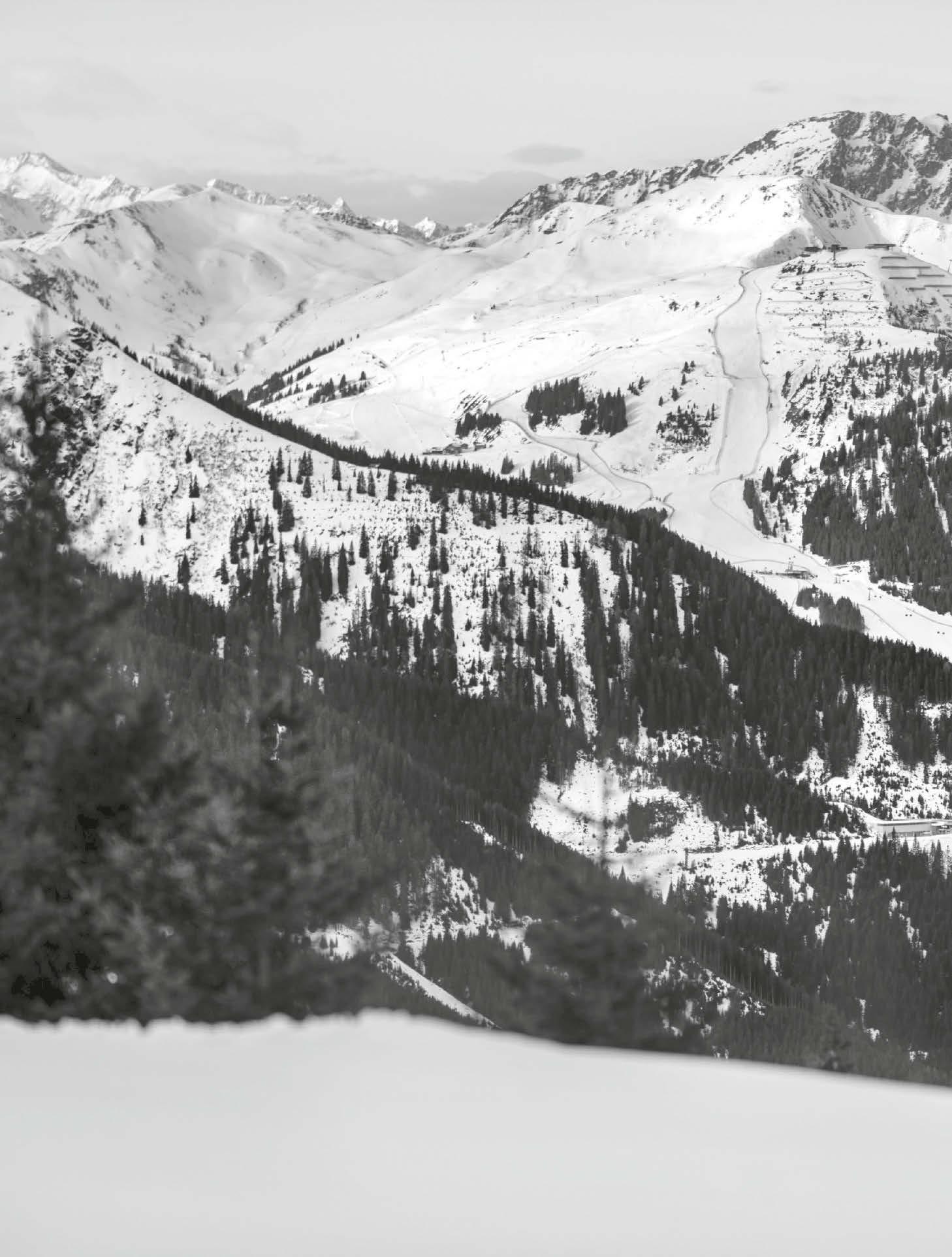
BEST WAY TO THE WORLDS? ON SKIS!
Skicircus Saalbach Hinterglemm
Leogang Fieberbrunn offers perfect alternatives to driving. Elena and Bernie proved that you can also travel to the World Championships on skis. Without any hassle.

8.00 A.M. Meeting point at the Steinbergbahn gondola lift in Leogang. By car, it would be a 40-minute journey to the World Championships. On skis, it’s pure pleasure.
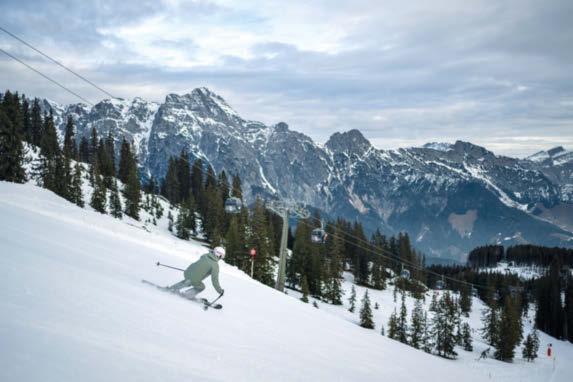
8.30 A.M. The morning sky over the Salzburg region is still slightly overcast, but visibility is good and the pistes have been perfectly groomed.
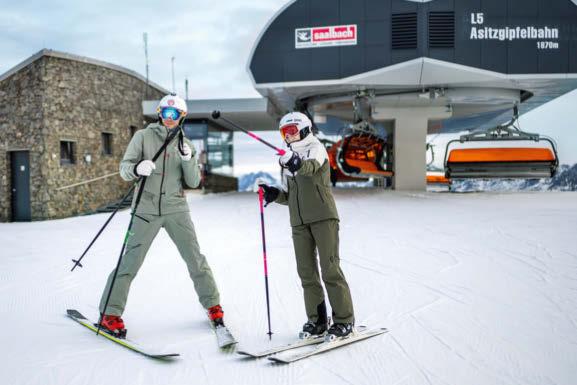
8.36 A.M. Look! Elena directs Bernie’s gaze to the mountain station of the Asitzgipfelbahn chairlift on the Zwölferkogel, where the red barrier nets along the World Championship course are visible.
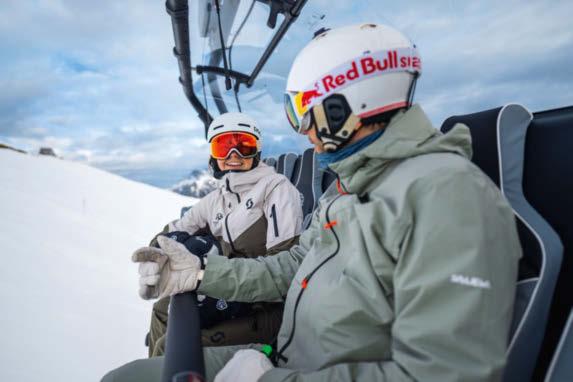
8.41 A.M. A short break on comfy leather seats.The ultramodern Asitzkogelbahn chairlift climbs to 1,907 metres.
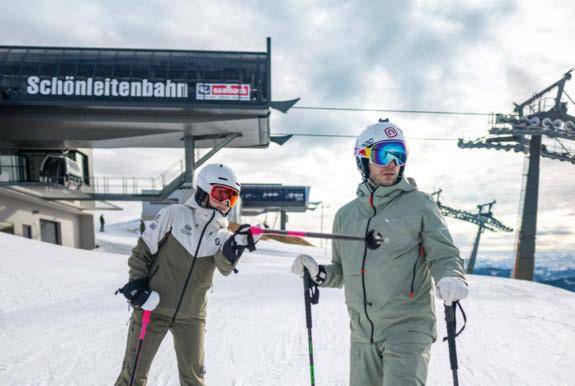
9.05 A.M. Next stop, the mountain station of the Schönleitenbahn gondola lift. The pistes – and not just those leading to the championship course – are well signposted.
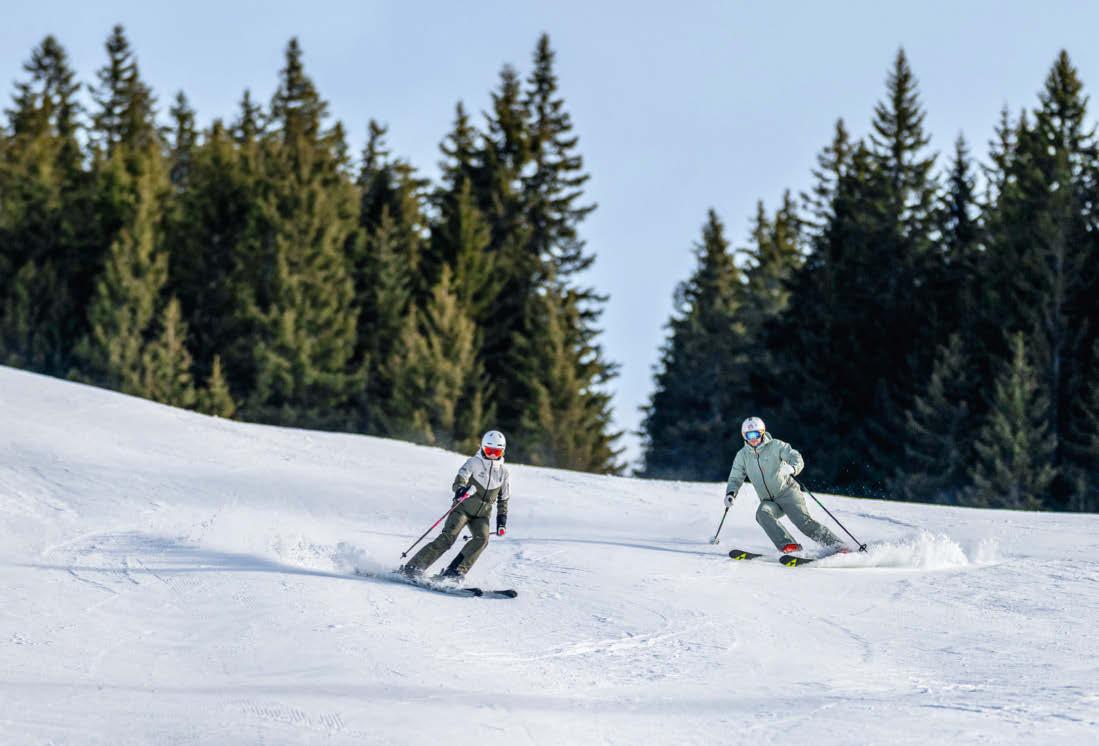
9.08 A.M. The sky gradually clears and the sun appears. Elena and Bernie speedily carve their way down to Saalbach.
9.15 A.M. Elena and Bernie throw their skis over their shoulders and enjoy a short stroll through Saalbach. The Bernkogelbahn gondola lift then takes them back up to higher ground.
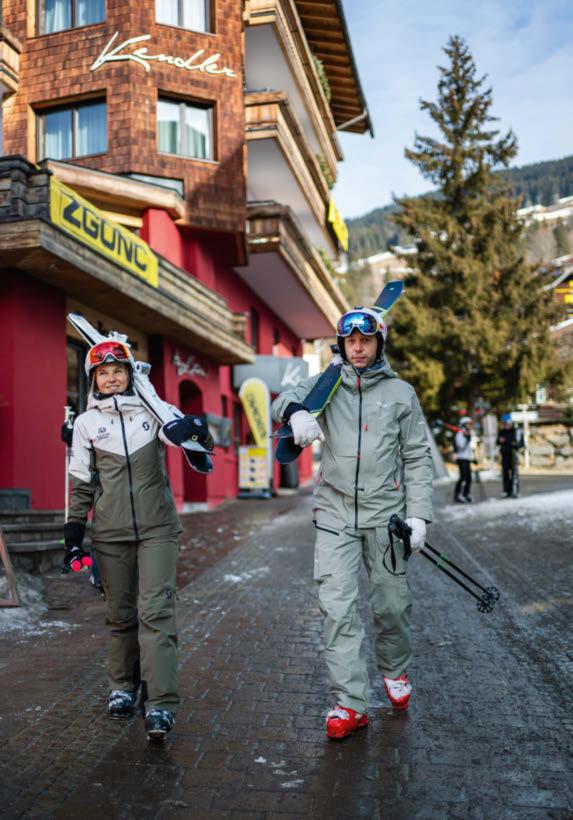
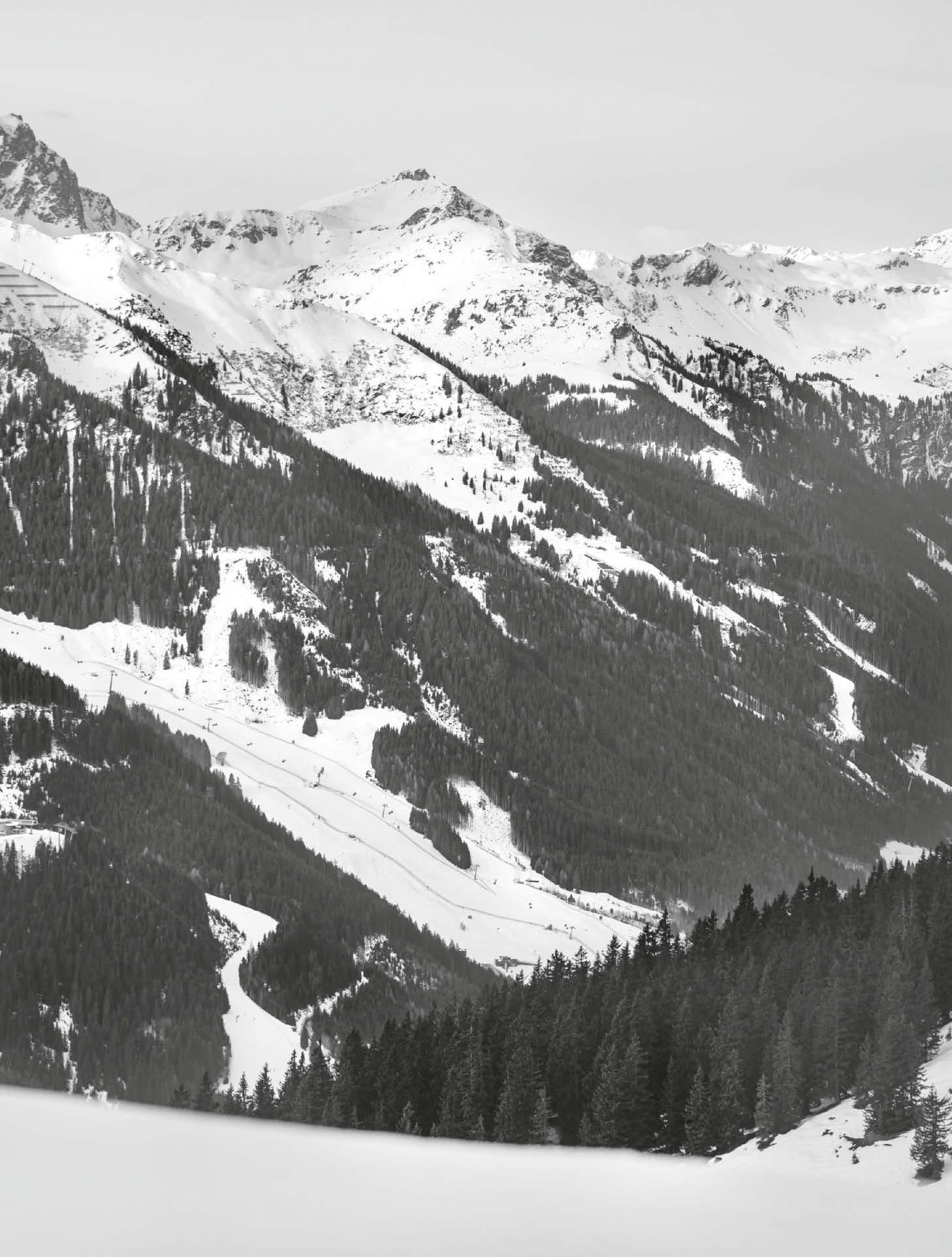
“Even though we’re miles away, we can frequently see the Zwölferkogel and the World Championship course.”
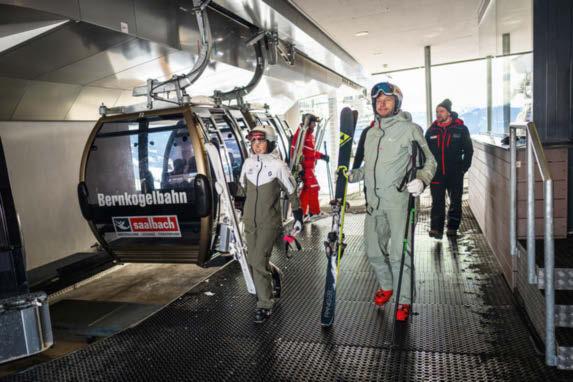
9.30 A.M. Time to get off the Bernkogelbahn. Elena and Bernie could stop for a break here and enjoy the spectacular views from the alpine hut terraces –but both are in skiing mode.
9.38 A.M. After a stunning descent and a further ride on the Bernkogel 6er chairlift, Elena cruises smoothly down to the 900-meter-long Reiter-Ost chairlift.
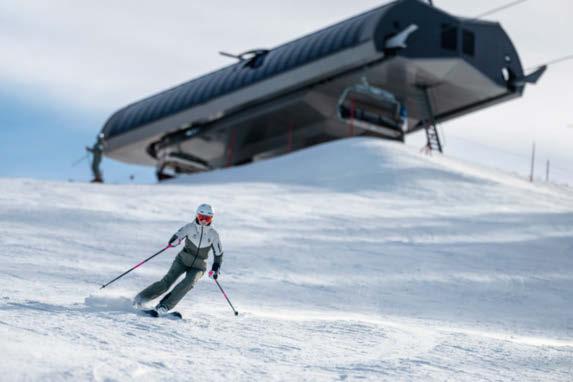
9.44 A.M. Elena and the sun are both beautifully radiant. The visitors skiing to the World Championships from Fieberbrunn also arrive up here on the Reiterkogel.
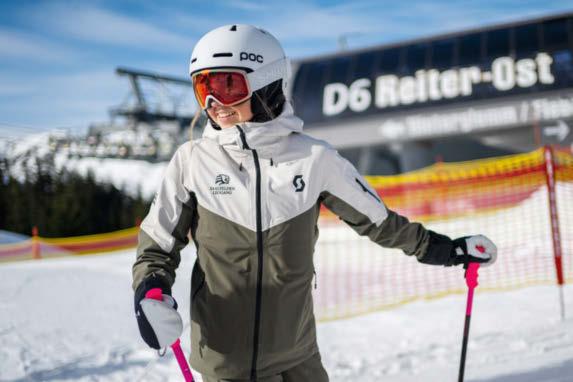
9.52 A.M. After a spectacular descent, Elena and Bernie relax on the Hasenauerbahn chairlift. It’s the final journey to the opposite side of the Zwölferkogel. In the valley, the pair switch to the World Championship mountain for the first time.
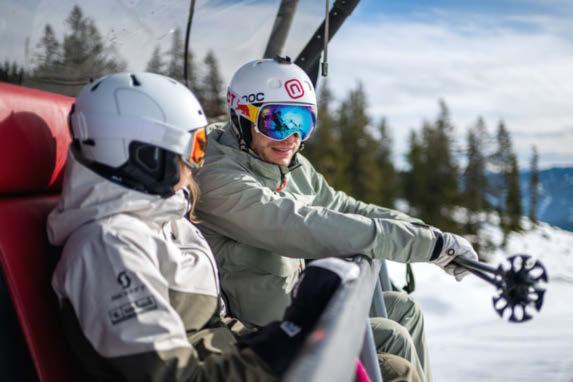
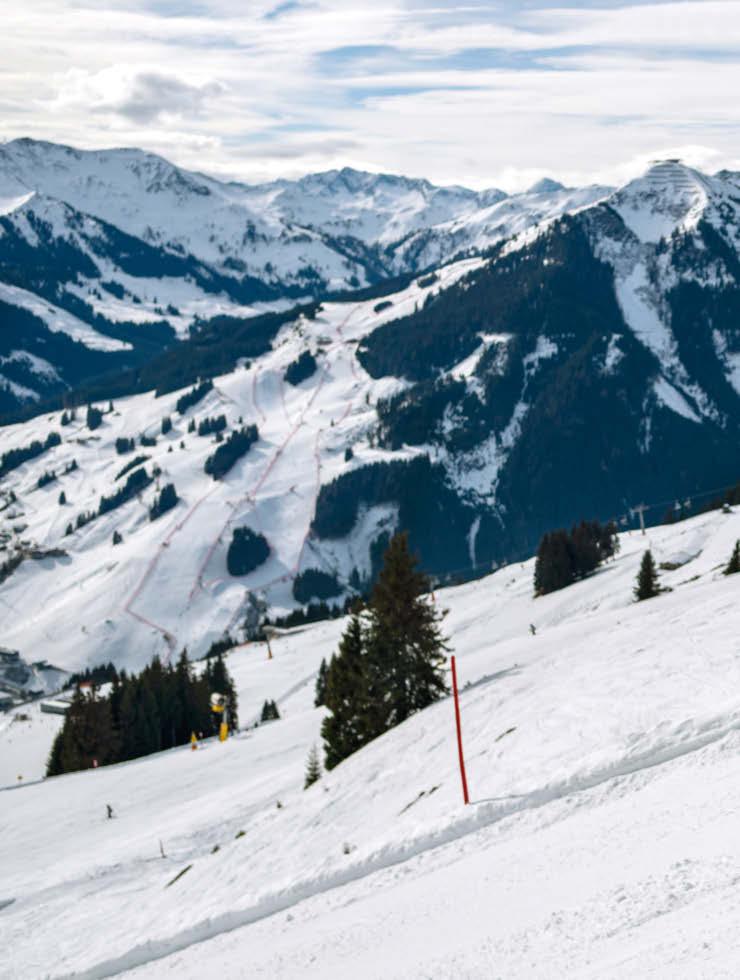
9.55 A.M. Bernie and Elena fly down to Hinterglemm. The Zwölferkogel lies ahead of them – the anticipation grows, you can feel the World Championships in the air!
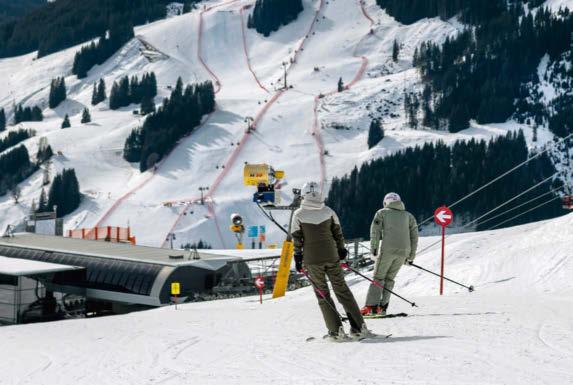
10.00 A.M. On route to the brand-new 12er NORD gondola lift, Bernie and Elena’s destination is in their sights: the World Championship slope.

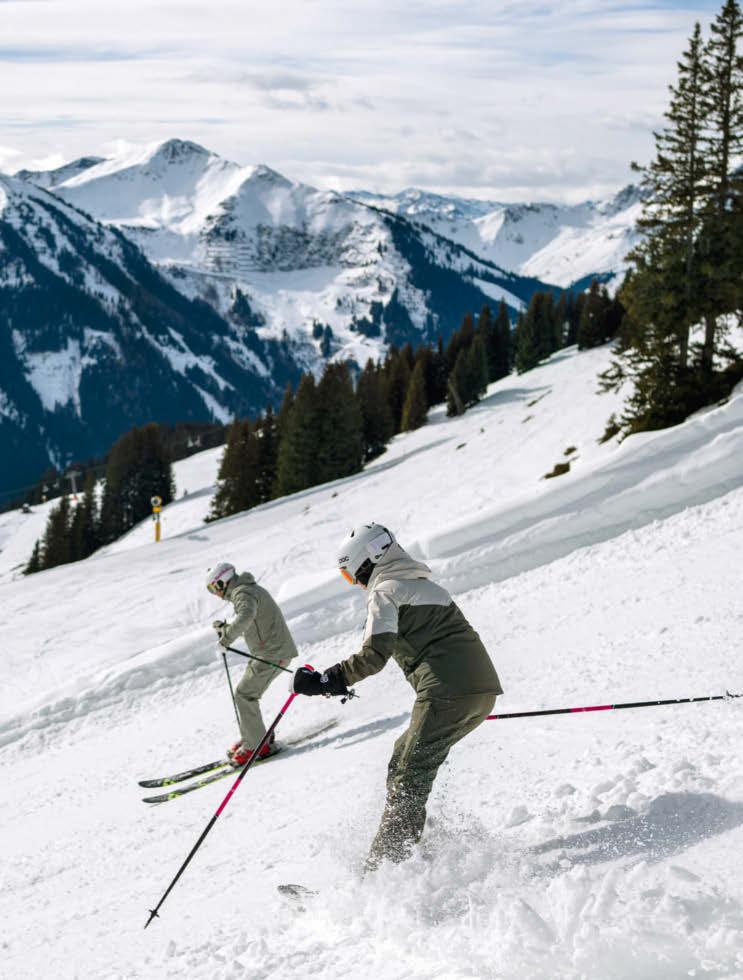

“Travelling to the World Championships on skis felt wonderfully relaxed and was simply fantastic.”
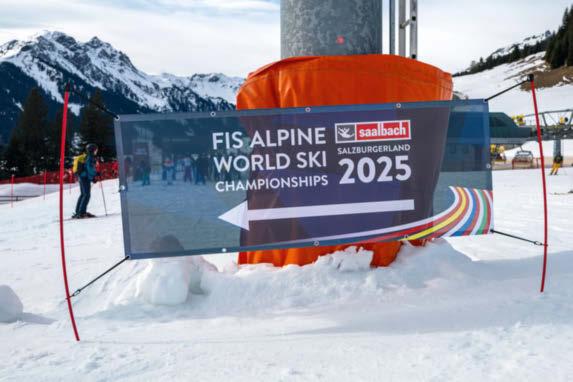
10.18 A.M. At 1,985 metres, the highest point of the day. The 12er
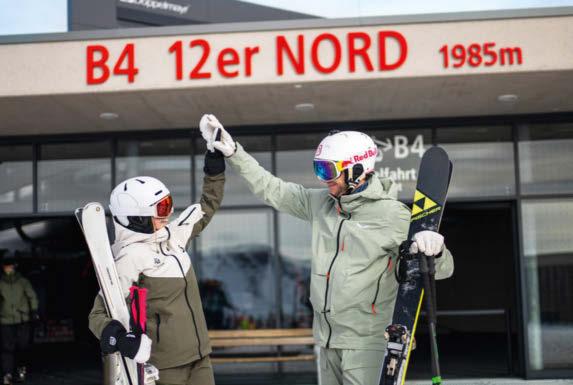
10.20 A.M.
they’ve
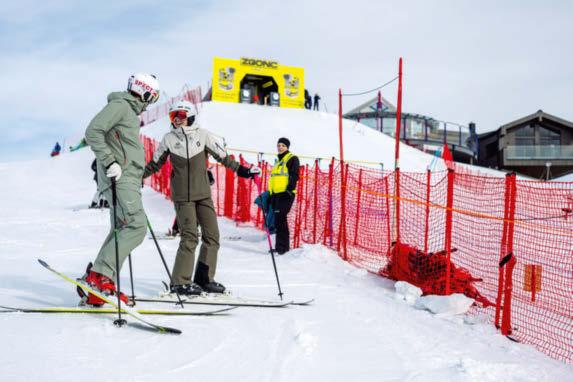
11.15
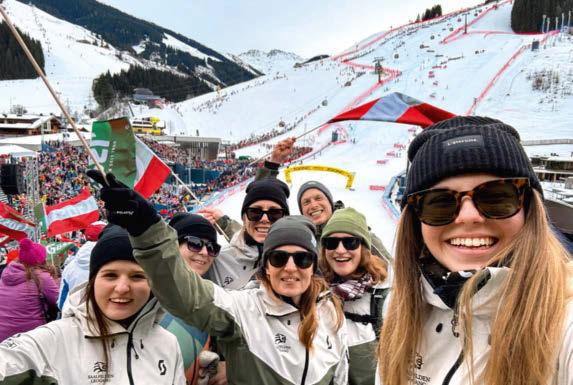
10.03 A.M. Following the arrows. And the noise! Turn left for the World Championship party in Saalbach Hinterglemm.
NORD gondola lift offered Elena and Bernie spectacular views of the Leogang Mountains with the striking Birnhorn.
Bernie and Elena have done it:
travelled on skis from Leogang to the World Ski Championships in Saalbach Hinterglemm!
A.M. Her equipment safely stowed in the ski depot, Elena meets a group of friends in the stands. They jointly celebrate the amazing atmosphere of the World Ski Championships.
ATMOSPHERIC WORLD CHAMPIONSHIPS
The FIS Alpine Ski World Championships 2025 pushed Saalbach Hinterglemm into the global spotlight.
“A GOOD ADVERT FOR SAALBACH”
The World Championships weren’t just an enormous success from a sport perspective. Local businesses were also more than happy with the major event.
PATRICIA HAGASSER
Bakery
“It’s always busy in winter, but even more so during the World Championships. As always, our main customers are the Dutch, who purchase a great deal. They primarily go for the croissants, especially those with chocolate and pistachio. The Germans, on the other hand, prefer to buy wheat-free bread, i. e. they principally go for spelt bread.
There’s a fantastic atmosphere and we even get entire fan clubs coming in. I love when they’re colourfully dressed. You see all sorts of things and I sometimes feel like we’re in New York.
I don’t have time to attend any of the races – but I like to watch them on TV. The investments were defnitely worthwhile. The World Championships help to ensure that the name Saalbach remains well-known throughout the world.”
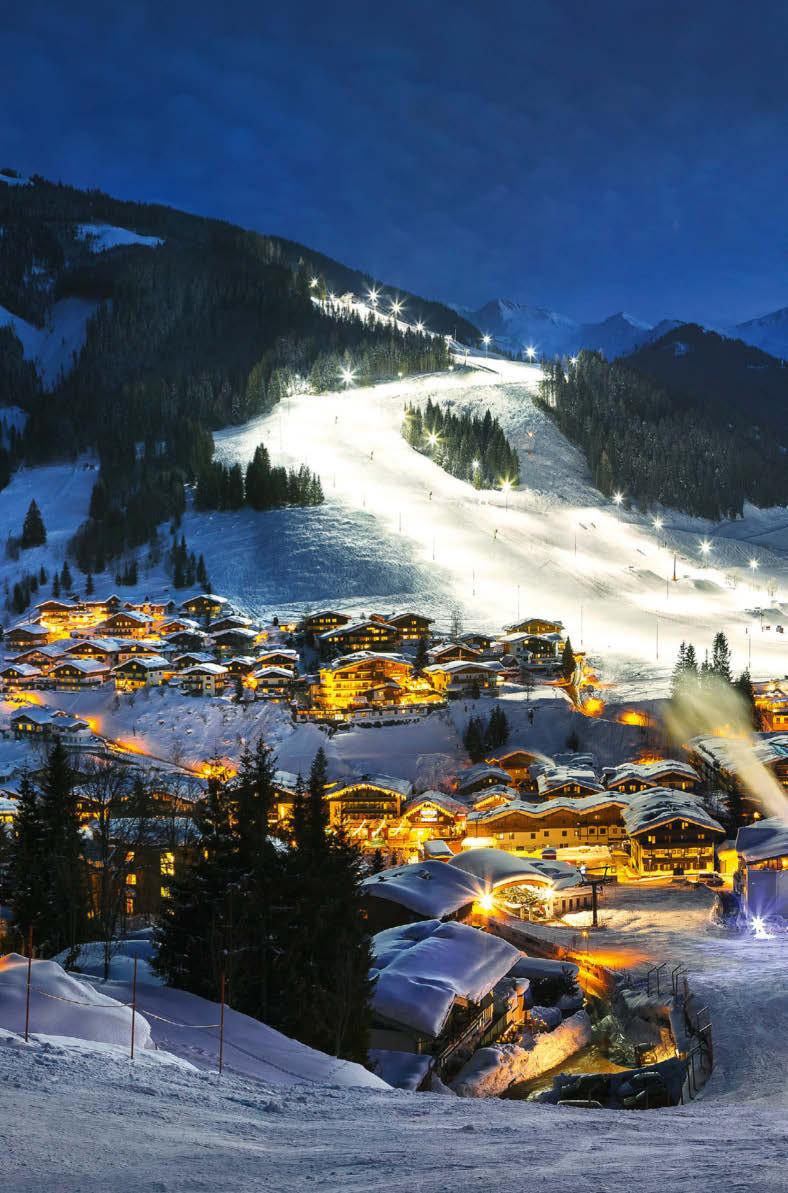
MAJOR DEMAND
Patricia Hagasser is reflected in the display case in the Unterberger bakery and enjoys the World Championships.
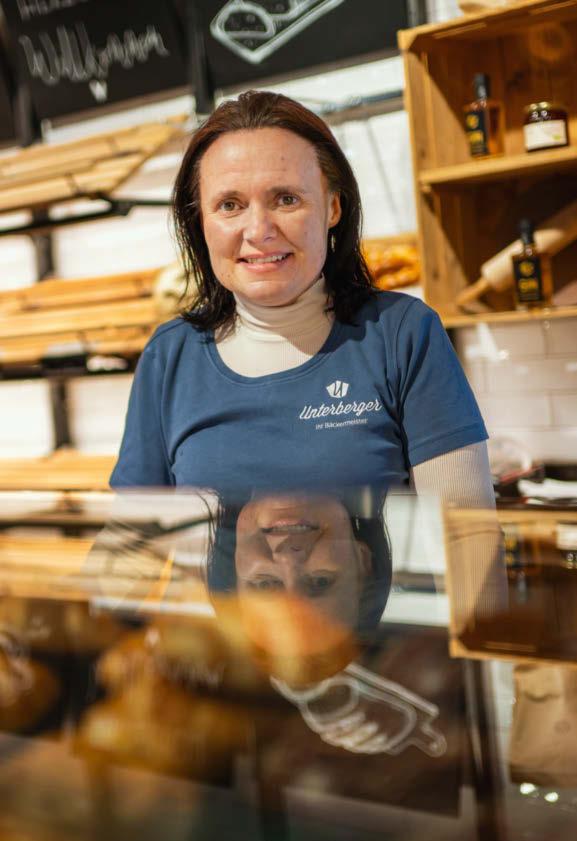
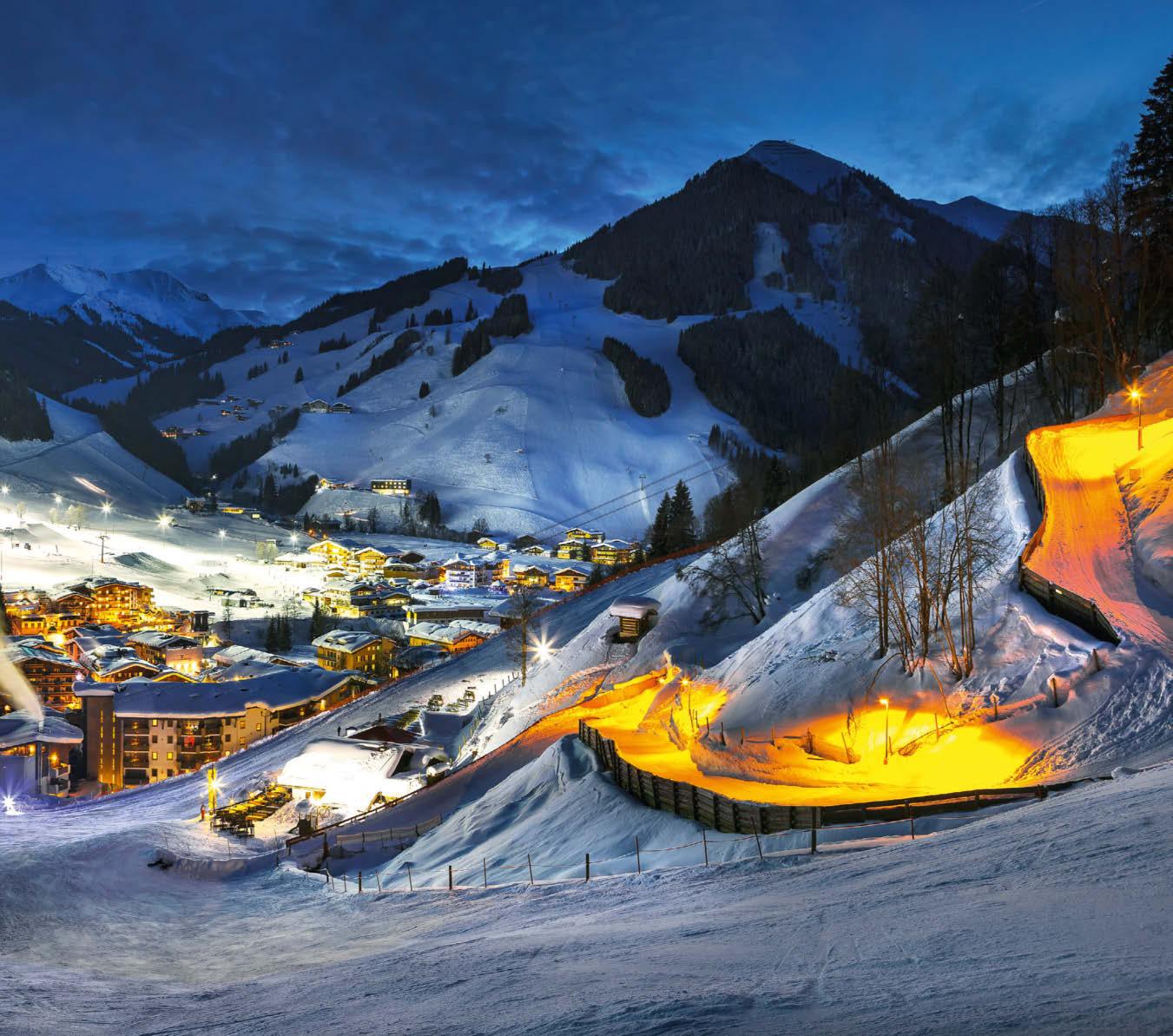
JOHNNY TAFERNER
Ski rental
“Our business is right by the fan mile. There are fewer people renting skis than usual as the hotels that are normally flled with tourists are instead being used to accommodate the athletes – and they naturally don’t hire our equipment. For us, the World Championships are primarily about the sale of smaller items, such as sunglasses, bufs, gloves and caps. Everything people leave lying around and easily lose.
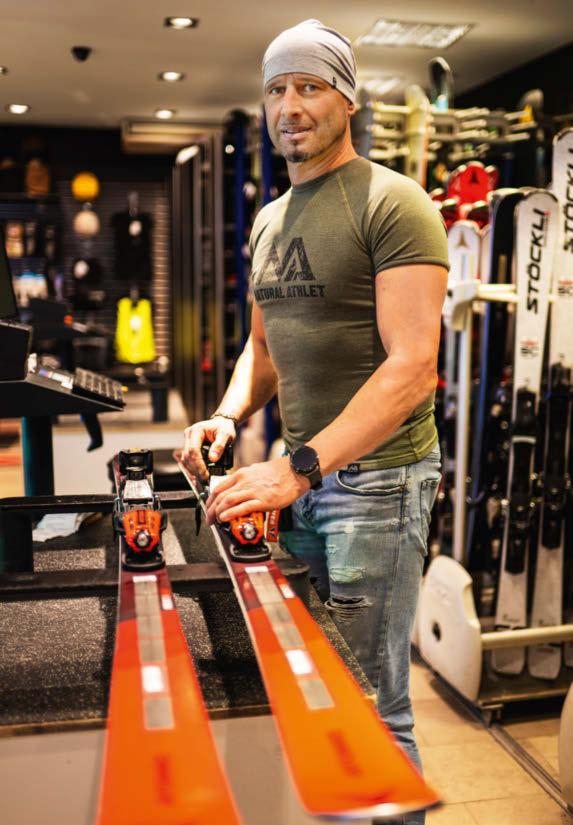
I’m a Hinterglemm native and the fans on the fan mile in front of our window naturally create a great atmosphere. I also fnd the World Championships themselves extremely interesting. Our boss bought us a pass to share among ourselves so that we could each watch one race live. I was at the opening as well as the women’s team competition. The World Championships are a good advert for Saalbach over the long term.”
WORK AND PLEASURE
When Johnny Taferner isn’t preparing skis, he uses his time to watch World Championship races.
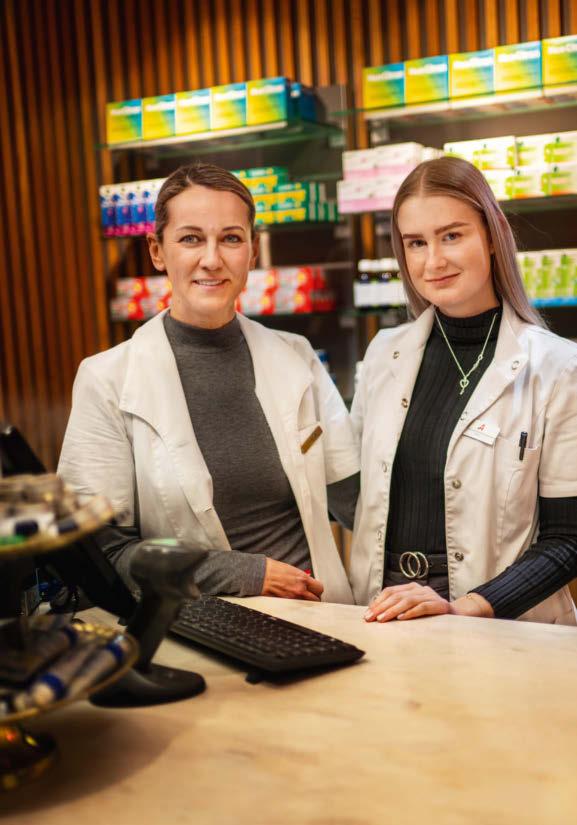
ALWAYS READY TO HELP
Pharmacists Sanela Gligorevic (left) and Selina Schobersteiner know what to prescribe after nights of partying.
SELINA SCHOBERSTEINER AND SANELA GLIGOREVIC
Pharmacy
selina schobersteiner: The World Championships have a positive impact on our business. Headache tablets are particularly popular. But so too is medication for combating excess stomach acid, such as electrolytes and magnesium – everything that helps after long nights of partying.
sanela gligorevic: Hinterglemm is far busier than usual. We normally get lots of visitors from diferent countries in the winter, but now there are more people than ever. Our pharmacy is right on the fan mile, so we experience the atmosphere up close.
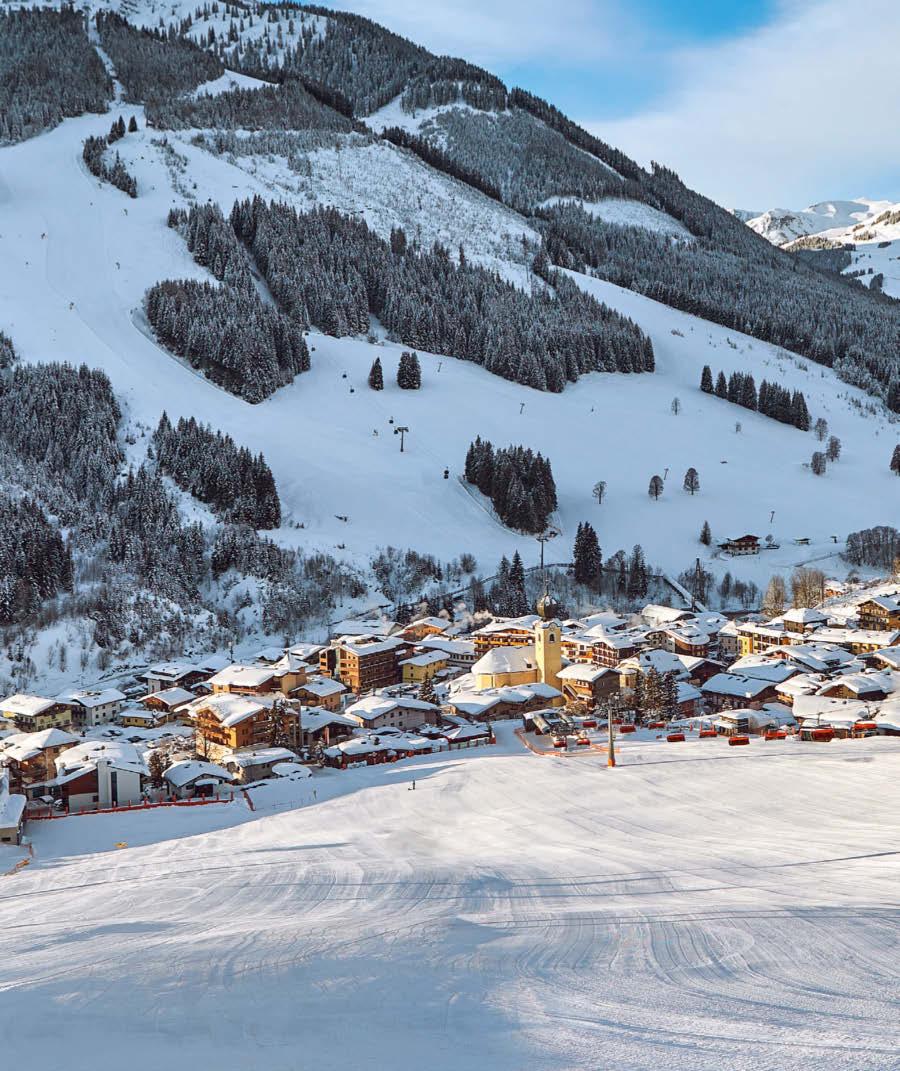
A SPECTACULAR HOST
The World Ski Championships in Saalbach Hinterglemm became the perfect advert for the SalzburgerLand.
“The World Championships are fantastic for Saalbach; the organisation is amazing!”
selina schobersteiner: It’s extremely loud, but that doesn’t bother us; the TV in the ofce in the back is also tuned in to the World Championships. We head out to the course during our lunch break, and if we have a day of, we watch the races.
sanela gligorevic: The World Championships are fantastic for Saalbach; the organisation is amazing!
PERFECTLY PREPARED
Daniela Gritzner in the aisles at the local supermarket. There’s no stress at the checkouts thanks to perfect planning.
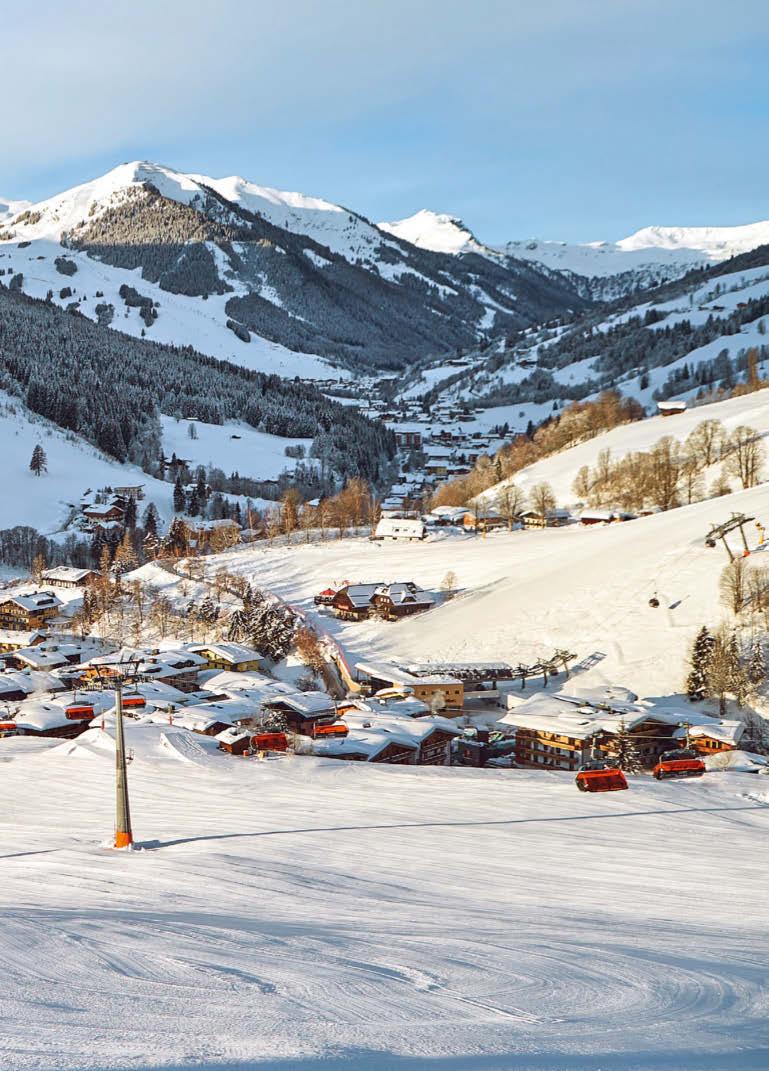
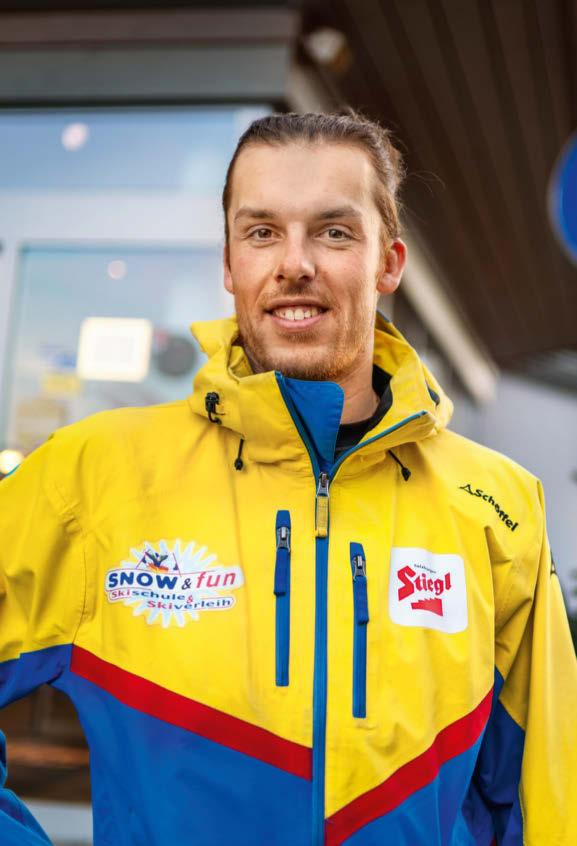
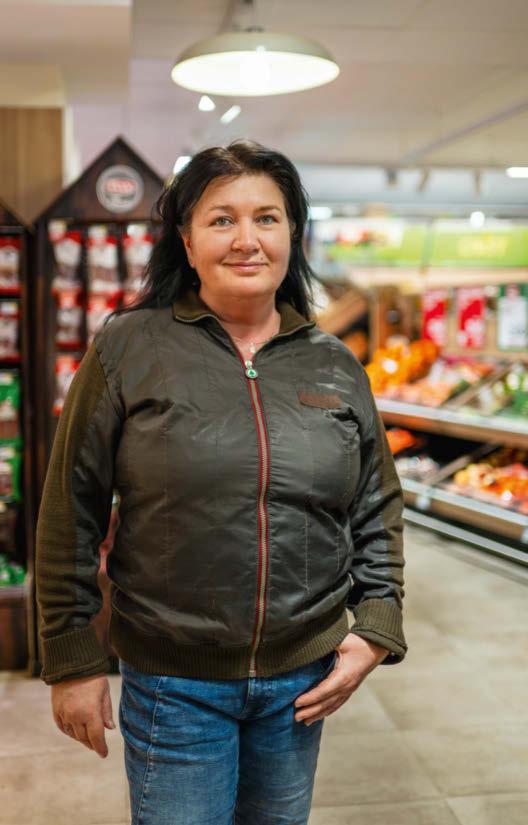
DANIELA GRITZNER
Supermarket
“We get extremely busy. But it’s a diferent kind of shopping to usual. People aren’t doing big shops, they’re buying little things, mainly snacks and drinks. But the queues aren’t any longer than usual as we’ve stafed all four checkouts.
We mainly experience the atmosphere of the World Championships when a wave of happy fans come in. I generally fnd the mood in the town to be excellent. The fans are lovely and we don’t have any difculties. However, there’s also a big police and security staf presence, and that helps keep everyone safe.
I’m not originally from Hinterglemm, I’m from Zell am See, but I think the World Championships are an excellent advert for the entire region. Unfortunately, I don’t have time to watch any of the races myself.”
MOTIVATION
Ski instructor Jaimy Bernards uses the World Championships to admire the professionals – and to learn from them.
JAIMY BERNARDS
Ski school
“I’m Dutch and have been working here at the ski school for ten years. Hinterglemm is actually a small village. It’s nice to see that such a major event can be held on just one mountain. And I love the fact that there’s a party everywhere you turn. And that every time a race fnishes, there’s a crazily good atmosphere. I go out into the street and enjoy the cheering, celebrating crowds as they move along the fan mile. It makes me really happy!
I feel proud that all these ski racers have come to ‘my’ ski resort! I’m a very passionate skier myself, but I fnd it sensational that they are all so close to me here in the town. Every time I get onto the gondola lift on the Zwölferkogel, I hope that one of the stars will sit by me. And even if I don’t meet anyone, the possibility alone is still extremely exciting.
The World Championships ofer us a great deal from a sport perspective! They show that Saalbach isn’t just a party location, but somewhere that’s truly great for skiing.”
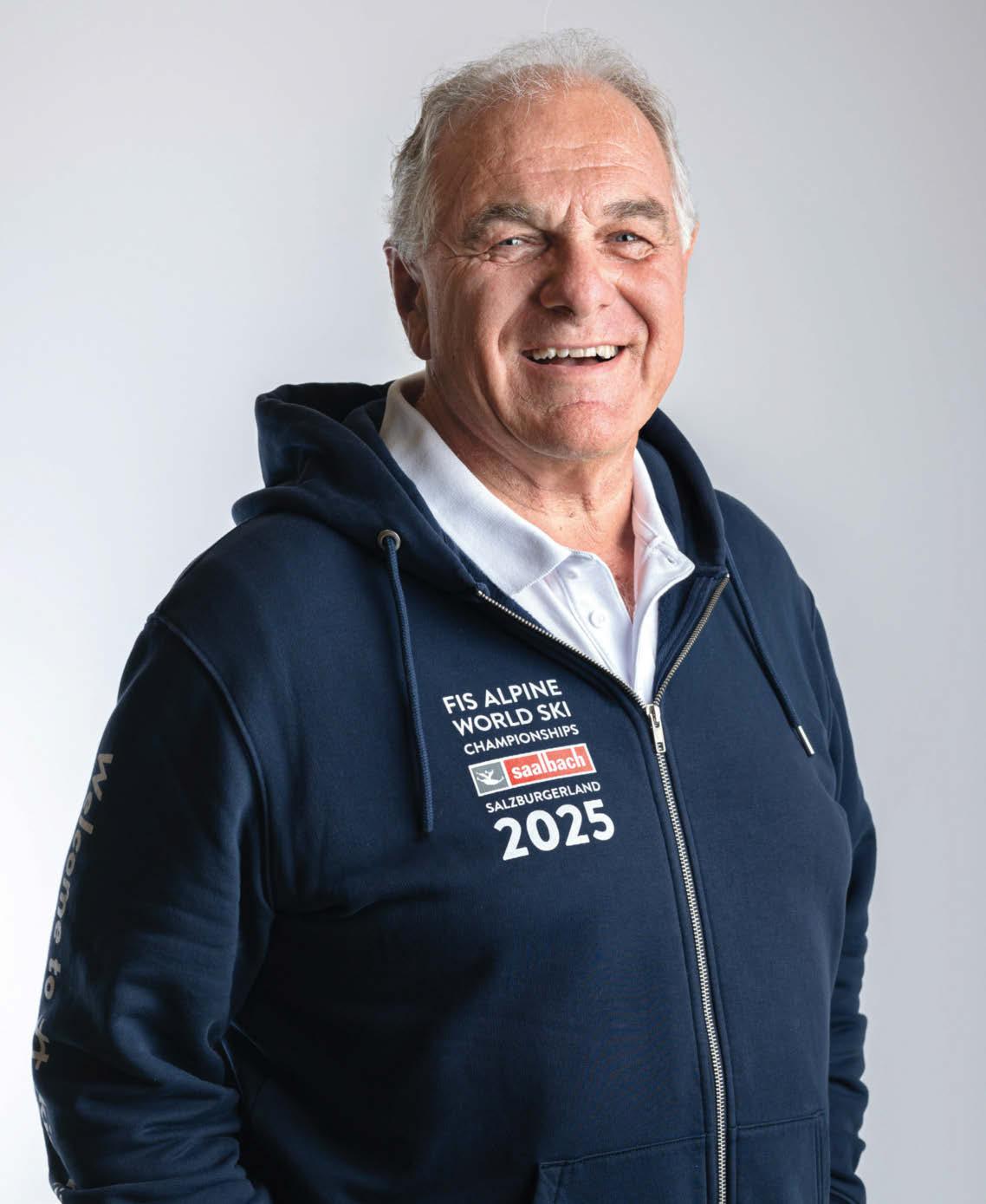
BARTL GENSBICHLER
“SKIING
SHOULD REMAIN SKIING. GENUINE. NOT EXTRAVAGANT.”
Bartl Gensbichler, President of the Salzburg Ski Association and Chair of the Saalbach Hinterglemm ski club, talks about the World Ski Championships on his home mountain, the Zwölferkogel.
ABOUT BARTL Bartl Gensbichler, born on 9 September 1956 in Hinterglemm, became Junior European Champion in the downhill in 1974 and won one World Cup race. He was forced to end his career after a severe knee injury. In 2011, Bartl Gensbichler was elected president of the Salzburg State Ski Association.
Ican still clearly remember. It was autumn 2012 and I was in my car, driving home from my ofce in Salzburg, when I suddenly thought: what if someone else applies to host the World Ski Championships? And then I’d have to go to the mayor, a friend of mine, and say: hey, they did it. Not us.
I couldn’t get the thought out of my head and instantly picked up my phone and called the mayor: “I need you.” We then got the tourism association on board, took a photo, added an application letter, signed everything –and I headed back to Salzburg the very next day. We didn’t need a lengthy meeting. There was no strategy paper. Just a gut feeling: this belongs to us. We’re not letting anyone take it away.
Perhaps you need to have grown up here to understand why it’s so important to us. I was raised in Saalbach Hinterglemm – and, to be honest, we used to be a horrifcally poor valley. There were no spa hotels, no aprèsski. The main focus was just to get through winter. But we’d always had skiing. It had always been something we loved.
I learned to ski just behind the farm – on the slope by our home. I was one of many children. We all had old skis, sawn of and bent, but for us, they were perfect. We’d get in a few runs, then our grandma would come and get us.
At some point, we managed to make it to the Zwölferkogel valley station. My mum was sitting at the ticket ofce – that put an initial halt to things. And at the top, my uncle was waiting for us: “What are you little squirts doing up here? Are you mad?”
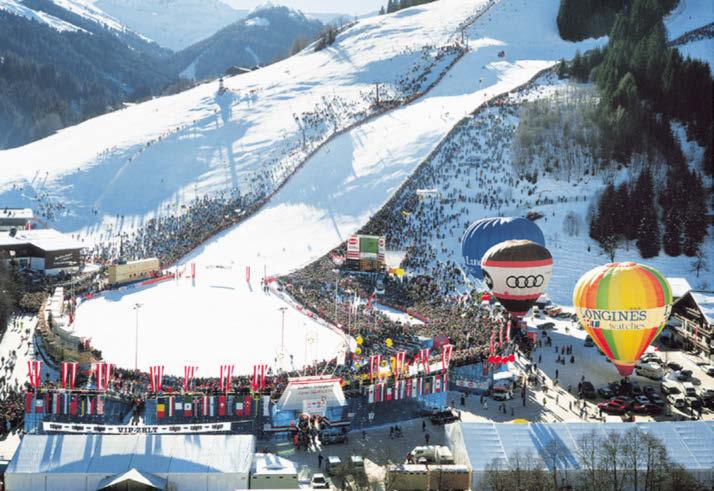
WE’D
ALWAYS HAD SKIING. IT HAD ALWAYS BEEN SOMETHING WE LOVED.
That’s just how it was back then. But that’s also how we learned: we refned our technique on the mogul pistes. You either made it or you got left behind. That shaped us. It was always a bit of a competition: who was faster? Who could do more? That helps you out later in life too.
I then became a ski instructor. Injury put an end to my ski racing (back then, the medical advances weren’t what they are today) but I could still ski. I completed the state ski instructor qualifcation and took over the ski school in Hinterglemm in 1984.
In 1991 I was at the heart of the action – at the frst World Ski Championships in Saalbach. Two weeks of sunshine, minus 15 degrees. Everything went perfectly. The brass band played the national anthem after Rudi Nierlich’s victory – and the moment its members left the stage, it began to snow. You don’t forget something like that.
These World Championships, 34 years ago, legendarily known as the Sunny World Championships, changed Saalbach. Previously, people were aware of us – afterwards, they booked to come here. Investments were made, the cable cars were upgraded and we kept going. The World Ski Championships bring things full circle for me. From being a young lad, enjoying my frst experiences of skiing behind my house, to today, where I can say: that was my project.
I kicked it all of because I felt that if we didn’t do it, someone else would.
The result proved that we were in the right: the World Ski Championships were the most relaxed ever. Everything on one mountain, short distances, no cars. You only need your car once in Saalbach – to get here. After that, you’re in the midst of everything: fans, races, athletes –you encounter them all. Perhaps over breakfast. Or in the evening on the fan mile.
That’s what’s special about the skiing that we see here in Saalbach Hinterglemm. You’re up close to it. You can watch the races live and use a lift pass to get to the course – from the start to the fnish. And once you’ve seen enough, you can enjoy a bit of skiing for yourself. Where else would that be possible?
We naturally party too. That goes without saying. But we’re careful not to become the party capital of the Alps. Skiing should remain skiing. Genuine. Not extravagant. I believe we achieve that. Because we haven’t lost tradition – we simply combine it with modernity.
Saalbach Hinterglemm was never perfect. But we’ve earned the right to have the world come here. Because we’ve built something. Something good.
A photo from 1991, the year in which the event went down in history as the ‘Sunny World Championships’.
FUTURE HEROES
The World Ski Championships are about far more than just medals. They are where the role models for the next generations are formed!
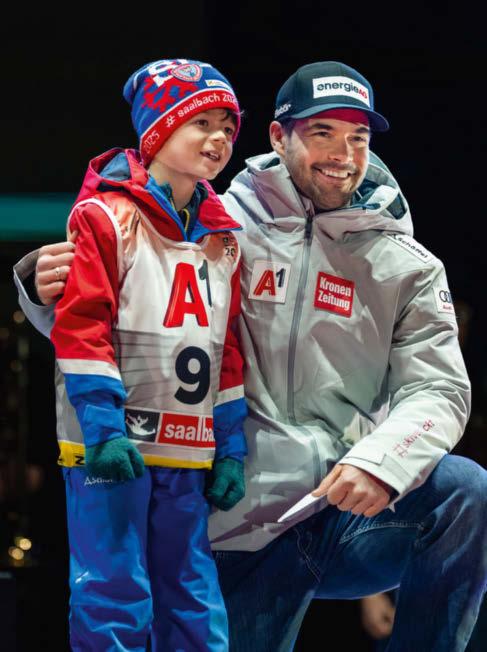
“THE STARS WERE SIMPLY LOVELY!”
Children from the local ski clubs got up close to their role models. The World Championships showed them that they too could potentially have a career in skiing.
Michael Walchhofer, Salzburg native and downhill World Champion from 2003, still has a clear memory of standing in the midst of the spectators at the 1991 World Championships in Saalbach as a teenager and enjoying the atmosphere of the women’s super-G: “It was so cool seeing the best of the best in action. My biggest wish was to be on the start line at such an amazing event some day.”
The now equally successful hotelier explains that these kinds of major events generally provide huge motivation to up-and-coming athletes: “Heroes are born at World Championships, and thus role models for the next generation. For me in 1991, that was defnitely Rudi Nierlich, who truly inspired me!”
LUCKY CHARM
Maximilian from SC Saalbach Hinterglemm brings Vincent Kriechmayr bib number 9. The next day, the Austrian grins on the winner’s podium after winning silver in the downhill.

A FORWARD-LOOKING COACH

Birgit Maier trains forty children, including her own two. She says that the direct contact with the pros has shown them where their own path could lead.
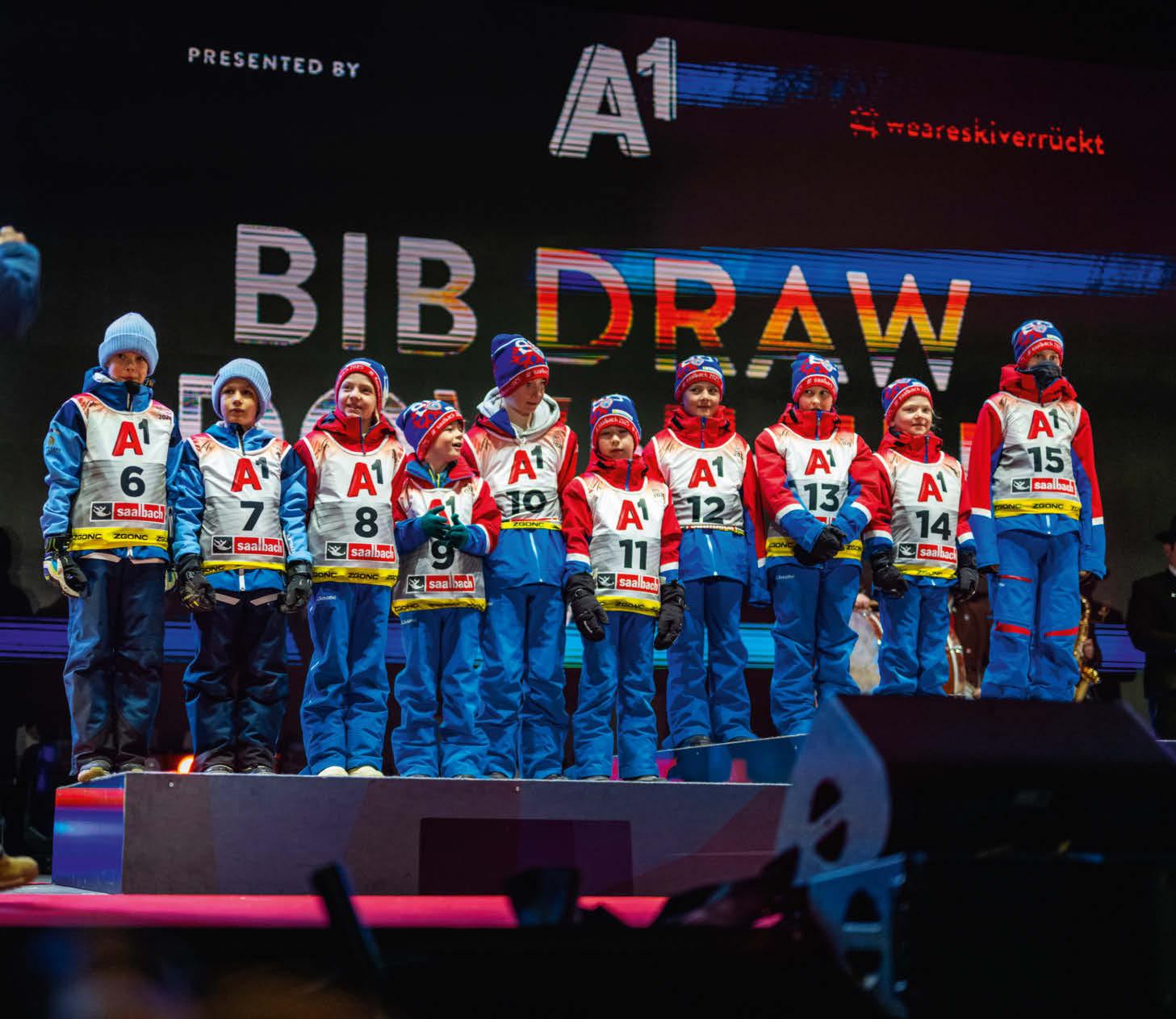
According to Birgit Maier, there were plenty of sparkling eyes at the World Ski Championships 2025 too. Birgit, who was born in Vorarlberg but has lived in Viehhofen since 2012, is the mother of two children who are both crazy about skiing. She coaches a group of 40 young girls and boys born between 2013 and 2017 at the Saalbach Hinterglemm ski club (SC Saalbach Hinterglemm) – in a training cooperative with SC Viehhofen: “It goes without saying that these World Championships have an impact on the kids! Even at the World Cup fnal last year, we saw how motivated they were. They spent the entire summer incredibly excited about all of these stars coming to us during the World Championships.”
After all, Stef Venier, Marco Odermatt and co. are naturally major role models for the area’s up-and-coming young skiers: “The children were directly involved in the World Championships. Before the season began, they created videos with the fags of all the participating nations. At the opening ceremony, they were then able
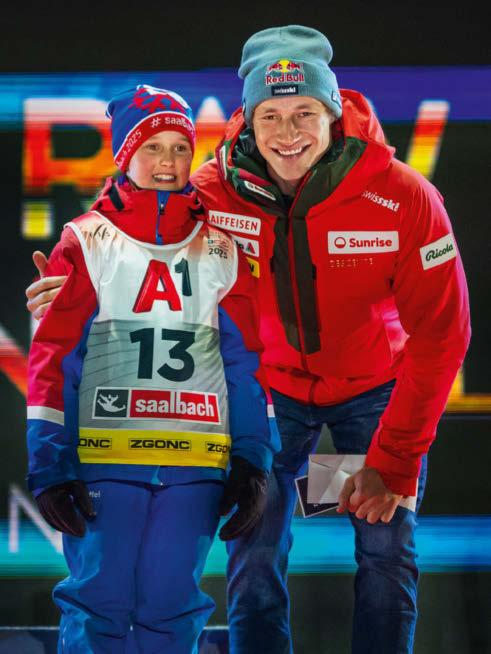
CLOSE CONTACT WITH THE STARS
Marco Odermatt places his arm around young Lena on the stage. Both enjoy the relaxed atmosphere on the medal plaza.
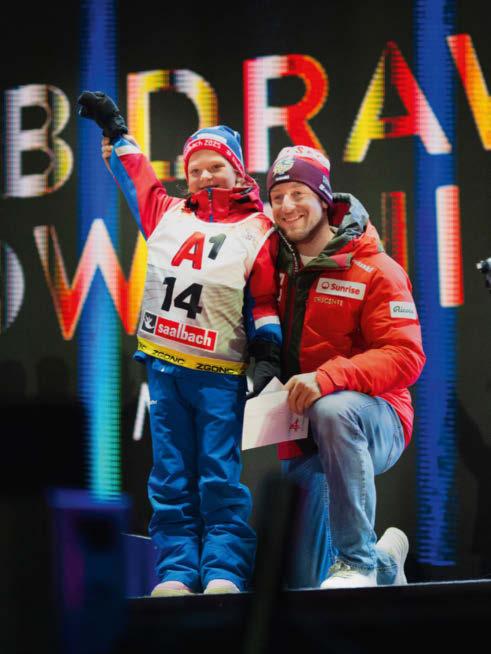
to walk into the stadium with the fags to the cheers of the fans.” During the bib number draws, they even had the opportunity to take to the stage individually with the famous ski racers! “It was extremely exciting for them to get so close to their role models”, commented Birgit Maier. “The stars themselves were simply lovely. They signed autographs and posed for lots of souvenir photos.”
During the World Championships, the young skiers from SC Saalbach Hinterglemm deviated to the Bergfriedlift for their two weekly training sessions – and with great motivation, as Birgit Maier proudly reported. They gladly conceded their usual slope by the Mitteregglift to the professionals for their preparations for the slalom and giant slalom races: “We regularly watched the stars. It was really exciting for the children to see how hard the ski racers train. And they got an idea of where their own path could take them one day. They know that they’ve still got a long way to go. But they also know that they could potentially enjoy a career in skiing.”
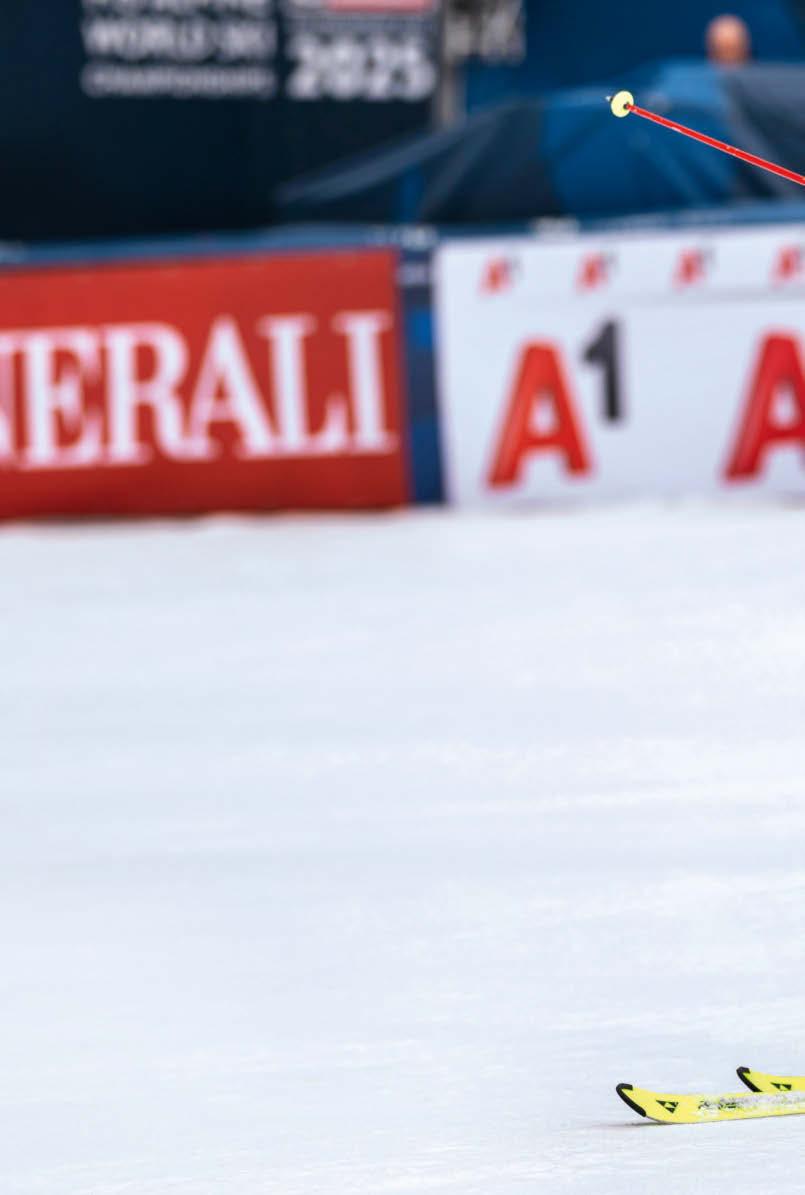
“I CAN BUILD ON THE WORLD CHAMPS!”
At the World Championships, Thomas Rainer from Leogang acted as a forerunner three times. The men’s giant slalom particularly motivated him with regard to the future of his career.
“It was exciting for the children to see how hard the ski racers train.”
Thomas Rainer’s journey to the World Championships was both short and relaxed. “I slept at home in Leogang then drove over to Hinterglemm nice and early in the morning and used the car park by the 12er NORD gondola lift.” With the cool demeanour of an old hand, the 21yearold from the SalzburgerLand, related his experience of Friday, 14 February 2025: the upandcoming technical skier had the honour of gliding down the perfectly groomed piste as one of three forerunners at the men’s giant slalom: “I really enjoyed the atmosphere. It motivated me to work even harder so I can one day be an actual competitor on a World Championship course!”
WHO IS THE STAR HERE?
Rosali waves to the spectators; Switzerland’s Justin Murisier is an idol who treats her at eye level.
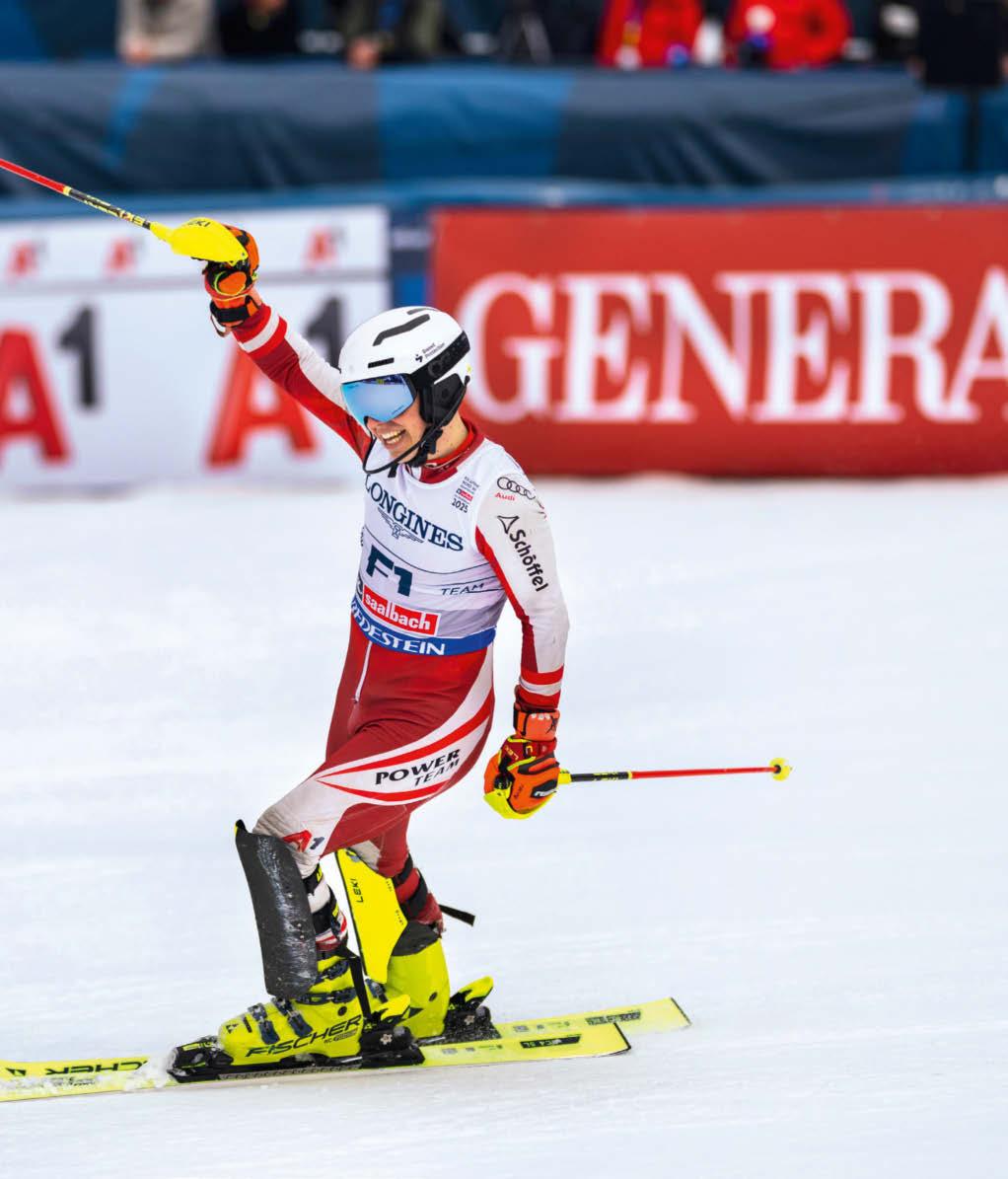
CELEBRATING LIKE A STAR
Thomas Rainer crosses the line and enjoys the applause: “The World Championships made my passion for skiing stronger than ever.”
Recently, the graduate from the ski school in the neighbouring town of Saalfelden wasn’t part of an Austrian Ski Association team and had to self fnance the World Championship season with the help of his family. Thanks to victories in the giant slalom at the Hungarian and Czech National Championships, however, he was able to qualify for the Europa Cup and therefore for higher-level competitions. Despite this, nothing compares with World Championships like these. Not even the World Cup fnal 2024 in Saalbach, where Thomas Rainer was also able to gain experience as a forerunner: “Everything was much bigger, much more professional. Even the fact that your run is broadcast on TV is special.”
Following the course inspection, Thomas Rainer joined all the stars of the day as they headed to the women’s downhill course and enjoyed one last drink in the team hospitality area at the middle station: “I was naturally focused on my start and didn’t really look at what the others were doing.
ENJOYING THE FURORE
As a forerunner, Thomas Rainer experienced the races from as close up as you can get – in the finish area!
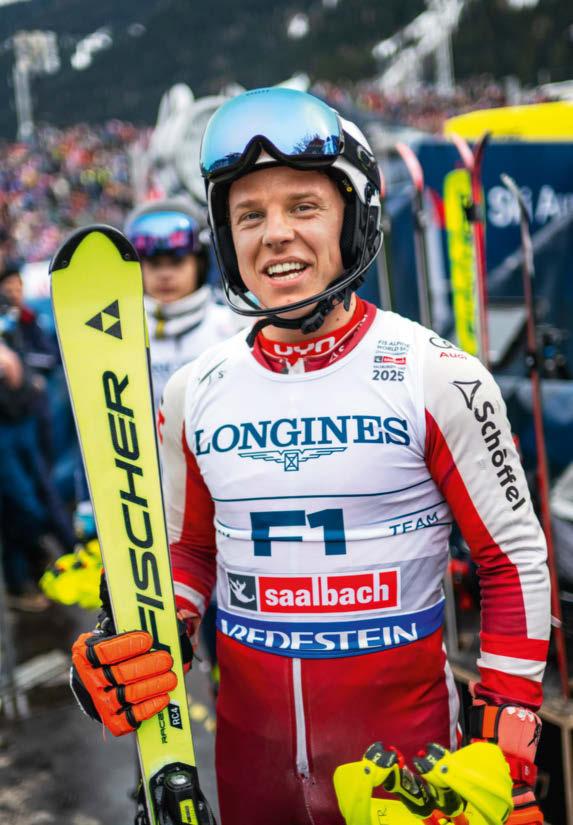
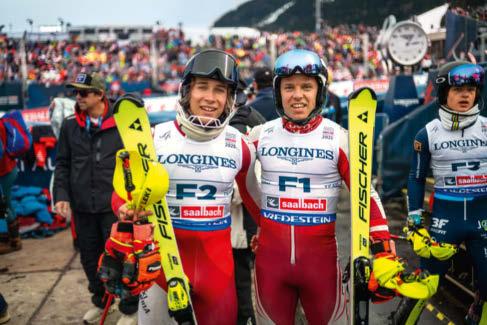
NEXT GENERATION
Over the line: Thomas Rainer (right) and Lukas Gasser from SC Bruck (left) acted as forerunners for both the women’s and the men’s team combined.
But I picked up on the fact that Raf Haaser seemed pretty relaxed. Almost as if he had nothing to lose …”
With this relaxed demeanour, Raphael Haaser carved his way to the title of World Champion. And Thomas Rainer delightedly joined in the celebrations at the fnish: “I was only 1.5 seconds slower than him on the second run. The gap between me and the world’s elite isn’t as big as I thought. I can defnitely build on that.”
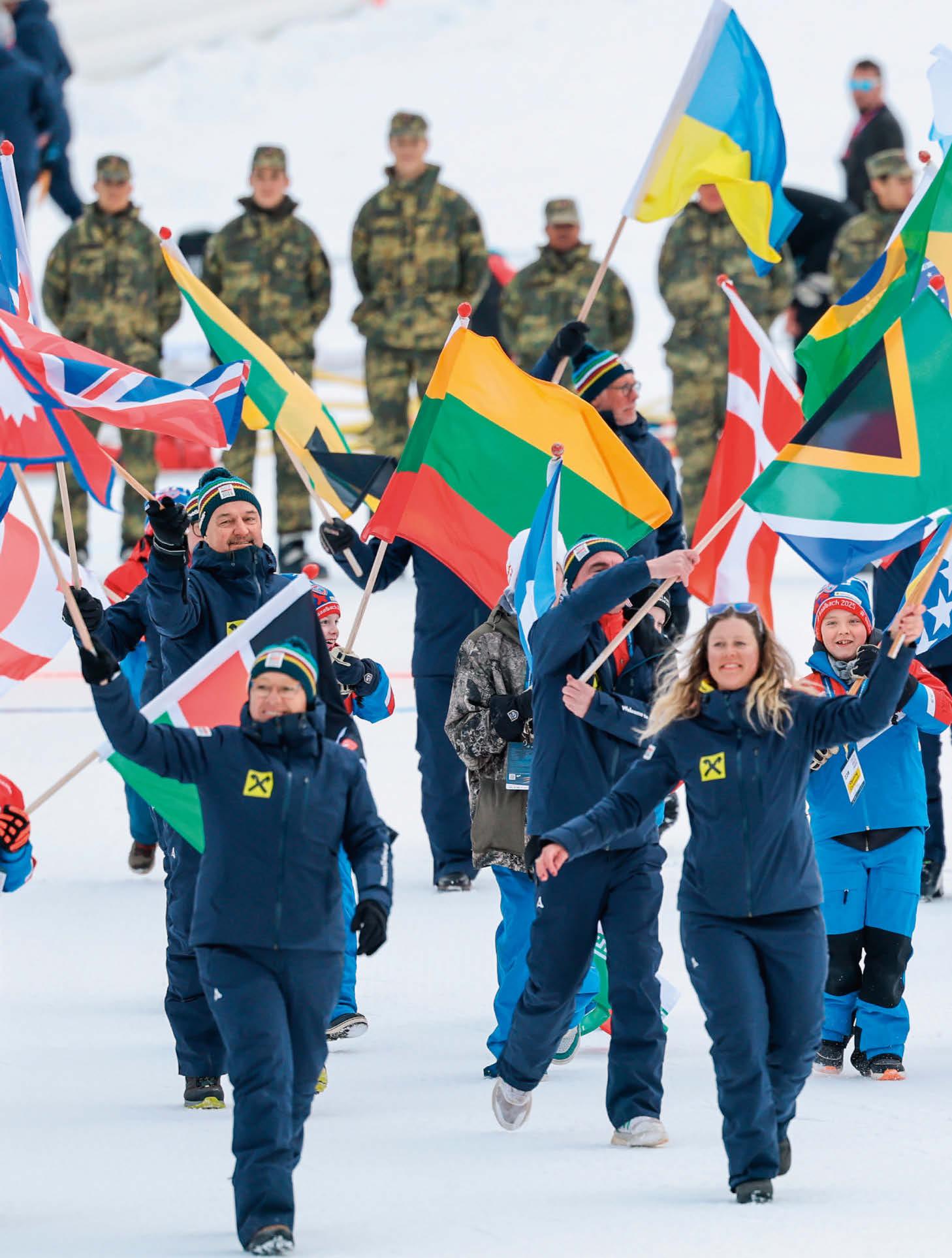
When the colourful flags fly
A photo of the closing ceremony, with smiling faces everywhere.
FINISH
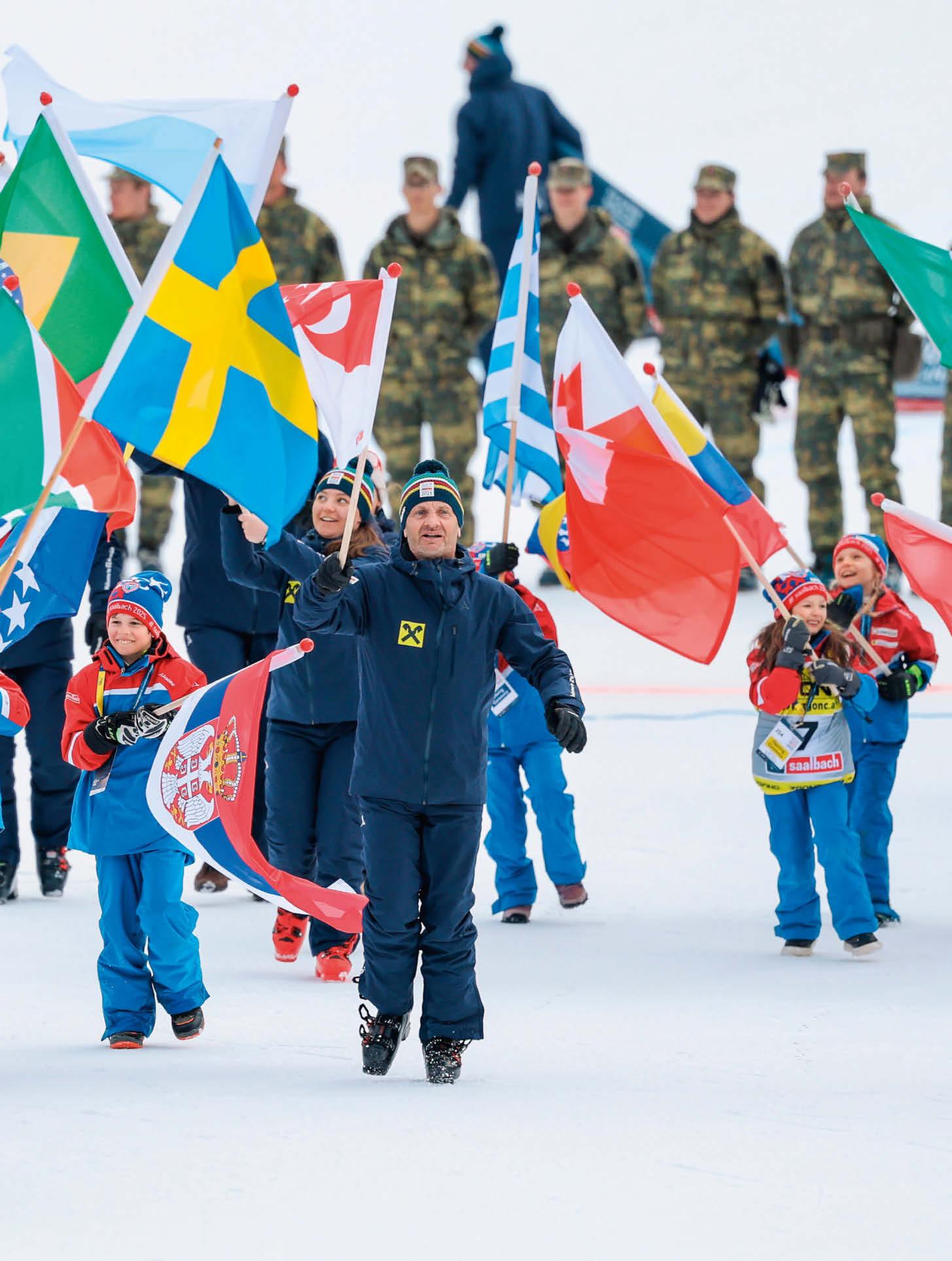
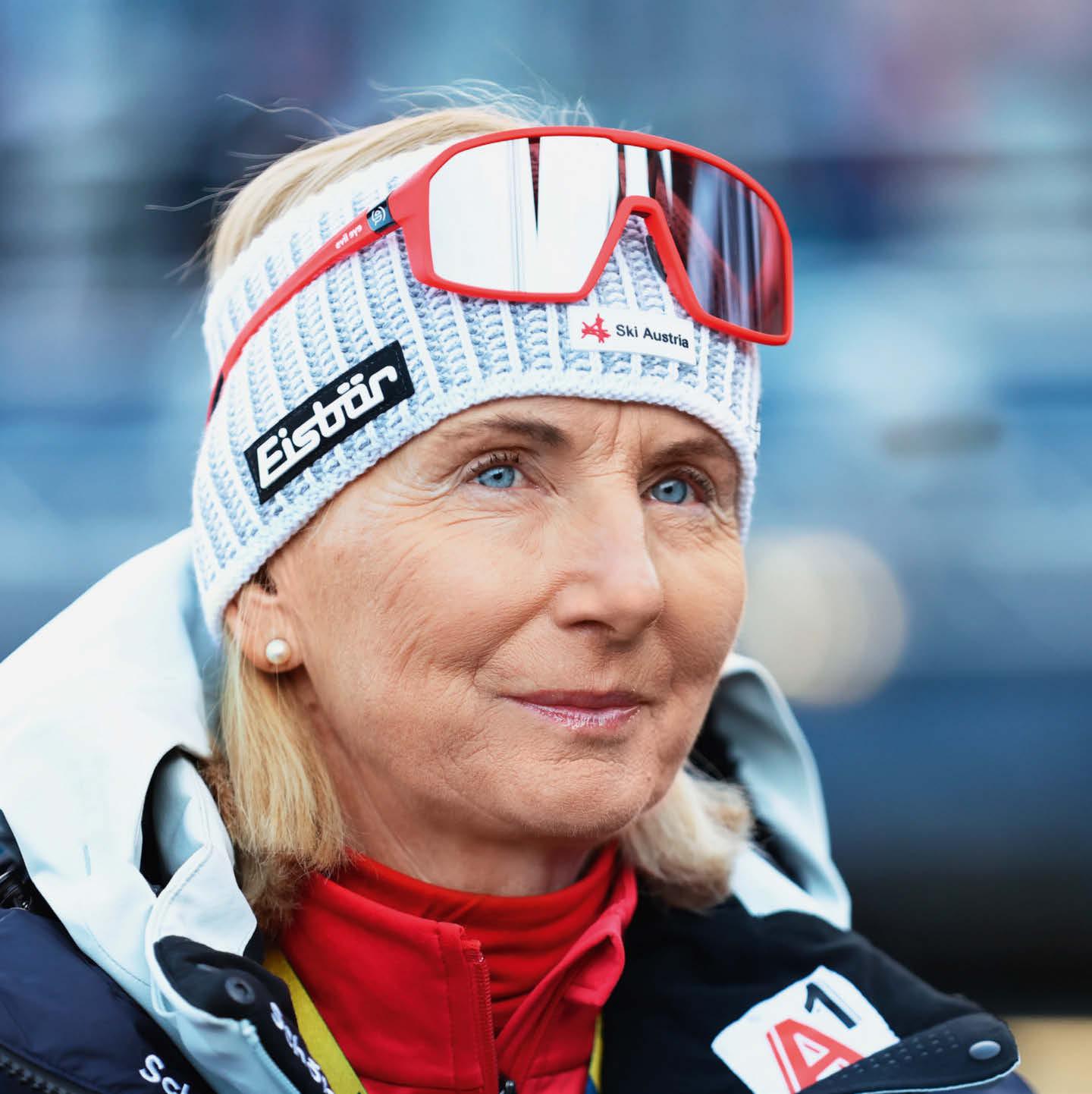
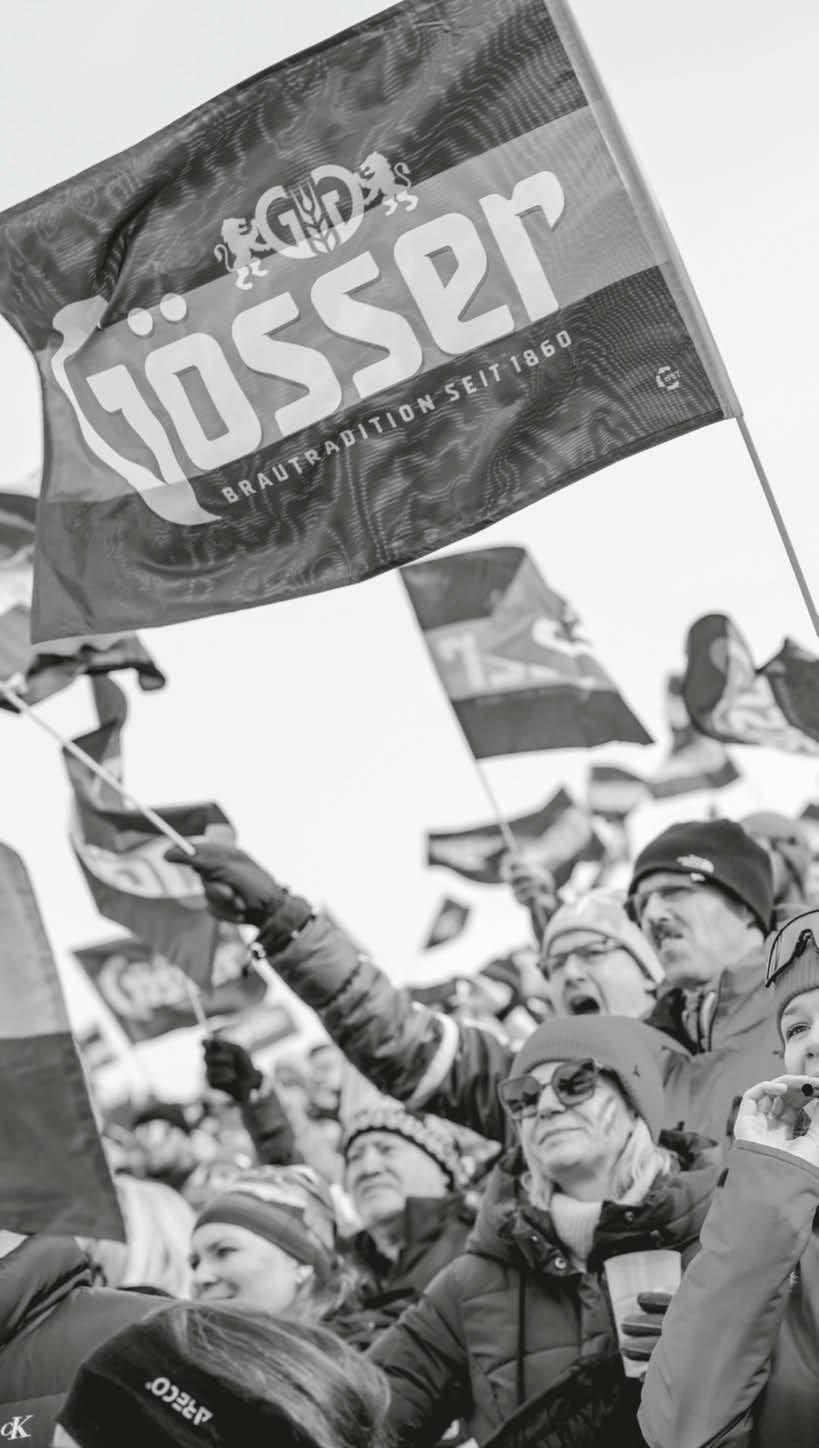
Roswitha Stadlober at the World Ski Championships in Saalbach
“IT’S IMPORTANT TO ME THAT SPORT IS FINALLY PERCEIVED AS A FORM OF EDUCATION”
Roswitha Stadlober on her slalom victories, family life in the world of skiing, her position as President of the Austrian Ski Association (ÖSV) – and why exercise is equally as important for children as maths.
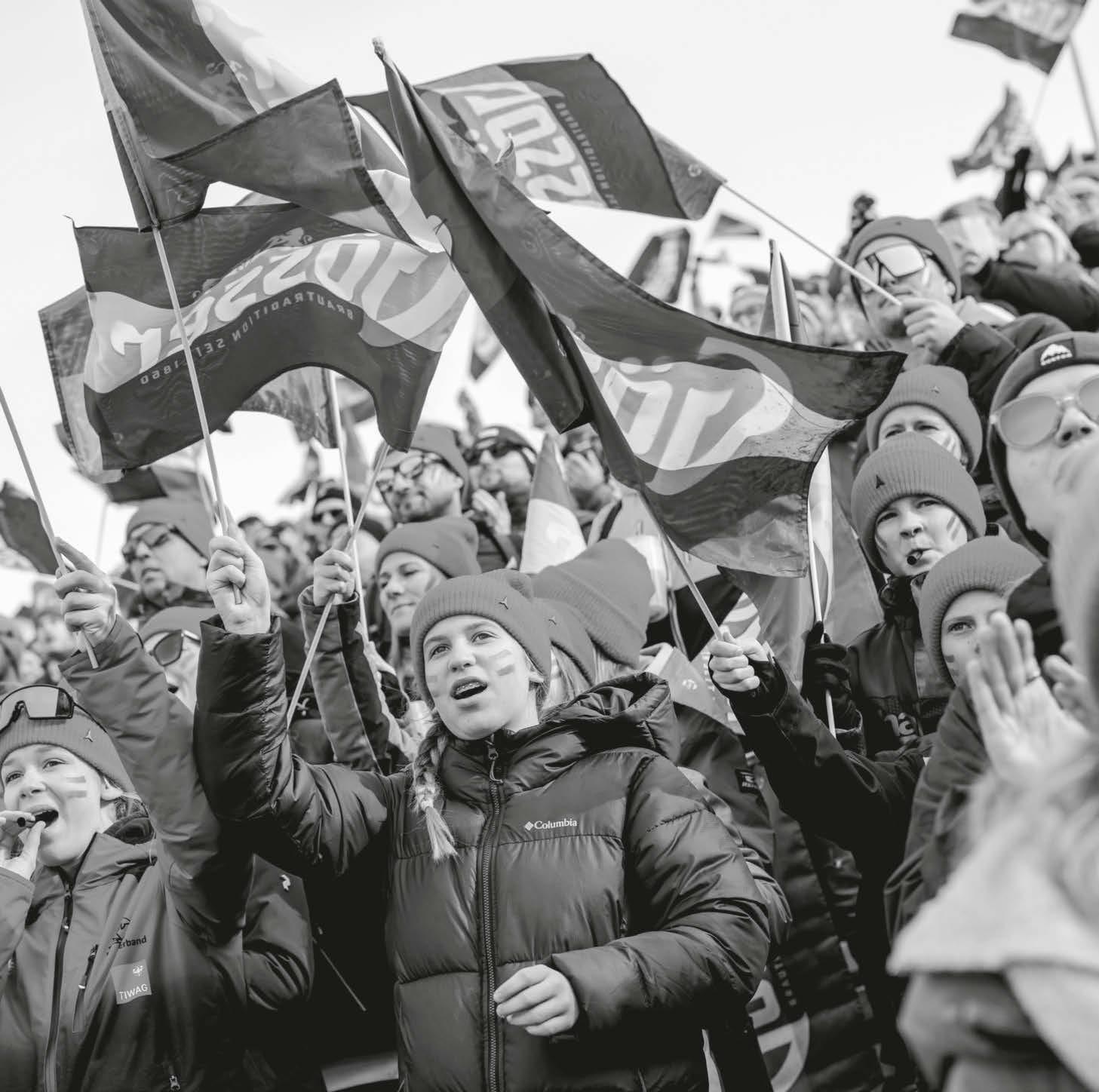
When Roswitha Stadlober talks about her childhood, you can almost see her in front of you: a girl with skis on her feet, climbing straight onto the T-bar lift from her parents’ house. “My dad worked there. I simply skied down to him.”
Today she is President of the Austrian Ski Association – as the frst woman to hold this position. Between these times came World Cup victories, a career that ended early – and a life that has always somehow involved skiing. “I always wanted to experience the other life too”, she comments.
Skiing has remained part of this. In her family life, her voluntary work and her position of power. And with the home World Championships in Saalbach, she’s back where it all began: surrounded by snow.
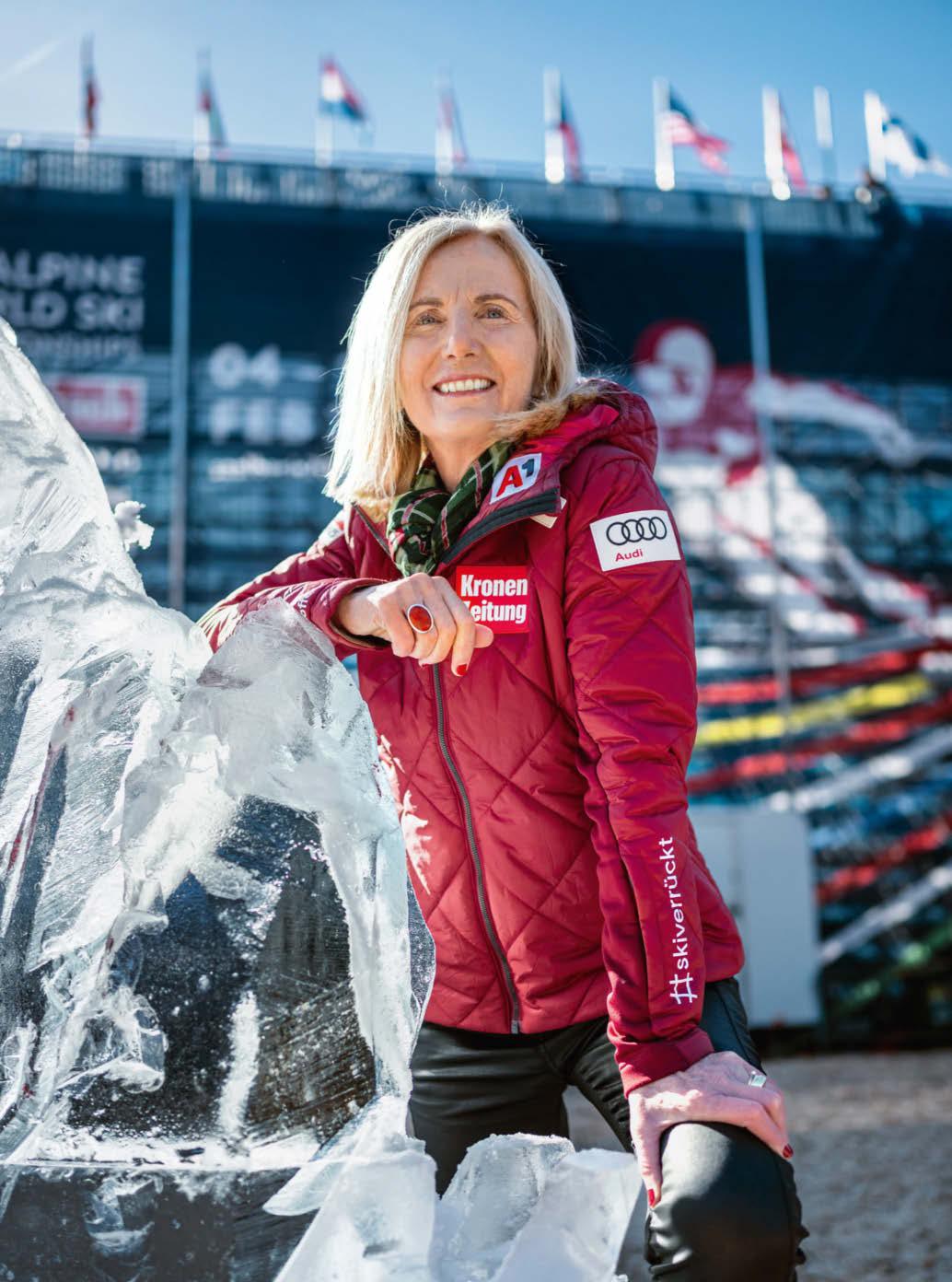
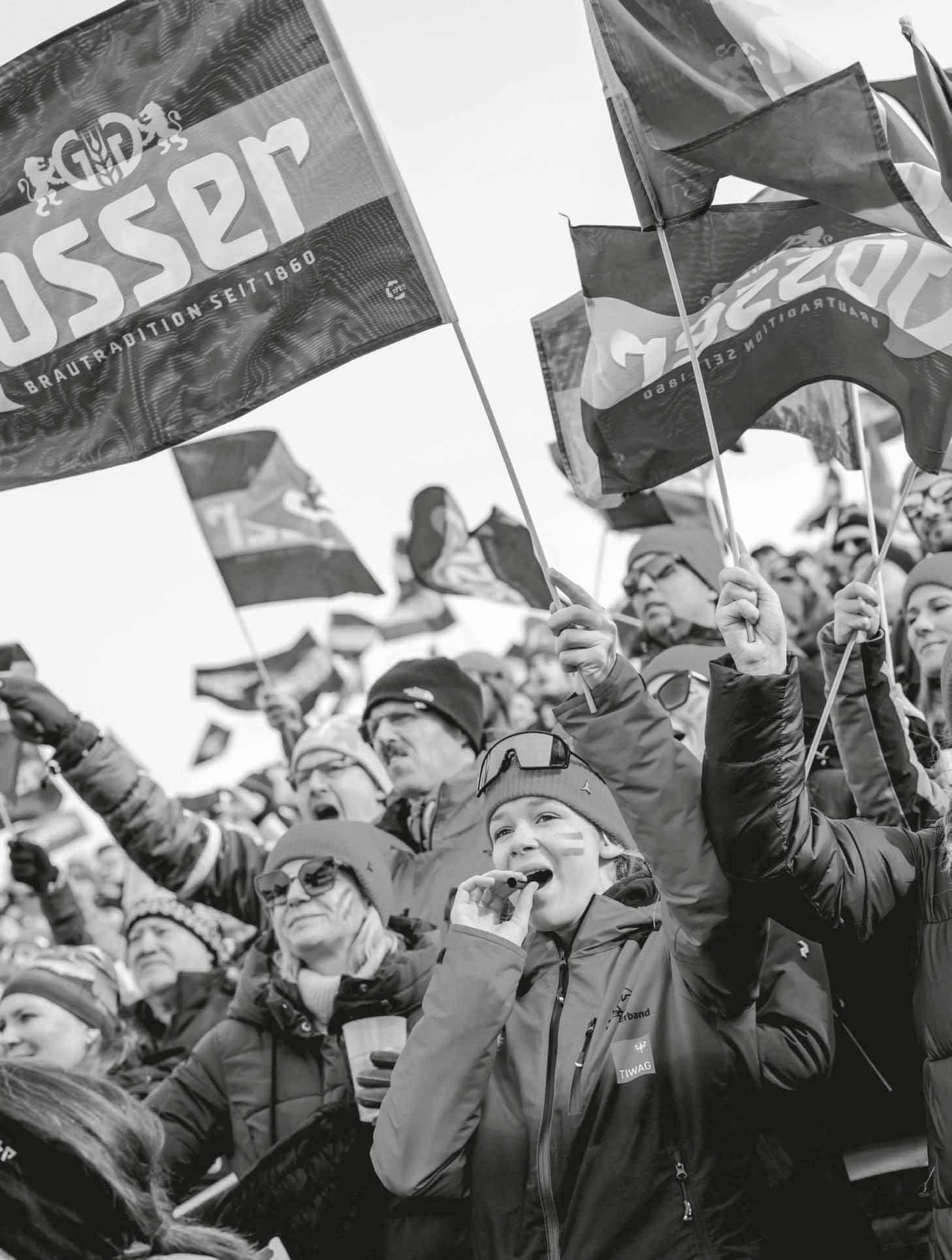
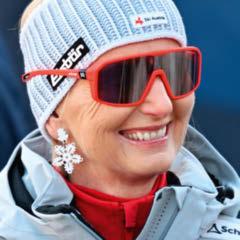
“IT’S GREAT WHEN CHILDREN FIND THE PATH THEY WANT TO FOLLOW. BUT I WAS ALSO AWARE OF HOW HARD THIS PATH IS.”
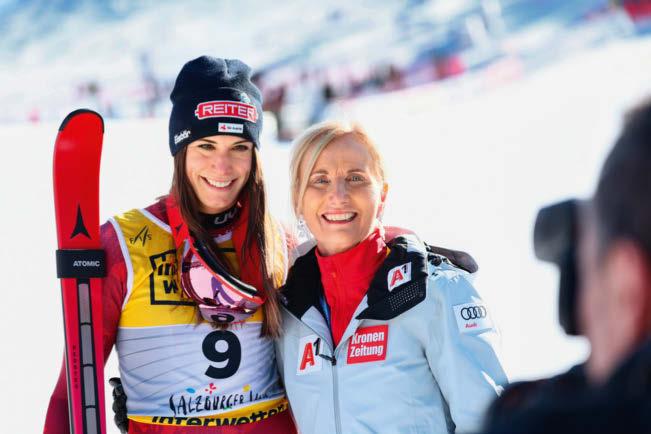
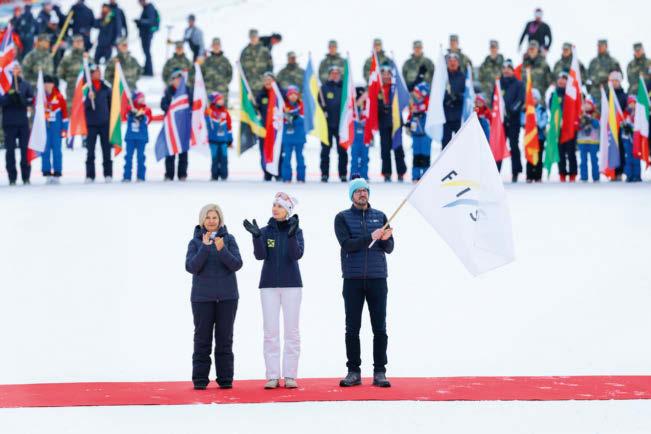
Let’s start by turning back the clock to the 1980s when you celebrated eight World Cup victories in the slalom and won the slalom discipline classifcation twice: what do those victories mean to you?
roswitha stadlober: It’s hard to say because that was so long ago and so much has happened since. With eight victories, I led this ranking for a long time in Austria – until Marlies Schild, who won 35 slaloms, passed me by. It was a great time, but I don’t particularly grasp onto it. The frst and last World Cup victories were the best for me.
Do you still have the crystal globes at home?
Yes, they’re in our house. I dusted them only yesterday. When doing so, I asked myself: what will happen when I’m no longer here? Will my children still keep them? But yes – I’ve still got my most beautiful trophies on display.
You and your husband, cross-country skiing World Champion Alois Stadlober, have two extremely sporty children, Luis and Teresa. Did your achievements push them into competitive sport?
Not at all. It was simply important to us that they had an active upbringing. Exercise is just part of that. We let them try everything – in both summer and winter.
Roswitha Stadlober with Mirjam Puchner, who took silver in the downhill (left), and at the closing ceremony (below).
Ultimately, winter sports won through, but it wasn’t instantly clear that they’d become top-level athletes in cross-country skiing. That only came with time.
When did you realise that your children were serious about sport?
When they started to set themselves goals – even when it was exhausting.
What was that like for you as a mother? Lovely or difcult?
Both. It’s great when children fnd the path they want to follow. But I was also aware how hard this path is –with setbacks, pressure and sacrifces.
Did your own career as a top athlete help you?
Yes, sometimes. I understood how to deal with pressure or that failure was part of the process. But I intentionally tried to take a step back. It’s their path.
You grew up in Radstadt with a ski lift in front of your house – did you already know back then that this was the path you wanted to take?
No, but we had an extremely active ski club. The then chairman recognised my talent – and persuaded my parents to take me to races. Things developed from there.
Did you have role models?
Yes, lots of them. Annemarie Moser-Pröll, Brigitte Totschnig, David Zwilling – all from our region. When you’ve got people like that around you, you want to follow in their footsteps.
Did your parents want you to be a professional athlete?
Not at all. They told me to “study something proper”. At the time, sport wasn’t regarded as a career with a future. But I didn’t let the matter drop. And at some point, they said: “Do it.”
Your career ended when you were twenty-four –why so early?
That was normal back then. I’d achieved a great deal and wanted a diferent professional experience. I worked in a bank alongside my skiing career. What’s more, the Austrian Ski Association wasn’t as structured as it is today – that only came about through Peter Schröcksnadel. Family was important to me as well.
What could you take from your sporting career to your role as President? Are there any parallels?
Stadlober with Defence Minister Klaudia Tanner
and with State Governor Wilfried Haslauer, Mayor Alois Hasenauer and Interim Chancellor Alexander Schallenberg
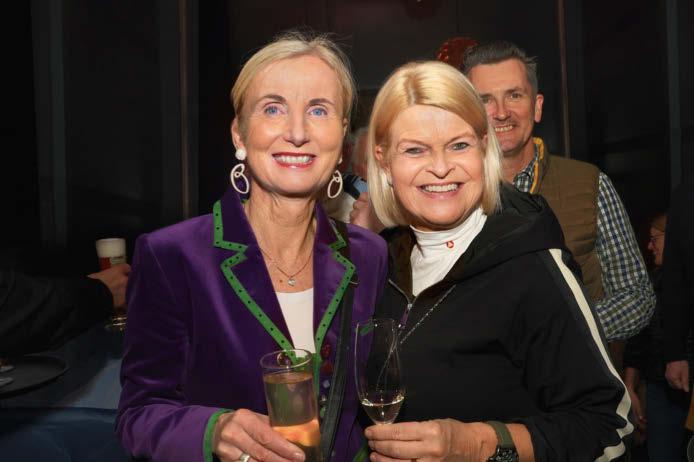
Absolutely. You need patience – just like in sport. You don’t achieve goals overnight. And I always say that the best way to grow is through setbacks. Successes are important, but you experience setbacks more frequently – and it’s from those that you draw your strength. That’s when you say: I can do better, I’ll stick with it. And keeping a frm eye on my goals is something I’ve taken with me from the sport. Teamwork has also always been important to me. Even though skiing is an individual sport, I was always someone who regarded myself as part of a team. Now, I’m on my own at the top, but it’s the team that keeps the Association going – and we can only make a diference by working together.
Was the path to becoming President a clear-cut one for you?
No, not at all. I was Vice-President for a long time, then there was a transition phase. And suddenly, the question was in the room. I gave it careful consideration – and spoke to my family about it. And then, I said yes.
Was it difcult becoming the frst woman to hold the position?
Of course. There were a lot of questions: “Can she do it? How will she do it?” The sport is male dominated. But I knew that if I didn’t do it, the opportunity for a woman to take on the role would have passed for now. I’ve always said: if even America isn’t ready for a female President, the Austrian Ski Association defnitely isn’t. Now, the Austrian Ski Association has become somewhat of a pioneer – ahead of America.
Do you see yourself as a pioneer?
Yes. Or, in all events, as a role model. I can feel that very clearly. I naturally had a very special starting point – my pre-predecessor Peter Schröcksnadel was President for over thirty years. He had his very own way of doing things. And now I’m here – with a diferent style, a diferent presence.
How do you use your position as a role model?
I receive a lot of invitations and talk about various topics. It’s good for people to see women in positions of power.



“YES. OR, IN ALL EVENTS, I’M A ROLE MODEL. I CAN FEEL THAT VERY CLEARLY.”
Roswitha
(right)
(below).
‘SNOW & TALK’ WITH ROSWITHA STADLOBER
The Austrian Ski Association President on her role as a woman in the male-dominated ski world and Austria as the perfect host.
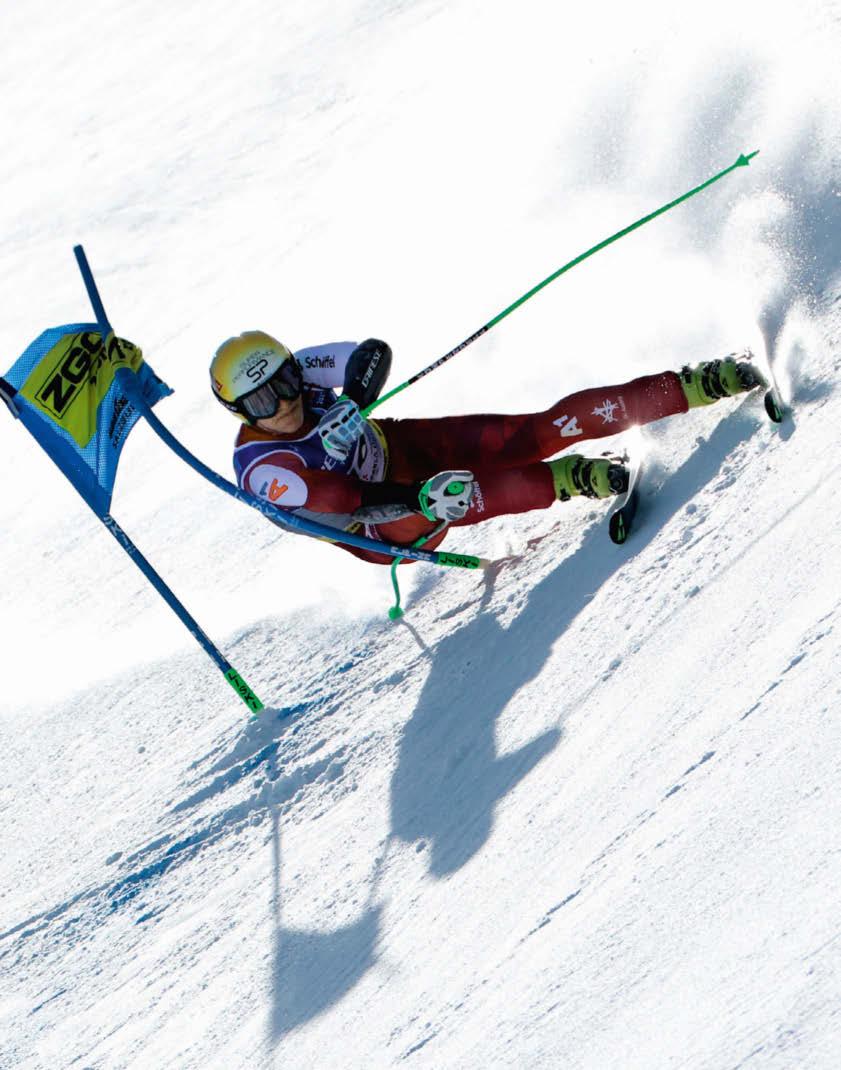
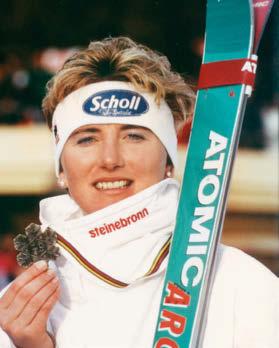
Today’s Austrian Ski Association President during her active career as an athlete when she competed under her maiden name Roswitha Steiner.
Gold medallist Raphael Haaser: a skiing star who stands for everything Roswitha Stadlober is passionate about – especially inspirational tenacity despite major crises. A man born with the makings of an idol.
“THE MOST IMPORTANT THING FOR ME PERSONALLY IS THAT WE CREATE ROLE MODELS.”
How have you found your presidency so far?
It’s been something I’ve had to get used to. The Austrian Ski Association is complex: competitive sport, events, national associations, clubs. But I’ve got a good team, we’ve structured and digitalised many things – and I think I’ve got there now.
ROSWITHA STADLOBER
Born in 1963 in Radstadt with the maiden name Steiner, Roswitha is a former Austrian ski racer and has been President of the Austrian Ski Association (ÖSV) since 2021. In the 1980s, she was one of the world’s best slalom skiers, winning eight World Cup races and twice taking home the small crystal globe. She was named Female Austrian Sports Personality of the Year in 1986 and became Vice-World Champion in slalom in 1987. She ended her active career at the age of just twenty-four to take on new professional challenges. She worked in banking for many years and subsequently became the Managing Director of KADA – Sport mit Perspective. Stadlober is the first ever female President of the Austrian Ski Association. She is married to the former cross-country skier Alois Stadlober, with whom she has two children: Luis Stadlober is a former member of the national cross-country skiing team and Teresa Stadlober is a successful cross-country skier and Olympic medallist. Roswitha Stadlober is seen as a strong voice for the promotion of young talent, education through exercise and equal opportunities in sport.
When does the Austrian Ski Association regard a World Championships as successful?
It goes without saying that it’s frst and foremost about sporting success – that much is clear. The second thing is for as many of those involved as possible, including all peripheral contributors, to say: “Those were successful World Championships.” But the most important thing for me personally is that we create role models. That lots of young people say: “I want to ski. I want to go down that path too.” For lots of children after the event to say:
“I’m going to start ski racing because the World Ski Championships were so amazing.”
What’s your biggest focus – beyond the World Championships?
It’s important to me – and this is something that I’m truly passionate about – that sport is fnally regarded as a form of education. We constantly talk about intellectual education: children should be good at maths, learn languages, perhaps play an instrument. That’s all well and good – but exercise is equally as important. Children in sports clubs don’t just learn movement sequences, they acquire skills in the same way as when learning a language or to play an instrument. Whether gymnastics, skiing, cross-country skiing or snowboarding: these are all forms of education. And they need to be recognised as such.
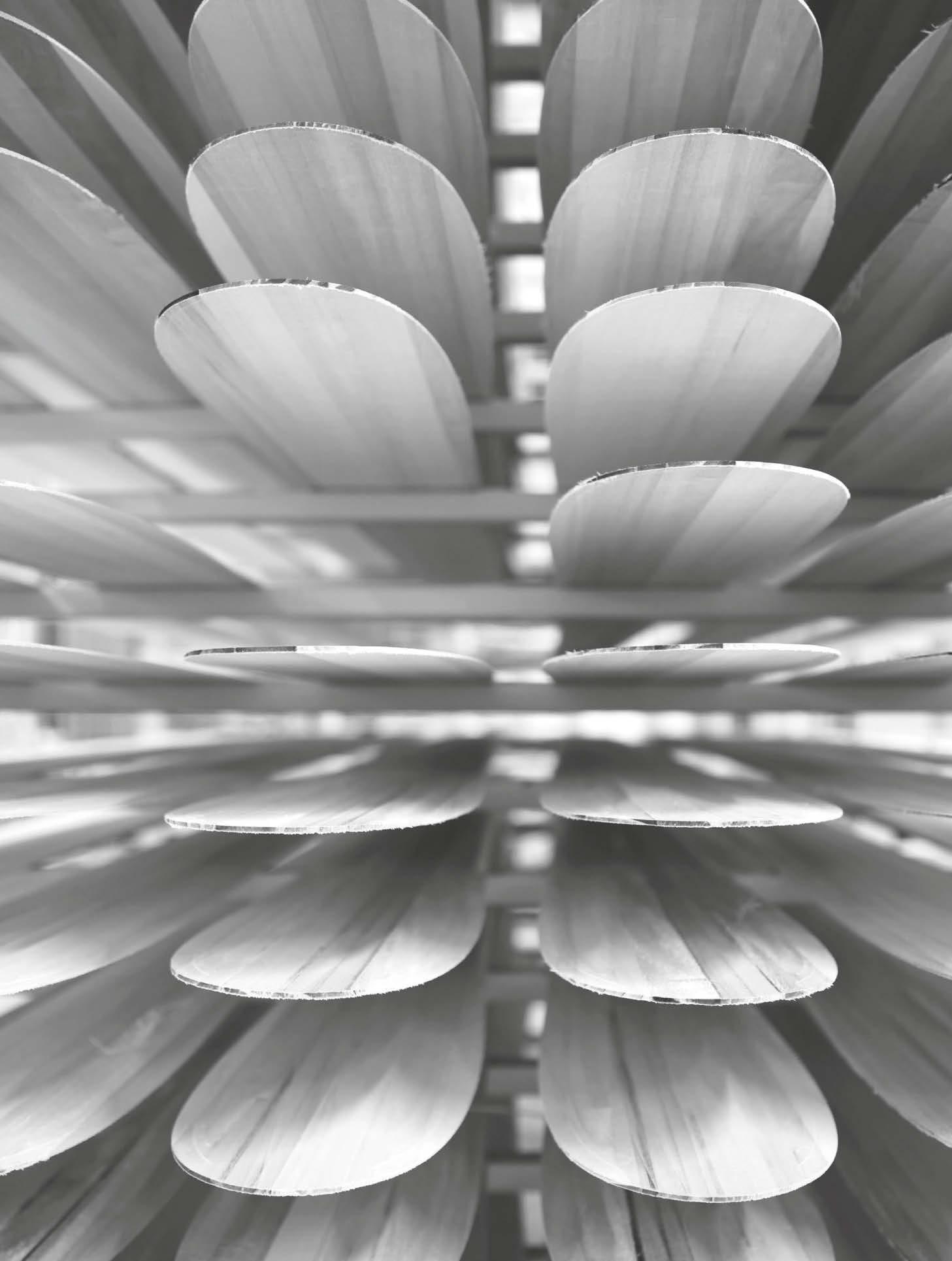
Atomic CEO Wolfgang Mayrhofer reveals why Mikaela Shiffrin and Breezy Johnson’s World Championship victory was like winning the lottery for him, why he regards the SalzburgerLand as the Silicon Valley of skiing and why craftsmanship is still important.
“THE
WORLD SKI CHAMPS ARE A FANTASTIC ADVERT FOR SALZBURG”

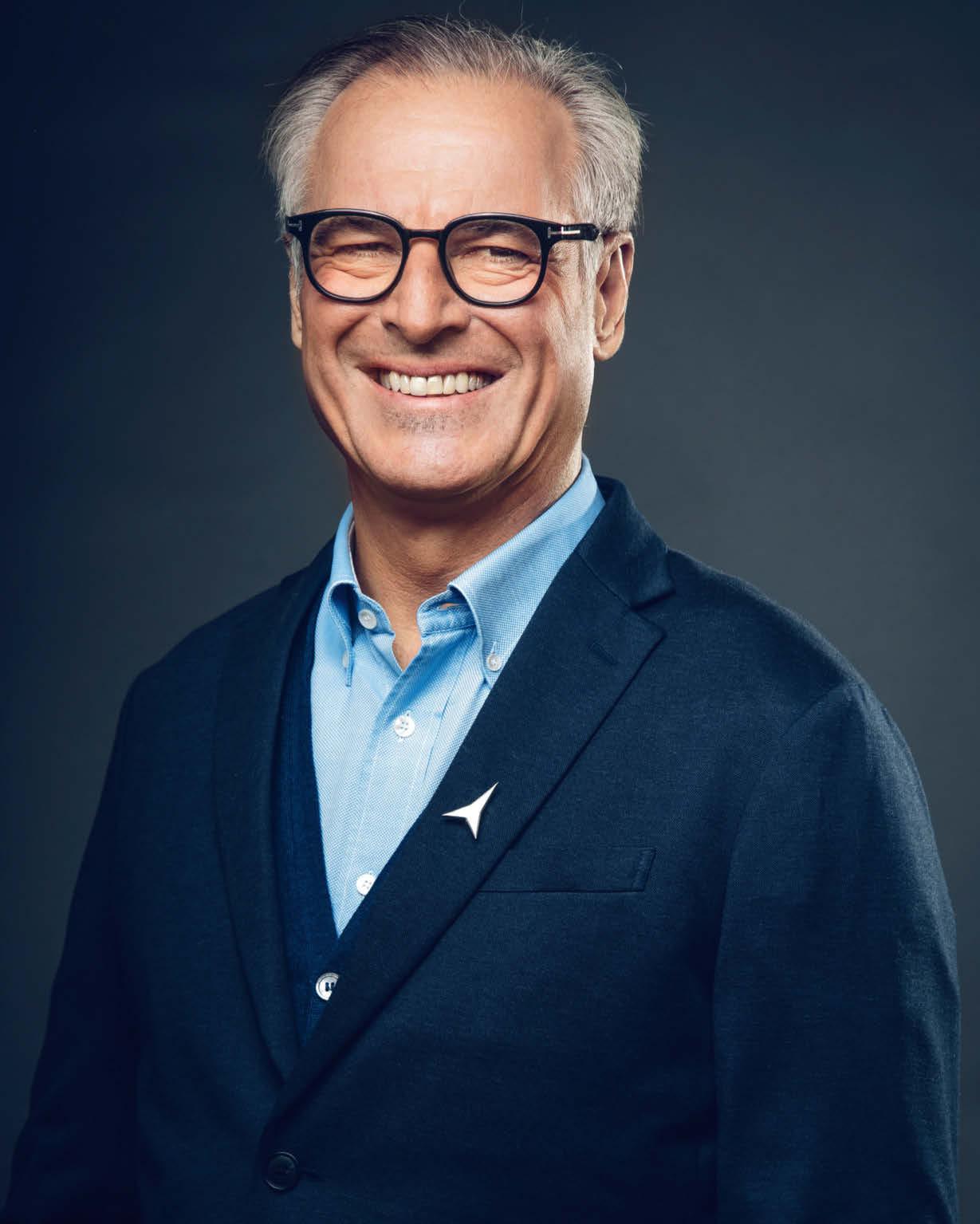
olfgang Mayrhofer looks relaxed as he sits in the hotel lounge. Right by the valley station of the 12er KOGEL gondola lift and the fnish area, this is where the Salzburgbased world market leader in the ski industry set up ofce during the FIS Alpine Ski World Championships. Each day, his company’s services are provided to retailers and other business partners from all over the world, with the latest products presented in the showroom. The fact that US retailers were here to experience the win by the US pair Mikaela Shifrin and Breezy Johnson – both of whom glided to gold in the team combined on Atomic skis – was “naturally like winning the lottery”, stated Wolfgang Mayrhofer.
ABOUT WOLFGANG Wolfgang
was
personally brought the state-certified ski instructor into the business in 1985. He has been Managing Director of Atomic Austria GmbH since 2011 as well as spokesperson for the ski profession in the Association of the Austrian Wood Industries since 2018.
How do you become – and remain – a world market leader? And how important are innovations in that regard?
wolfgang mayrhofer: Innovations are absolutely critical. It all started back in 1955 with Alois Rohrmoser making skis for himself and a few friends in his wainwright’s shop in Wagrain. A few years later, the frst racing skis were developed and we’ve now expanded our portfolio in all directions. We also manufacture bindings, ski boots, helmets, goggles, poles, back protectors and clothing. However even today, our success is ultimately still down to our passion for skiing; our core values are based on innovation, authenticity and pioneering spirit. Our use of the slogan ‘We Are Skiing’ in our communications shows that we already have a certain self confdence. But this is down to the fact that we truly are the world’s number one for all things skirelated.
Mayrhofer
born in Lower Austria in 1960. Atomic founder Alois Rohrmoser
How much does Atomic spend on product research and development – as a percentage?
Depending on the product category, we invest between fve and seven percent of our turnover in research and development each year. In doing so, we follow a process that we know as I2P, which stands for ‘idea to product’. This is about market observation, market investigation and market research. But it’s also about identifying trends and incorporating them into our product range. We approach this task extremely systematically without losing sight of our craftsmanship skills. We’re highly agile. Ski racers and their service personnel are always surprised at how quickly we respond to their input.
What does ‘quickly’ mean here?
We can make a new ski within 48 hours. Our location in the heart of the Salzburg mountains naturally helps us with that. We’ve got the best ski areas on our doorstep and the Reiteralm ofers us the ideal conditions for trying things out – in cooperation with our athletes.
I expect that athletes like Lucas Pinheiro Braathen, who is full of ideas, really like that. Braathen has even rented an apartment in Altenmarkt, just around the corner from Atomic. He regards living so close to his ski company and perfect pistes as a major advantage.
California has the famous Silicon Valley, home to tech giants like Google, Apple and Meta (Facebook, Instagram, WhatsApp) Is the SalzburgerLand the Silicon Valley of skiing?
Yes, you could say that. The location has many benefts. Another important factor is that Salzburg is somewhere that people are extremely passionate about both skiing and craftsmanship – and that’s incredibly important when making skis. There’s also the fact that people identify with skiing more closely in Austria than in countries such as France or Switzerland. Salzburg is the perfect location for a winter sports company.
We’re conducting this interview during the FIS Alpine Ski World Championships 2025 in Saalbach, less than a hundred metres from the fnish area. How important is this event for Salzburg in general?
The TV coverage is broadcasting amazing images worldwide. That’s a great advert for Salzburg. We’re also celebrating our 70th anniversary here at the World Championships and have invited partners and sports goods retailers from all over the world. They’re getting a frsthand experience of just how much Austrians love skiing.
With Marcel Hirscher’s Van Deer, there’s now a second Salzburg ski company that is experiencing great success in the World Cup. Is competition good for business?
Marcel used to work at Atomic and I’ve known his father Ferdinand for a long time. We have a good relationship with one another. We try to win races – Marcel and his squad also try to win races. That can’t be a bad thing for Salzburg as a location.
One decisive question in Silicon Valley is how to attract the best people to your company. How is the recruitment situation in Salzburg?
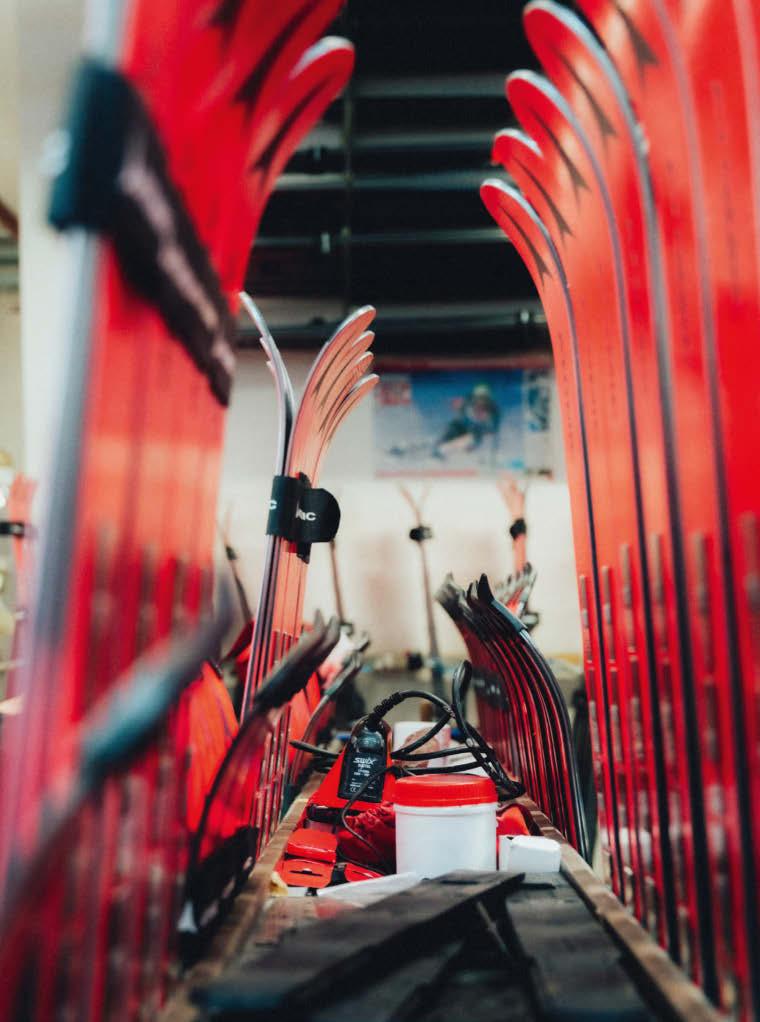
Skis line up in rows in the Atomic Pro Center by the factory in Altenmarkt, Pongau. Findings from ski racing flow into the development process, so ‘normal’ skiers benefit from the expertise of Mikaela Shiffrin and co.
For us as a ski company, it’s a major advantage that the pool of people who are passionate about skiing is extremely large. Lots of young boys and girls from the local ski clubs aspire to a great career and attend ski schools such as those in Schladming, Stams or Saalfelden (here in Salzburg). Not all of them make it to the World Cup, but many of them then go on to study or do other training in the feld of skiing. They ofer us a great deal of understanding and expertise that beneft our ski production processes.
Do you specifcally work with schools?
Yes. On the one hand, in Steyr in Upper Austria there’s an annual class with 18 to 28 young people who train to be ski constructors. More than half of the apprentices complete their internship with us, meaning that we train our own people. At the Holztechnikum Kuchl (Kuchl college of wood technology) in Salzburg, we’re not only sponsors but also on the school board (n. b. Dr Renatus Capek, Director of Legal and Human Resources at Atomic, is Vice Chair of the Holztechnikum). Our engineers are in close contact with the school. No year passes without students from Kuchl coming to us.
You previously mentioned the passion for craftsmanship. Why is that still so important in these times of progressive automation?
Because our skis are still one hundred percent manufactured by hand! If you visit our production facility, you’ll see around ffty people making skis: inserting the base, the
wooden core, the laminate, the edges, the fnishes –these are extremely intricate tasks that still largely depend on instinct, on the feel for the material. When it comes to standardised tasks, we always try to improve the automated processes. Our machine builders are constantly looking for the latest developments and considering ways in which these can be used to optimise our production processes.
Many things are developed in Formula 1 that are then used on the roads years later. Do general skiers also beneft from innovations in ski racing?
Yes, defnitely! On her winning run in the team combined, Mikaela Shifrin used the new Redster Revoshock, which will be available from retailers in the coming season. Her feedback during the development process was extremely important. She told us that she needed a ski that would forgive mistakes but still ofer the necessary punch for powerful acceleration. If you use skis with Revoshock technology next year, your enjoyment of them will be down to Mikaela’s important ground work.
Of course, there are few people who can use skis as radically as she can … True, but when developing and testing products, it’s crucial for the best athletes in the world to push them to their limits and explore the boundaries of their performance. That naturally also includes allowing ourselves to get things wrong.
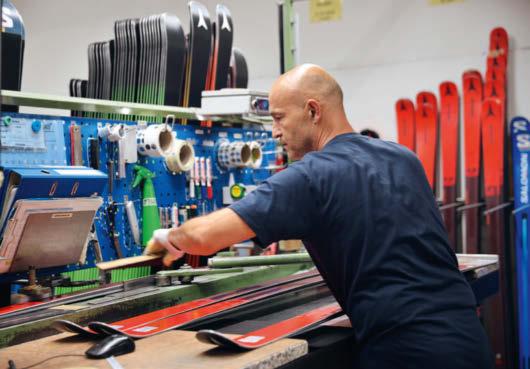
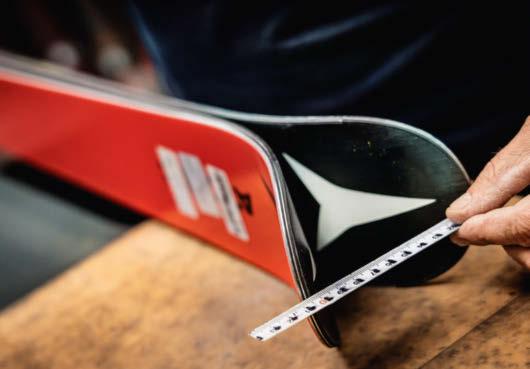
“WHEN TESTING PRODUCTS, IT’S CRUCIAL FOR THE BEST TO PUSH THEM TO THEIR LIMITS.”
Can you give us an example?
I can remember us starting to develop ski touring boots. These have a completely diferent requirement profle to regular ski boots because they have to be as light as possible while still ofering maximum stability when on ski tours. I went out onto the mountain with the tester team – and we’d completely torn apart all ffty pairs of boots within two hours. But our engineers weren’t particular concerned. On the contrary, they said: “Okay, good, now we know which direction we need to keep working in …”
A quality-control employee inspects skis that have been constructed layer by layer. High-tech innovations are important – but not everything, says Wolfgang Mayrhofer. Machines will never replace natural instinct.
ABOUT THE COMPANY
Atomic was founded by Alois Rohrmoser in Wagrain, Austria, in 1955. The factory in Altenmarkt im Pongau was built in 1971. The company (which has been owned by the Finnish company Amer Sports AG since 1994) now has its head office in this same town. Here, around 60 kilometres to the south of the capital of the SalzburgerLand, some 400,000 pairs of skis are produced every year. The most successful Atomic stars, past and present, include Hermann Maier, Marcel Hirscher and Mikaela Shiffrin. atomic.at
The boss at Atomic gets involved in the testing? Of course. I reach for my skis every time I have a free minute. On business trips to the USA, Japan or China, I spend as much time as possible on the mountain. After all, I don’t just go there to sit in meetings; I use the opportunity to get to know the ski areas and understand what matters there.
Is sustainability important to you?
Defnitely! We’ve introduced a life cycle assessment for all product categories (n. b. this systematically records the energy balance of products and thus their impact on the environment over their entire life cycle) and therefore know things like the carbon footprint of every ski.
How does that knowledge help you?
We’re able to look for innovations in a targeted manner. For example, our Backland touring skis now have a stronger wooden core and therefore almost no fbreglass shell – simply because this reduces the carbon footprint. We’re also starting an interesting project in relation to our ski boots in the upcoming season, which will also ft extremely well with the idea of Salzburg being the Silicon Valley of the ski industry.
What project is that?
It’s a project known as Wintrust and, together with the Lower Austrian ecoplus Plastics Cluster, we’ve selected Pinzgau and Pongau as pilot regions. Bründl Sports is also on board as a retail partner: if you return your old ski boots, you’ll get a discount on new ones. We’ll then dismantle the boots, shred the plastic components and feed them back into the production process. This kind of circular economy with ski boots is a world frst.
JOHAN ELIASCH
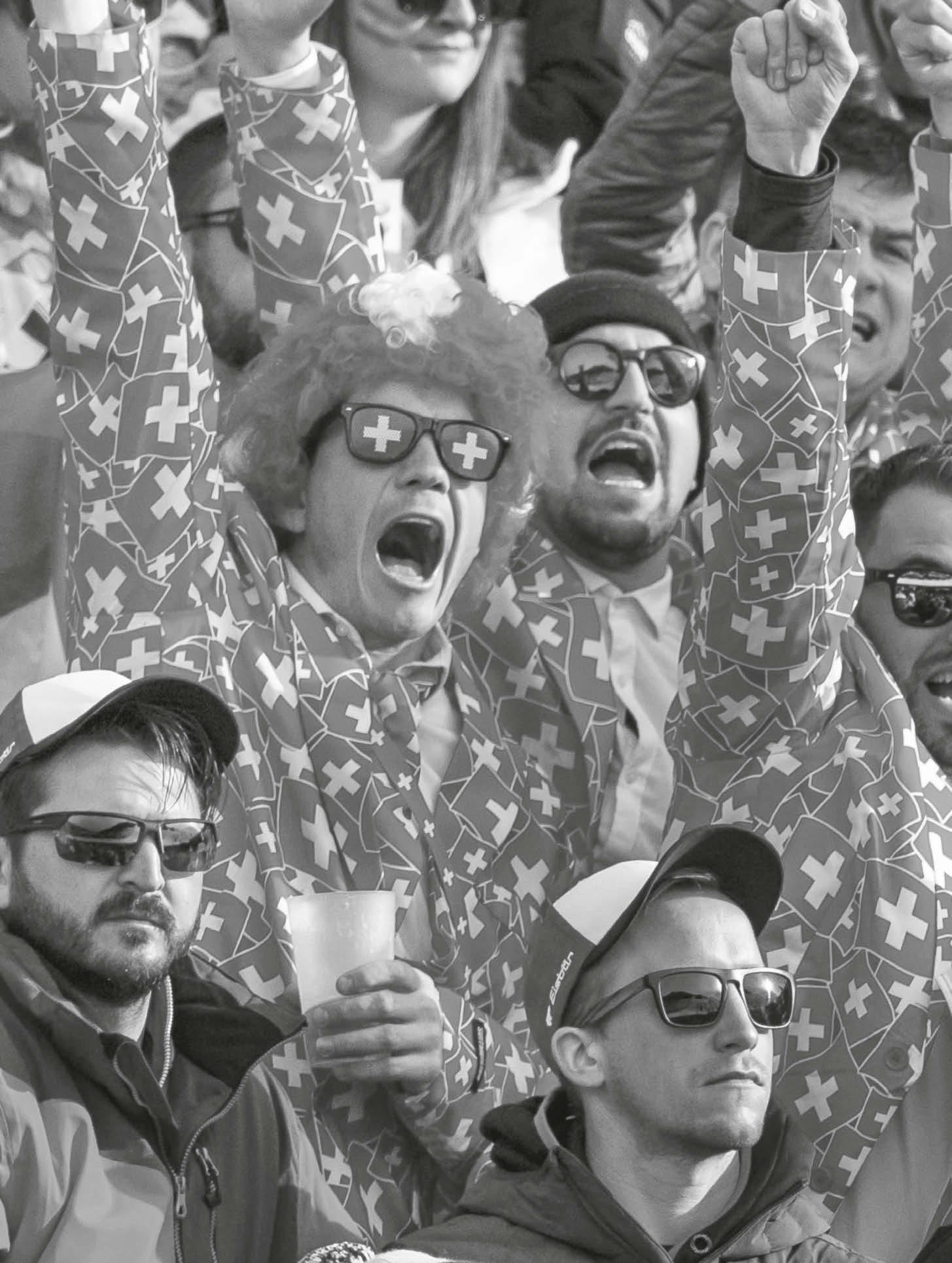
“IT WAS PERFECT IN EVERY WAY”
An amazing atmosphere and sensational hospitality –FIS President Johan Eliasch raves about Saalbach.
What memories did you take home with you?
It was marvellous. A phenomenal atmosphere and incredible crowds of people. The organisation was fawless. We had to negotiate hard with the powers above, but they delivered us the perfect weather. It was extremely expensive (laughs). The hospitality was perfect too. The vanilla ice cream with hot chocolate sauce couldn’t have been better. The races themselves were obviously marvellous too. The race courses were once again perfectly prepared. We were lucky to only record a few injuries. And we had major success with the team combined competition – held for the frst time ever. The amazing atmosphere has helped ensure that this format will be retained and even introduced as a new Olympic discipline in Milan-Cortina. All in all: ten out of ten.
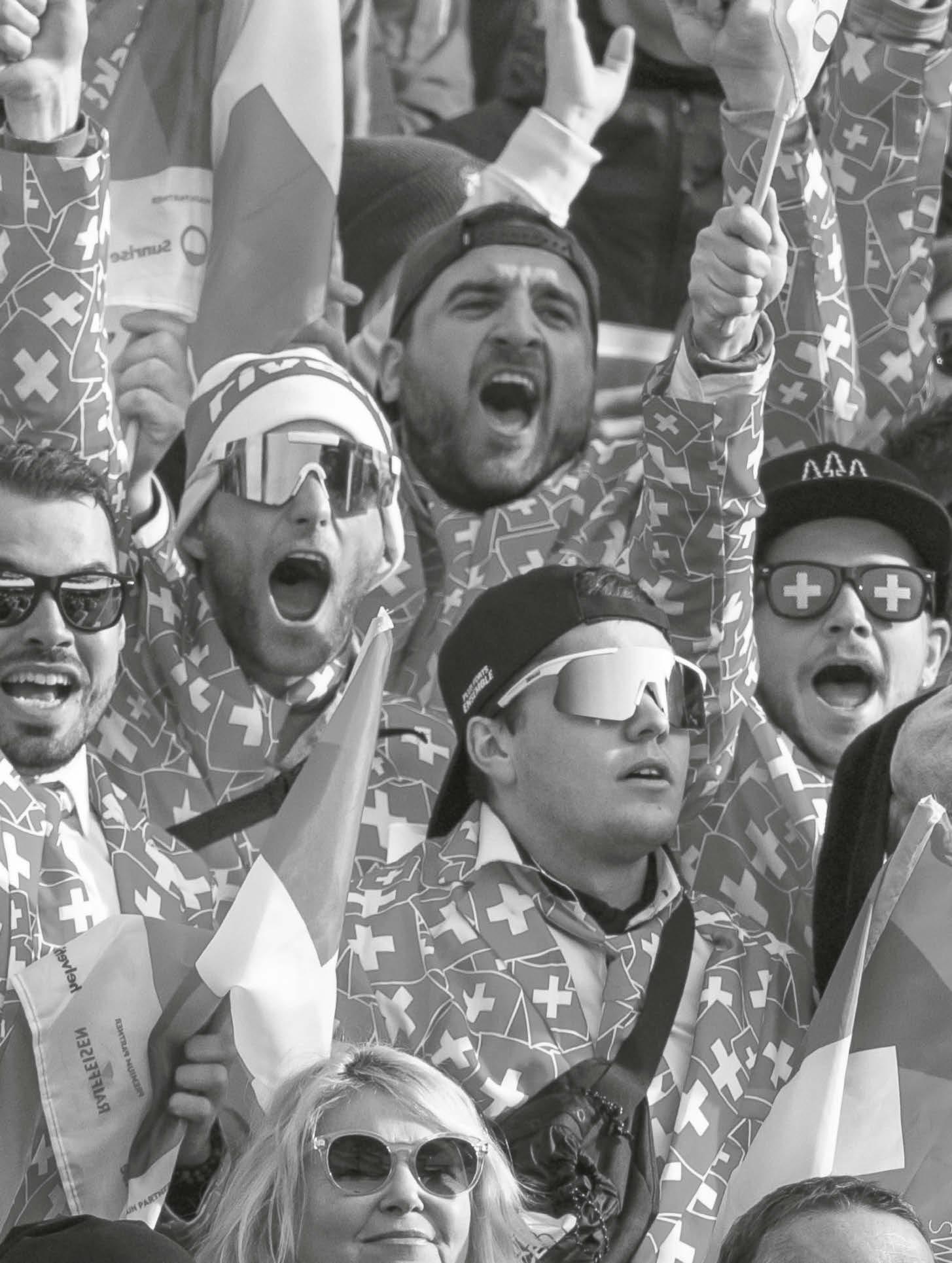
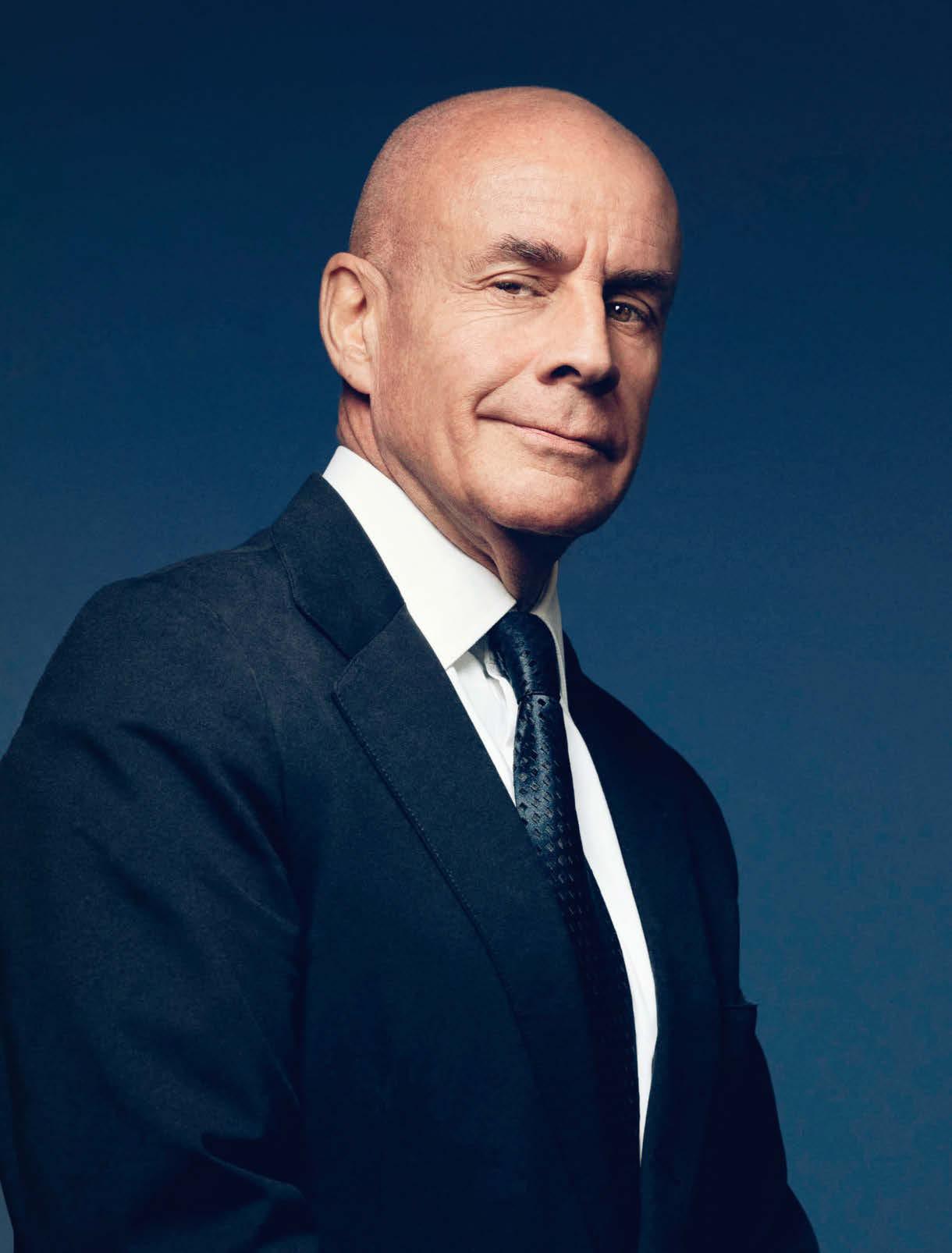
The Swedish-British businessman Johan Eliasch, 63, has been President of the International Ski and Snowboard Federation (FIS) since 2021. His memories of Saalbach bring a smile to his face.
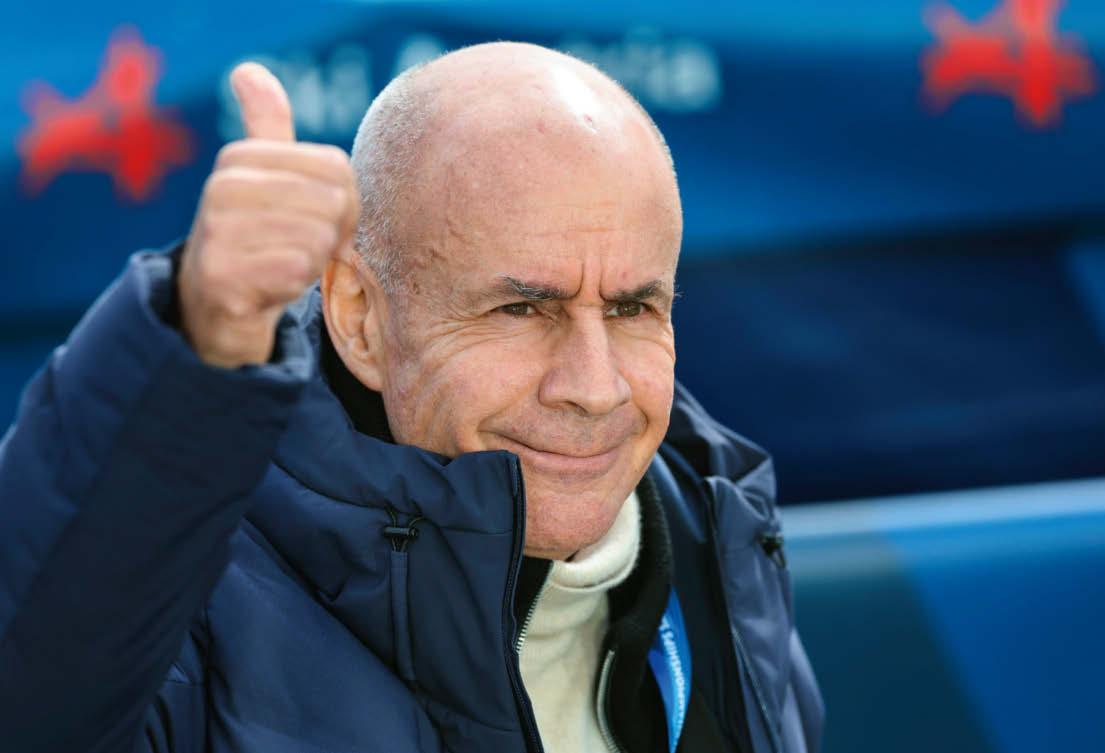
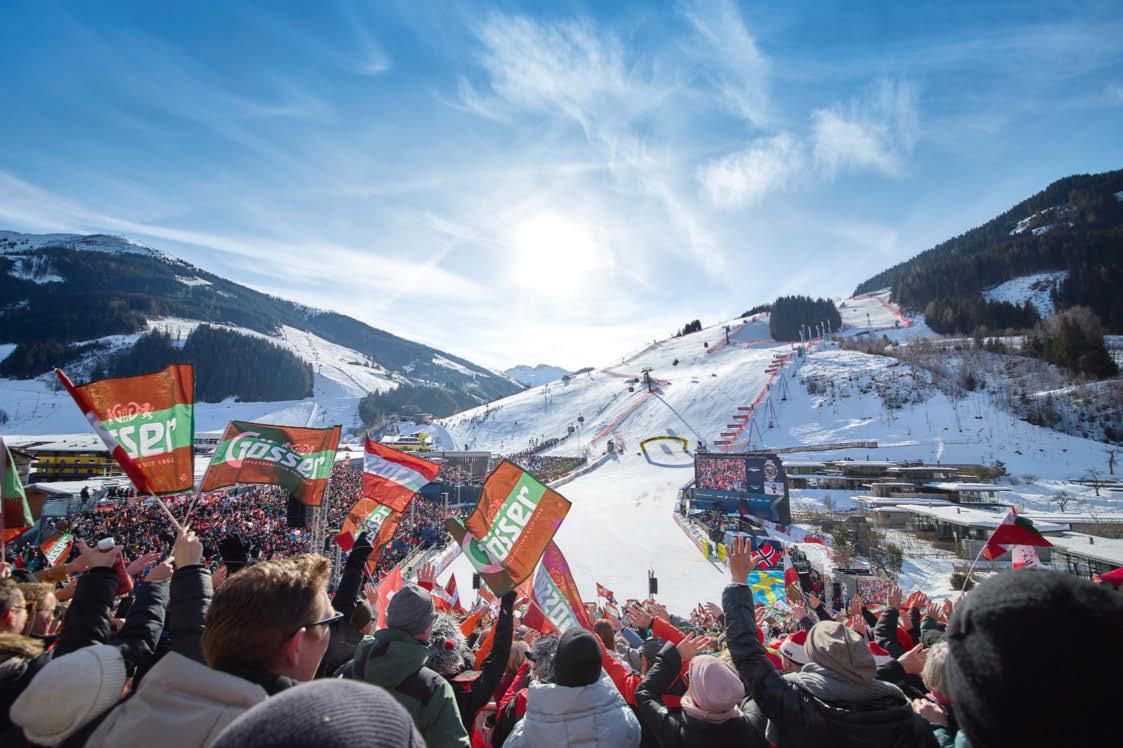
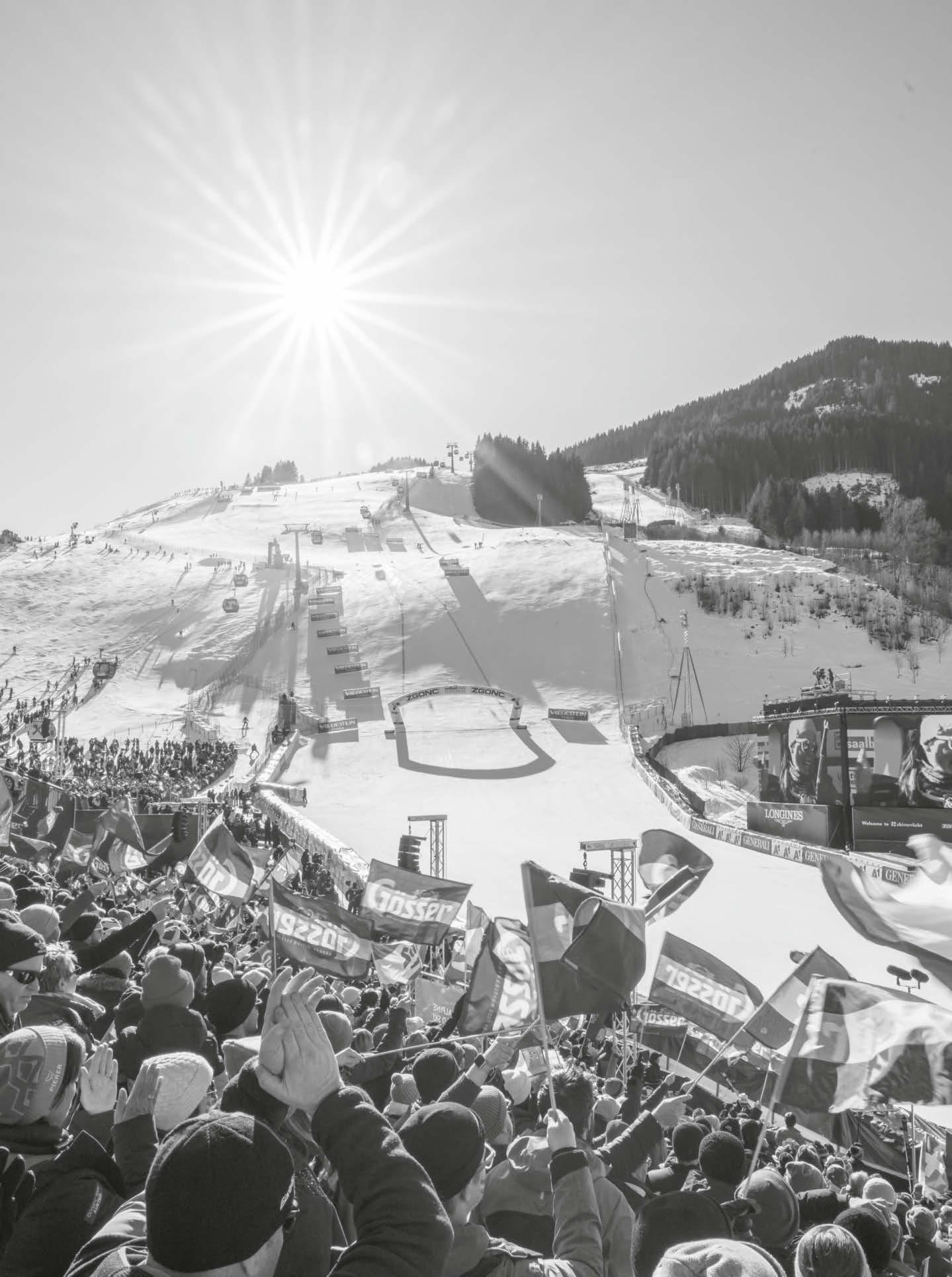
Johan Eliasch is extremely happy with the idea of all races being held on the same mountain and with the same finish line.
“AUSTRIA IS A TRUE SKIING NATION, LIKE FEW OTHER PLACES IN THE WORLD. SKIING IS A LIFESTYLE.”
How happy were you with the safety in Saalbach?
The safety was excellent. This is an important topic for us, and one that we work extremely hard on. I’m fully committed to protecting the athletes and ensuring their safety. The organisers in Saalbach did a fantastic job –there were no complaints from the athletes.
What was your contact like with the local organisers? Can you describe how closely you worked with them? We worked with them extremely closely. We know them really well and they did a phenomenal job.
The idea of holding all races on one mountain –will that be a model for future events?
Defnitely. If that’s possible, it’s far, far better.
Did you have time to go skiing on the Zwölferkogel yourself?
No, but I did so a year ago during the World Cup fnal. As President, there are so many things you have to deal with and do! That’s the worst part of the job: that I ski less than I used to. Because I love skiing; it’s what I’m passionate about.
What was the reaction of the FIS ofcials and athletes to the team combined?
It was incredibly positive. The best athletes in the world in diferent disciplines join together as a team. You have the best of the best at the start line – and the fans get both additional speed events and additional technical events. It was exciting to see the way the athletes were driven to give top performances – and the stories behind them are also fascinating. All in all, it was perfect in every way.
The fans in the fnish stadium cheered on all of the athletes with equal enthusiasm irrespective of their nation. How did you fnd the spectators and this show of fairness?
I didn’t hear any booing whatsoever, only cheering. And the crowd celebrated every single athlete – that’s amazing. This is what’s great about holding races in Austria: you’ve got fantastic fans.
How is it diferent to football, for example?
Skiing is part of the Austrian fabric. It’s deeply rooted and embedded in our culture. Austria is a true skiing nation, like few other places in the world. There’s a great love for the mountains and for gliding down them. Skiing is more than just a sport; it’s a lifestyle. That makes it very diferent to football. In addition, they might have done so in their youth, but most football fans no longer actively play the game. That’s diferent with skiing, where almost all of the fans are skiers themselves. As such, they have even greater appreciation for the athletes’ performances.
How important was the Austrians’ success after the second race for the atmosphere?
It naturally helped. But in Austria, the pressure on the athletes is immense – and they perform well! Seeing that was fantastic.
What can we learn from these World Championships for the future of skiing?
We saw that the local organisers worked extremely hard and made some major investments – as did the FIS.
We invested a great deal in digital engagement and used the latest technologies. If we take a look at the fgures, the TV ratings were higher than ever. Fan engagement rose by over 50 percent in all metrics, which is truly extraordinary. It shows that what we’re doing as a skiing family – the FIS, the national ski associations – is bearing fruit and raising our sport to an even higher level.
Is social media becoming ever more important?
It’s about storytelling, access to the fans and diferent consumer behaviours. It’s not just about linear television on public broadcasters – it’s about extending the reach.
Johan Eliasch on how skiing is part of the Austrian fabric – deeply rooted and embedded in Austria’s culture.
JUBILATION, FURORE AND CHEER
Gold, silver and bronze medals, but also community and intense emotions were celebrated in the Home of Snow at the World Ski Championships.
Guests and stars alike experienced emotional highlights in the Home of Snow: Marco Odermatt beamed broadly with his gold medal and rock crystal trophy; the cheers for Vincent Kriechmayr and Mirjam Puchner were as enthusiastic as those for all other medal winners. Stephanie Venier enjoyed her triumph at the ceremonial tapping of the beer. The Austrian Ski Association (ÖSV), Tourismusverband Saalbach Hinterglemm, SalzburgerLand Tourismus and Tirol Werbung presented themselves as strong partners and praised the impressive joint eforts. The musical ‘Skiverliebt’ (‘Ski Lovers’) provided excitement on the stage. In addition to sporting successes, the 75th birthday of the company Hinterglemmer Bergbahnen was celebrated with a cake. The Home of Snow proved to be a hub of joie de vivre, sporting spirit and cohesion.
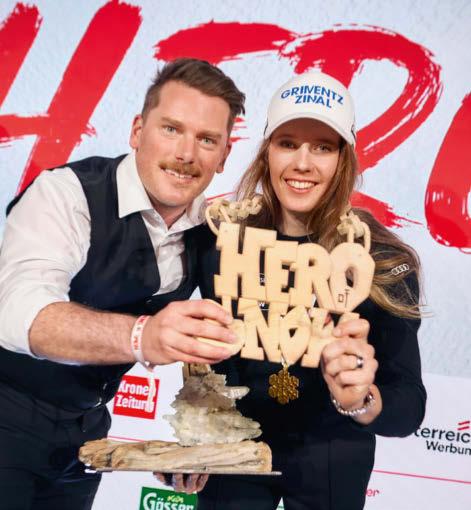
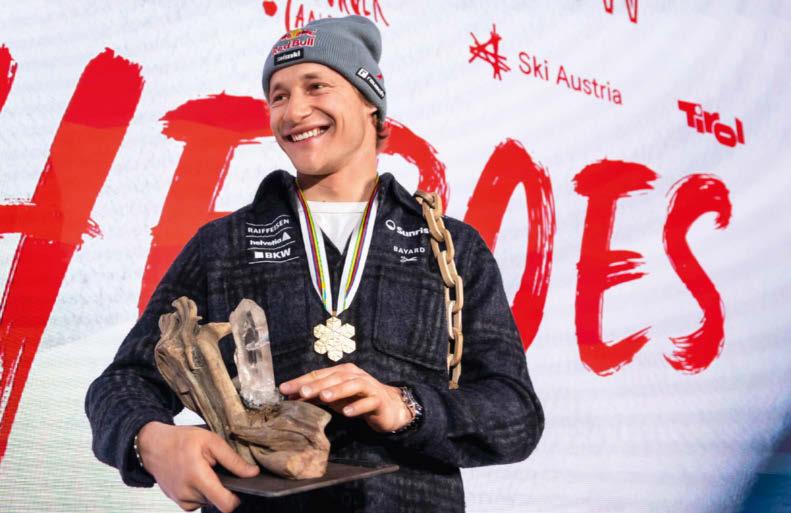
GIFTS FOR THE WINNER
Around his neck, his gold medal (for his super-G victory), over his left shoulder, the ‘Hero of Snow’ chain and in his right hand, his gift from SalzburgerLand Tourismus, a rock crystal on root wood.

A CELEBRATED HEROINE Switzerland’s Camille Rast is not only delighted to receive gold in the slalom; she also proudly presents her new wooden chain, designating her as a ‘Hero of Snow’, together with Heinz Fuchs, Managing Director of Saalbach 2025 Projekt- und Infrastruktur GmbH.
Plus, it goes without saying, that Marco Odermatt is also wearing a relaxed smile. The rock crystal trophies were made by Gerhard and Hannes Hofer from Wald im Pinzgau as well as by Andreas and Simon Steiner from Bramberg.
HOME OF SNOW
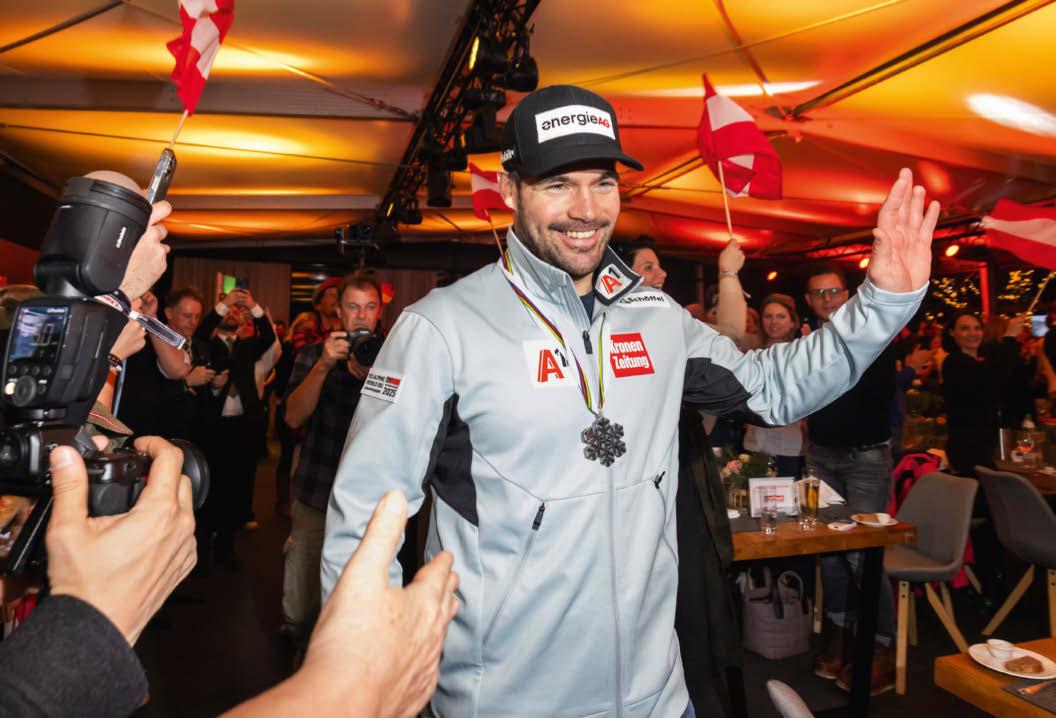

A CONVIVIAL ATMOSPHERE
United by success: father of the World Championships Bartl Gensbichler, ÖSV President Roswitha Stadlober, Governor Wilfried Haslauer, Managing Director of Österreich Werbung
Astrid Steharnig-Staudinger, skiing legend and commentator Alexandra Meissnitzer and Managing Director of Hinterglemmer Bergbahnen Peter Mitterer.
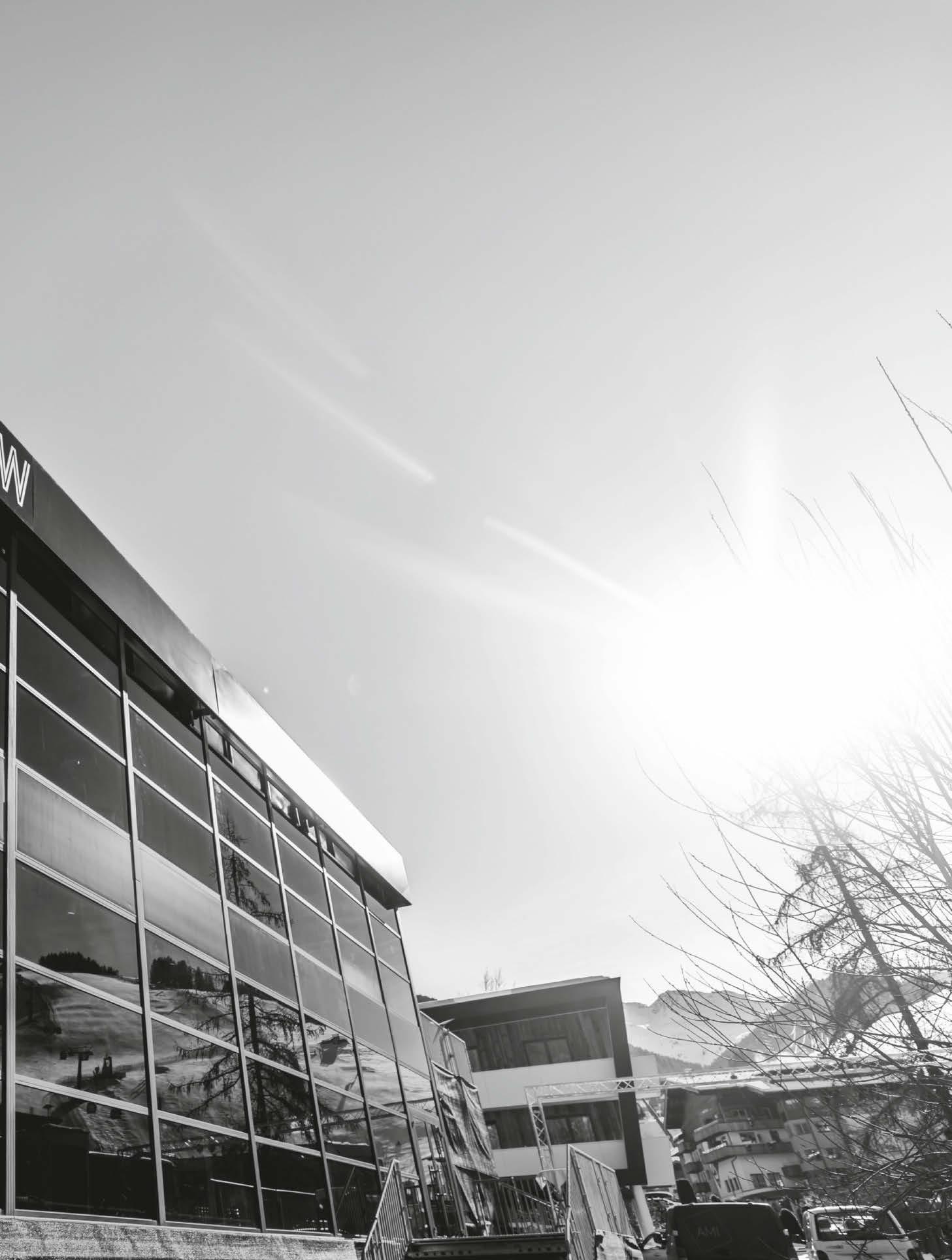
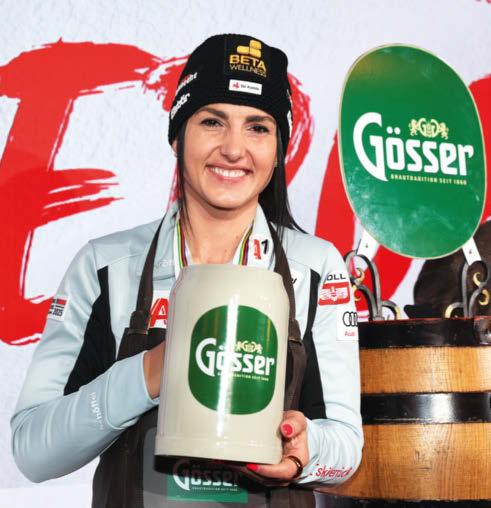
SILVER SHINES LIKE GOLD Vincent Kriechmayr on his way to the stage. He waves casually to the Home of Snow guests, who honour him for his silver medal with standing ovations. On this evening, the precious metal shines almost as brightly as gold.
CHEERS! Success should be celebrated. Gold medallist Stephanie Venier in an apron and holding a giant tankard following the ceremonial tapping of the beer.
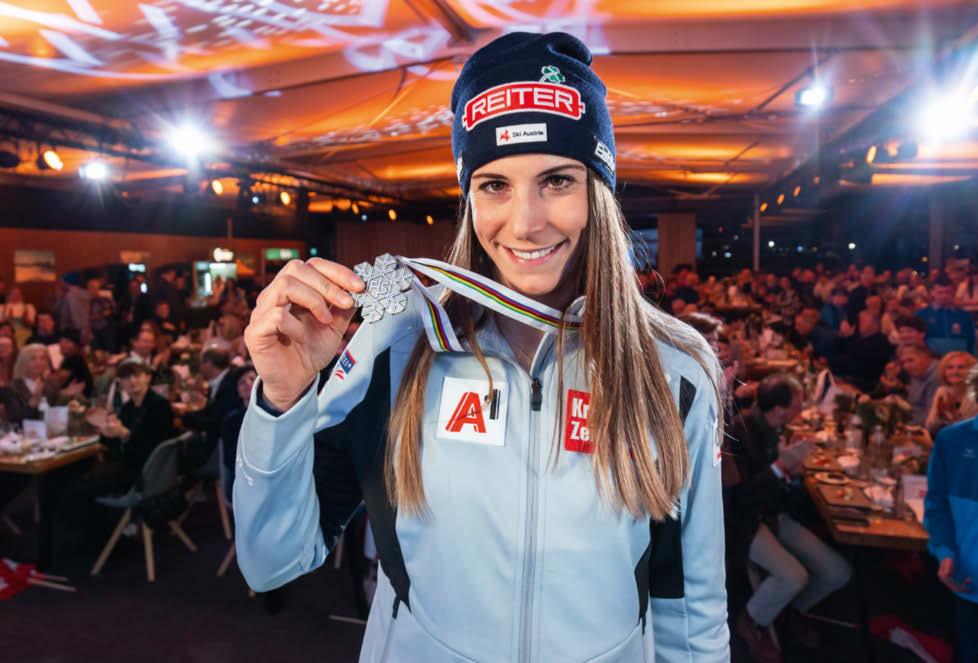
DENSELY CROWDED
Mirjam Puchner is delighted with her silver medal. In the densely crowded Home of Snow, the downhill ski racer from Salzburg receives rapturous applause.
A STRONG TEAM
Managing Director of Tirol Werbung, Karin Seiler, congratulates bronze medallist Katharina Liensberger. Tyrol and Salzburg jointly host the Home of Snow: “The Home of Snow is a huge joint effort – and we’d like to thank the Saalbach Hinterglemm region, SalzburgerLand Tourismus and the Austrian Ski Association.”
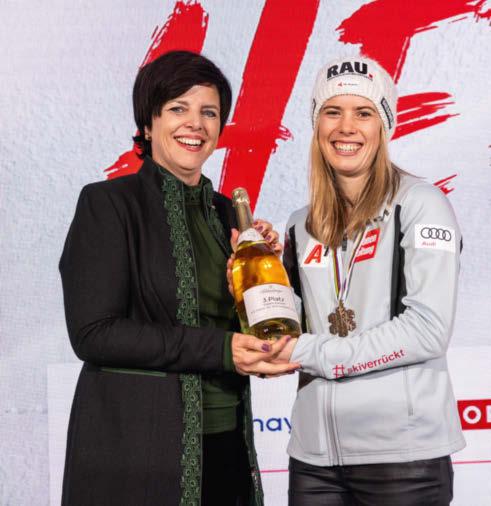
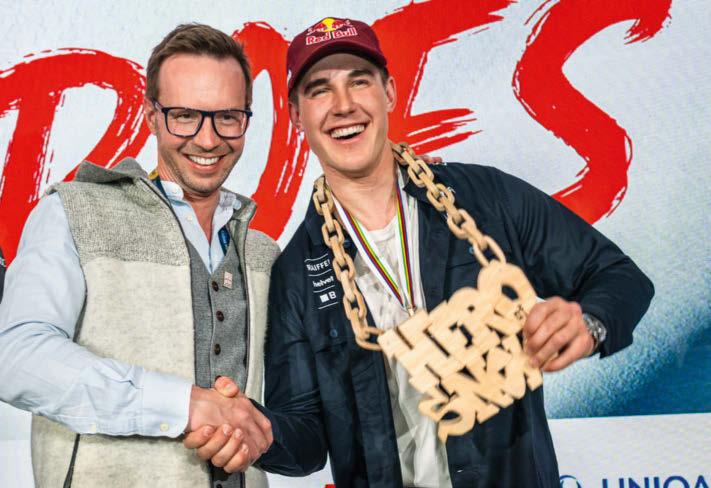
A FIRM HANDSHAKE
Switzerland’s Franjo von Allmen isn’t just a likeable guy, he also has a firm handshake. The chairman of the Tourismusverband Saalbach Hinterglemm Martin Enn is on the receiving end of this and laughs.
THE NEXT GENERATION GETS COOKING
Students from the Salzburg and Tyrolean tourism schools demonstrate their skills and gain valuable experience at the highest level.
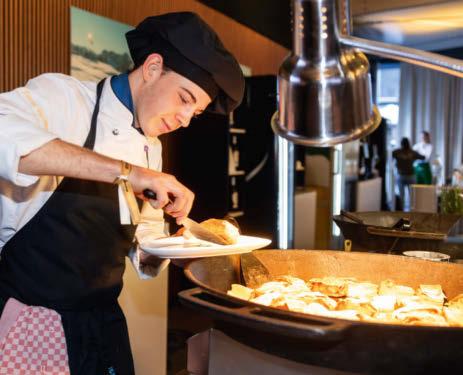
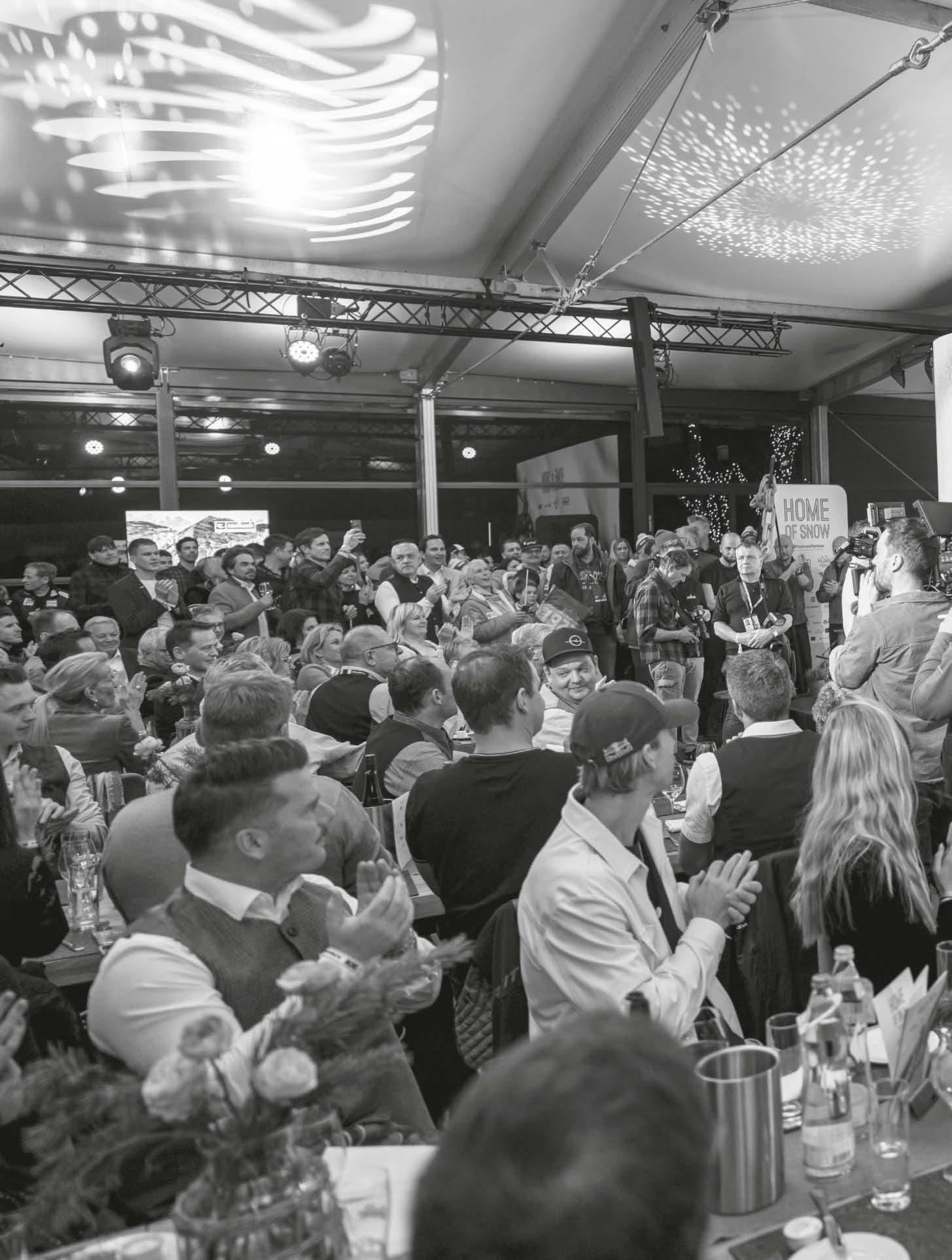

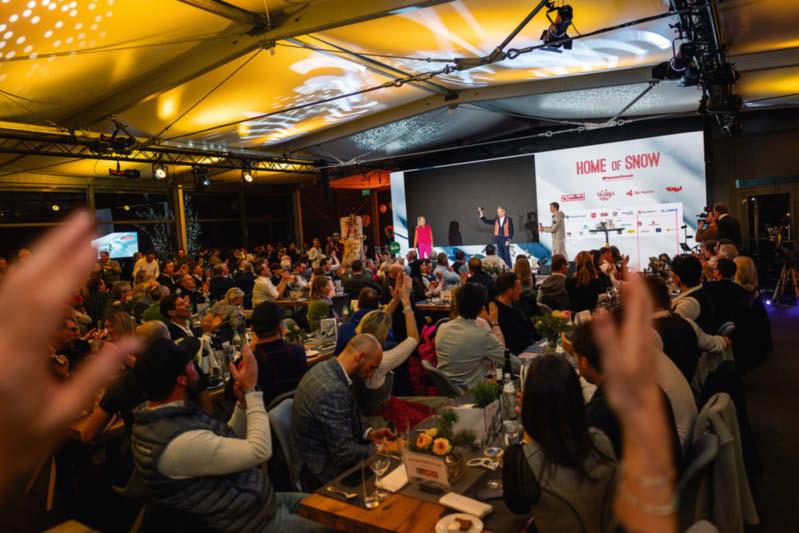
‘SKIVERLIEBT’
The ‘Skiverliebt’ actors performed multiple songs from the hit musical on the stage in the Home of Snow –and earned rapturous applause.
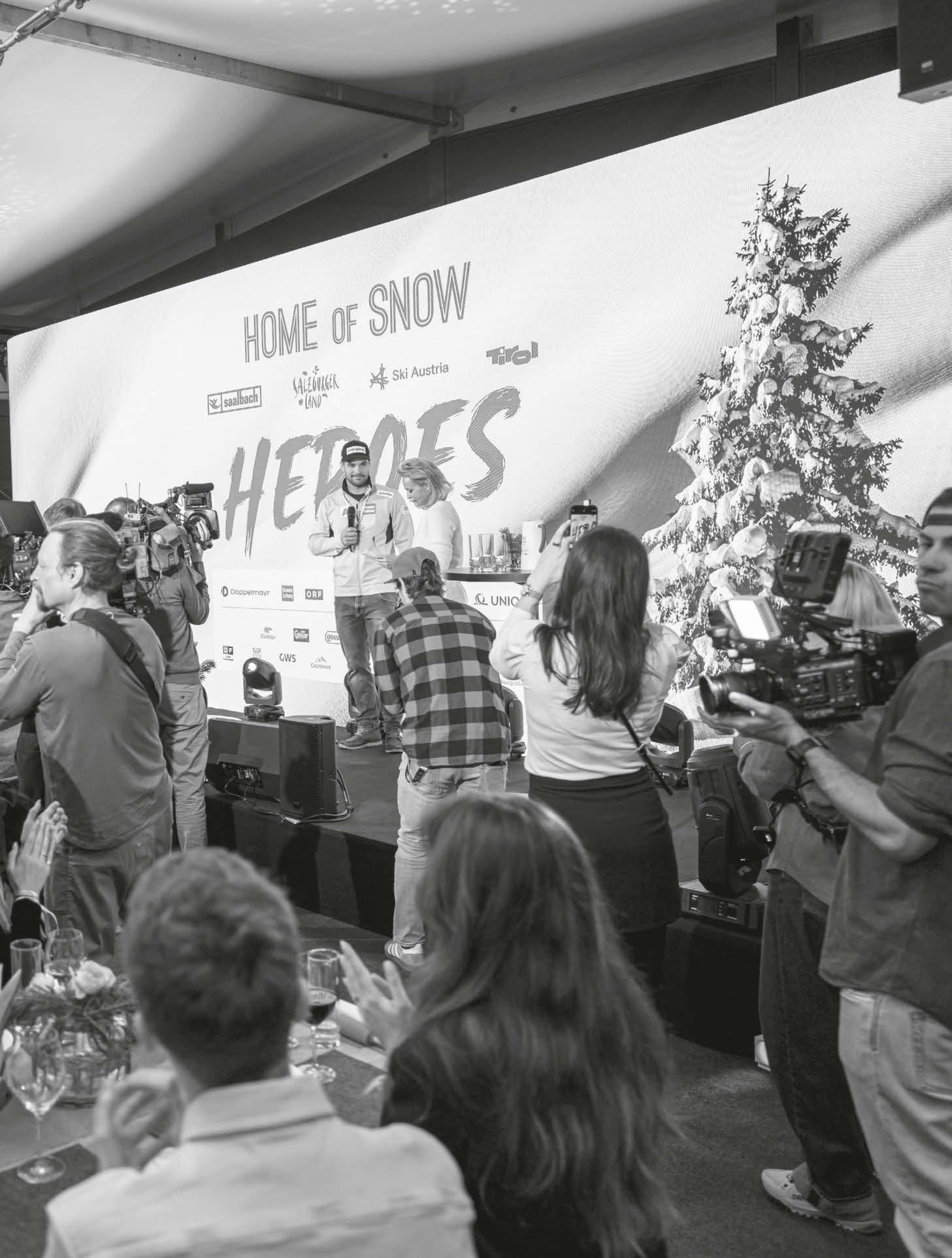
FROM A LOVE FOR SNOW
SLT Managing Director
Leo Bauernberger, Chairman of the Tourismusverband Saalbach Hinterglemm
Martin Enn, ÖSV President Roswitha Stadlober, Marketing Director and authorised signatory of Tirol Werbung Patricio Hetfleisch and ÖSV General Secretary Christian Scherer present their love of snow.
FOUR MEN AND A SKIING LEGEND
The Managing Director of the Tourismusverband Saalbach Hinterglemm Wolfgang Breitfuß with Alexandra Meissnitzer, Christof Willms from the Management Board of the Tourismusverband Pillerseetal, the Managing Director from Saalfelden-Leogang Marco Pointner and the Managing Director of Hinterglemmer Bergbahnen Peter Mitterer
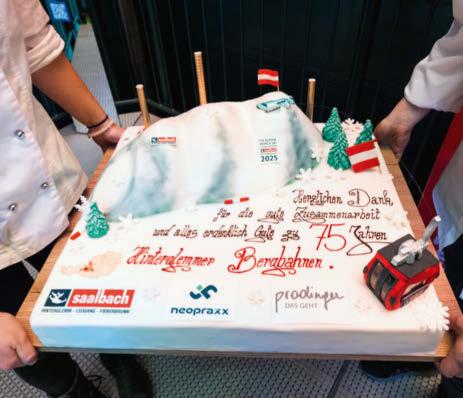
THE SWEET TASTE OF THE ZWÖLFERKOGEL Hinterglemmer Bergbahnen GmbH celebrated its 75th birthday during the World Ski Championships – with a specially designed cake, of course.
“The Home of Snow is a massive joint effort.”
Karin Seiler, Managing Director of Tirol Werbung
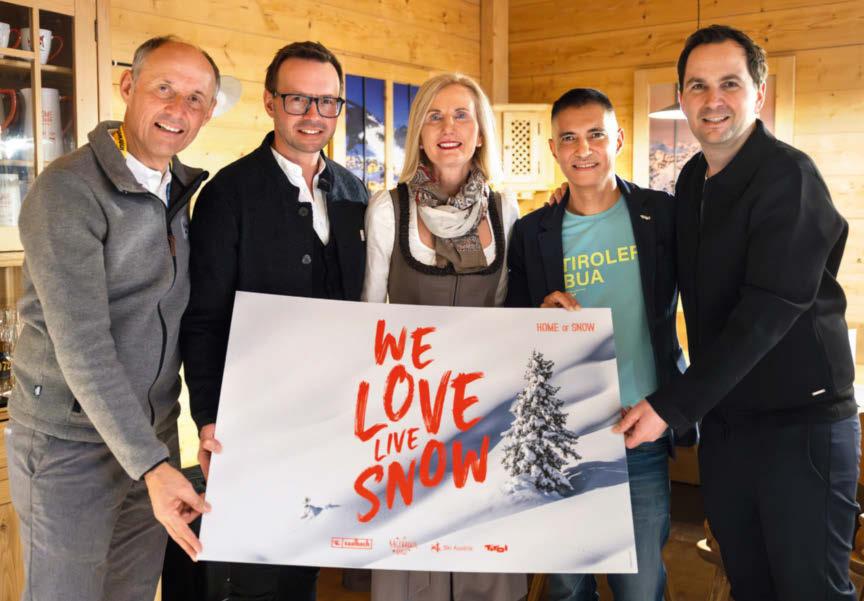
SHOWTIME FOR THE WORLD SKI CHAMPS
‘Skiverliebt’ is far more than a way to artistically round off the World Championships. Once the show finishes at the Salzburg State Theatre, the carefully crafted musical will move on to Hamburg in winter 2026/27.

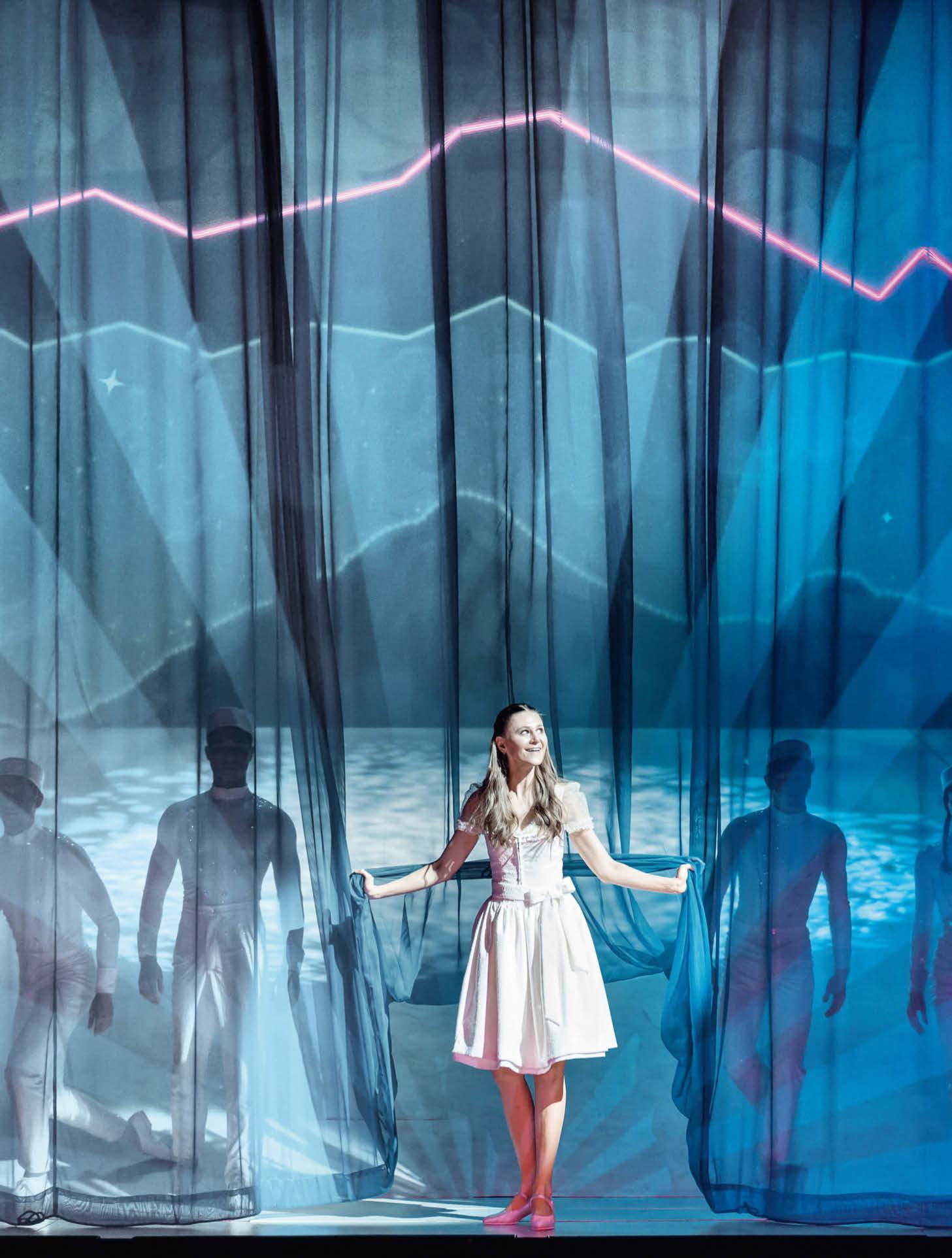
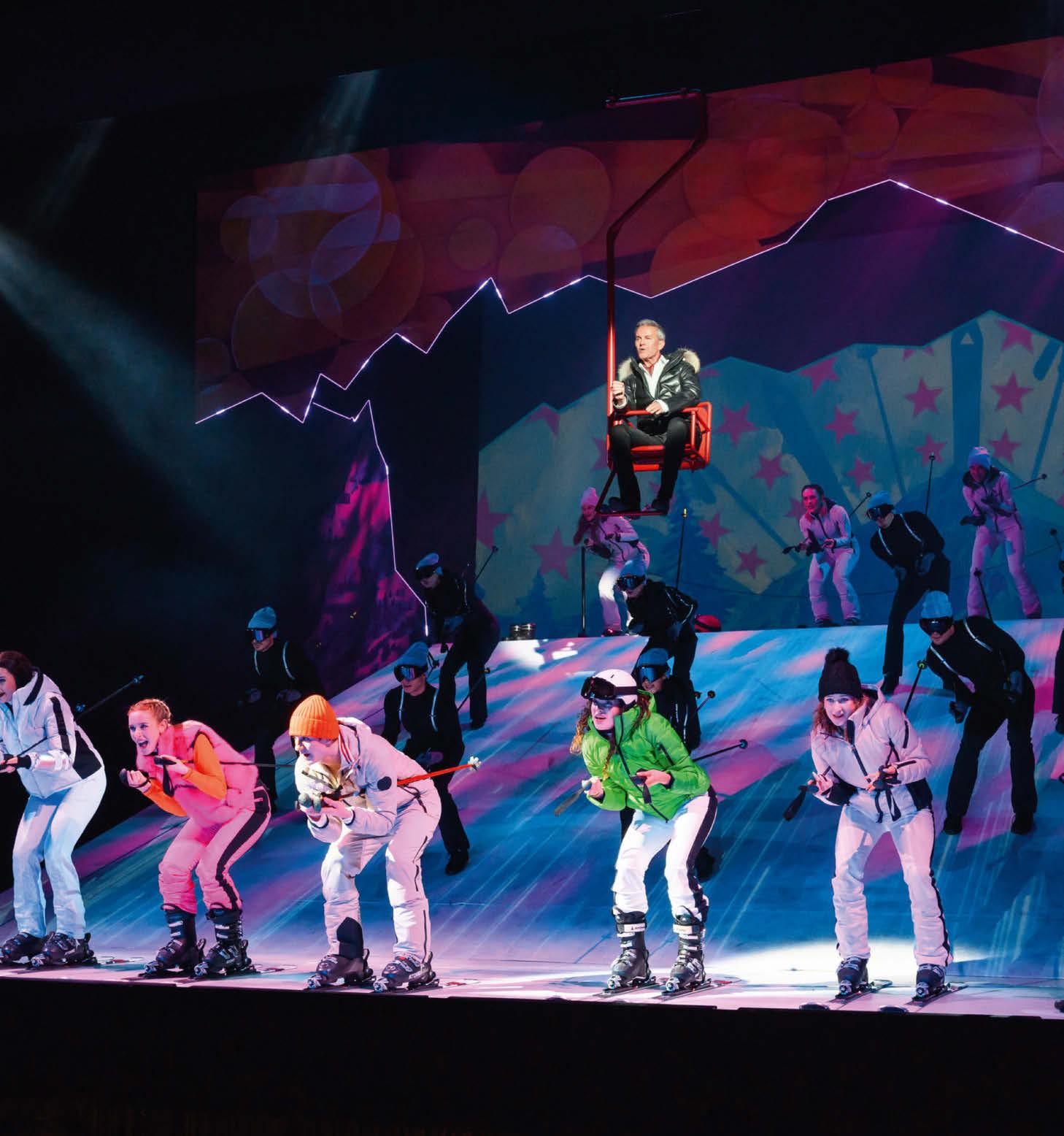
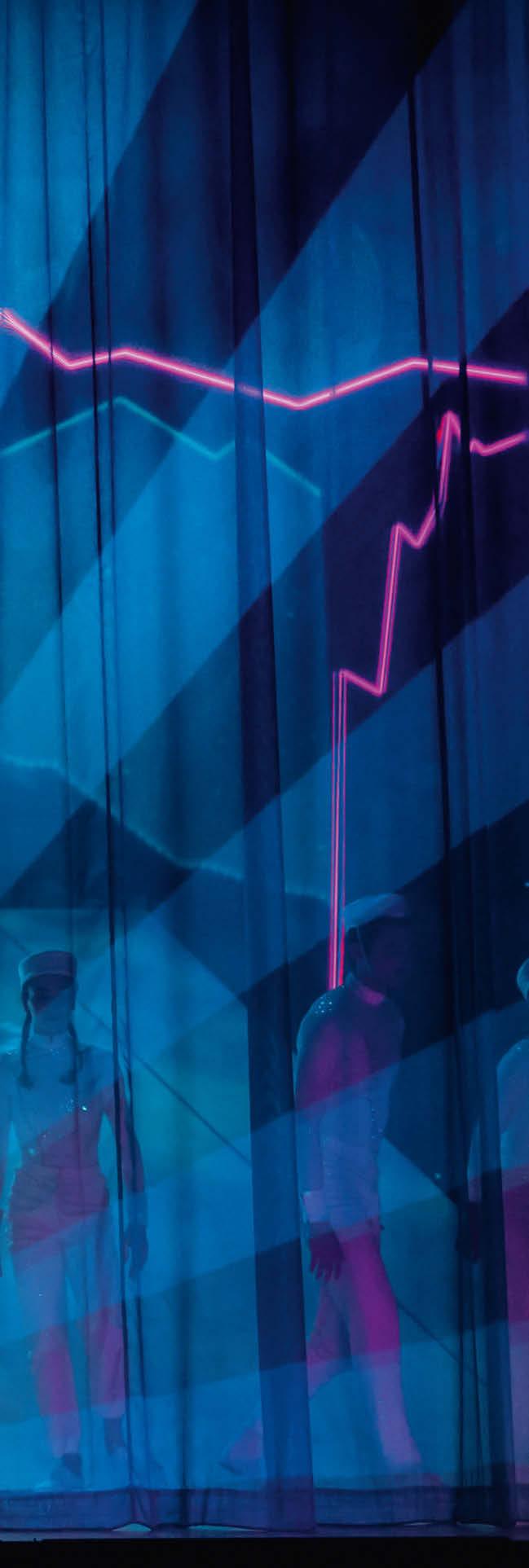
Alfons Haider as mayor hovers above the boards that famously mean the world to us.
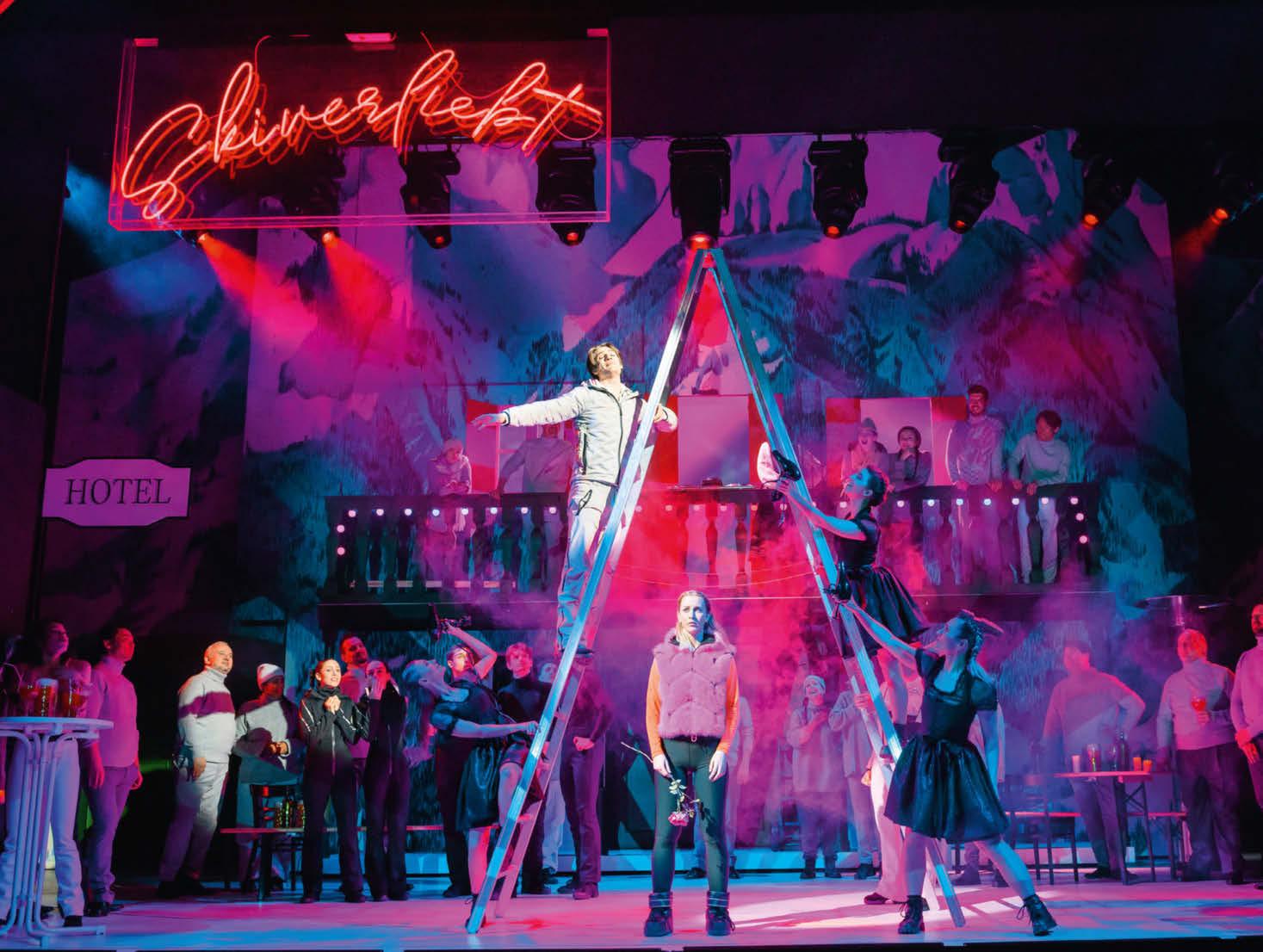
“I
was a fan for decades, crossed my fngers for her and rooted for her, but I’d never personally met her –then today, she was suddenly standing in front of me and said ‘hi’!” When musical icon Alfons Haider talks about skiing legend Annemarie Moser-Pröll, his enthusiasm isn’t an act. “That was the best experience of the last few years for me. Let’s hear it for the goddess of skiing.”
We take a step back in time to early December 2024, the Palais Wertheim on Vienna’s Ringstraße. The initial trial performances of ‘Skiverliebt’ are presented to an audience from the worlds of politics, business and society as well as former skiing stars. The musical was commissioned by the Salzburg State Theatre in conjunction with the Tourismusverband Saalbach Hinterglemm and focuses on the fctitious
life of a ski racer from Saalbach and her preparations for the home World Championships. The idea was born in a car. “It was during a journey with Leo Bauernberger, Managing Director of SalzburgerLand Tourismus. We were thinking about what winter sports didn’t yet have”, says Artistic Director Carl Philip von Maldeghem from Lake Chiemsee in Bavaria, who has skied since the age of fve. “And then, we came up with the idea of a musical.” And so, he called the Director Andreas Gergen, who said: “Why not?” Gergen – who is known for ‘The Sound of Music’ and ‘Rock Me Amadeus’ – has never actually donned a pair of skis. What enticed him to the project was the chance to create an entirely new theatrical world! Together, they developed fgures, settings, twists and a vision that fused World Championship fever with piste romance, in which diversity and environmental protection also play important roles.
Anna Rosa Döller stands centre stage under the ladder as Anna Maier while her boyfriend Timotheus Hollweg aka Franz Nicht serenades her lovingly.

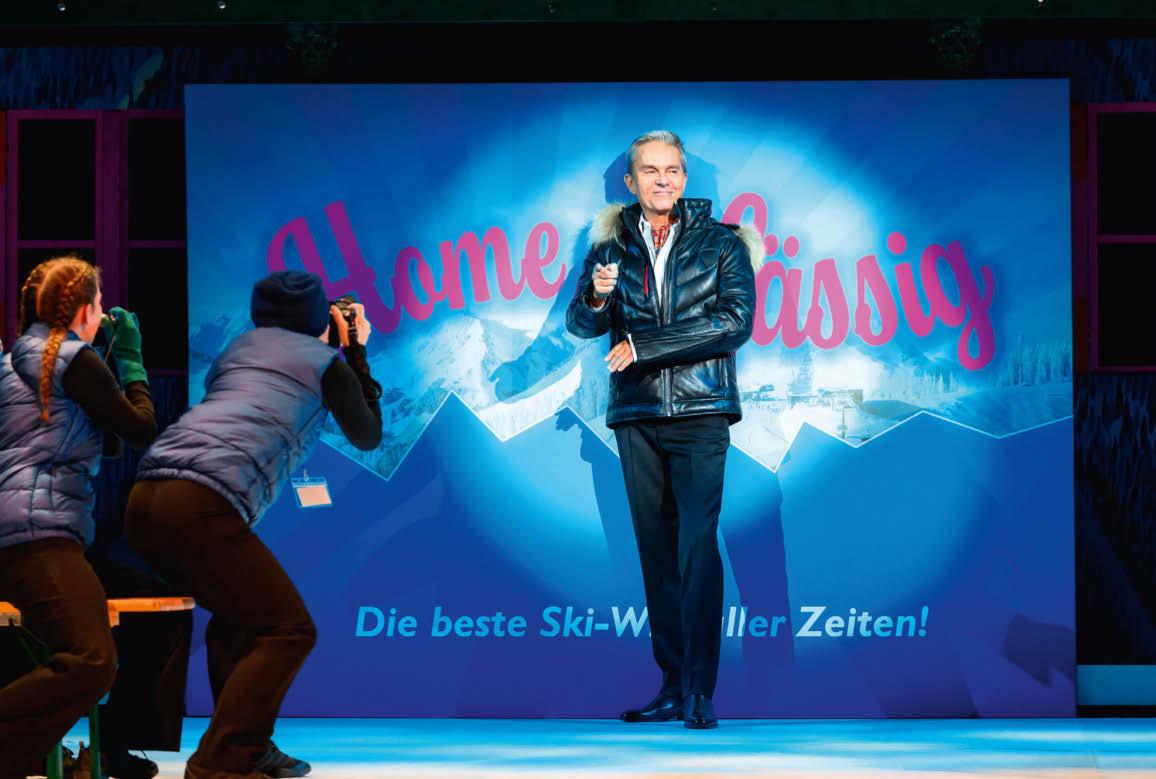
Alfons Haider as mayor Joe Oberbichler advertises “The best World Ski Championships of all time!”.
“It’s all very cool! The musical is going to be really popular in Germany too.”
A town in an extraordinary situation
Musically, the piece is a diverse mix of waltzes, Austro-pop and après-ski beats, composed by Martin Lingnau with the lyrics by Frank Ramond (co-producer of Udo Lindenberg’s ‘Der blaue Planet’). The story revolves around the ski racer Anna Maier. Successful, ambitious – and suddenly confronted with a home World Championships that shake her to the core emotionally. She is played by Anna Rosa Döller. At her side is her ski instructor boyfriend Franz Nicht, played by Timotheus Hollweg, who is Döller’s partner in real life too.
Fittingly for the subheading ‘Zwei Brettln, die die Welt bedeuten’ (‘Two boards that mean the world’), the ‘Skiverliebt’ actors give new meaning to ‘treading the boards’ as they tell the story of a town in an extraordinary situation. There’s the brazen journalist
Hannah from Hamburg, who actually has a politics background. There are the guests who arrive every Saturday: World Championship ofcials with futtering nerves, a Brazilian ski queen – and a mayor who is everything: host, head of the organising committee, whistle collector. He is played by seasoned actor Alfons Haider. “If something goes wrong, you’re always the frst to pay for it – like me as artistic director”, says the actor and director of the Seefestspiele Mörbisch operetta festival.
Once the show fnishes in Salzburg, ‘Skiverliebt’ will move on to the Schmidts Tivoli theatre in St. Pauli, Hamburg, where a modifed version will run from winter 2026/27. “It’s all very relaxed”, says Saalbach’s Director of Tourism Wolfgang Breitfuß, who frmly believes: “The musical’s going to be really popular in Germany too.”
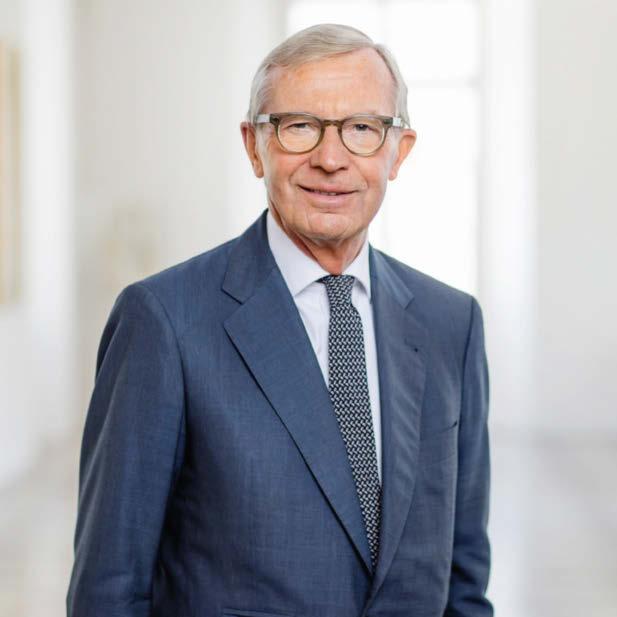
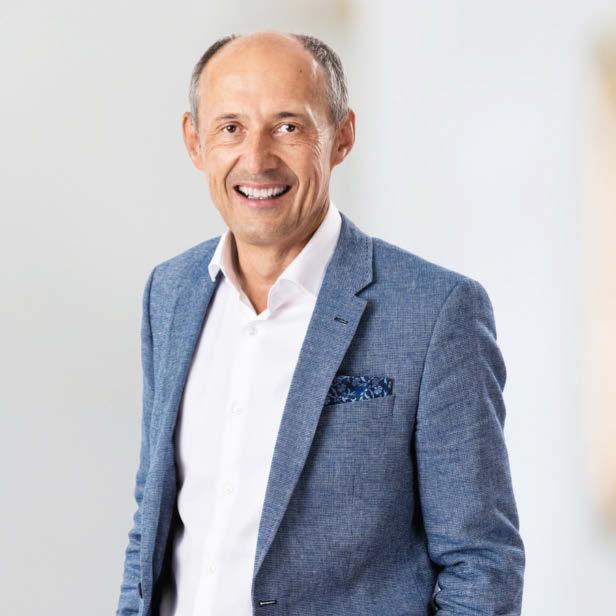
REVIEW
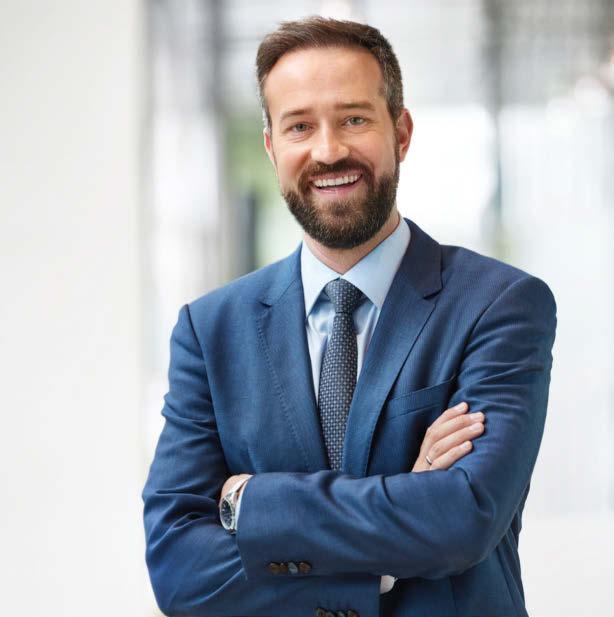
STEFAN SCHNÖLL
WILFRIED HASLAUER
has been Governor of Salzburg since 2013. The qualified lawyer grew up in Neumarkt am Wallersee and is married with four children. He lives with his family in the city of Salzburg. On 2 July 2025, he stepped down from office after 12 years as Governor and 21 years in the state government. In his spare time, he likes to read and go hiking.
LEO BAUERNBERGER
is Managing Director of SalzburgerLand Tourismus GmbH. He is married, a nature lover and knows the federal state like few others. Leo Bauernberger is committed to sustainable tourism concepts and regionality.
STEFAN SCHNÖLL
is Deputy Governor and responsible for business, transport and municipalities. He comes from Salzburg, enjoys sport and is committed to modern infrastructure. Young people and digitalisation are particularly close to his heart.
1What was your personal take on the World Championships in Saalbach?
haslauer: I wasn’t just impressed by the sporting successes of the Austrian team, but also by the huge and peaceful skiing party that we experienced here in Saalbach Hinterglemm. The great atmosphere, the perfect organisation and the way in which everyone got on peacefully have set new standards for major sporting events in the future.
schnöll: Saalbach Hinterglemm and the SalzburgerLand proved to be the perfect hosts for the Alpine World Ski Championships. The combination of top sporting performances, an intoxicating atmosphere among the fans, highly professional organisation and a seamless transport concept was impressive.
bauernberger: The warm hospitality was particularly noticeable – and left a lasting impression on everyone involved. The World Championships were the best advert for the SalzburgerLand and winter sport.
2
What was the most emotional moment of the World Championships for you?
haslauer: When Raphael Haaser raced to the World Champion title in the giant slalom. First his sister’s injury, defnitely not an easy time for the family, and then this title. I really felt he deserved it!
schnöll: Mirjam Puchner’s silver medal in the downhill was equally as emotional –standing on the podium of a home World Championships as a Salzburg native is something very special.
bauernberger: Stephanie Venier’s winning run in the superG was my goosebumps moment.
3
Looking back, is there anything you’d do diferently?
haslauer: Yes, I’d watch even more races. But that would be the only thing; these World Championships were simply perfect.
schnöll: I agree! The atmosphere, the enthusiasm of the spectators and the sporting performances were all incredible.
bauernberger: From the preparations to the implementation, everything was extraordinarily well organised. There are naturally always challenges with an event of this size – but the collaboration between everyone involved was amazing.
4
How did you fnd the atmosphere at the event – the mood of the fans, the athletes and the locals?
haslauer: Incredibly relaxed and satisfed. Everyone felt happy.
schnöll: The atmosphere was truly unique, and the weather naturally played ball perfectly.
bauernberger: Almost 175,000 fans from all over the world came together – sport should always be that unifying! We had a lot of Swiss fans come to cheer on their team. But the US team’s victories were also worth their weight in gold. The perfect winter sports images from Saalbach went out worldwide.
5 What feedback have you received from international visitors or ofcial delegations?
haslauer: The feedback has been thoroughly positive. However, there was one suggestion: several colleagues from the felds of politics, business and sport have asked if we could organise the next World Championships too – or at least not wait another thirty years until we do so again. schnöll: We’re particularly delighted to have received outstanding feedback from our friends from Switzerland. After all, the next World Championships will be held in CransMontana in two years’ time – and several
of those responsible for it came to Saalbach, including the State Council and the head of tourism for the canton of Valais, who paid close attention to the organisation. The unanimous opinion was: “You’ve set a new benchmark with these World Championships. We’re going to have to work really hard to achieve this level.” When the Swiss, who are known for their perfection, say something like that, the praise is doubly as great.
bauernberger: Lots of important partners from the tourism industry came here over the course of the two weeks, from global tour operators to major airlines. The feedback we received was almost exuberant.
6How was the
collaboration between
the state, municipality and organisers?
haslauer: I felt that the institutions worked incredibly closely. I’m including the emergency services and many volunteers in that too. schnöll: The collaboration was exemplary. The state, the municipality and the organisers always coordinated everything with each other and worked together with great efciency and purpose.
bauernberger: The good collaboration was the basis for the success. It was a genuine team efort.
7 What challenges were there in the run-up – and how were they resolved?
haslauer: The safety of the athletes, all the World Championship support personnel, fans, media representatives etc. was a huge consideration and a major challenge. Thousands of fans had to be transported to and from the valley. It was a masterful efort. One example: people’s ability to travel by public transport and on skis free of charge was key to the success.
schnöll: One of the main challenges was efcient trafc management. The newly opened Maishofen-Saalbach railway station as a mobility hub was an important part of the transport concept. In combination with the park & ride car park, additional shuttle connections and optimised local public transport, we ensured sustainable mobility during the World Championships.
bauernberger: That not only worked brilliantly during the World Championships, but will also beneft the region in the future.
“THE ATMOSPHERE WAS TRULY UNIQUE, AND THE WEATHER NATURALLY PLAYED BALL PERFECTLY.”
Stefan Schnöll
8 Was there anything new that you’re particular proud of?
haslauer: The fact that medals were already awarded on the frst day within the scope of the opening ceremony was impressive.
bauernberger: The fnish stadium, which brought together all races while also enabling people to still ski as normal in the rest of the area.
9
What economic efects did you record for the region and the state during the World Championships?
haslauer: We’ll see these in the coming years. The World Championships were an investment in the future.
bauernberger: We know that World Ski Championships ofer over 150 million euros in direct advertising value with regard to the international TV broadcasts alone. The indirect and, above all, long-term efect of such an event is inestimably higher.
schnöll: We want to take a really close look at the actual efects for the region and the SalzburgerLand as a whole. Saalbach Hinterglemm therefore conducted a valueadded analysis during the World Championships. The results are currently being analysed.
“THE
GOOD COLLABORATION
WAS THE BASIS FOR THE SUCCESS. IT WAS A GENUINE TEAM EFFORT.”
Leo Bauernberger
10
How were local businesses –restaurants, hotels, retailers etc. – involved and how did they beneft?
haslauer: Everyone was involved and everyone benefted or will continue to beneft. The region was strengthened by infrastructure projects that will remain in place after the World Championships. The central government, state and municipality invested around 50 million euros in total – on everything from better snowmaking equipment to new bus terminals and a route for emergency vehicles.
schnöll: The regional added value was huge. To name some specifcs, the trophies came from Maishofen, the chocolate snowfakes from Lofer and the fags from Mittersill. Salzburg is also a state with great skill in winter sports – as per our nickname ‘The Silicon Valley of skiing’. Our ski regions, hotels, cable cars and piste conditions are all at the top of their game – and at very moderate prices by international comparison. Innovative companies and world market leaders such as Atomic, Skidata and Axxess are furthermore based here. There are also outstanding synergies that further fuel quality.
11
What
do the World Championships mean for the tourist positioning of Saalbach and the SalzburgerLand over
the long term?
haslauer: The World Ski Championships and the investments in infrastructure have sustainably safeguarded the region and the SalzburgerLand as a tourist location. But you must never rest on your laurels in this regard. New ideas and a good reputation safeguard the economy and therefore jobs.
bauernberger: World Ski Championships ofer a unique opportunity to put a destination on the map of globally renowned winter sports regions and to show of its qualities as a host.
12
What remains?
haslauer: All investments in the ski region and the new railway station in Maishofen. The centre of Hinterglemm was made fully accessible and modernised; pipes were also laid for district heating.
schnöll: Another central element is the new bus terminal. What’s more, an eight-kilometre emergency route that was specially created for the World Championships will now be converted into a cycle path. The sports centre in Hinterglemm can also be fexibly adapted for larger events.
13 Were new jobs created – and can these be preserved over the long term?
haslauer: The World Ski Championships have helped the region to become more of a year-round destination. That safeguards jobs for young people in the region, who can earn a livelihood locally. All investments in tourism are investments in prosperity.
bauernberger: Yes, new jobs were defnitely created within the scope of the World Ski Championships – both in the area of organisation and with regard to the operational side of things.
schnöll: The outstanding international image advertising surrounding the event sustainably strengthens Saalbach Hinterglemm’s position as a tourist location – and that helps to safeguard existing jobs.
14 What take-aways did you gain for future major events?
bauernberger: Lots – especially how important forward-looking planning, strong partnerships and authentic host qualities are. The World Ski Championships were a perfect measure of our event competence.
15 Are you considering applying for further international events, such as
the Winter Olympics?
haslauer: The calls for us to do so are certainly loud. However, we’ve currently got plenty to do organising major events for other sports. I’m thinking about the Mountain Bike World Cup and Mountain Bike World Championships 2028 in Leogang. And in winter, we’ve got the fnal of the Four Hills Tournament in Bischofshofen, the Night Slalom in Flachau, the Snowboard World Cup in Gastein and the Ladies Speed Race
in Zauchensee. Flachau is also striving to host another women’s World Cup race. bauernberger: You should never rule things out. Applications for further international major events in winter are defnitely something we’d consider over the long term. But our view is broader than just winter. Events like the Austrian Alpine Open within the scope of the DP World Tour for golfers and an array of cycling events including the Mountain Bike World Championships 2028 in Saalfelden Leogang also ofer exciting prospects.
16
Are there any specifc plans to further expand the tourist infrastructure?
haslauer: We constantly have those sorts of plans. The tourism regions work tirelessly with the support of the state to remain constantly up to date and think about the future. schnöll: One exciting project will be the opening of Fort Kniepass at the end of June 2025. With a 150-metre tube slide, an adventure trail and an open-air arena, the historic fort will become a genuine highlight for visitors to the Unken region. The Schlossalm in Bad Hofgastein will also be expanded by the end of 2025 to enable sustainable two-season operation at over 2,000 metres above sea level. And at the end of 2026, the new 5-star Falkensteiner Hotel will open in Saalbach Hinterglemm – following extensive modernisation of the former Hotel Alpine Palace. This shows that companies believe in the location – and so do we.
Wilfried Haslauer
17
Where do you see the SalzburgerLand in ten years’ time compared to other tourist areas around the world?
haslauer: As a top year-round destination, where tourism is an important economic factor and safeguards jobs. But that won’t just happen by itself, we’re working hard on it every day.
bauernberger: In ten years’ time, the SalzburgerLand will be one of the most successful tourism regions in the Alps and Europe. By striking a balance between the summer and winter seasons, we’re creating the foundations for a year-round destination with international appeal.
18 Was there any moment that you found particularly moving or that made you especially proud?
haslauer: On the opening day, we had the joint reception of the SalzburgerLand and the Austrian Ski Association. And as Bartl Gensbichler approached me, he had tears in his eyes. That really moved me because he’d put his heart and soul into these World Championships and the frst day, when everything went well and everyone was impressed, was a much deserved start to things.
bauernberger: One moment that I found particularly moving was the opening ceremony – it was deeply touching to see the extent to which the entire country was behind the World Ski Championships.
19
What
international media reports or PR
efects did you fnd particularly positive?
bauernberger: The FIS Alpine World Ski Championships in Saalbach provided the SalzburgerLand with a fantastic stage. We were able to position ourselves as a diverse and attractive holiday region – far beyond sport. What particularly delighted me was that it wasn’t just the ofcial PR work that shaped the positive impression, but the warm hospitality conveyed by each and every person.
20
If you had to describe the World Championships in three words, what would they be?
haslauer: Intoxicating. Peaceful. Perfect. bauernberger: Exciting. Intense. Unique. schnöll: Atmospheric. Inspirational. Unforgettable.
PUBLISHING INFORMATION
Media owner & distributor
Tourismusverband Saalbach Hinterglemm
Glemmtaler Landesstraße 550
A-5753 Saalbach
Telephone: +43 6541 680068 contact@saalbach.com
Project leadership
Wolfgang Quas
Marlene Krug
Lena Wimmer
Editors-in-Chief
Wolfgang Wieser
Hannes Kropik
Project management
Bernhard Schmied
Media sales & partnerships
Sabine Zölß
Creative directors
Erik Turek (head)
Kasimir Reimann
Graphic design
Marion Bernert-Thomann
Kevin Faustmann-Goll
Photo editing
Eva Kerschbaum
Production
Veronika Felder (head)
Martin Brandhofer
Walter O. Sadaba
Sabine Wessig
Proofreading
Hans Fleissner (head)
Petra Hannert
Monika Hasleder
Translation
De Vries Translations
Lithography
Clemens Ragotzky (head)
Claudia Heis
Josef Mühlbacher
Media owner, publisher & distributor
Red Bull Media House GmbH
Oberst-Lepperdinger-Straße 11–15
A-5071 Wals bei Salzburg
FN 297115i
Salzburg District Court
ATU63611700
Printing
offset 5020
Bayernstraße 27
A-5071 Wals-Siezenheim
Editorial address
Am Grünen Prater 3
A-1020 Vienna
Telephone: +43 1 90221-0 redbulletin.com
General Manager
Red Bull Media House Publishing
Stefan Ebner
HIGH-END HOSPITALITY
16 people worked hard for 14 days to construct the 244-tonne, 2-storey tent with 600 square metres of window space. They set up a 4,000 -square-metre catering paradise with the aid of 500 pallets of equipment, including 17,000 plates, 19,000 pieces of cutlery and 12,000 glasses and coffee cups: in the VIP Champions Club, 10,000 VIP guests at 144 tables enjoyed the hospitality of 140 kitchen, patisserie and service staff. The selection offered by the 20 buffet stations was absolutely world class: 5,000 portions of Salzburger Nockerl sweet souffé and 5,500 portions of Kaiserschmarrn pancakes, 500 kilograms of home-made pasta and 500 freshly baked loaves of bread tantalised the taste buds alongside 100 barrels of beer and 7,000 bottles of wine from Lower Austria and Burgenland.
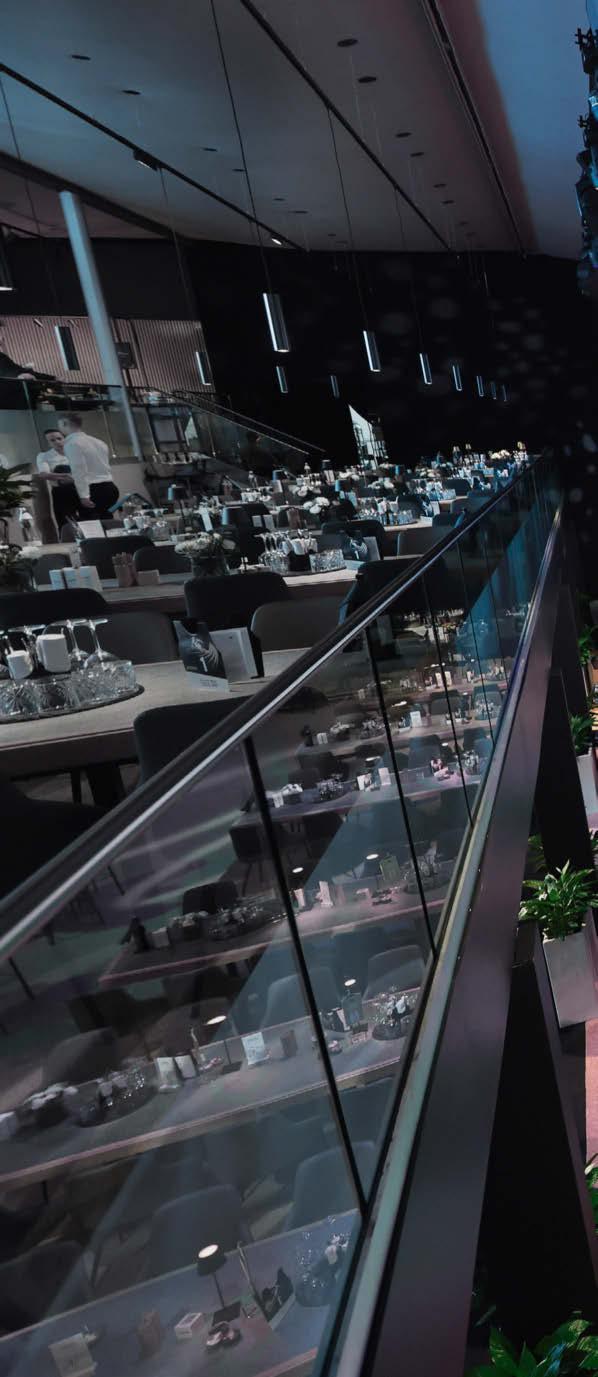
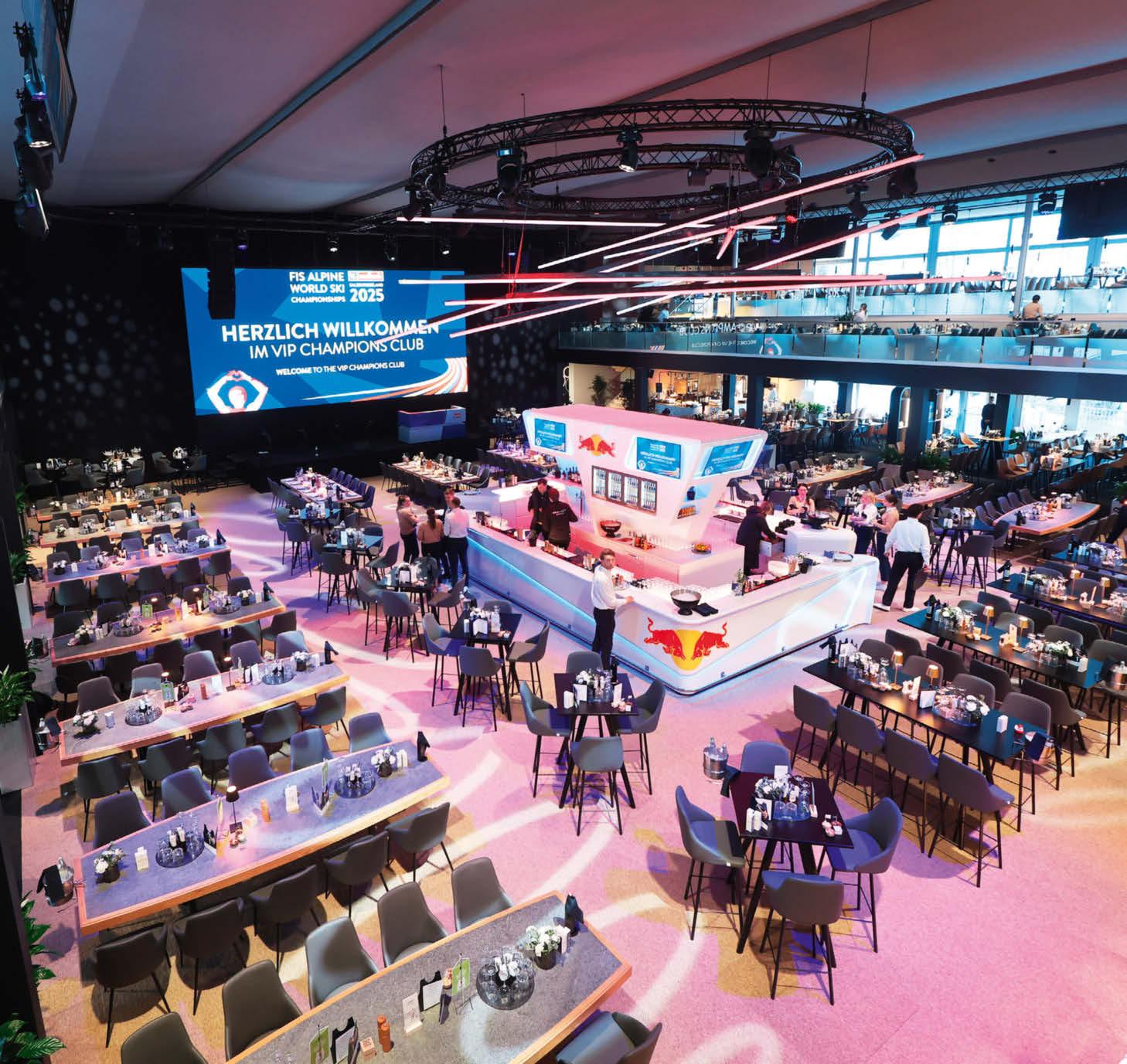
THE CALM BEFORE THE STORM
Even early in morning, the VIP Champions Club looked simply stunning. Guests received exquisite hospitality experiences until long after the races finished.
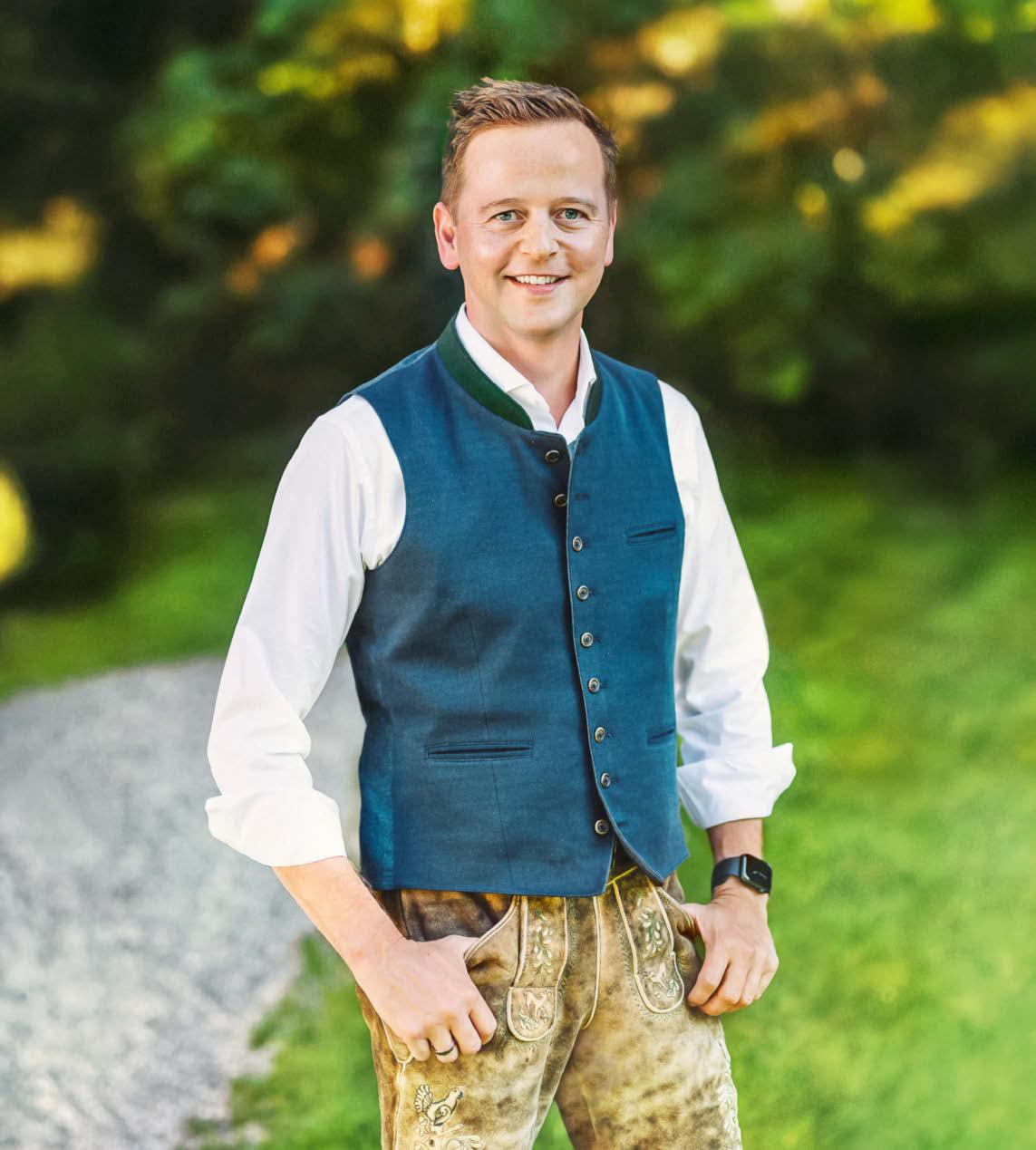
ALOIS HASENAUER
“THEY WERE OUR WORLD CHAMPS”
Mayor Alois Hasenauer gives his review of the FIS Alpine World Ski Championships in Saalbach Hinterglemm 2025. He looks back at emotional highlights, organisational masterpieces and sustainable future planning – and forward to what’s yet to come.
WABOUT ALOIS
Alois Hasenauer has been mayor of Saalbach Hinterglemm since 2013. Born in Pinzgau, he has a strong bond with his home area and has been committed to sustainable tourism development in the region for years. He was a driving force behind the application for the World Ski Championships 2025 and builds bridges between local people, politics and tourism.
hen I walk through Saalbach Hinterglemm today, I meet people whose eyes are gleaming brightly. Many of them are still talking about “our races”, almost as though they’d been on the start line.
And I fully agree, they were our World Championships. The FIS Alpine World Ski Championships 2025 not only put our municipality on the international map for winter sport, they also brought us closer together.
The last few weeks were emotional, intense and, for me personally, the crowning glory of a long journey. When I became mayor in 2013, I took over the World Championship project – a vision that seemed extremely distant at the time.
Today, I can say that many of the things we worked on and imagined back then actually came to fruition. My personal verdict is a thoroughly positive one. It was naturally a mammoth task – but one that we lived up to.
The most emotional moment? For me, it was the fnal day. The feeling of being in the stands, seeing a full house and feeling the excitement – it was a pure goosebumps moment. It was then that I knew it had all been worthwhile.
There were naturally challenges. During the application phase in particular, we had to do a lot of persuasion. There was a head-to-head race between us and our international competitors. In the end, our hard work paid of – including thanks to the support at political level. The collaboration between the federal government, the state, the municipality and the organiser was characterised by mutual respect. Everyone knew why they were there and what was needed to make this major project a success.
The atmosphere at the event was unique. Fan groups from all over celebrated together. The spectators were fair. The focus was on the sport and the athletes were received with genuine enthusiasm. This energy also spread to the locals. Initially, there were understandably some voices of criticism. The centre of Hinterglemm was a major construction site for two years. Today, that’s no longer mentioned. On the contrary, people are proud of what they achieved together.
Sustainability wasn’t a buzzword for us, but the benchmark. Right from the outset, I was committed to ensuring that no infrastructure would be built that would later
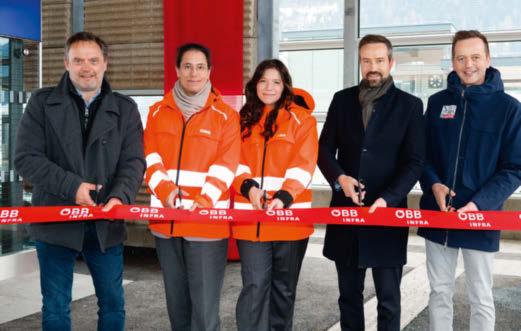
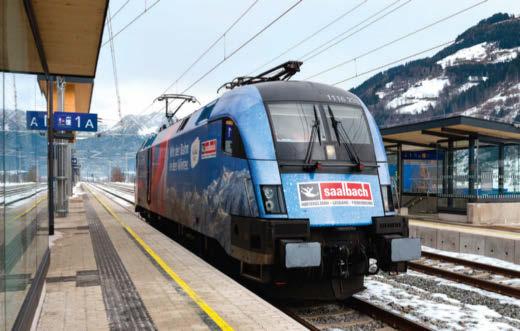
Maishofen’s mayor Stefan Aglassinger, ÖBB-InfrastrukturAG CEO Judith Engel, ÖBB project coordinator Adriana Sturm, Deputy Governor Stefan Schnöll and Alois Hasenauer (top, from the left) opened the modernised Maishofen-Saalbach railway station. Special trains provided a comfortable journey to the World Ski Championships.
I’M PARTICULARLY DELIGHTED WITH THE INTERNATIONAL FEEDBACK. THIS IS RECOGNITION FOR MANY YEARS OF HARD WORK.
stand empty. Everything that was constructed will still be used in the future – whether for tourism, sport or the municipality. I’m particularly proud that we were the frst major sporting event in Austria to be certifed as a Green Event.
The trafc situation was one of our biggest challenges, but we dealt with it successfully thanks to good concepts – from the shuttle system to the connection via the newly designed Maishofen-Saalbach railway station – and wellbehaved guests. Many adhered to our call for them to use public transport. That was a great sign.
And economically? The direct efects are tangible –full hotels, busy restaurants and a strong local economy. The long-term efects will become apparent over the next few years. I frmly believe that the development of the tourism sector will be measurable and that, by international comparison, the position of both Saalbach Hinterglemm and Skicircus Saalbach Hinterglemm Leogang Fieberbrunn has received a powerful boost.
I’m particularly delighted with the international feedback. Delegations from all over the world – including the Swiss team that will host the next World Ski Championships – praised our organisation and atmosphere. This provides recognition of our many years of hard work.
Afurther, often underestimated efect is the networks that were created. Both collaborations with other tourism regions and strategic partnerships help us to progress. In particular, the World Championships open up new prospects for young people in the region. They can see that great things can happen even in a small town.
One thing that is clear for the future is that it’s not about more beds, but about even better quality. We want to use the momentum of the World Championships –communicatively, economically and emotionally. There are many ideas on how we can keep this impetus going and use it to drive sustainable projects.
If I think about the next ten years, I see Saalbach Hinterglemm and the SalzburgerLand as well positioned. We’ve shown that we can handle international events: with passion, ingenuity and professionalism.
I spent at least a couple of minutes in the stands at every race. To be there. To enjoy the sport. And to experience what we’ve created here together: a relaxed, sustainable and forward-looking event.
TALKING IS GOLDEN
Impressive praise for the World Ski Championships in Saalbach Hinterglemm
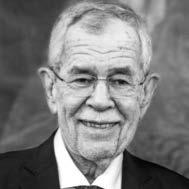
“Skiing is as important to our culture as breadcrumbs are to a schnitzel.”
Alexander Van der Bellen, Federal president

“A sporting festival that will go down in the history books. Outstanding skiing, fantastic fans and Saalbach as an amazing host made for the perfect World Ski Championships!”
Heinz Fuchs, Managing Director Saalbach 2025 Projektund Infrastruktur GmbH
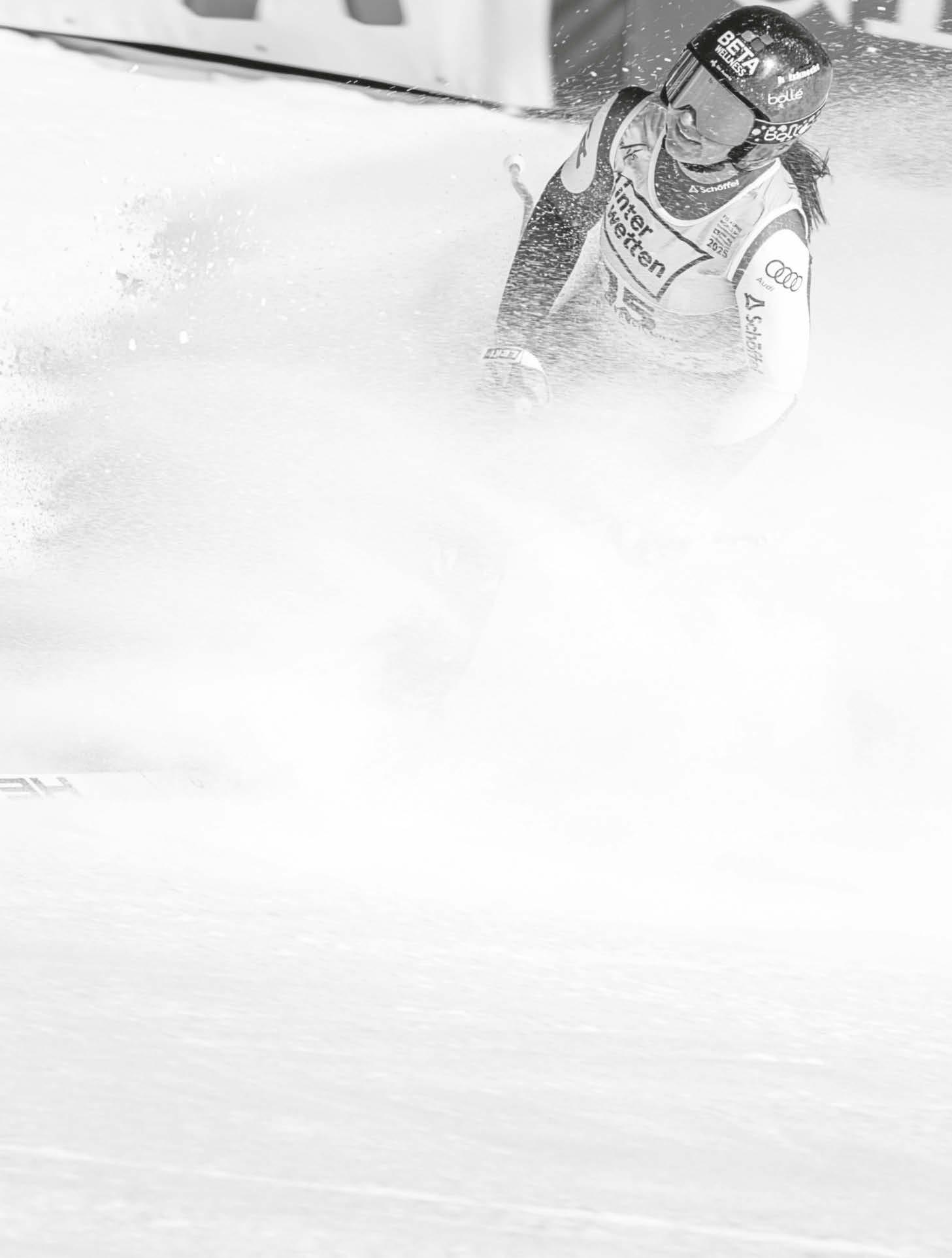
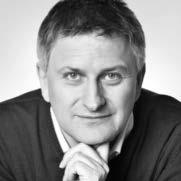
“The amazing international feedback and top viewer rates on ORF are the best ‘thank you’ for our efforts to raise the broadcasts of the World Ski Championships to a new level through numerous innovations and to optimally present Austria to other countries.”
Michael Kögler, ORF Head of Directors
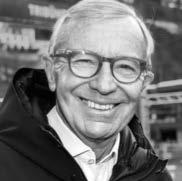
“I want to thank so many people for making these incredible World Championships possible. It’s hard to believe how complex World Championships are, and I can only reiterate how fantastically everyone did.”
Wilfried Haslauer, Governor of Salzburg

“The World Ski Championships didn’t just offer top sporting performances, but also touched people – with goosebumps moments on the piste and genuine warmth peripherally. The radiant faces of our guests are the best reward for all our hard work.”
Martin Enn, Chairman of the Tourismusverband Saalbach Hinterglemm
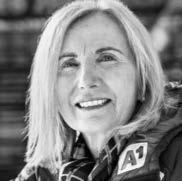
“It
was a winter fairytale on all levels and a skiing event like no other.”
Roswitha Stadlober, ÖSV President
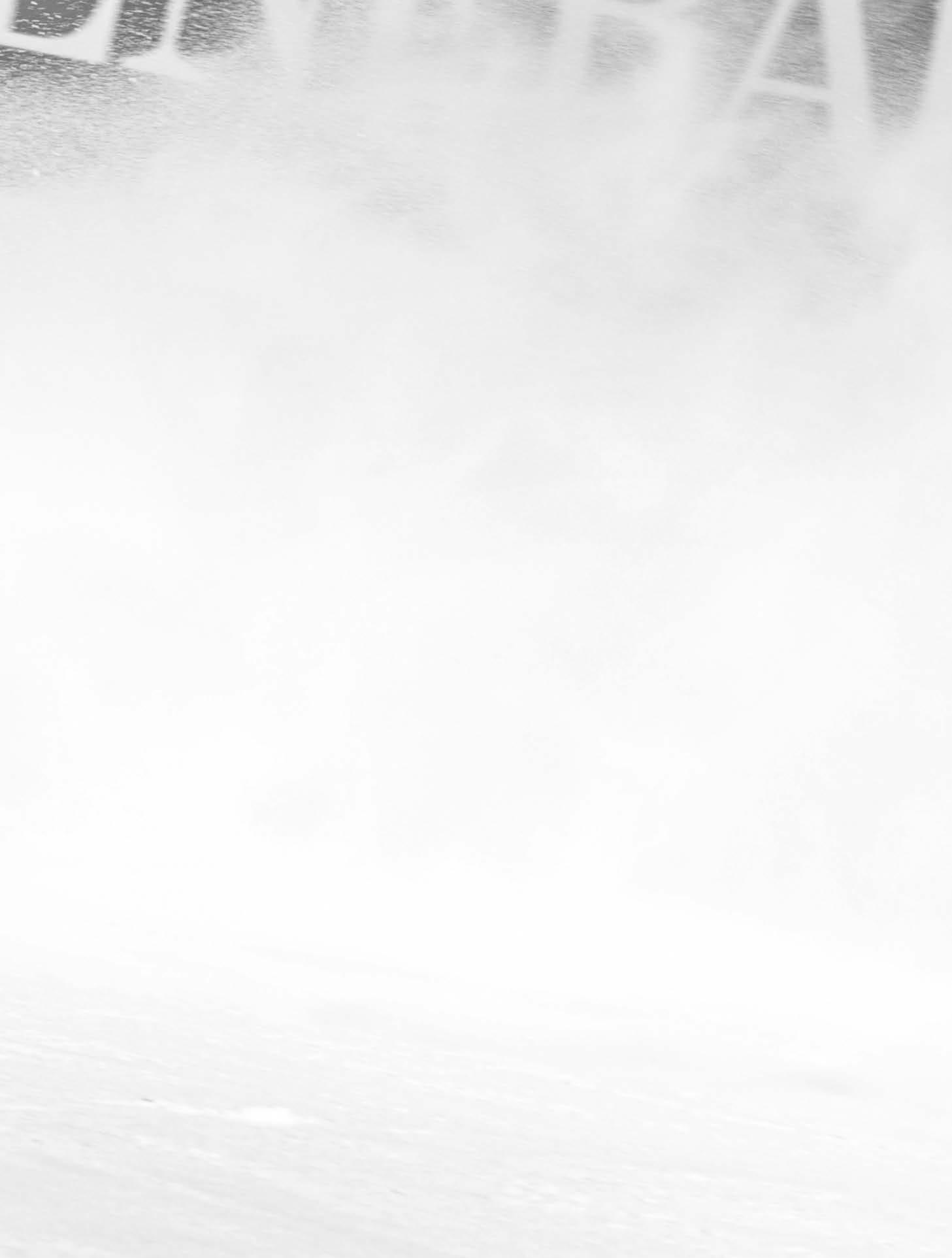
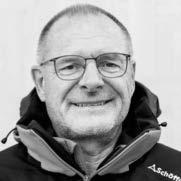
“As many Austrian and international colleagues have confirmed, they were the best World Ski Championships of all time!”
Peter Mitterer, Managing Director Hinterglemmer Bergbahnen

“The fans’ enthusiasm and the atmosphere surrounding the races shone the international spotlight even more brightly on Austria, the SalzburgerLand and Saalbach.”
Christian Scherer, Managing Director of the Saalbach 2025 Organising Committee
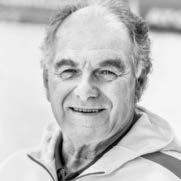
“The piste conditions were unbeatable –thanks to both Mother Nature and our work.”
Bartl Gensbichler, President of the Salzburg Ski Association

“People know Saalbach Hinterglemm. We have always been cosmopolitan.”
Isabella Dschulnigg-Geissler, hotelier and Managing Director of Saalbach Seilbahnen

“The
symbiosis of top-class sport and high-quality entertainment made these the most chilled World Ski Championships of all time.”
Wolfgang Breitfuß, Managing Director of Tourismusverband Saalbach Hinterglemm

“I’d say they were the most wellrounded World Ski Championships of all time because everything fit together perfectly.”
Florian Phleps, Project Manager Saalbach 2025

“As a long-standing partner for international winter sports, it was a particular privilege for Infront to play a leading role in shaping the FIS Alpine Ski World Championships 2025 in Saalbach as an exclusive rights holder.”
Hansjörg Jeserznik, Managing Director Infront
SNOW & TALK
The World Ski Championships podcast with high-profile guests offers exciting chats, astounding insights and the best entertainment in relation to Saalbach Hinterglemm.
THE TOP
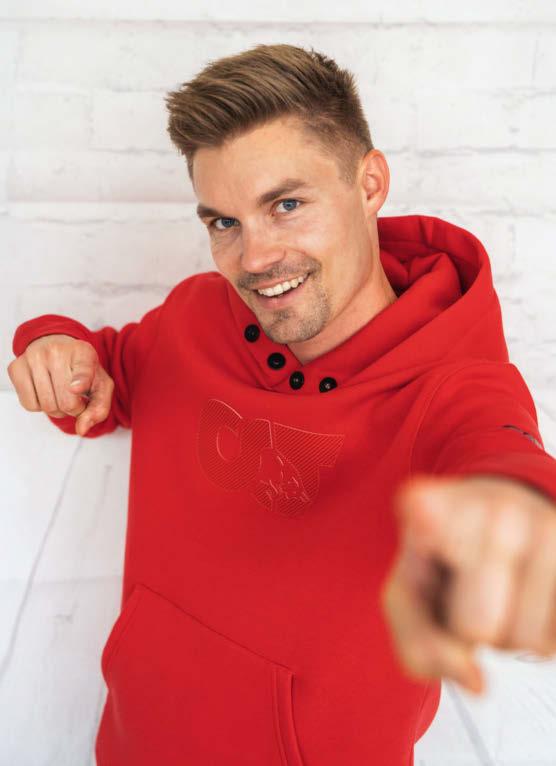
How
Saalbach
rocks –DJ In-Style’s World Championship charts




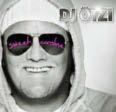


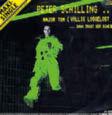
ABOUT DJ IN-STYLE
Fire, devotion, passion: this is the motto of Marco Jägert, aka DJ In-Style. With his mix of current hits and party classics, the Tyrolean provided the perfect soundtrack for the World Ski Championships. His secret: “The main focus was on the sport. But I watched the spectators and spontaneously supported the atmosphere with my tunes.” djinstyle.com

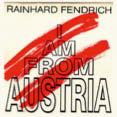
1 Walking on Sunshine Katrina and the Waves
An upbeat number. Whatever the time, this earworm is always the perfect start to the day.
2 Highs & Lows
Toby Romeo, Klangkarussell and Ely Oaks
The offcial World Championships song. Its driving beats perfectly supported the euphoria among the spectators.
3 Wackelkontakt Oimara
All the rage. This number gets both young and old singing along and was a top hit in the charts during the World Championships.
4 APT.
Rosé & Bruno Mars
In tune with the times. Another current hit that reliably got the crowds in the stands dancing.
5 Sweet Caroline DJ Ötzi
A classic. For years, there has been no other song that spectators have loved to sing along to as much as this cover version.
6 Sarà perché ti amo Ricchi e Poveri
A guaranteed mood booster. This number perfectly expresses the positive energy and euphoria during a race.
7 Mr. Brightside The Killers
A spectator favourite. I always do polls before major events and this rock song gets the most requests.
8 Major Tom Peter Schilling
The stadium sound. An extremely catchy song that became really popular again during the latest football Euros.
9 Schifoan Wolfgang Ambros
The ski classic. All I have to play are the frst bars –and people start to sing.
10 I Am from Austria Rainhard Fendrich
The national anthem. This number is a fxed part of our repertoire here in Austria. It would be a sin not to play it.



THANKS FOR THE COOLEST WORLD SKI CHAMPIONSHIPS OF ALL TIME!
